commercial all questions
Quiz Summary
0 of 649 questions completed
Questions:
Information
You have already completed the quiz before. Hence you can not start it again.
Quiz is loading...
You must sign in or sign up to start the quiz.
You must first complete the following:
Results
Results
0 of 649 questions answered correctly
Your time:
Time has elapsed
You have reached 0 of 0 point(s), (0)
Earned Point(s): 0 of 0, (0)
0 Essay(s) Pending (Possible Point(s): 0)
Categories
- Not categorized 0%
- 1
- 2
- 3
- 4
- 5
- 6
- 7
- 8
- 9
- 10
- 11
- 12
- 13
- 14
- 15
- 16
- 17
- 18
- 19
- 20
- 21
- 22
- 23
- 24
- 25
- 26
- 27
- 28
- 29
- 30
- 31
- 32
- 33
- 34
- 35
- 36
- 37
- 38
- 39
- 40
- 41
- 42
- 43
- 44
- 45
- 46
- 47
- 48
- 49
- 50
- 51
- 52
- 53
- 54
- 55
- 56
- 57
- 58
- 59
- 60
- 61
- 62
- 63
- 64
- 65
- 66
- 67
- 68
- 69
- 70
- 71
- 72
- 73
- 74
- 75
- 76
- 77
- 78
- 79
- 80
- 81
- 82
- 83
- 84
- 85
- 86
- 87
- 88
- 89
- 90
- 91
- 92
- 93
- 94
- 95
- 96
- 97
- 98
- 99
- 100
- 101
- 102
- 103
- 104
- 105
- 106
- 107
- 108
- 109
- 110
- 111
- 112
- 113
- 114
- 115
- 116
- 117
- 118
- 119
- 120
- 121
- 122
- 123
- 124
- 125
- 126
- 127
- 128
- 129
- 130
- 131
- 132
- 133
- 134
- 135
- 136
- 137
- 138
- 139
- 140
- 141
- 142
- 143
- 144
- 145
- 146
- 147
- 148
- 149
- 150
- 151
- 152
- 153
- 154
- 155
- 156
- 157
- 158
- 159
- 160
- 161
- 162
- 163
- 164
- 165
- 166
- 167
- 168
- 169
- 170
- 171
- 172
- 173
- 174
- 175
- 176
- 177
- 178
- 179
- 180
- 181
- 182
- 183
- 184
- 185
- 186
- 187
- 188
- 189
- 190
- 191
- 192
- 193
- 194
- 195
- 196
- 197
- 198
- 199
- 200
- 201
- 202
- 203
- 204
- 205
- 206
- 207
- 208
- 209
- 210
- 211
- 212
- 213
- 214
- 215
- 216
- 217
- 218
- 219
- 220
- 221
- 222
- 223
- 224
- 225
- 226
- 227
- 228
- 229
- 230
- 231
- 232
- 233
- 234
- 235
- 236
- 237
- 238
- 239
- 240
- 241
- 242
- 243
- 244
- 245
- 246
- 247
- 248
- 249
- 250
- 251
- 252
- 253
- 254
- 255
- 256
- 257
- 258
- 259
- 260
- 261
- 262
- 263
- 264
- 265
- 266
- 267
- 268
- 269
- 270
- 271
- 272
- 273
- 274
- 275
- 276
- 277
- 278
- 279
- 280
- 281
- 282
- 283
- 284
- 285
- 286
- 287
- 288
- 289
- 290
- 291
- 292
- 293
- 294
- 295
- 296
- 297
- 298
- 299
- 300
- 301
- 302
- 303
- 304
- 305
- 306
- 307
- 308
- 309
- 310
- 311
- 312
- 313
- 314
- 315
- 316
- 317
- 318
- 319
- 320
- 321
- 322
- 323
- 324
- 325
- 326
- 327
- 328
- 329
- 330
- 331
- 332
- 333
- 334
- 335
- 336
- 337
- 338
- 339
- 340
- 341
- 342
- 343
- 344
- 345
- 346
- 347
- 348
- 349
- 350
- 351
- 352
- 353
- 354
- 355
- 356
- 357
- 358
- 359
- 360
- 361
- 362
- 363
- 364
- 365
- 366
- 367
- 368
- 369
- 370
- 371
- 372
- 373
- 374
- 375
- 376
- 377
- 378
- 379
- 380
- 381
- 382
- 383
- 384
- 385
- 386
- 387
- 388
- 389
- 390
- 391
- 392
- 393
- 394
- 395
- 396
- 397
- 398
- 399
- 400
- 401
- 402
- 403
- 404
- 405
- 406
- 407
- 408
- 409
- 410
- 411
- 412
- 413
- 414
- 415
- 416
- 417
- 418
- 419
- 420
- 421
- 422
- 423
- 424
- 425
- 426
- 427
- 428
- 429
- 430
- 431
- 432
- 433
- 434
- 435
- 436
- 437
- 438
- 439
- 440
- 441
- 442
- 443
- 444
- 445
- 446
- 447
- 448
- 449
- 450
- 451
- 452
- 453
- 454
- 455
- 456
- 457
- 458
- 459
- 460
- 461
- 462
- 463
- 464
- 465
- 466
- 467
- 468
- 469
- 470
- 471
- 472
- 473
- 474
- 475
- 476
- 477
- 478
- 479
- 480
- 481
- 482
- 483
- 484
- 485
- 486
- 487
- 488
- 489
- 490
- 491
- 492
- 493
- 494
- 495
- 496
- 497
- 498
- 499
- 500
- 501
- 502
- 503
- 504
- 505
- 506
- 507
- 508
- 509
- 510
- 511
- 512
- 513
- 514
- 515
- 516
- 517
- 518
- 519
- 520
- 521
- 522
- 523
- 524
- 525
- 526
- 527
- 528
- 529
- 530
- 531
- 532
- 533
- 534
- 535
- 536
- 537
- 538
- 539
- 540
- 541
- 542
- 543
- 544
- 545
- 546
- 547
- 548
- 549
- 550
- 551
- 552
- 553
- 554
- 555
- 556
- 557
- 558
- 559
- 560
- 561
- 562
- 563
- 564
- 565
- 566
- 567
- 568
- 569
- 570
- 571
- 572
- 573
- 574
- 575
- 576
- 577
- 578
- 579
- 580
- 581
- 582
- 583
- 584
- 585
- 586
- 587
- 588
- 589
- 590
- 591
- 592
- 593
- 594
- 595
- 596
- 597
- 598
- 599
- 600
- 601
- 602
- 603
- 604
- 605
- 606
- 607
- 608
- 609
- 610
- 611
- 612
- 613
- 614
- 615
- 616
- 617
- 618
- 619
- 620
- 621
- 622
- 623
- 624
- 625
- 626
- 627
- 628
- 629
- 630
- 631
- 632
- 633
- 634
- 635
- 636
- 637
- 638
- 639
- 640
- 641
- 642
- 643
- 644
- 645
- 646
- 647
- 648
- 649
- Current
- Review
- Answered
- Incorrect
-
Question 1 of 649
1. Question
Which statement is true about magnetic deviation of a compass? Deviation
CorrectIncorrect -
Question 2 of 649
2. Question
Maximum structural cruising speed is the maximum speed at which an airplane can be operated during
CorrectIncorrect -
Question 3 of 649
3. Question
Why should flight speeds above VNE be avoided?
CorrectIncorrect -
Question 4 of 649
4. Question
Refer to the diagram below. The horizontal dashed line from point C to point E represents the
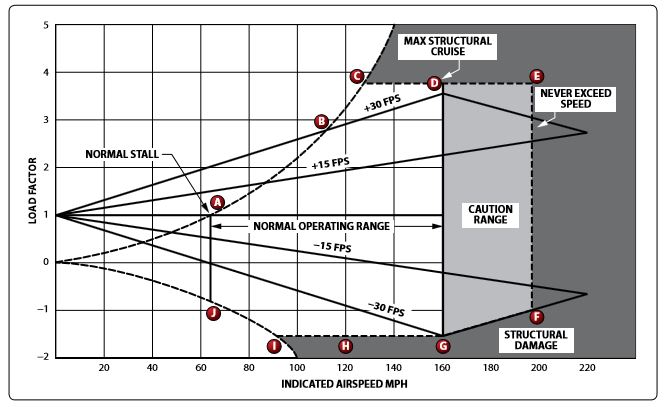 CorrectIncorrect
CorrectIncorrect -
Question 5 of 649
5. Question
Refer to the diagram below. The vertical line from point E to point F is represented on the airspeed indicator by the
 CorrectIncorrect
CorrectIncorrect -
Question 6 of 649
6. Question
Refer to the diagram below. The vertical line from point D to point G is represented on the airspeed indicator by the maximum speed limit of the

CorrectIncorrect -
Question 7 of 649
7. Question
Refer to the diagram below. Point C references
 CorrectIncorrect
CorrectIncorrect -
Question 8 of 649
8. Question
Which airspeed would a pilot be unable to identify by the color coding of an airspeed indicator?
CorrectIncorrect -
Question 9 of 649
9. Question
Calibrated airspeed is best described as indicated airspeed corrected for
CorrectIncorrect -
Question 10 of 649
10. Question
True airspeed is best described as calibrated airspeed corrected for
CorrectIncorrect -
Question 11 of 649
11. Question
What is an advantage of an electric turn coordinator if the airplane has a vacuum system for other gyroscopic instruments?
CorrectIncorrect -
Question 12 of 649
12. Question
What is an operational difference between the turn coordinator and the turn-and-slip indicator? The turn coordinator
CorrectIncorrect -
Question 13 of 649
13. Question
What is a benefit of flying with a glass cockpit?
CorrectIncorrect -
Question 14 of 649
14. Question
What steps must be taken when flying with glass cockpits to ensure safe flight?
CorrectIncorrect -
Question 15 of 649
15. Question
An aircraft which is equipped with an Electronic Flight Display (EFD) can
CorrectIncorrect -
Question 16 of 649
16. Question
Fouling of spark plugs is more apt to occur if the aircraft
CorrectIncorrect -
Question 17 of 649
17. Question
Unless adjusted, the fuel/air mixture becomes richer with an increase in altitude because the amount of fuel
CorrectIncorrect -
Question 18 of 649
18. Question
What will occur if no leaning is made with the mixture control as the flight altitude increases?
CorrectIncorrect -
Question 19 of 649
19. Question
The basic purpose of adjusting the fuel/air mixture control at altitude is to
CorrectIncorrect -
Question 20 of 649
20. Question
At high altitudes, an excessively rich mixture will cause the
CorrectIncorrect -
Question 21 of 649
21. Question
The pilot controls the air/fuel ratio with the
CorrectIncorrect -
Question 22 of 649
22. Question
Fuel/air ratio is the ratio between the
CorrectIncorrect -
Question 23 of 649
23. Question
The best power mixture is that fuel/air ratio at which
CorrectIncorrect -
Question 24 of 649
24. Question
The mixture control can be adjusted, which
CorrectIncorrect -
Question 25 of 649
25. Question
What effect, if any, would a change in ambient temperature or air density have on gas turbine engine performance?
CorrectIncorrect -
Question 26 of 649
26. Question
Which statement is true concerning the effect of the application of carburetor heat?
CorrectIncorrect -
Question 27 of 649
27. Question
Applying carburetor heat will
CorrectIncorrect -
Question 28 of 649
28. Question
Leaving the carburetor heat on during takeoff
CorrectIncorrect -
Question 29 of 649
29. Question
Detonation occurs in a reciprocating aircraft engine when
CorrectIncorrect -
Question 30 of 649
30. Question
Detonation can be caused by
CorrectIncorrect -
Question 31 of 649
31. Question
The uncontrolled firing of the fuel/air charge in advance of normal spark ignition is known as
CorrectIncorrect -
Question 32 of 649
32. Question
Detonation may occur at high-power settings when
CorrectIncorrect -
Question 33 of 649
33. Question
Before shutdown, while at idle, the ignition key is momentarily turned OFF. The engine continues to run with no interruption; this
CorrectIncorrect -
Question 34 of 649
34. Question
A way to detect a broken magneto primary grounding lead is to
CorrectIncorrect -
Question 35 of 649
35. Question
The most probable reason an engine continues to run after the ignition switch has been turned off is
CorrectIncorrect -
Question 36 of 649
36. Question
A detuning of engine crankshaft counterweights is a source of overstress that may be caused by
CorrectIncorrect -
Question 37 of 649
37. Question
If the ground wire between the magneto and the ignition switch becomes disconnected, the engine
CorrectIncorrect -
Question 38 of 649
38. Question
One of the main functions of flaps during the approach and landing is to
CorrectIncorrect -
Question 39 of 649
39. Question
Which is true regarding the use of flaps during level turns?
CorrectIncorrect -
Question 40 of 649
40. Question
Some aircraft are fitted with wing spoilers to decrease
CorrectIncorrect -
Question 41 of 649
41. Question
An aircraft airfoil is designed to produce lift resulting from a difference in the
CorrectIncorrect -
Question 42 of 649
42. Question
A rectangular wing, as compared to other wing planforms, has a tendency to stall first at the
CorrectIncorrect -
Question 43 of 649
43. Question
The angle of attack of a wing directly controls the
CorrectIncorrect -
Question 44 of 649
44. Question
Frost covering the upper surface of an airplane wing usually will cause
CorrectIncorrect -
Question 45 of 649
45. Question
By changing the angle of attack of a wing, the pilot can control the airplane's
CorrectIncorrect -
Question 46 of 649
46. Question
When a pilot increases the angle of attack on a symmetrical airfoil, the center of pressure will
CorrectIncorrect -
Question 47 of 649
47. Question
The critical angle of attack is exceeded when
CorrectIncorrect -
Question 48 of 649
48. Question
The angle of attack at which a wing stalls remains constant regardless of
CorrectIncorrect -
Question 49 of 649
49. Question
The design maneuvering speed is
CorrectIncorrect -
Question 50 of 649
50. Question
The need to slow an aircraft below Va is brought about by the following weather phenomenon.
CorrectIncorrect -
Question 51 of 649
51. Question
Stall speed is affected by
CorrectIncorrect -
Question 52 of 649
52. Question
An airplane will stall at the same
CorrectIncorrect -
Question 53 of 649
53. Question
Refer to the diagram below. Select the correct statement regarding stall speeds.
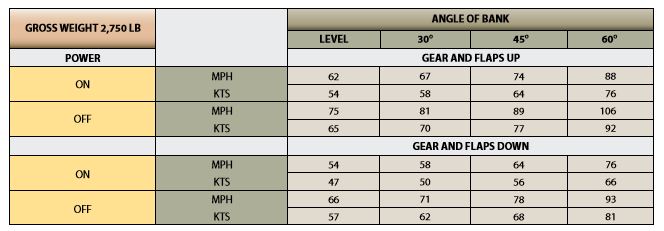 CorrectIncorrect
CorrectIncorrect -
Question 54 of 649
54. Question
Refer to the diagram below. Select the correct statement regarding stall speeds. The airplane will stall
 CorrectIncorrect
CorrectIncorrect -
Question 55 of 649
55. Question
A stall will occur
CorrectIncorrect -
Question 56 of 649
56. Question
Refer to the diagram below. Use the diagram to determine the critical angle of attack
 CorrectIncorrect
CorrectIncorrect -
Question 57 of 649
57. Question
In a rapid recovery from a dive, the effects of load factor would cause the stall speed to
CorrectIncorrect -
Question 58 of 649
58. Question
The stalling speed of an airplane is most affected by
CorrectIncorrect -
Question 59 of 649
59. Question
Recovery from a stall in any airplane becomes more difficult when its
CorrectIncorrect -
Question 60 of 649
60. Question
A left side slip is used to counteract a crosswind drift during the final approach for landing. An over-the top spin would most likely occur if the controls were used in which of the following ways? Holding the stick
CorrectIncorrect -
Question 61 of 649
61. Question
In small airplanes, normal recovery from spins may become difficult if the
CorrectIncorrect -
Question 62 of 649
62. Question
Which statement is true relative to changing angle of attack?
CorrectIncorrect -
Question 63 of 649
63. Question
To generate the same amount of lift as altitude is increased, an airplane must be flown at
CorrectIncorrect -
Question 64 of 649
64. Question
A pilot who intends to maintain level flight must coordinate the angle of attack and
CorrectIncorrect -
Question 65 of 649
65. Question
As the angle of bank is increased, the vertical component of lift
CorrectIncorrect -
Question 66 of 649
66. Question
Which is true regarding the forces acting on an aircraft in a steady-state descent? The sum of all
CorrectIncorrect -
Question 67 of 649
67. Question
During the transition from straight-and-level flight to a climb, the angle of attack is increased and lift
CorrectIncorrect -
Question 68 of 649
68. Question
Which is true regarding the force of lift in steady, unaccelerated flight?
CorrectIncorrect -
Question 69 of 649
69. Question
What changes in airplane longitudinal control must be made to maintain altitude while the airspeed is being decreased?
CorrectIncorrect -
Question 70 of 649
70. Question
In theory, if the airspeed of an airplane is doubled while in level flight, parasite drag will become
CorrectIncorrect -
Question 71 of 649
71. Question
As airspeed decreases in level flight below that speed for maximum lift/drag ratio, total drag of an airplane
CorrectIncorrect -
Question 72 of 649
72. Question
If airspeed remains constant, but the air density increases, what will be the effect on both lift and drag?
CorrectIncorrect -
Question 73 of 649
73. Question
Refer to the diagram below. At an airspeed represented by point B, in steady flight, the pilot can expect to obtain the airplane's maximum
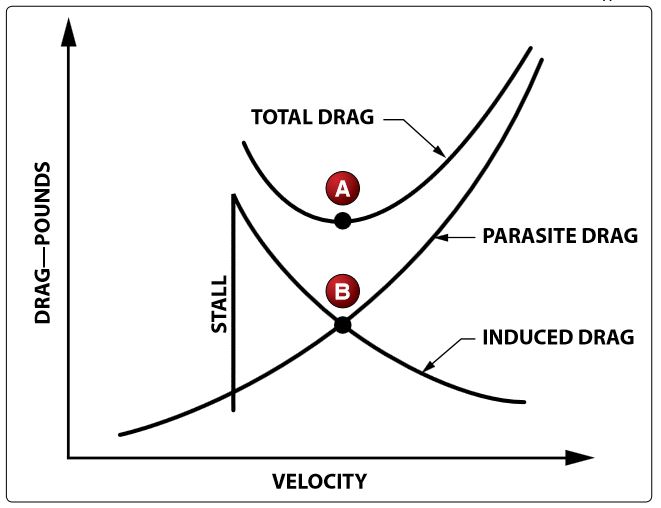 CorrectIncorrect
CorrectIncorrect -
Question 74 of 649
74. Question
Refer to the diagram below. At the airspeed represented by point A, in steady flight, the airplane will
 CorrectIncorrect
CorrectIncorrect -
Question 75 of 649
75. Question
What performance is characteristic of flight at maximum lift/drag ratio in a propeller-driven airplane? Maximum
CorrectIncorrect -
Question 76 of 649
76. Question
In theory, if the angle of attack and other factors remain constant and the airspeed is doubled, the lift produced at the higher speed will be
CorrectIncorrect -
Question 77 of 649
77. Question
An aircraft wing is designed to produce lift resulting from a difference in the
CorrectIncorrect -
Question 78 of 649
78. Question
To hold an airplane in level flight at airspeeds from very slow to very fast, a pilot must coordinate thrust and
CorrectIncorrect -
Question 79 of 649
79. Question
Lift on a wing is most properly defined as the
CorrectIncorrect -
Question 80 of 649
80. Question
In theory, if the airspeed of an aircraft is cut in half while in level flight, parasite drag will become
CorrectIncorrect -
Question 81 of 649
81. Question
Refer to the diagram below. If an airplane glides at an angle of attack of 10 degrees, how much altitude will it lose in 1 mile?
 CorrectIncorrect
CorrectIncorrect -
Question 82 of 649
82. Question
Refer to the diagram below. How much altitude will this airplane lose in 3 statute miles of gliding at an angle of attack of 8 degrees?
 CorrectIncorrect
CorrectIncorrect -
Question 83 of 649
83. Question
Refer to the diagram below. The L/D ratio at a 2 degree angle of attack is approximately the same as the L/D ratio for a
 CorrectIncorrect
CorrectIncorrect -
Question 84 of 649
84. Question
On a wing, the force of lift acts perpendicular to and the force of drag acts parallel to the
CorrectIncorrect -
Question 85 of 649
85. Question
Which statement is true regarding the opposing forces acting on an airplane in steady-state level flight?
CorrectIncorrect -
Question 86 of 649
86. Question
Both lift and drag would be increased when which of these devices are extended?
CorrectIncorrect -
Question 87 of 649
87. Question
Refer to the diagram below. As you are flying with a headwind from the coastline inland toward your destination airport, your aircraft has engine failure. You would expect your glide path to be
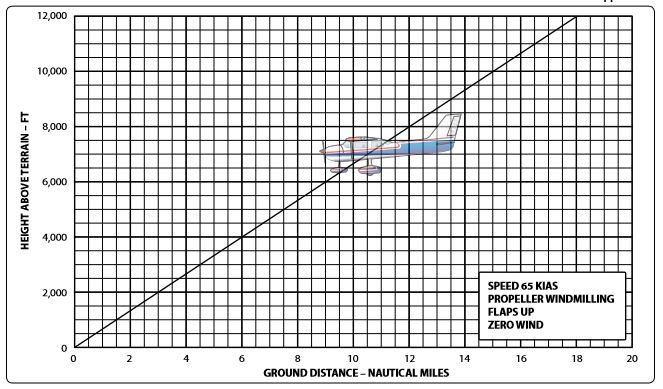 CorrectIncorrect
CorrectIncorrect -
Question 88 of 649
88. Question
Refer to the diagram below. At an altitude of 2,000 feet AGL, how far would you expect to glide?
 CorrectIncorrect
CorrectIncorrect -
Question 89 of 649
89. Question
An airplane leaving ground effect will
CorrectIncorrect -
Question 90 of 649
90. Question
To produce the same lift while in ground effect as when out of ground effect, the airplane requires
CorrectIncorrect -
Question 91 of 649
91. Question
If the same angle of attack is maintained in ground effect as when out of ground effect, lift will
CorrectIncorrect -
Question 92 of 649
92. Question
Longitudinal stability involves the motion of the airplane controlled by its
CorrectIncorrect -
Question 93 of 649
93. Question
Longitudinal dynamic instability in an airplane can be identified by
CorrectIncorrect -
Question 94 of 649
94. Question
If the airplane attitude remains in a new position after the elevator control is pressed forward and released, the airplane displays
CorrectIncorrect -
Question 95 of 649
95. Question
If the airplane attitude initially tends to return to its original position after the elevator control is pressed forward and released, the airplane displays
CorrectIncorrect -
Question 96 of 649
96. Question
If an airplane is loaded to the rear of its CG range, it will tend to be unstable about its
CorrectIncorrect -
Question 97 of 649
97. Question
If airspeed is increased during a level turn, what action would be necessary to maintain altitude? The angle of attack
CorrectIncorrect -
Question 98 of 649
98. Question
If a standard rate turn is maintained, how long would it take to turn 360 degrees?
CorrectIncorrect -
Question 99 of 649
99. Question
While holding the angle of bank constant in a level turn, if the rate of turn is varied the load factor would
CorrectIncorrect -
Question 100 of 649
100. Question
Which is correct with respect to rate and radius of turn for an airplane flown in a coordinated turn at a constant altitude?
CorrectIncorrect -
Question 101 of 649
101. Question
To increase the rate of turn and at the same time decrease the radius, a pilot should
CorrectIncorrect -
Question 102 of 649
102. Question
While maintaining a constant angle of bank and altitude in a coordinated turn, an increase in airspeed will
CorrectIncorrect -
Question 103 of 649
103. Question
Why is it necessary to increase back elevator pressure to maintain altitude during a turn? To compensate for the
CorrectIncorrect -
Question 104 of 649
104. Question
To maintain altitude during a turn, the angle of attack must be increased to compensate for the decrease in the
CorrectIncorrect -
Question 105 of 649
105. Question
The ratio between the total airload imposed on the wing and the gross weight of an aircraft in flight is known as
CorrectIncorrect -
Question 106 of 649
106. Question
Load factor is the lift generated by the wings of an aircraft at any given time.
CorrectIncorrect -
Question 107 of 649
107. Question
For a given angle of bank, in any airplane, the load factor imposed in a coordinated constant-altitude turn
CorrectIncorrect -
Question 108 of 649
108. Question
Airplane wing loading during a level coordinated turn in smooth air depends upon the
CorrectIncorrect -
Question 109 of 649
109. Question
The load factor for an airplane in a 60 degree banked turn is
CorrectIncorrect -
Question 110 of 649
110. Question
A load factor of 1.2 means the total load on an aircraft's structure is 1.2 times its
CorrectIncorrect -
Question 111 of 649
111. Question
If an aircraft with a gross weight of 2,000 pounds was subjected to a 60° constant-altitude bank, the total load would be
CorrectIncorrect -
Question 112 of 649
112. Question
If the airspeed is increased from 90 knots to 135 knots during a level 60° banked turn, the load factor will
CorrectIncorrect -
Question 113 of 649
113. Question
If the airspeed is decreased from 98 knots to 85 knots during a coordinated level 45° banked turn, the load factor will
CorrectIncorrect -
Question 114 of 649
114. Question
Refer to the diagram below. What increase in load factor would take lace if the angle of bank were increased from 60 degrees to 80 degrees.
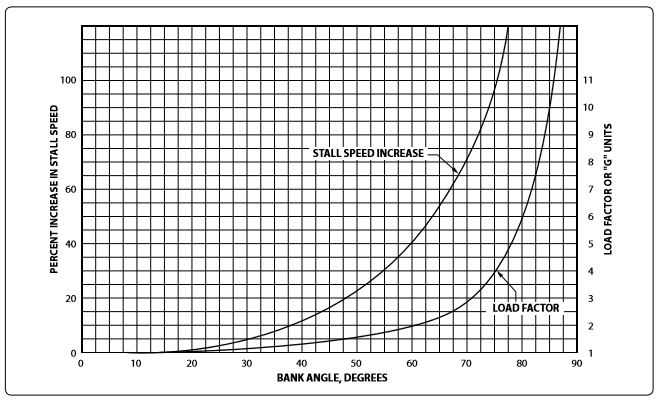 CorrectIncorrect
CorrectIncorrect -
Question 115 of 649
115. Question
Refer to the diagram below. What is the stall speed of an airplane under a load factor of 2.5 Gs if the unaccelerated stall speed is 60 knots?
 CorrectIncorrect
CorrectIncorrect -
Question 116 of 649
116. Question
Refer to the diagram below. What is the stall speed of an airplane under a load factor of 2 Gs if the unaccelerated stall speed is 60 knots?
 CorrectIncorrect
CorrectIncorrect -
Question 117 of 649
117. Question
Which factor below is the best indication of positive or negative Gs in an aircraft?
CorrectIncorrect -
Question 118 of 649
118. Question
Baggage weighing 90 pounds is placed in a no ma! category airplane's baggage compartment, which 1s placarded at 100 pounds. If this airplane is subjected to a positive load factor of 3.5 Gs, the total load of the baggage would be
CorrectIncorrect -
Question 119 of 649
119. Question
Which of the following would best indicate to the pilot that the load factor placed on the airframe has been increased?
CorrectIncorrect -
Question 120 of 649
120. Question
The ratio of an airplane's true airspeed to the speed of sound in the same atmospheric conditions is
CorrectIncorrect -
Question 121 of 649
121. Question
Transonic airflow typically occurs in airplane speed regimes between Mach
CorrectIncorrect -
Question 122 of 649
122. Question
Acceleration past critical Mach speed may cause compressibility issues such as
CorrectIncorrect -
Question 123 of 649
123. Question
If the airspeed is increased from 89 knots to 98 knots during a coordinated level 45 degree banked turn, the load factor will
CorrectIncorrect -
Question 124 of 649
124. Question
Accelerating past critical Mach may result in the onset of compressibility effects such as
CorrectIncorrect -
Question 125 of 649
125. Question
For internal cooling, reciprocating aircraft engines are especially dependent on
CorrectIncorrect -
Question 126 of 649
126. Question
An abnormally high engine oil temperature indication may be caused by
CorrectIncorrect -
Question 127 of 649
127. Question
Frequent inspections should be made of aircraft exhaust manifold-type heating systems to minimize the possibility of
CorrectIncorrect -
Question 128 of 649
128. Question
Propeller efficiency is the
CorrectIncorrect -
Question 129 of 649
129. Question
A fixed-pitch propeller is designed for best efficiency only at a given combination of
CorrectIncorrect -
Question 130 of 649
130. Question
The reason for variations in geometric pitch (twisting) along a propeller blade is that it
CorrectIncorrect -
Question 131 of 649
131. Question
Which statement best describes the operating principle of a constant-speed propeller?
CorrectIncorrect -
Question 132 of 649
132. Question
When referring to a constant speed propeller, the pitch setting is
CorrectIncorrect -
Question 133 of 649
133. Question
To develop maximum power and thrust, a constant-speed propeller should be set to a blade angle that will produce a
CorrectIncorrect -
Question 134 of 649
134. Question
In aircraft equipped with constant-speed propellers and normally-aspirated engines, which procedure should be used to avoid placing undue stress on the engine components? When power is being
CorrectIncorrect -
Question 135 of 649
135. Question
For takeoff, the blade angle of a controllable-pitch propeller should be set at a
CorrectIncorrect -
Question 136 of 649
136. Question
To establish a climb after takeoff in an aircraft equipped with a constant-speed propeller, the output of the engine is reduced to climb power by decreasing manifold pressure and
CorrectIncorrect -
Question 137 of 649
137. Question
A propeller rotating clockwise as seen from the rear, creates a spiraling slipstream. The spiraling slipstream, along with torque effect, tends to rotate the airplane to the
CorrectIncorrect -
Question 138 of 649
138. Question
Which of the following terms describes an airport?
CorrectIncorrect -
Question 139 of 649
139. Question
Regulations which refer to "commercial operators" relate to that person who
CorrectIncorrect -
Question 140 of 649
140. Question
Regulations which refer to the "operational control" of a flight are in relation to
CorrectIncorrect -
Question 141 of 649
141. Question
Regulations which refer to "operate" relate to that person who
CorrectIncorrect -
Question 142 of 649
142. Question
Which is the correct symbol for the stalling speed or the minimum steady flight speed in a specified configuration?
CorrectIncorrect -
Question 143 of 649
143. Question
Which is the correct symbol for the stalling speed or the minimum steady flight speed at which the airplane is controllable?
CorrectIncorrect -
Question 144 of 649
144. Question
14 CFR Part 1 defines VF as
CorrectIncorrect -
Question 145 of 649
145. Question
14 CFR Part 1 defines VNo as
CorrectIncorrect -
Question 146 of 649
146. Question
14 CFR Part 1 defines VLE as
CorrectIncorrect -
Question 147 of 649
147. Question
14 CFR Part 1 defines VNE as
CorrectIncorrect -
Question 148 of 649
148. Question
14 CFR Part 1 defines Vy as
CorrectIncorrect -
Question 149 of 649
149. Question
14 CFR Part 1 defines VNo as
CorrectIncorrect -
Question 150 of 649
150. Question
If an airplane category is listed as utility, it would mean that this airplane could be operated in which of the following maneuvers?
CorrectIncorrect -
Question 151 of 649
151. Question
Which is true regarding flight operations in Class A airspace?
CorrectIncorrect -
Question 152 of 649
152. Question
Which is true regarding pilot certification requirements for operations in Class B airspace?
CorrectIncorrect -
Question 153 of 649
153. Question
Which is true regarding flight operations in Class A airspace?
CorrectIncorrect -
Question 154 of 649
154. Question
Which is true regarding flight operations in Class B airspace?
CorrectIncorrect -
Question 155 of 649
155. Question
What is the maximum indicated airspeed authorized in the airspace underlying Class B airspace?
CorrectIncorrect -
Question 156 of 649
156. Question
What transponder equipment is required for airplane operations within Class B airspace? A transponder
CorrectIncorrect -
Question 157 of 649
157. Question
Which is true regarding flight operations in Class B airspace?
CorrectIncorrect -
Question 158 of 649
158. Question
Unless otherwise authorized or required by ATC, the maximum indicated airspeed permitted when at or below 2,500 feet AGL within 4 NM of the primary airport within Class C or D airspace is
CorrectIncorrect -
Question 159 of 649
159. Question
The radius of the uncharted Outer Area of Class C airspace is normally
CorrectIncorrect -
Question 160 of 649
160. Question
At some airports located in Class D airspace where ground visibility is not reported, takeoffs and landings under special VFR are
CorrectIncorrect -
Question 161 of 649
161. Question
If the minimum safe speed for any particular operation is greater than the maximum speed prescribed in 14 CFR Part 91, the
CorrectIncorrect -
Question 162 of 649
162. Question
12. Which is true regarding flight operations to or from a satellite airport, without an operating control tower, within the Class C airspace area?
CorrectIncorrect -
Question 163 of 649
163. Question
Which is true regarding flight operations to or from a satellite airport, without an operating control tower, within the Class C airspace area?
CorrectIncorrect -
Question 164 of 649
164. Question
When operating an airplane for the purpose of takeoff or landing within Class D airspace under special VFR, what minimum distance from clouds and what visibility are required?
CorrectIncorrect -
Question 165 of 649
165. Question
To operate an airplane under SPECIAL VFR (SVFR) within Class D airspace at night, which is required?
CorrectIncorrect -
Question 166 of 649
166. Question
When approaching to land at an airport with an ATC facility, in Class D airspace, the pilot must establish communications prior to
CorrectIncorrect -
Question 167 of 649
167. Question
Excluding Hawaii, the vertical limits of the Federal Low Altitude airways extend from
CorrectIncorrect -
Question 168 of 649
168. Question
When operating an aircraft in the vicinity of an airport with an operating control tower, in Class E airspace, a pilot must establish communications prior to
CorrectIncorrect -
Question 169 of 649
169. Question
Commercial pilots are required to have a valid and appropriate pilot certificate in their physical possession or readily accessible in the aircraft when
CorrectIncorrect -
Question 170 of 649
170. Question
What designated airspace associated with an airport becomes inactive when the control tower at that airport is not in operation?
CorrectIncorrect -
Question 171 of 649
171. Question
When approaching to land at an airport without an operating control tower, in Class G airspace, the pilot should
CorrectIncorrect -
Question 172 of 649
172. Question
Which of the following are considered aircraft class ratings?
CorrectIncorrect -
Question 173 of 649
173. Question
Refer to the diagram below. The pilot generally calls ground control after landing when the aircraft is completely clear of the runway. This is when


 CorrectIncorrect
CorrectIncorrect -
Question 174 of 649
174. Question
A pilot convicted of operating a motor vehicle while either intoxicated by, impaired by, or under the influence of alcohol or a drug is required to provide a
CorrectIncorrect -
Question 175 of 649
175. Question
Refer to the diagram below. The red symbol at the top would most likely be found


 CorrectIncorrect
CorrectIncorrect -
Question 176 of 649
176. Question
Refer to the diagram below. While clearing an active runway you are most likely clear of the ILS critical area when you pass which symbol?


 CorrectIncorrect
CorrectIncorrect -
Question 177 of 649
177. Question
Refer to the diagram below. The ILS Critical Area Boundary Sign indicates


 CorrectIncorrect
CorrectIncorrect -
Question 178 of 649
178. Question
Refer to the diagram below. From the cockpit, the middle marking confirms the aircraft to be


 CorrectIncorrect
CorrectIncorrect -
Question 179 of 649
179. Question
Refer to the diagram below. When taxiing up to an active runway, you are likely to be clear of the ILS critical area when short of which symbol?


 CorrectIncorrect
CorrectIncorrect -
Question 180 of 649
180. Question
Refer to the diagram below. Which symbol does not directly address runway incursion with other aircraft?


 CorrectIncorrect
CorrectIncorrect -
Question 181 of 649
181. Question
Refer to the diagram below. Which of the signs in the figure is a mandatory instruction sign?


 CorrectIncorrect
CorrectIncorrect -
Question 182 of 649
182. Question
A pilot convicted of a motor vehicle offense involving alcohol or drugs is required to provide a written report to the
CorrectIncorrect -
Question 183 of 649
183. Question
The runway holding position sign is located on
CorrectIncorrect -
Question 184 of 649
184. Question
A pilot convicted for the violation of any Federal or State statute relating to the process, manufacture, transportation, distribution, or sale of narcotic drugs is grounds for
CorrectIncorrect -
Question 185 of 649
185. Question
Refer to the diagram below. As you taxi you see sign 2 on the right side of the aircraft and sign 1 directly in front of you on the opposite side of the intersection. Does the taxiway continue on the opposite side of the intersection?
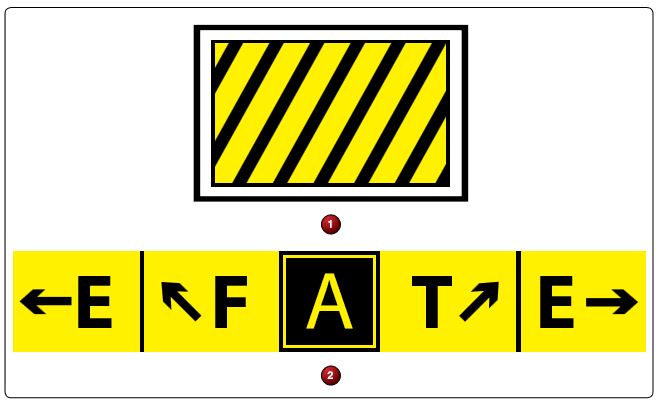 CorrectIncorrect
CorrectIncorrect -
Question 186 of 649
186. Question
Refer to the diagram below. Sign 1 is an indication
 CorrectIncorrect
CorrectIncorrect -
Question 187 of 649
187. Question
Which of the following best describes a destination sign?
CorrectIncorrect -
Question 188 of 649
188. Question
When turning onto a taxiway from another taxiway, the "taxiway directional sign" indicates
CorrectIncorrect -
Question 189 of 649
189. Question
Refer to the diagram below. The "taxiwayending" marker
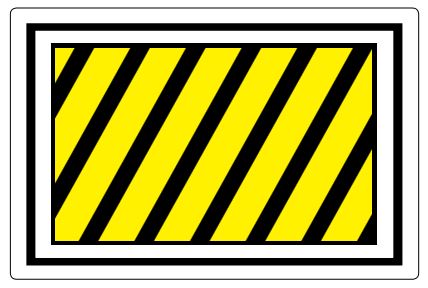 CorrectIncorrect
CorrectIncorrect -
Question 190 of 649
190. Question
Refer to the diagram below. Use the sign and taxiway diagram. You are approaching the intersection on taxiway 5 and see the sign at the left of the intersection. Taxiway number 2 is identified as
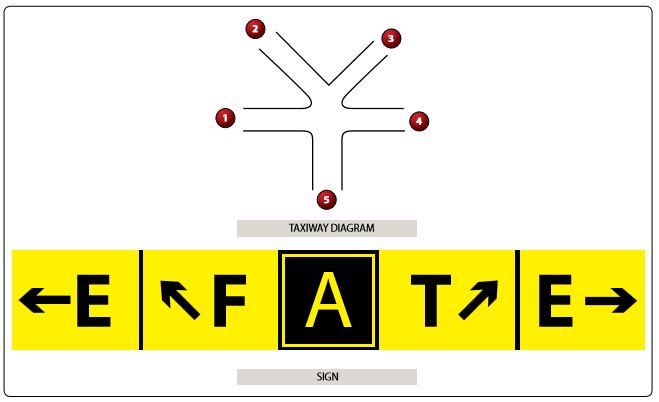 CorrectIncorrect
CorrectIncorrect -
Question 191 of 649
191. Question
Refer to the diagram below. This sign is a visual clue that
 CorrectIncorrect
CorrectIncorrect -
Question 192 of 649
192. Question
A pilot convicted of operating an aircraft as a crewmember under the influence of alcohol, or using drugs that affect the person's faculties, is grounds for a
CorrectIncorrect -
Question 193 of 649
193. Question
"Runway Holding Position Markings" on taxiways
CorrectIncorrect -
Question 194 of 649
194. Question
Does a commercial pilot certificate have a specific expiration date?
CorrectIncorrect -
Question 195 of 649
195. Question
A second-class medical certificate issued to a commercial pilot on April 10, this year, permits the pilot to exercise which of the following privileges?
CorrectIncorrect -
Question 196 of 649
196. Question
Refer to the diagram below. You are directed to taxi to runway 10. You see this sign at a taxiway intersection while taxiing. Which way should you proceed?
 CorrectIncorrect
CorrectIncorrect -
Question 197 of 649
197. Question
The "yellow demarcation bar" marking indicates
CorrectIncorrect -
Question 198 of 649
198. Question
To act as pilot in command of an airplane that is equipped with retractable landing gear, flaps, and controllable pitch propeller, a person is required to
CorrectIncorrect -
Question 199 of 649
199. Question
What is the purpose of the runway exit sign?
CorrectIncorrect -
Question 200 of 649
200. Question
To act as pilot-in-command of an airplane with more than 200 horsepower, a person is required to
CorrectIncorrect -
Question 201 of 649
201. Question
To act as pilot in command of a tailwheel airplane, without prior experience, a pilot must
CorrectIncorrect -
Question 202 of 649
202. Question
Refer to the diagram below. Which marking indicates a vehicle lane?
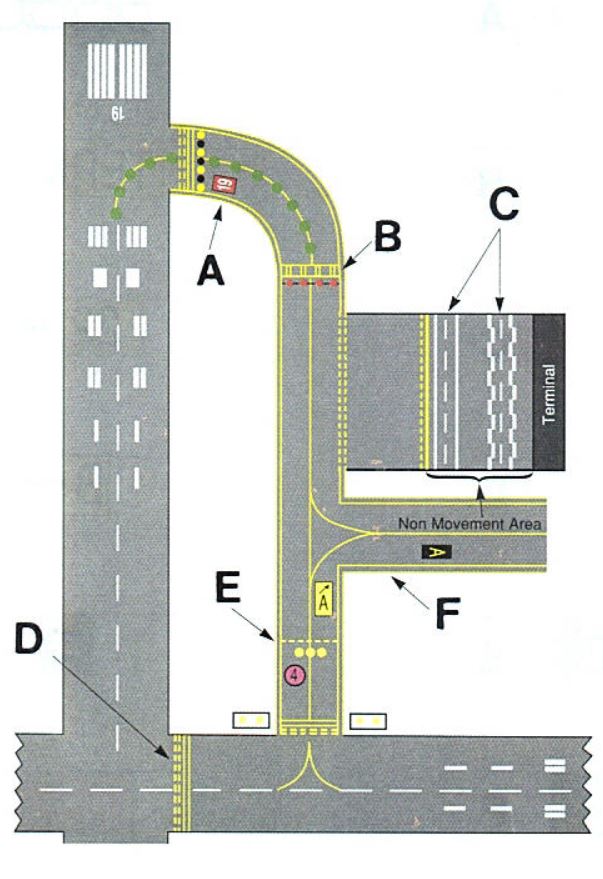 CorrectIncorrect
CorrectIncorrect -
Question 203 of 649
203. Question
Refer to the diagram below. At what point on the airport diagram could a pilot expect to see this sign?
 CorrectIncorrect
CorrectIncorrect -
Question 204 of 649
204. Question
When is the pilot in command required to hold a category and class rating appropriate to the aircraft being flown?
CorrectIncorrect -
Question 205 of 649
205. Question
Refer to the diagram below. If you were on a taxiway approaching or leading to Runway 22, which sign would you see?
 CorrectIncorrect
CorrectIncorrect -
Question 206 of 649
206. Question
Refer to the diagram below. Sign 1 confirms your position on
 CorrectIncorrect
CorrectIncorrect -
Question 207 of 649
207. Question
Refer to the diagram below. You are viewing this sign from the cockpit as you hold short of the runway. The air traffic controller clears you to back taxi on the runway for a full length departure on Runway 8. Which way would you turn to begin the back taxi?
 CorrectIncorrect
CorrectIncorrect -
Question 208 of 649
208. Question
Refer to the diagram below. You are viewing this sign from the cockpit as you hold short of the runway. The air traffic controller clears you to back taxi on the runway for a full length departure on Runway 26. Which way would you turn to begin the back taxi?
 CorrectIncorrect
CorrectIncorrect -
Question 209 of 649
209. Question
Unless otherwise authorized, the pilot in command is required to hold a type rating when operating any
CorrectIncorrect -
Question 210 of 649
210. Question
Refer to the diagram below. You are holding short for an intersection departure on Runway 8 with the sign in front of you. Which way should you turn when taxiing onto the runway to depart Runway 8?
 CorrectIncorrect
CorrectIncorrect -
Question 211 of 649
211. Question
Refer to the diagram below. You are holding short for an intersection departure on Runway 26 with the sign in front of you. Which way should you turn when taxiing onto the runway for departure?
 CorrectIncorrect
CorrectIncorrect -
Question 212 of 649
212. Question
To act as pilot in command of a tailwheel airplane, without prior experience, a pilot must
CorrectIncorrect -
Question 213 of 649
213. Question
Refer to the diagram below. If cleared for an intersection takeoff on runway 8, you see this sign at the intersection hold short position. Which way should you turn when taxiing onto the runway?
 CorrectIncorrect
CorrectIncorrect -
Question 214 of 649
214. Question
Refer to the diagram below. You see this sign when holding short of the runway. You receive clearance to back taxi on the runway for a full-length runway 8 departure. Which way should you turn when taxiing onto the runway?
 CorrectIncorrect
CorrectIncorrect -
Question 215 of 649
215. Question
What flight time may a pilot log as second in command?
CorrectIncorrect -
Question 216 of 649
216. Question
What flight time must be documented and recorded by a pilot exercising the privileges of a commercial certificate?
CorrectIncorrect -
Question 217 of 649
217. Question
To serve as second in command of an airplane that is certificated for more than one pilot crew member, and operated under Part 91, a person must
CorrectIncorrect -
Question 218 of 649
218. Question
To act as pilot in command of an aircraft under 14 CFR Part 91, a commercial pilot must have satisfactorily accomplished a flight review or completed a proficiency check within the preceding
CorrectIncorrect -
Question 219 of 649
219. Question
If a pilot does not meet the recency of experience requirements for night flight and official sunset is 1900 CST, the latest time passengers should be carried is
CorrectIncorrect -
Question 220 of 649
220. Question
Prior to carrying passengers at night, the pilot in command must have accomplished the required takeoffs and landings in
CorrectIncorrect -
Question 221 of 649
221. Question
No pilot may act as pilot in command of an aircraft under IFR or in weather conditions less than the minimums prescribed for VFR unless that pilot has, within the past 6 months, performed and logged under actual or simulated instrument conditions, at least
CorrectIncorrect -
Question 222 of 649
222. Question
To serve as pilot in command of an airplane that is certified for more than one pilot crew member, and operated under Part 91, a person must
CorrectIncorrect -
Question 223 of 649
223. Question
Pilots who change their permanent mailing address and fail to notify the FAA Airmen Certification Branch of this change, are entitled to exercise the privileges of their pilot certificate for a period of
CorrectIncorrect -
Question 224 of 649
224. Question
To act as pilot in command of an airplane towing a glider, a pilot must have accomplished, within the preceding 12 months, at least
CorrectIncorrect -
Question 225 of 649
225. Question
To act as pilot in command of an airplane towing a glider, the tow pilot is required to have
CorrectIncorrect -
Question 226 of 649
226. Question
What limitation is imposed on a newly certificated commercial pilot-airplane, if that person does not hold an instrument rating? The carriage of passengers
CorrectIncorrect -
Question 227 of 649
227. Question
A person with a Commercial Pilot certificate may act as pilot in command of an aircraft for compensation or hire, if that person
CorrectIncorrect -
Question 228 of 649
228. Question
What action must be taken when a pilot in command deviates from any rule in 14 CFR Part 91?
CorrectIncorrect -
Question 229 of 649
229. Question
What person is directly responsible for the final authority as to the operation of the airplane?
CorrectIncorrect -
Question 230 of 649
230. Question
Who is responsible for determining if an aircraft is in condition for safe flight?
CorrectIncorrect -
Question 231 of 649
231. Question
An aircraft is on a stop 460 NM from base. It develops a mechanical problem. You get a technician to fix the problem. Who is responsible for the airworthiness of the aircraft?
CorrectIncorrect -
Question 232 of 649
232. Question
When operating a U.S.-registered civil aircraft, which document is required by regulation to be available in the aircraft?
CorrectIncorrect -
Question 233 of 649
233. Question
A pilot in command (PIC) of a civil aircraft may not allow any object to be dropped from that aircraft in flight
CorrectIncorrect -
Question 234 of 649
234. Question
Portable electronic devices which may cause interference with the navigation or communication system may not be operated on a U.S.-registered civil aircraft being flown
CorrectIncorrect -
Question 235 of 649
235. Question
Portable electronic devices which may cause interference with the navigation or communication system may not be operated on U.S.-registered civil aircraft being operated
CorrectIncorrect -
Question 236 of 649
236. Question
No person may operate a large civil aircraft of U.S.-registry which is subject to a lease, unless the lessee has mailed a copy of the lease to the FAA Aircraft Registration Branch, Oklahoma City, OK, within how many hours of its execution?
CorrectIncorrect -
Question 237 of 649
237. Question
When is preflight action required, relative to alternatives available, if the planned flight cannot be completed?
CorrectIncorrect -
Question 238 of 649
238. Question
The required preflight action relative to weather reports and fuel requirements is applicable to
CorrectIncorrect -
Question 239 of 649
239. Question
Before beginning any flight under IFR, the pilot in command must become familiar with all available information concerning that flight. In addition, the pilot must
CorrectIncorrect -
Question 240 of 649
240. Question
Before beginning any flight under IFR, the pilot in command must become familiar with all available information concerning that flight. In addition, the pilot must
CorrectIncorrect -
Question 241 of 649
241. Question
A pilot in command is required to be aware of all of the information pertinent to the flight. This should include what information about the destination airport?
CorrectIncorrect -
Question 242 of 649
242. Question
Required flight crewmembers' seatbelts must be fastened
CorrectIncorrect -
Question 243 of 649
243. Question
Each required flight crewmember is required to keep his or her shoulder harness fastened
CorrectIncorrect -
Question 244 of 649
244. Question
Operating regulations for U.S.-registered civil airplanes require that during movement on the surface, takeoffs, and landings, a seat belt and shoulder harness (if installed) must be properly secured about each
CorrectIncorrect -
Question 245 of 649
245. Question
With U.S.-registered civil airplanes, the use of safety belts is required during movement on the surface, takeoffs, and landings for
CorrectIncorrect -
Question 246 of 649
246. Question
No person may operate an aircraft in simulated instrument flight conditions unless the
CorrectIncorrect -
Question 247 of 649
247. Question
Which is true with respect to operating near other aircraft in flight? They are
CorrectIncorrect -
Question 248 of 649
248. Question
Which is true with respect to formation flights? Formation flights are
CorrectIncorrect -
Question 249 of 649
249. Question
Which is true with respect to formation flights? Formation flights are
CorrectIncorrect -
Question 250 of 649
250. Question
Airplane A is overtaking airplane B. Which airplane has the right-of-way?
CorrectIncorrect -
Question 251 of 649
251. Question
An airplane is overtaking a helicopter. Which aircraft has the right-of-way?
CorrectIncorrect -
Question 252 of 649
252. Question
Two aircraft of the same category are approaching an airport for the purpose of landing. The right-of-way belongs to the aircraft
CorrectIncorrect -
Question 253 of 649
253. Question
During a night operation, the pilot of aircraft #1 sees only the green light of aircraft #2. If the aircraft are converging, which pilot has the right-of-way? The pilot of aircraft
CorrectIncorrect -
Question 254 of 649
254. Question
A pilot flying a single-engine airplane observes a multiengine airplane approaching from the left. Which pilot should give way?
CorrectIncorrect -
Question 255 of 649
255. Question
While in flight a helicopter and an airplane are converging at a 90° angle, and the helicopter is located to the right of the airplane. Which aircraft has the right-of-way, and why?
CorrectIncorrect -
Question 256 of 649
256. Question
What altimeter setting is required when operating an aircraft at 18,000 feet MSL?
CorrectIncorrect -
Question 257 of 649
257. Question
After an ATC clearance has been obtained, a pilot may not deviate from that clearance, unless the pilot
CorrectIncorrect -
Question 258 of 649
258. Question
When weather information indicates that abnormally high barometric pressure exists, or will be above ___ inches of mercury, flight operations will not be authorized contrary to the requirements published in NOTAMs.
CorrectIncorrect -
Question 259 of 649
259. Question
Refer to the diagram below. This taxiway sign would be expected
 CorrectIncorrect
CorrectIncorrect -
Question 260 of 649
260. Question
What is the minimum flight visibility and proximity to cloud requirements for VFR flight, at 6,500 feet MSL, in Class C, D, and E airspace?
CorrectIncorrect -
Question 261 of 649
261. Question
How can you determine if another aircraft is on a collision course with your aircraft?
CorrectIncorrect -
Question 262 of 649
262. Question
What is the general direction of movement of the other aircraft if during a night flight you observe a steady white light and a rotating red light ahead and at your altitude? The other aircraft is
CorrectIncorrect -
Question 263 of 649
263. Question
The minimum flight visibility for VFR flight increases to 5 statute miles beginning at an altitude of
CorrectIncorrect -
Question 264 of 649
264. Question
When in the vicinity of a VOR which is being used for navigation on VFR flight, it is important to
CorrectIncorrect -
Question 265 of 649
265. Question
VFR cruising altitudes are required to be maintained when flying
CorrectIncorrect -
Question 266 of 649
266. Question
During a takeoff made behind a departing large jet airplane, the pilot can minimize the hazard of wingtip vortices by
CorrectIncorrect -
Question 267 of 649
267. Question
If weather conditions are such that it is required to designate an alternate airport on your IFR flight plan, you should plan to carry enough fuel to arrive at the first airport of intended landing, fly from that airport to the alternate airport, and fly thereafter for
CorrectIncorrect -
Question 268 of 649
268. Question
To avoid possible wake turbulence from a large jet aircraft that has just landed prior to your takeoff, at which point on the runway should you plan to become airborne?
CorrectIncorrect -
Question 269 of 649
269. Question
Which procedure should you follow to avoid wake turbulence if a large jet crosses your course from left to right approximately 1 mile ahead and at your altitude?
CorrectIncorrect -
Question 270 of 649
270. Question
For an airport with an approved instrument approach procedure to be listed as an alternate airport on an IFR flight plan, the forecasted weather conditions at the time of arrival must be at or above the following weather minimums.
CorrectIncorrect -
Question 271 of 649
271. Question
For an airport without an approved instrument approach procedure to be listed as an alternate airport on an IFR flight plan, the forecasted weather conditions at the time of arrival must have at least a
CorrectIncorrect -
Question 272 of 649
272. Question
Choose the correct statement regarding wake turbulence.
CorrectIncorrect -
Question 273 of 649
273. Question
When landing behind a large aircraft, which procedure should be followed for vortex avoidance?
CorrectIncorrect -
Question 274 of 649
274. Question
When must an operational check on the aircraft VOR equipment be accomplished to operate under IFR? Within the preceding
CorrectIncorrect -
Question 275 of 649
275. Question
What is the maximum bearing error(+ or -) allowed for an operational VOR equipment check when using an FAA-approved ground test signal?
CorrectIncorrect -
Question 276 of 649
276. Question
Which is true with respect to vortex circulation in the wake turbulence generated by an aircraft?
CorrectIncorrect -
Question 277 of 649
277. Question
Which data must be recorded in the aircraft logbook or other record by a pilot making VOR operational check for IFR operations?
CorrectIncorrect -
Question 278 of 649
278. Question
With respect to vortex circulation, which is true?
CorrectIncorrect -
Question 279 of 649
279. Question
On an instrument approach where a DH or MDA is applicable, the pilot may not operate below, or continue the approach unless the
CorrectIncorrect -
Question 280 of 649
280. Question
Which is true with respect to vortex circulation?
CorrectIncorrect -
Question 281 of 649
281. Question
Pilots are not authorized to land an aircraft from an instrument approach unless the
CorrectIncorrect -
Question 282 of 649
282. Question
A pilot performing a published instrument approach is not authorized to perform a procedure turn when
CorrectIncorrect -
Question 283 of 649
283. Question
Except when necessary for takeoff or landing or unless otherwise authorized by the Administrator, the minimum altitude for IFR flight is
CorrectIncorrect -
Question 284 of 649
284. Question
The pilot in command of an aircraft operated under IFR, in controlled airspace, not in radar contact, shall report by radio as soon as possible when
CorrectIncorrect -
Question 285 of 649
285. Question
Who has the final authority to accept or decline any "land and hold short" (LAHSO) clearance?
CorrectIncorrect -
Question 286 of 649
286. Question
The commercial pilot operating as the pilot in command of an aircraft may accept or decline a land and hold short clearance (LAHSO)
CorrectIncorrect -
Question 287 of 649
287. Question
Once a pilot-in-command accepts a "land and hold short" (LAHSO) clearance, the clearance must be adhered to, just as any other ATC clearance, unless
CorrectIncorrect -
Question 288 of 649
288. Question
When should pilots decline a "land and hold short" (LAHSO) clearance?
CorrectIncorrect -
Question 289 of 649
289. Question
What is the minimum visibility and ceiling required for a pilot to receive a "land and hold short" clearance?
CorrectIncorrect -
Question 290 of 649
290. Question
What is the minimum visibility and ceiling required for a pilot to receive a "land and hold short" clearance?
CorrectIncorrect -
Question 291 of 649
291. Question
What information should a pilot have available when encountering LAHSO?
CorrectIncorrect -
Question 292 of 649
292. Question
A 'land and hold short' (LAHSO) clearance
CorrectIncorrect -
Question 293 of 649
293. Question
To conduct LAHSO a pilot should have readily available
CorrectIncorrect -
Question 294 of 649
294. Question
Prior to accepting a "land and hold short" clearance (LAHSO) a pilot must confirm the aircraft can stop
CorrectIncorrect -
Question 295 of 649
295. Question
The pilot in command of an aircraft operated under IFR, in controlled airspace, shall report as soon as practical to ATC when
CorrectIncorrect -
Question 296 of 649
296. Question
Which list accurately reflects some of the documents required to be current and carried in a U. S.-registered civil airplane flying in the United States under day Visual Flight Rules (VFR)?
CorrectIncorrect -
Question 297 of 649
297. Question
A commercial pilot is preparing for a VFR flight that will involve carrying passengers 150 NM at night. Prior to the flight what action must the PIC perform?
CorrectIncorrect -
Question 298 of 649
298. Question
Prior to departing on a VFR cross-country flight over mountainous terrain, what action must the pilot in command perform?
CorrectIncorrect -
Question 299 of 649
299. Question
You are taking a 123 nautical mile VFR flight from one airport to another. Which of the following actions must the pilot in command take?
CorrectIncorrect -
Question 300 of 649
300. Question
You are taking a 196 nautical mile VFR cross country flight in mountainous terrain. Which of the following actions must the pilot in command take?
CorrectIncorrect -
Question 301 of 649
301. Question
Approved flotation gear, readily available to each occupant, is required on each airplane if it is being flown for hire over water,
CorrectIncorrect -
Question 302 of 649
302. Question
Which is required equipment for powered aircraft during VFR night flights?
CorrectIncorrect -
Question 303 of 649
303. Question
Which is required equipment for powered aircraft during VFR night flights?
CorrectIncorrect -
Question 304 of 649
304. Question
The maximum cumulative time that an emergency locator transmitter may be operated before the rechargeable battery must be recharged is
CorrectIncorrect -
Question 305 of 649
305. Question
If not equipped with required position lights, an aircraft must terminate flight
CorrectIncorrect -
Question 306 of 649
306. Question
If an aircraft is not equipped with an electrical or anti collision light system, no person may operate that aircraft
CorrectIncorrect -
Question 307 of 649
307. Question
What are the oxygen requirements when operating at cabin pressure altitudes above 15,000 feet MSL?
CorrectIncorrect -
Question 308 of 649
308. Question
In accordance with 14 CFR Part 91, supplemental oxygen must be used by the required minimum flightcrew for that time exceeding 30 minutes while at cabin pressure altitudes of
CorrectIncorrect -
Question 309 of 649
309. Question
A coded transponder equipped with altitude reporting equipment is required for
CorrectIncorrect -
Question 310 of 649
310. Question
In the contiguous U.S., excluding the airspace at and below 2,500 feet AGL, an operable coded transponder equipped with Mode C capability is required in all airspace above
CorrectIncorrect -
Question 311 of 649
311. Question
Which is required to operate an aircraft towing an advertising banner?
CorrectIncorrect -
Question 312 of 649
312. Question
Which of the following preflight actions is the pilot in command required to take in order to comply with the United States Code of Federal Regulations regarding day Visual Flight Rules (VFR)?
CorrectIncorrect -
Question 313 of 649
313. Question
Which is true with respect to operating limitations of a "restricted" category airplane?
CorrectIncorrect -
Question 314 of 649
314. Question
The carriage of passengers for hire by a commercial pilot is
CorrectIncorrect -
Question 315 of 649
315. Question
No person may operate an aircraft that has an experimental airworthiness certificate
CorrectIncorrect -
Question 316 of 649
316. Question
Which is true with respect to operating limitations of a "primary" category airplane?
CorrectIncorrect -
Question 317 of 649
317. Question
Assuring compliance with an Airworthiness Directive is the responsibility of the
CorrectIncorrect -
Question 318 of 649
318. Question
Who is primarily responsible for maintaining an aircraft in an airworthy condition?
CorrectIncorrect -
Question 319 of 649
319. Question
After an annual inspection has been completed and the aircraft has been returned to service, an appropriate notation should be made
CorrectIncorrect -
Question 320 of 649
320. Question
A standard airworthiness certificate remains in effect as long as the aircraft receives
CorrectIncorrect -
Question 321 of 649
321. Question
If an aircraft's operation in flight was substantially affected by an alteration or repair, the aircraft documents must show that it was test flown and approved for return to service by an appropriately rated pilot prior to being operated
CorrectIncorrect -
Question 322 of 649
322. Question
Which is true concerning required maintenance inspections?
CorrectIncorrect -
Question 323 of 649
323. Question
An aircraft carrying passengers for hire has been on a schedule of inspection every 100 hours of time in service. Under which condition, if any, may that aircraft be operated beyond 100 hours without a new inspection?
CorrectIncorrect -
Question 324 of 649
324. Question
If an ATC transponder installed in an aircraft has not been tested, inspected, and found to comply with regulations within a specified period, what is the limitation on its use?
CorrectIncorrect -
Question 325 of 649
325. Question
An ATC transponder is not to be used unless it has been tested, inspected, and found to comply with regulations within the preceding
CorrectIncorrect -
Question 326 of 649
326. Question
Which is true relating to Airworthiness Directives (AD's)?
CorrectIncorrect -
Question 327 of 649
327. Question
Aircraft maintenance records must include the current status of the
CorrectIncorrect -
Question 328 of 649
328. Question
Which is correct concerning preventive maintenance, when accomplished by a pilot?
CorrectIncorrect -
Question 329 of 649
329. Question
A new maintenance record being used for an aircraft engine rebuilt by the manufacturer must include previous
CorrectIncorrect -
Question 330 of 649
330. Question
In what type of operation, not regulated by 14 CFR Part 119, may a commercial pilot act as pilot in command and receive compensation for services?
CorrectIncorrect -
Question 331 of 649
331. Question
The performance tables of an aircraft for takeoff and climb are based on
CorrectIncorrect -
Question 332 of 649
332. Question
Density altitude is the vertical distance above mean sea level in the standard atmosphere at which
CorrectIncorrect -
Question 333 of 649
333. Question
To determine pressure altitude prior to takeoff, the altimeter should be set to
CorrectIncorrect -
Question 334 of 649
334. Question
At higher elevation airports the pilot should know that indicated airspeed
CorrectIncorrect -
Question 335 of 649
335. Question
GIVEN: Pressure altitude is 12,000 ft., True air temperature is 50 degrees F. From the conditions given, the approximate density altitude is:
CorrectIncorrect -
Question 336 of 649
336. Question
GIVEN: Pressure altitude is 5,000 feet and true air temperature is 30 degrees C. From the conditions given, the approximate density altitude is
CorrectIncorrect -
Question 337 of 649
337. Question
GIVEN: Pressure altitude is 6,000 feet and true air temperature is 30 degrees F. From the conditions given, the approximate density altitude is:
CorrectIncorrect -
Question 338 of 649
338. Question
GIVEN: Pressure altitude is 12,000 feet and true air temperature is 15 degrees F. From the conditions given, the approximate density altitude is
CorrectIncorrect -
Question 339 of 649
339. Question
GIVEN: Pressure altitude is 7,000 feet and true air temperature is 15 degrees C. From the conditions given, the approximate density altitude is:
CorrectIncorrect -
Question 340 of 649
340. Question
What effect does an uphill runway slope have on takeoff performance?
CorrectIncorrect -
Question 341 of 649
341. Question
Refer to the diagram below. GIVEN: Temperature is 30 degrees F, pressure altitude is 6,000 feet, weight is 3,300 lbs., headwind is 20 kts. What is the total takeoff distance over a 50-foot obstacle?
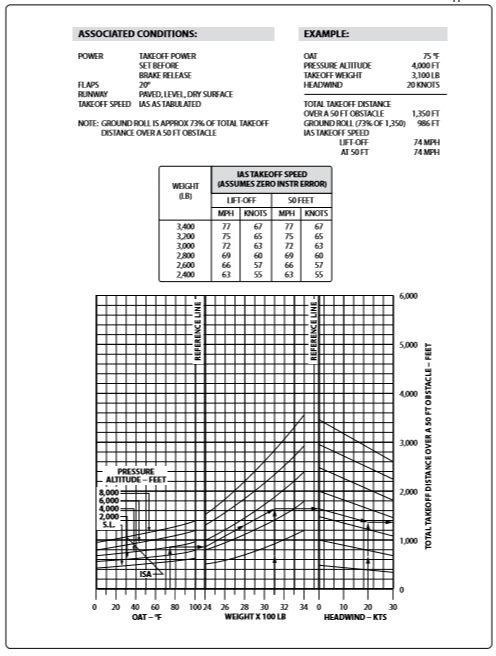 CorrectIncorrect
CorrectIncorrect -
Question 342 of 649
342. Question
Refer to the diagram below. GIVEN: Temperature is 100 degrees F, pressure altitude is 4,000 feet, weight is 3,200 lbs., wind is calm. What is the ground roll required for takeoff over a 50-foot obstacle?
 CorrectIncorrect
CorrectIncorrect -
Question 343 of 649
343. Question
Refer to the diagram below. GIVEN: Temperature is 50 degrees F, pressure altitude is 2,000 feet, weight is 2,700 lbs., wind is calm. What is the total takeoff distance over a 50-foot obstacle?
 CorrectIncorrect
CorrectIncorrect -
Question 344 of 649
344. Question
Refer to the diagram below. Using a normal climb (100 KIAS), how much fuel would be used from engine start to 12,000 feet pressure altitude? Aircraft weight is 3,800 lb., airport pressure altitude is 4,000 ft., and temperature is 26 degrees C.
 CorrectIncorrect
CorrectIncorrect -
Question 345 of 649
345. Question
Refer to the diagram below. Using a normal climb (100 KIAS), how much fuel would be used from engine start to 10,000 feet pressure altitude? Aircraft weight is 3,500 lb., airport pressure altitude is 4,000 feet and temperature is 21 degrees C.
 CorrectIncorrect
CorrectIncorrect -
Question 346 of 649
346. Question
Refer to the diagram below. Using a maximum rate of climb, how much fuel would be used from engine start to 6,000 feet pressure altitude? Aircraft weight is 3,200 lb., airport pressure altitude is 2,000 feet and temperature is 27 degrees C.
 CorrectIncorrect
CorrectIncorrect -
Question 347 of 649
347. Question
Refer to the diagram below. GIVEN: Weight is 3,700 lb., pressure altitude is 22,000 feet, temperature is -10 degrees C. What is the maximum rate of climb under the given conditions?
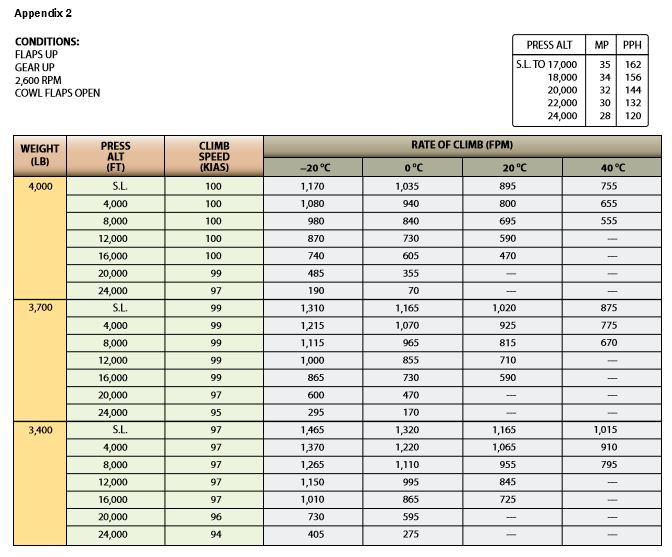 CorrectIncorrect
CorrectIncorrect -
Question 348 of 649
348. Question
Refer to the diagram below. GIVEN: Weight is 4,000 lb., pressure altitude is 5,000 feet, temperature is 30 degrees C. What is the maximum rate of climb under the given conditions?
 CorrectIncorrect
CorrectIncorrect -
Question 349 of 649
349. Question
In what type of operation, not regulated by 14 CFR Part 119, may a commercial pilot act as pilot in command and receive compensation for services?
CorrectIncorrect -
Question 350 of 649
350. Question
What period of time must a person be hospitalized before an injury may be defined by the NTSB as a "serious injury"?
CorrectIncorrect -
Question 351 of 649
351. Question
When should notification of an aircraft accident be made to the NTSB if there was substantial damage and no injuries?
CorrectIncorrect -
Question 352 of 649
352. Question
NTSB Part 830 requires an immediate notification as a result of which incident?
CorrectIncorrect -
Question 353 of 649
353. Question
Which incident would require that the nearest NTSB field office be notified immediately?
CorrectIncorrect -
Question 354 of 649
354. Question
Which airborne incident would require that the nearest NTSB field office be notified immediately?
CorrectIncorrect -
Question 355 of 649
355. Question
While taxiing on the parking ramp, the landing gear, wheel, and tire are damaged by striking ground equipment. What action would be required to comply With NTSB Part 830?
CorrectIncorrect -
Question 356 of 649
356. Question
While taxiing for takeoff, a small fire burned the insulation from a transceiver wire. What action would be required to comply with NTSB Part 830?
CorrectIncorrect -
Question 357 of 649
357. Question
During flight a fire, which was extinguished, burned the insulation from a transceiver wire. What action is required by regulations?
CorrectIncorrect -
Question 358 of 649
358. Question
Notification to the NTSB is required when there has been substantial damage
CorrectIncorrect -
Question 359 of 649
359. Question
How many days after an accident is a report required to be filed with the nearest NTSB field office?
CorrectIncorrect -
Question 360 of 649
360. Question
The operator of an aircraft that has been involved in an incident is required to submit a report to the nearest field office of the NTSB
CorrectIncorrect -
Question 361 of 649
361. Question
Who is responsible for filing a Near Midair Collision (NMAC) Report?
CorrectIncorrect -
Question 362 of 649
362. Question
Pilots and/or Flight Crew members involved in NMAC occurrences are urged to report each incident immediately:
CorrectIncorrect -
Question 363 of 649
363. Question
Which is not a type of hypoxia?
CorrectIncorrect -
Question 364 of 649
364. Question
Which of the following is a correct response to counteract the feelings of hypoxia in flight?
CorrectIncorrect -
Question 365 of 649
365. Question
Hypoxia susceptibility due to inhalation of carbon monoxide increases as
CorrectIncorrect -
Question 366 of 649
366. Question
If a pilot has not consumed a drink in 12 hours and has a blood alcohol level of .04 percent, can (s)he fly?
CorrectIncorrect -
Question 367 of 649
367. Question
14 CFR 17 requires that blood alcohol level be less than
CorrectIncorrect -
Question 368 of 649
368. Question
According to current regulations, how many hours must elapse between consuming alcohol and piloting an aircraft?
CorrectIncorrect -
Question 369 of 649
369. Question
Which of the following statements concerning the combination of alcohol and altitude is true?
CorrectIncorrect -
Question 370 of 649
370. Question
Hypoxia is the result of which of these conditions?
CorrectIncorrect -
Question 371 of 649
371. Question
Which is true regarding the presence of alcohol within the human body?
CorrectIncorrect -
Question 372 of 649
372. Question
To rid itself of the alcohol contained in one mixed drink, the human body requires about
CorrectIncorrect -
Question 373 of 649
373. Question
To rid itself of all the alcohol contained in one beer, the human body requires about
CorrectIncorrect -
Question 374 of 649
374. Question
With a blood alcohol level below .04 percent a pilot cannot fly sooner than
CorrectIncorrect -
Question 375 of 649
375. Question
Which is a common symptom of hyperventilation?
CorrectIncorrect -
Question 376 of 649
376. Question
As hyperventilation progresses a pilot can experience
CorrectIncorrect -
Question 377 of 649
377. Question
To overcome the symptoms of hyperventilation, a pilot should
CorrectIncorrect -
Question 378 of 649
378. Question
Which would most likely result in hyperventilation?
CorrectIncorrect -
Question 379 of 649
379. Question
A state of temporary confusion resulting from misleading information being sent to the brain by various sensory organs is defined as
CorrectIncorrect -
Question 380 of 649
380. Question
How may a pilot overcome spatial disorientation?
CorrectIncorrect -
Question 381 of 649
381. Question
Which of the following flight conditions would indicate a pilot is experiencing spatial disorientation?
CorrectIncorrect -
Question 382 of 649
382. Question
A pilot who needs to overcome the effects of spatial disorientation should
CorrectIncorrect -
Question 383 of 649
383. Question
To cope with spatial disorientation, pilots should rely on
CorrectIncorrect -
Question 384 of 649
384. Question
Refer to the diagram below. If the cruise altitude is 7,500 feet, using 64 percent power at 2,500 RPM, what would be the range with 48 gallons of usable fuel?
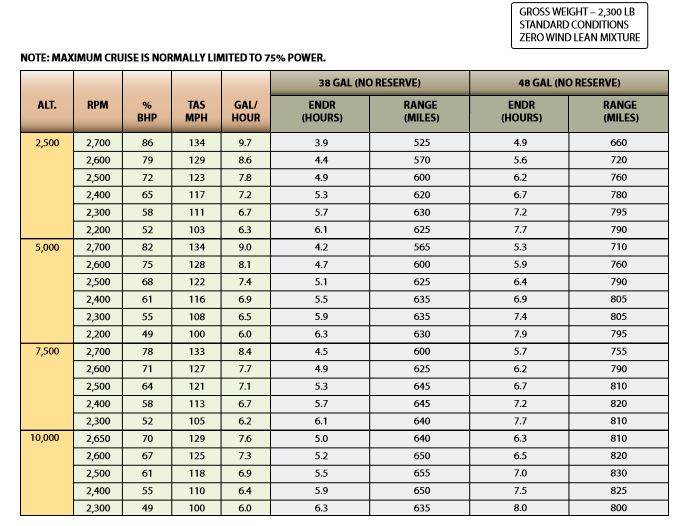 CorrectIncorrect
CorrectIncorrect -
Question 385 of 649
385. Question
Refer to the diagram below. What would be the endurance at an altitude of 7,500 feet, using 52 percent power? NOTE: With 48 gallons of fuel and no reserve.
 CorrectIncorrect
CorrectIncorrect -
Question 386 of 649
386. Question
Refer to the diagram below. What would be the approximate true airspeed and fuel consumption per hour at an altitude of 7,500 feet, using 52 percent power?
 CorrectIncorrect
CorrectIncorrect -
Question 387 of 649
387. Question
Refer to the diagram below. GIVEN: Pressure altitude is 18,000 feet, temperature is -21 degrees C, Power is 2,400 RPM - 28" MP, Recommended lean mixture usable fuel is 425 lb. What is the approximate flight time available under the given conditions? (Allow for VFR day fuel reserve.)
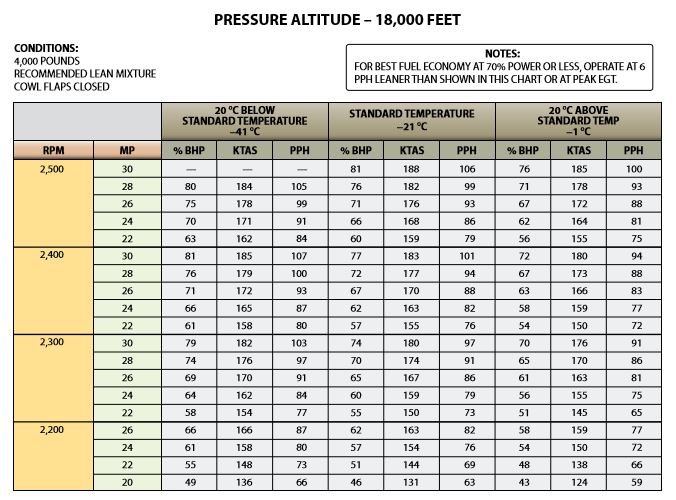 CorrectIncorrect
CorrectIncorrect -
Question 388 of 649
388. Question
Refer to the diagram below. GIVEN: Pressure altitude is 18,000 feet, temperature is -41 degrees C, Power is 2,500 RPM - 26" MP, Recommended lean mixture usable fuel is 318 lb. What is the approximate flight time available under the given conditions? (Allow for VFR night fuel reserve.)
 CorrectIncorrect
CorrectIncorrect -
Question 389 of 649
389. Question
Refer to the diagram below. GIVEN: Pressure altitude is 18,000 feet, temperature is -1 degrees C, Power is 2,200 RPM - 20" MP, Best fuel economy usable fuel is 344 lb. What is the approximate flight time available under the given conditions? (Allow for VFR day fuel reserve.)
 CorrectIncorrect
CorrectIncorrect -
Question 390 of 649
390. Question
Refer to the diagram below. GIVEN: Pressure altitude is 6,000 feet, temperature is 3 degrees C, Power is 2,200 RPM - 22" MP, Usable fuel available is 465 lb. What is the maximum available flight time under the given conditions stated?
 CorrectIncorrect
CorrectIncorrect -
Question 391 of 649
391. Question
Refer to the diagram below. GIVEN: Pressure altitude is 6,000 feet, temperature is -17 degrees C, Power is 2,300 RPM - 23" MP, Usable fuel available is 370 lb. What is the maximum available flight time under the given conditions stated?
 CorrectIncorrect
CorrectIncorrect -
Question 392 of 649
392. Question
Refer to the diagram below. GIVEN: Pressure altitude is 6,000 feet, temperature is 13 degrees C, Power is 2,500 RPM - 23" MP, Usable fuel available is 460 lb. What is the maximum available flight time under the given conditions stated?
 CorrectIncorrect
CorrectIncorrect -
Question 393 of 649
393. Question
Which maximum range factor decreases as weight decreases?
CorrectIncorrect -
Question 394 of 649
394. Question
Refer to the diagram below. GIVEN: Fuel quantity is 47 gallons, Power-cruise (lean) is 55%. Approximately how much flight time would be available with a night VFR fuel reserve remaining?
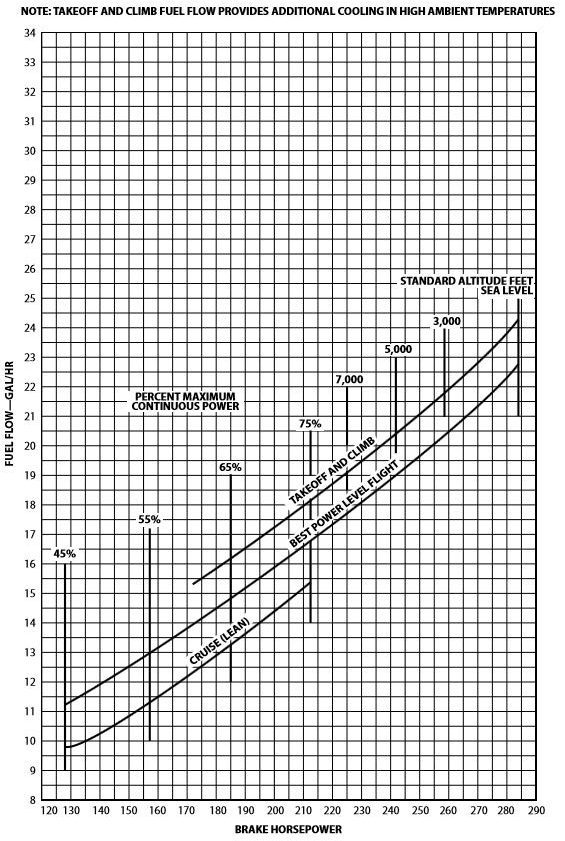 CorrectIncorrect
CorrectIncorrect -
Question 395 of 649
395. Question
Refer to the diagram below. GIVEN: Fuel quantity is 65 gallons, best power (level flight) is 55%. Approximately how much flight time would be available with a day VFR fuel reserve remaining?
 CorrectIncorrect
CorrectIncorrect -
Question 396 of 649
396. Question
Refer to the diagram below. Determine the amount of fuel consumer during takeoff and climb at 75 percent power for 7 minutes.
 CorrectIncorrect
CorrectIncorrect -
Question 397 of 649
397. Question
Refer to the diagram below. Determine the amount of fuel consumed during takeoff and climb at 70% power for 10 minutes.
 CorrectIncorrect
CorrectIncorrect -
Question 398 of 649
398. Question
Refer to the diagram below. With 38 gallons of fuel aboard at cruise power (55 percent), how much flight time is available with night .VFR fuel reserve still remaining?
 CorrectIncorrect
CorrectIncorrect -
Question 399 of 649
399. Question
Refer to the diagram below. Rwy 30 is being used for landing. Which surface wind would exceed the airplane's crosswind capability of 0.2 Vso, if Vso is 60 knots?
 CorrectIncorrect
CorrectIncorrect -
Question 400 of 649
400. Question
Refer to the diagram below. The surface wind is 180 degrees at 25 knots. What is the crosswind component for a Rwy 13 landing?
 CorrectIncorrect
CorrectIncorrect -
Question 401 of 649
401. Question
Refer to the diagram below. GIVEN: Temperature is 70 degrees F, Pressure altitude is sea level, Weight is 3,400 lb., headwind is 16 kts. Determine the approximate ground roll.
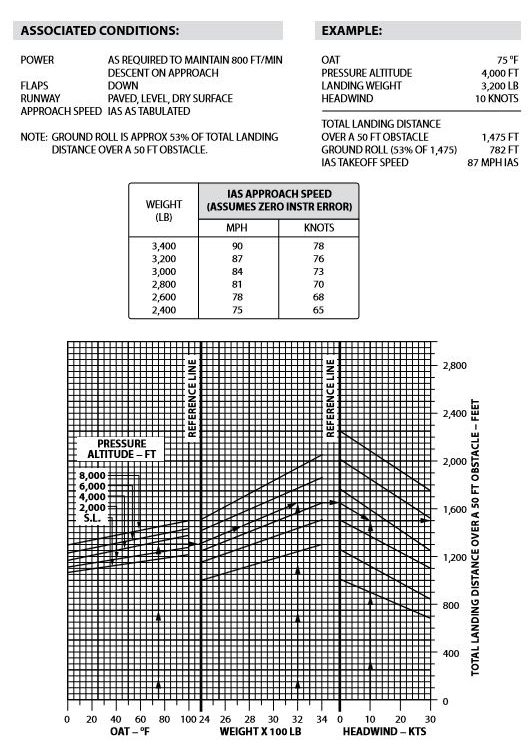 CorrectIncorrect
CorrectIncorrect -
Question 402 of 649
402. Question
Refer to the diagram below. GIVEN: Temperature is 85 degrees F, Pressure altitude is 6,000 feet, Weight is 2,800 lb., headwind is 14 kts. Determine the approximate ground roll.
 CorrectIncorrect
CorrectIncorrect -
Question 403 of 649
403. Question
When computing weight and balance, the basic empty weight includes the weight of the airframe, engine(s), and all installed optional equipment. Basic empty weight also includes
CorrectIncorrect -
Question 404 of 649
404. Question
The CG of an aircraft may be determined by which of the following methods?
CorrectIncorrect -
Question 405 of 649
405. Question
The CG of an aircraft may be determined by
CorrectIncorrect -
Question 406 of 649
406. Question
If all index units are positive when computing weight and balance, the location of the datum would be at the
CorrectIncorrect -
Question 407 of 649
407. Question
GIVEN:
Weight A - 155 pounds at 45 inches, aft of datum
Weight B - 165 pounds at 145 inches aft of datum
Weight C - 95 pounds at 185 inches aft of datumBased on the above information, the CG would be located how far aft of datum?
CorrectIncorrect -
Question 408 of 649
408. Question
GIVEN:
Weight A - 140 pounds at 17 inches after of datum.
Weight B - 120 pounds at 110 inches aft of datum.
Weight C - 85 pounds at 210 inches aft of datum.Based on the above information, the CG would be located how far aft of datum?
CorrectIncorrect -
Question 409 of 649
409. Question
To scan properly for traffic, a pilot should
CorrectIncorrect -
Question 410 of 649
410. Question
GIVEN:
Empty weight is 957, ARM is 29.07
Pilot (Fwd. seat) is 140, ARM is -45.30
Passenger (aft seat) is 170, ARM is 1.60
Ballast is 15, ARM is -45.30
The moment is unknownThe CG is located at station
CorrectIncorrect -
Question 411 of 649
411. Question
Which technique should a pilot use to scan for traffic to the right and left during straight-and-level flight?
CorrectIncorrect -
Question 412 of 649
412. Question
An aircraft is loaded with a ramp weight of 3,650 pounds and having a CG of 94.0, approximately how much baggage would have to be moved from the rear baggage area at station 180 to the forward baggage area at station 40 in order to move the CG to 92.0?
CorrectIncorrect -
Question 413 of 649
413. Question
An airplane is loaded to a gross weight of 4,800 pounds, with three pieces of luggage in the rear baggage compartment. The CG is located 98 inches aft of datum, which is 1 inch aft of limits. If luggage which weighs 90 pounds is moved from the rear baggage compartment (145 inches aft of datum) to the front compartment (45 inches aft of datum), what is the new CG?
CorrectIncorrect -
Question 414 of 649
414. Question
GIVEN:
Weight A - 135 pounds at 15 inches aft of datum.
Weight B - 205 pounds at 117 inches aft of datum.
Weight C - 85 pounds at 195 inches aft of datum.Based on the above information, the CG would be located how far aft of datum?
CorrectIncorrect -
Question 415 of 649
415. Question
GIVEN:
Weight A - 175 pounds at 135 inches aft of datum.
Weight B - 135 pounds at 115 inches aft of datum.
Weight C - 75 pounds at 85 inches aft at datum
The CG for the combined weights would be located how far aft of datum?CorrectIncorrect -
Question 416 of 649
416. Question
GIVEN:
Total weight - 4,137 lb.
CG location - Station 6.78
Fuel consumption - 13.7 GPH
Fuel CG - Station 68.0After 1 hour 30 minutes of flight time, the CG would be located at station
CorrectIncorrect -
Question 417 of 649
417. Question
GIVEN:
Total weight - 3,037 lb.
CG location - Station 68.8
Fuel consumption - 127.7 GPH
Fuel CG - Station 68.0After 1 hour 45 minutes of flight time, the CG would be located at station:
CorrectIncorrect -
Question 418 of 649
418. Question
What effect does haze have on the ability to see traffic or terrain features during flight?
CorrectIncorrect -
Question 419 of 649
419. Question
Haze creates which of the following atmospheric illusions?
CorrectIncorrect -
Question 420 of 649
420. Question
Aeronautical Decision Making (ADM) is a
CorrectIncorrect -
Question 421 of 649
421. Question
Risk management, as part of the aeronautical decision making (ADM) process, relies on which features to reduce the risks associated with each flight?
CorrectIncorrect -
Question 422 of 649
422. Question
The Aeronautical Decision Making (ADM) process identifies the steps involved in good decision making. One of these steps includes a pilot
CorrectIncorrect -
Question 423 of 649
423. Question
An early part of the Aeronautical Decision Making (ADM) process involves
CorrectIncorrect -
Question 424 of 649
424. Question
Examples of classic behavioral traps that experienced pilots may fall into are: trying to
CorrectIncorrect -
Question 425 of 649
425. Question
The basic drive for a pilot to demonstrate the "right stuff' can have an adverse effect on safety, by
CorrectIncorrect -
Question 426 of 649
426. Question
Most pilots have fallen prey to dangerous tendencies or behavior problems at some time. Some of these dangerous tendencies or behavior patterns which must be identified and eliminated include
CorrectIncorrect -
Question 427 of 649
427. Question
What are some of the hazardous attitudes dealt with in Aeronautical Decision Making (ADM)?
CorrectIncorrect -
Question 428 of 649
428. Question
The passengers for a charter flight have arrived almost an hour late for a flight that requires a reservation. Which of the following alternatives best illustrates the ANTIAUTHORITY reaction?
CorrectIncorrect -
Question 429 of 649
429. Question
The pilot and passengers are anxious to get to their destination for a business presentation. Level IV thunderstorms are reported to be in a line across their intended route of flight. Which of the following alternatives best illustrates the IMPULSIVITY reaction?
CorrectIncorrect -
Question 430 of 649
430. Question
While conducting an operational check of the cabin pressurization system, the pilot discovers that the rate control feature is inoperative. He knows that he can manually control the cabin pressure, so he elects to disregard the discrepancy. Which of the following alternatives best illustrates the INVULNERABILITY reaction?
CorrectIncorrect -
Question 431 of 649
431. Question
While on an IFR flight, a pilot emerges from a cloud to find himself within 300 feet of a helicopter. Which of the following alternatives best illustrates the "MACHO" reaction?
CorrectIncorrect -
Question 432 of 649
432. Question
What is the first step in neutralizing a hazardous attitude in the ADM process?
CorrectIncorrect -
Question 433 of 649
433. Question
A pilot and friends are going to fly to an out-of-town football game. When the passengers arrive, the pilot determines that they will be over the maximum gross weight for takeoff with the existing fuel load. Which of the following alternatives best illustrates the RESIGNATION reaction?
CorrectIncorrect -
Question 434 of 649
434. Question
Hazardous attitudes which contribute to poor pilot judgment can be effectively counteracted by
CorrectIncorrect -
Question 435 of 649
435. Question
What should a pilot do when recognizing a thought as hazardous?
CorrectIncorrect -
Question 436 of 649
436. Question
When a pilot recognizes a hazardous thought, he or she then should correct it by stating the corresponding antidote. Which of the following is the antidote for antiauthority?
CorrectIncorrect -
Question 437 of 649
437. Question
When a pilot recognizes a hazardous thought, he or she then should correct it by stating the corresponding antidote. Which of the following is the antidote for MACHO?
CorrectIncorrect -
Question 438 of 649
438. Question
What does good cockpit stress management begin with?
CorrectIncorrect -
Question 439 of 649
439. Question
To help manage cockpit stress, pilots must
CorrectIncorrect -
Question 440 of 649
440. Question
The Decide Model is comprised of a 6-step process to provide a pilot a logical way of approaching Aeronautical Decision Making. These steps are:
CorrectIncorrect -
Question 441 of 649
441. Question
Which of the following is the first step of the DECIDE Model for effective risk management and Aeronautical Decision Making (ADM)?
CorrectIncorrect -
Question 442 of 649
442. Question
Which of the following is the final step of the Decide Model for effective risk management and Aeronautical Decision Making?
CorrectIncorrect -
Question 443 of 649
443. Question
The Telephone Information Briefing Service (TIBS) provided by FSSs includes
CorrectIncorrect -
Question 444 of 649
444. Question
Weather Advisory Broadcasts, including Severe Weather Forecast Alerts (AWWs), Convective SIGMETs, and SIGMETs, are provided by
CorrectIncorrect -
Question 445 of 649
445. Question
During preflight preparation, weather report forecasts which are not routinely available at the local service outlet (FSS) can best be obtained by means of contacting
CorrectIncorrect -
Question 446 of 649
446. Question
The Hazardous lnflight Weather Advisory Service (HIWAS) is a broadcast service over selected VORs that provides
CorrectIncorrect -
Question 447 of 649
447. Question
The most current en route and destination weather information for an instrument flight should be obtained from the
CorrectIncorrect -
Question 448 of 649
448. Question
Refer to the excerpt from the following METAR report:
KTUS.....08004KT 4SM HZ .....26/04 A2995 RMK RAE36
At approximately what altitude AGL should bases of convective-type cumuliform clouds be expected?
CorrectIncorrect -
Question 449 of 649
449. Question
What significant cloud coverage is reported by this pilot report?
KMOB
UA/OV 15NW MOB 1340Z/SK OVC 025/045 OVC
090
CorrectIncorrect -
Question 450 of 649
450. Question
The remarks section of the Aviation Routine Weather Report (METAR) contains the following coded information. What does it mean?
RMK FZDZB42 WSHFT 30 FROPA
CorrectIncorrect -
Question 451 of 649
451. Question
The station originating the following METAR observation has a field elevation of 3,500 feet MSL. If the sky cover is one continuous layer what is the thickness of the cloud layer? (Top of overcast reported at 7,500 feet MSL.)
METAR KHOB 1512502 17006KT 4SM OVC005 13/11 A2998
CorrectIncorrect -
Question 452 of 649
452. Question
The station originating the following METAR observation has a field elevation of 5,000 feet MSL. If the sky cover is one continuous layer what is the thickness of the cloud layer? (Top of overcast reported at 8,000 feet MSL.)
METAR KHOB 1512502 17006KT 4SM OVC005 13/11 A2998
CorrectIncorrect -
Question 453 of 649
453. Question
What is meant by the Special METAR weather observation for KBOI?
SPECI KBOI 0918542 32005KT 1 1/2SM RA BR OVC007 17/16 A2990 RMK RAB12
CorrectIncorrect -
Question 454 of 649
454. Question
What is meant by the Special METAR weather observation for KBOI?
SPECI KBOI 0918542 32005KT 1 1/2SM RA BR OVC007 17/16 A2990 RMK RAB12
CorrectIncorrect -
Question 455 of 649
455. Question
The Surface Analysis Chart depicts
CorrectIncorrect -
Question 456 of 649
456. Question
On a Surface Analysis Chart, the solid lines that depict sea level pressure patterns are called
CorrectIncorrect -
Question 457 of 649
457. Question
Dashed lines on a Surface Analysis Chart, if depicted, indicate that the pressure gradient is
CorrectIncorrect -
Question 458 of 649
458. Question
On a Surface Analysis Chart, close spacing of the isobars indicates
CorrectIncorrect -
Question 459 of 649
459. Question
Which chart provides a ready means of locating observed frontal positions and pressure centers?
CorrectIncorrect -
Question 460 of 649
460. Question
Hatching on a Constant Pressure Analysis Chart indicates
CorrectIncorrect -
Question 461 of 649
461. Question
What flight planning information can a pilot derive from Constant Pressure Analysis Charts?
CorrectIncorrect -
Question 462 of 649
462. Question
From which of the following can the observed temperature, wind, and temperature/dewpoint spread be determined at a specified altitude?
CorrectIncorrect -
Question 463 of 649
463. Question
What is the meaning of the terms PROB40 2102 +TSRA as used in a Terminal Aerodrome Forecast (TAF)?
CorrectIncorrect -
Question 464 of 649
464. Question
What does the contraction VRB in the Terminal Aerodrome Forecast (TAF) mean?
CorrectIncorrect -
Question 465 of 649
465. Question
Which statement pertaining to the following Terminal Aerodrome Forecast (TAF) is true?
TAF
KMEM 091135Z 0915 15005KT 5SM HZ BKN060 FM1600 VRB04KT P6SM SKC
CorrectIncorrect -
Question 466 of 649
466. Question
The visibility entry in a Terminal Aerodrome Forecast (TAF) of P6SM implies that the prevailing visibility is expected to be greater than
CorrectIncorrect -
Question 467 of 649
467. Question
Which is true concerning the blue and magenta colors used to depict airports on Sectional Aeronautical Charts?
CorrectIncorrect -
Question 468 of 649
468. Question
True course measurements on a Sectional Aeronautical Chart should be made at a meridian near the midpoint of the course because the
CorrectIncorrect -
Question 469 of 649
469. Question
When a dashed blue circle surrounds an airport on a sectional aeronautical chart, it will depict the boundary of
CorrectIncorrect -
Question 470 of 649
470. Question
Which statement is true about isogonic lines?
CorrectIncorrect -
Question 471 of 649
471. Question
Refer to the diagram below. Refer to point 7. The floor of Class E airspace over the town of Woodland is
 CorrectIncorrect
CorrectIncorrect -
Question 472 of 649
472. Question
Refer to the diagram below. Refer to point 8. The floor of the Class E airspace over the town of Auburn is
 CorrectIncorrect
CorrectIncorrect -
Question 473 of 649
473. Question
Alert Areas are special use airspace depicted within magenta lines on sectional charts in which
CorrectIncorrect -
Question 474 of 649
474. Question
Refer to the diagram below. GIVEN:
Location is Madera Airport (MAE) with an Altitude of 1,000 ft. AGL. The Position is 7 NM north of Madera (MAE) at 3 p.m. local with a flight visibility of 1 SM. You are VFR approaching Madera Airport for a landing from the north. You
 CorrectIncorrect
CorrectIncorrect -
Question 475 of 649
475. Question
Refer to the diagram below. Refer to point 2. The 16 indicates
 CorrectIncorrect
CorrectIncorrect -
Question 476 of 649
476. Question
Refer to the diagram below. Refer to point 6. The Class C airspace at Metropolitan Oakland International (OAK) which extends from the surface upward has a ceiling of
 CorrectIncorrect
CorrectIncorrect -
Question 477 of 649
477. Question
Refer to the diagram below. Refer to point 1. What minimum altitude is required to avoid the Livermore Airport (LVK) Class D airspace?
 CorrectIncorrect
CorrectIncorrect -
Question 478 of 649
478. Question
Refer to the diagram below What is the ceiling of the Class D Airspace of the Byron (C83) airport (Area 2)?
 CorrectIncorrect
CorrectIncorrect -
Question 479 of 649
479. Question
Refer to the diagram below. Refer to point 2. The thin magenta line represents
 CorrectIncorrect
CorrectIncorrect -
Question 480 of 649
480. Question
Refer to the diagram below. En route on V112 from BTG VORTAC to CARBY intersection, the minimum altitude crossing GYMME intersection is
 CorrectIncorrect
CorrectIncorrect -
Question 481 of 649
481. Question
If an airplane is consuming 95 pounds of fuel per hour at a cruising altitude of 6,500 feet and the groundspeed is 173 knots, how much fuel is required
to travel 450 NM?CorrectIncorrect -
Question 482 of 649
482. Question
If fuel consumption is 80 pounds per hour and groundspeed is 180 knots, how much fuel is required for an airplane to travel 477 NM?
CorrectIncorrect -
Question 483 of 649
483. Question
Terminal Aerodrome Forecasts (TAF) are issued how many times a day and cover what period of time?
CorrectIncorrect -
Question 484 of 649
484. Question
What single reference contains information regarding a volcanic eruption, that is occurring or expected to occur?
CorrectIncorrect -
Question 485 of 649
485. Question
In-Flight Aviation Weather Advisories include what type of information?
CorrectIncorrect -
Question 486 of 649
486. Question
What type of In-Flight Weather Advisories provides an en route pilot with information regarding the possibility of moderate icing, moderate turbulence, winds of 30 knots or more at the surface and extensive mountain obscurement?
CorrectIncorrect -
Question 487 of 649
487. Question
SIGMETs are issued as a warning of weather conditions which are hazardous
CorrectIncorrect -
Question 488 of 649
488. Question
Which correctly describes the purpose of convective SIGMETs (WST)?
CorrectIncorrect -
Question 489 of 649
489. Question
What wind conditions would you anticipate when squalls are reported at your destination?
CorrectIncorrect -
Question 490 of 649
490. Question
What weather phenomenon is implied within an area enclosed by small scalloped lines on a U.S. High-Level Significant Weather Prognostic Chart?
CorrectIncorrect -
Question 491 of 649
491. Question
Which weather chart depicts conditions forecast to exist at a specific time in the future?
CorrectIncorrect -
Question 492 of 649
492. Question
What is the upper limit of the Low Level Significant Weather Prognostic Chart?
CorrectIncorrect -
Question 493 of 649
493. Question
The U.S. High-Level Significant Weather Prognostic Chart forecasts significant weather for what airspace?
CorrectIncorrect -
Question 494 of 649
494. Question
What significant cloud coverage is reported by this pilot report?
KMOB
UA/OV 15NW MOB 1340Z/SK 025 OVC 045/075
OVC 080/090 OVC
CorrectIncorrect -
Question 495 of 649
495. Question
To best determine observed weather conditions between weather reporting stations, the pilot should refer to
CorrectIncorrect -
Question 496 of 649
496. Question
What values are used for Winds Aloft Forecasts?
CorrectIncorrect -
Question 497 of 649
497. Question
If fuel consumption is 80 pounds per hour and groundspeed is 180 knots, how much fuel is required for an airplane to travel 460 NM?
CorrectIncorrect -
Question 498 of 649
498. Question
If an airplane is consuming 12.5 gallons of fuel per hour at a cruising altitude of 8,500 feet and the groundspeed is 145 knots, how much fuel is required to travel 435 NM?
CorrectIncorrect -
Question 499 of 649
499. Question
If an airplane is consuming 9.5 gallons of fuel per hour at a cruising altitude of 6,000 feet and the groundspeed is 135 knots, how much fuel is required to travel 490 NM?
CorrectIncorrect -
Question 500 of 649
500. Question
If an aircraft is consuming 9.7 gallons of fuel per hour at a cruising altitude of 6,000 feet and the groundspeed is 115 knots, how much fuel is required
to travel 350 NM?CorrectIncorrect -
Question 501 of 649
501. Question
If an aircraft is consuming 9.3 gallons of fuel per hour at a cruising altitude of 6,000 feet and the groundspeed is 135 knots, how much fuel is required to travel 390 NM?
CorrectIncorrect -
Question 502 of 649
502. Question
If an aircraft is consuming 9.5 gallons of fuel per hour at a cruising altitude of 6,000 feet and the groundspeed is 135 knots, how much fuel is required to travel 380 NM?
CorrectIncorrect -
Question 503 of 649
503. Question
If an aircraft is consuming 9.5 gallons of fuel per hour at a cruising altitude of 6,000 feet and the groundspeed is 135 knots, how much fuel is required to travel 420 NM?
CorrectIncorrect -
Question 504 of 649
504. Question
If an airplane is consuming 14.8 gallons of fuel per hour at a cruising altitude of 7,500 feet and the groundspeed is 167 knots, how much fuel is required to travel 560 NM?
CorrectIncorrect -
Question 505 of 649
505. Question
If fuel consumption is 14.7 gallons per hour and groundspeed is 157 knots, how much fuel is required for an airplane to travel 612 NM?
CorrectIncorrect -
Question 506 of 649
506. Question
GIVEN:
Distance off course is 9 miles
Distance flown is 95 miles
Distance to fly is 125 milesTo converge at the destination, the total correction angle would be
CorrectIncorrect -
Question 507 of 649
507. Question
You have flown 52 miles, are 6 miles off course, and have 118 miles yet to fly. To converge on your destination, the total correction angle would be
CorrectIncorrect -
Question 508 of 649
508. Question
GIVEN:
True course is 105 degrees
True heading is 085 degrees
True airspeed is 95 kts.
Groundspeed is 87 kts.
Determine the wind direction and speed.CorrectIncorrect -
Question 509 of 649
509. Question
GIVEN:
True course is 345 degrees, true heading is 355 degrees, true airspeed is 85 knots, groundspeed is 95 knots
Determine the wind direction and speedCorrectIncorrect -
Question 510 of 649
510. Question
An airplane departs an airport under the following conditions:
Airport elevation - 1,000 feet
Cruise altitude - 9,500 feet
Rate of climb - 500 ft./min.
Average true airspeed - 135 kts.
True course - 215 degrees
Average wind velocity - 290 degrees at 20 knots
Variation - 3 degrees west
Deviation - negative 2 degrees
Average fuel consumption - 13 gallons/hr.
Determine the approximate time, compass heading, distance and fuel consumed during the climb.CorrectIncorrect -
Question 511 of 649
511. Question
An airplane departs an airport under the following conditions:
Airport elevation - 1,500 feet
Cruise altitude - 9,500 feet
Rate of climb - 500 ft./min.
Average true airspeed - 160 kts.
True course - 145 degrees
Average wind velocity - 080 degrees at 15 knots
Variation - 5 degrees east
Deviation - negative 3 degrees
Average fuel consumption - 14 gallons/hr.
Determine the approximate time, compass heading, distance and fuel consumed during the climb.CorrectIncorrect -
Question 512 of 649
512. Question
GIVEN:
Wind - 175 degrees at 20 knots
Distance - 135 NM
True course - 075 degrees
True airspeed - 80 knots
Fuel consumption - 105 lb./hr.
Determine the time en route and fuel consumption.CorrectIncorrect -
Question 513 of 649
513. Question
An airplane descends to an airport under the following conditions:
Cruising altitude - 6,500 ft.
Airport elevation - 700 feet
Descends to - 800 ft. AGL
Rate of descent - 500 ft./min.
Average true airspeed - 110 kts.
True course - 335 degrees
Average wind velocity - 060 degrees at 15 knots
Variation - 3 degrees west
Deviation - positive 2 degrees
Average fuel consumption - 8.5 gallons/hr.
Determine the approximate time, compass heading, distance and fuel consumed during the descent.CorrectIncorrect -
Question 514 of 649
514. Question
An airplane descends to an airport under the following conditions:
Cruising altitude - 7,500 ft.
Airport elevation - 1,300 feet
Descends to - 800 ft. AGL
Rate of descent - 300 ft./min.
Average true airspeed - 120 kts.
True course - 165 degrees
Average wind velocity - 240 degrees at 20 knots
Variation - 4 degrees east
Deviation - negative 2 degrees
Average fuel consumption - 9.6 gallons/hr.
Determine the approximate time, compass heading, distance and fuel consumed during the descent.CorrectIncorrect -
Question 515 of 649
515. Question
An airplane descends to an airport under the following conditions:
Cruising altitude - 10,500 ft.
Airport elevation - 1,700 feet
Descends to - 1,000 ft. AGL
Rate of descent - 600 ft./min.
Average true airspeed - 135 kts.
True course - 263 degrees
Average wind velocity - 330 degrees at 30 knots
Variation - 7 degrees east
Deviation - positive 3 degrees
Average fuel consumption - 11,5 gallons/hr.
Determine the approximate time, compass heading, distance and fuel consumed during the descent.CorrectIncorrect -
Question 516 of 649
516. Question
Every physical process of weather is accompanied by or is the result of
CorrectIncorrect -
Question 517 of 649
517. Question
Moisture is added to a parcel of air by
CorrectIncorrect -
Question 518 of 649
518. Question
In the Northern Hemisphere, the wind is deflected to the
CorrectIncorrect -
Question 519 of 649
519. Question
Why does the wind have a tendency to flow parallel to the isobars above the friction level?
CorrectIncorrect -
Question 520 of 649
520. Question
With regard to windflow patterns shown on surface analysis charts; when the isobars are
CorrectIncorrect -
Question 521 of 649
521. Question
What causes wind?
CorrectIncorrect -
Question 522 of 649
522. Question
Which is true regarding a cold front occlusion? The air ahead of the warm front
CorrectIncorrect -
Question 523 of 649
523. Question
On Surface Analysis Charts, widely spaced isobars indicate a
CorrectIncorrect -
Question 524 of 649
524. Question
Which is true with respect to a high- or low-pressure system?
CorrectIncorrect -
Question 525 of 649
525. Question
Which is true regarding high- or low-pressure systems?
CorrectIncorrect -
Question 526 of 649
526. Question
While flying cross-country in the Northern Hemisphere, you experience a continuous left crosswind which is associated with a major wind system. This indicates that you
CorrectIncorrect -
Question 527 of 649
527. Question
When flying into a low-pressure area in the Northern Hemisphere, the wind direction and velocity will be from the
CorrectIncorrect -
Question 528 of 649
528. Question
What prevents air from flowing directly from high-pressure areas to low-pressure areas?
CorrectIncorrect -
Question 529 of 649
529. Question
The general circulation of air associated with a high-pressure area in the Northern Hemisphere is
CorrectIncorrect -
Question 530 of 649
530. Question
The wind system associated with a low-pressure area in the Northern Hemisphere is
CorrectIncorrect -
Question 531 of 649
531. Question
During the winter months in the middle latitudes, the jet stream shifts toward the
CorrectIncorrect -
Question 532 of 649
532. Question
The strength and location of the jet stream is normally
CorrectIncorrect -
Question 533 of 649
533. Question
A common location of clear air turbulence is
CorrectIncorrect -
Question 534 of 649
534. Question
The jet stream and associated clear air turbulence can sometimes be visually identified in flight by
CorrectIncorrect -
Question 535 of 649
535. Question
A strong wind shear can be expected
CorrectIncorrect -
Question 536 of 649
536. Question
Which type of jet stream can be expected to cause the greater turbulence?
CorrectIncorrect -
Question 537 of 649
537. Question
Which feature is associated with the tropopause?
CorrectIncorrect -
Question 538 of 649
538. Question
What is the standard temperature at 10,000 feet?
CorrectIncorrect -
Question 539 of 649
539. Question
What are the standard temperature and pressure values for sea level?
CorrectIncorrect -
Question 540 of 649
540. Question
What is the standard temperature at 20,000 feet?
CorrectIncorrect -
Question 541 of 649
541. Question
Which is true regarding actual air temperature and dew point temperature spread? The temperature spread
CorrectIncorrect -
Question 542 of 649
542. Question
What is the standard temperature at 6,500 feet?
CorrectIncorrect -
Question 543 of 649
543. Question
Which cloud types would indicate convective turbulence?
CorrectIncorrect -
Question 544 of 649
544. Question
Which combination of weather-producing variables would likely result in cumuliform-type clouds, good visibility, and showery rain?
CorrectIncorrect -
Question 545 of 649
545. Question
Which are characteristics of a cold air mass moving over a warm surface?
CorrectIncorrect -
Question 546 of 649
546. Question
What is the approximate base of the cumulus clouds if the temperature at 2,000 feet MSL is 10°C and the dew point is 1°C?
CorrectIncorrect -
Question 547 of 649
547. Question
What determines the structure or type of clouds which will form as a result of air being forced to ascend?
CorrectIncorrect -
Question 548 of 649
548. Question
The presence of standing lenticular altocumulus clouds is a good indication of
CorrectIncorrect -
Question 549 of 649
549. Question
Virga is best described as
CorrectIncorrect -
Question 550 of 649
550. Question
Fog produced by frontal activity is a result of saturation due to
CorrectIncorrect -
Question 551 of 649
551. Question
Which in-flight hazard is most commonly associated with warm fronts?
CorrectIncorrect -
Question 552 of 649
552. Question
A situation most conducive to the formation of advection fog is
CorrectIncorrect -
Question 553 of 649
553. Question
Advection fog has drifted over a coastal airport during the day. What may tend to dissipate or lift this fog into low stratus clouds?
CorrectIncorrect -
Question 554 of 649
554. Question
What lifts advection fog into low stratus clouds?
CorrectIncorrect -
Question 555 of 649
555. Question
Which conditions are favorable for the formation of a surface based temperature inversion?
CorrectIncorrect -
Question 556 of 649
556. Question
In what ways do advection fog, radiation fog, and steam fog differ in their formation or location?
CorrectIncorrect -
Question 557 of 649
557. Question
With respect to advection fog, which statement is true?
CorrectIncorrect -
Question 558 of 649
558. Question
When checking the course sensitivity of a VOR receiver, how many degrees should the OBS be rotated to move the CDI from the center to the last dot on either side?
CorrectIncorrect -
Question 559 of 649
559. Question
When using VOT to make a VOR receiver check, the CDI should be centered and the OBS should indicate that the aircraft is on the
CorrectIncorrect -
Question 560 of 649
560. Question
How should the pilot make a VOR receiver check when the aircraft is located on the designated checkpoint on the airport surface?
CorrectIncorrect -
Question 561 of 649
561. Question
An aircraft 60 miles from a VOR station has a CDI indication of one-fifth deflection, this represents a course centerline deviation of approximately
CorrectIncorrect -
Question 562 of 649
562. Question
When the CDI needle is centered during an airborne VOR check, the omnibearing selector and the TO/FROM indicator should read
CorrectIncorrect -
Question 563 of 649
563. Question
Which situation would result in reverse sensing of a VOR receiver?
CorrectIncorrect -
Question 564 of 649
564. Question
To track outbound on the 180 radial of a VOR station, the recommended procedure is to set the OBS to
CorrectIncorrect -
Question 565 of 649
565. Question
To track inbound on the 215 radial of a VOR station, the recommended procedure is to set the OBS to
CorrectIncorrect -
Question 566 of 649
566. Question
For IFR operations off established airways, ROUTE OF FLIGHT portion of an IFR flight plan should list VOR navigational aids which are no more than
CorrectIncorrect -
Question 567 of 649
567. Question
Effective navigation by means of GPS includes
CorrectIncorrect -
Question 568 of 649
568. Question
Why should pilots understand how to cancel entries made on a GPS?
CorrectIncorrect -
Question 569 of 649
569. Question
Reliance on GPS units
CorrectIncorrect -
Question 570 of 649
570. Question
The primary purpose of the direct-to button is to
CorrectIncorrect -
Question 571 of 649
571. Question
Which button/feature provides information on the closest airport at any given time?
CorrectIncorrect -
Question 572 of 649
572. Question
What are the characteristics of stable air?
CorrectIncorrect -
Question 573 of 649
573. Question
Which would decrease the stability of an air mass?
CorrectIncorrect -
Question 574 of 649
574. Question
What is a characteristic of stable air?
CorrectIncorrect -
Question 575 of 649
575. Question
Which would increase the stability of an air mass?
CorrectIncorrect -
Question 576 of 649
576. Question
Which is a characteristic of stable air?
CorrectIncorrect -
Question 577 of 649
577. Question
Which is a characteristic typical of a stable air mass?
CorrectIncorrect -
Question 578 of 649
578. Question
What type weather can one expect from moist, unstable air, and very warm surface temperature?
CorrectIncorrect -
Question 579 of 649
579. Question
A moist, unstable air mass is characterized by
CorrectIncorrect -
Question 580 of 649
580. Question
Name the four fundamentals involved in maneuvering an aircraft.
CorrectIncorrect -
Question 581 of 649
581. Question
While taxiing a light, high-wing airplane during strong quartering tailwinds, the aileron control should be positioned
CorrectIncorrect -
Question 582 of 649
582. Question
When taxiing during strong quartering tailwinds, which aileron positions should be used?
CorrectIncorrect -
Question 583 of 649
583. Question
If clouds form as a result of very stable, moist air being forced to ascend a mountain slope, the clouds will be
CorrectIncorrect -
Question 584 of 649
584. Question
The formation of either predominantly stratiform or predominantly cumuliform clouds is dependent upon the
CorrectIncorrect -
Question 585 of 649
585. Question
With respect to the technique required for a crosswind correction on takeoff, a pilot should use
CorrectIncorrect -
Question 586 of 649
586. Question
When an air mass is stable, which of these conditions is most likely to exist?
CorrectIncorrect -
Question 587 of 649
587. Question
Which type of approach and landing is recommended during gusty wind conditions?
CorrectIncorrect -
Question 588 of 649
588. Question
When turbulence is encountered during the approach to a landing, what action is recommended and for what primary reason?
CorrectIncorrect -
Question 589 of 649
589. Question
A proper crosswind landing on a runway requires that, at the moment of touchdown, the
CorrectIncorrect -
Question 590 of 649
590. Question
A pilot's most immediate and vital concern in the event of complete engine failure after becoming airborne on takeoff is
CorrectIncorrect -
Question 591 of 649
591. Question
When diverting to an alternate airport because of an emergency, pilots should
CorrectIncorrect -
Question 592 of 649
592. Question
Pilots are required to have the anti-collision light system operating
CorrectIncorrect -
Question 593 of 649
593. Question
If necessary to take off from a slushy runway, the freezing of landing gear mechanisms can be minimized by
CorrectIncorrect -
Question 594 of 649
594. Question
Which is true regarding preheating an aircraft during cold weather operations?
CorrectIncorrect -
Question 595 of 649
595. Question
During preflight in cold weather, crankcase breather lines should receive special attention because they are susceptible to being clogged by
CorrectIncorrect -
Question 596 of 649
596. Question
If severe turbulence is encountered during flight,
CorrectIncorrect -
Question 597 of 649
597. Question
Which is the best technique for minimizing the wing-load factor when flying in severe turbulence?
CorrectIncorrect -
Question 598 of 649
598. Question
A pilot is entering an area where significant clear air turbulence has been reported. Which action is appropriate upon encountering the first ripple?
CorrectIncorrect -
Question 599 of 649
599. Question
For night flying operations, the best night vision is achieved when the
CorrectIncorrect -
Question 600 of 649
600. Question
When planning a night cross-country flight, a pilot should check for
CorrectIncorrect -
Question 601 of 649
601. Question
When planning a night cross-country flight, a pilot should check for the availability and status of
CorrectIncorrect -
Question 602 of 649
602. Question
Light beacons producing red flashes indicate
CorrectIncorrect -
Question 603 of 649
603. Question
Which is true regarding the development of convective circulation?
CorrectIncorrect -
Question 604 of 649
604. Question
When conditionally unstable air with high-moisture content and very warm surface temperature is forecast, one can expect what type of weather?
CorrectIncorrect -
Question 605 of 649
605. Question
Convective circulation patterns associated with sea breezes are caused by
CorrectIncorrect -
Question 606 of 649
606. Question
From which measurement of the atmosphere can stability be determined?
CorrectIncorrect -
Question 607 of 649
607. Question
The difference found by subtracting the temperature of a parcel of air theoretically lifted from the surface to 500 millibars and the existing temperature at 500 millibars is called the
CorrectIncorrect -
Question 608 of 649
608. Question
The conditions necessary for the formation of stratiform clouds are a lifting action and
CorrectIncorrect -
Question 609 of 649
609. Question
What visible signs indicate extreme turbulence in thunderstorms?
CorrectIncorrect -
Question 610 of 649
610. Question
What feature is normally associated with the cumulus stage of a thunderstorm?
CorrectIncorrect -
Question 611 of 649
611. Question
The conditions necessary for the formation of cumulonimbus clouds are a lifting action and
CorrectIncorrect -
Question 612 of 649
612. Question
The most severe weather conditions, such as destructive winds, heavy hail, and tornadoes, are generally associated with
CorrectIncorrect -
Question 613 of 649
613. Question
Of the following, which is accurate regarding turbulence associated with thunderstorms?
CorrectIncorrect -
Question 614 of 649
614. Question
Which statement is true concerning squall lines?
CorrectIncorrect -
Question 615 of 649
615. Question
Which statement is true regarding squall lines?
CorrectIncorrect -
Question 616 of 649
616. Question
Select the true statement pertaining to the life cycle of a thunderstorm.
CorrectIncorrect -
Question 617 of 649
617. Question
Which weather phenomenon signals the beginning of the mature stage of a thunderstorm?
CorrectIncorrect -
Question 618 of 649
618. Question
During the life cycle of a thunderstorm, which stage is characterized predominately by downdrafts?
CorrectIncorrect -
Question 619 of 649
619. Question
What minimum distance should exist between intense radar echoes before any attempt is made to fly between these thunderstorms?
CorrectIncorrect -
Question 620 of 649
620. Question
Which is true regarding the use of airborne weather-avoidance radar for the recognition of certain weather conditions?
CorrectIncorrect -
Question 621 of 649
621. Question
Which situation would most likely result in freezing precipitation? Rain falling from air which has a temperature of
CorrectIncorrect -
Question 622 of 649
622. Question
If airborne radar is indicating an extremely intense thunderstorm echo, this thunderstorm should be avoided by a distance of at least
CorrectIncorrect -
Question 623 of 649
623. Question
Hail is most likely to be associated with
CorrectIncorrect -
Question 624 of 649
624. Question
Ice pellets encountered during flight normally are evidence that
CorrectIncorrect -
Question 625 of 649
625. Question
The greatest threats to an aircraft operating in the vicinity of thunderstorms are:
CorrectIncorrect -
Question 626 of 649
626. Question
Which statement is true concerning the hazards of hail?
CorrectIncorrect -
Question 627 of 649
627. Question
Ice pellets encountered during flight are normally evidence that
CorrectIncorrect -
Question 628 of 649
628. Question
What is indicated if ice pellets are encountered at 8,000 feet?
CorrectIncorrect -
Question 629 of 649
629. Question
Thunderstorms identified as severe or giving an intense radar echo should be avoided by what distance?
CorrectIncorrect -
Question 630 of 649
630. Question
On initial climbout after takeoff and with the autopilot engaged, you encounter icing conditions. In this situation you can expect
CorrectIncorrect -
Question 631 of 649
631. Question
A pilot reporting turbulence that momentarily causes slight, erratic changes in altitude and/or attitude should report it as
CorrectIncorrect -
Question 632 of 649
632. Question
When turbulence causes changes in altitude and/or attitude, but aircraft control remains positive, that should be reported as
CorrectIncorrect -
Question 633 of 649
633. Question
Turbulence that is encountered above 15,000 feet AGL not associated with cumuliform cloudiness, including thunderstorms, should be reported as
CorrectIncorrect -
Question 634 of 649
634. Question
The minimum vertical wind shear value critical for probable moderate or greater turbulence is
CorrectIncorrect -
Question 635 of 649
635. Question
One of the most dangerous features of mountain waves is the turbulent areas in and
CorrectIncorrect -
Question 636 of 649
636. Question
The conditions most favorable to wave formation over mountainous areas are a layer of
CorrectIncorrect -
Question 637 of 649
637. Question
When flying low over hilly terrain, ridges, or mountain ranges, the greatest potential danger from turbulent air currents will usually be encountered on the
CorrectIncorrect -
Question 638 of 649
638. Question
Convective currents are most active on warm summer afternoons when winds are
CorrectIncorrect -
Question 639 of 649
639. Question
During departure, under conditions of suspected low-level wind shear, a sudden decrease in headwind will cause
CorrectIncorrect -
Question 640 of 649
640. Question
During an approach, the most important and most easily recognized means of being alerted to possible wind shear is monitoring the
CorrectIncorrect -
Question 641 of 649
641. Question
The Low Level Wind Shear Alert System (LLWAS) provides wind data and software process to detect the presence of a
CorrectIncorrect -
Question 642 of 649
642. Question
What is an important characteristic of wind shear?
CorrectIncorrect -
Question 643 of 649
643. Question
Low-level wind shear may occur when
CorrectIncorrect -
Question 644 of 649
644. Question
Hazardous wind shear is commonly encountered
CorrectIncorrect -
Question 645 of 649
645. Question
If a temperature inversion is encountered immediately after takeoff or during an approach to a landing, a potential hazard exists due to
CorrectIncorrect -
Question 646 of 649
646. Question
GIVEN:
Winds at 3,000 feet AGL Surface winds 30 kts Calm
While on approach for landing, under clear skies with convective turbulence a few hours after sunrise, one should
CorrectIncorrect -
Question 647 of 649
647. Question
When operating VFR at night, what is the first indication of flying into restricted visibility conditions?
CorrectIncorrect -
Question 648 of 649
648. Question
After experiencing a powerplant failure at night, one of the primary considerations should include
CorrectIncorrect -
Question 649 of 649
649. Question
When planning for an emergency landing at night, one of the primary considerations should include
CorrectIncorrect
ifr all questions
Quiz Summary
0 of 805 questions completed
Questions:
Information
You have already completed the quiz before. Hence you can not start it again.
Quiz is loading...
You must sign in or sign up to start the quiz.
You must first complete the following:
Results
Results
0 of 805 questions answered correctly
Your time:
Time has elapsed
You have reached 0 of 0 point(s), (0)
Earned Point(s): 0 of 0, (0)
0 Essay(s) Pending (Possible Point(s): 0)
Categories
- Not categorized 0%
- 1
- 2
- 3
- 4
- 5
- 6
- 7
- 8
- 9
- 10
- 11
- 12
- 13
- 14
- 15
- 16
- 17
- 18
- 19
- 20
- 21
- 22
- 23
- 24
- 25
- 26
- 27
- 28
- 29
- 30
- 31
- 32
- 33
- 34
- 35
- 36
- 37
- 38
- 39
- 40
- 41
- 42
- 43
- 44
- 45
- 46
- 47
- 48
- 49
- 50
- 51
- 52
- 53
- 54
- 55
- 56
- 57
- 58
- 59
- 60
- 61
- 62
- 63
- 64
- 65
- 66
- 67
- 68
- 69
- 70
- 71
- 72
- 73
- 74
- 75
- 76
- 77
- 78
- 79
- 80
- 81
- 82
- 83
- 84
- 85
- 86
- 87
- 88
- 89
- 90
- 91
- 92
- 93
- 94
- 95
- 96
- 97
- 98
- 99
- 100
- 101
- 102
- 103
- 104
- 105
- 106
- 107
- 108
- 109
- 110
- 111
- 112
- 113
- 114
- 115
- 116
- 117
- 118
- 119
- 120
- 121
- 122
- 123
- 124
- 125
- 126
- 127
- 128
- 129
- 130
- 131
- 132
- 133
- 134
- 135
- 136
- 137
- 138
- 139
- 140
- 141
- 142
- 143
- 144
- 145
- 146
- 147
- 148
- 149
- 150
- 151
- 152
- 153
- 154
- 155
- 156
- 157
- 158
- 159
- 160
- 161
- 162
- 163
- 164
- 165
- 166
- 167
- 168
- 169
- 170
- 171
- 172
- 173
- 174
- 175
- 176
- 177
- 178
- 179
- 180
- 181
- 182
- 183
- 184
- 185
- 186
- 187
- 188
- 189
- 190
- 191
- 192
- 193
- 194
- 195
- 196
- 197
- 198
- 199
- 200
- 201
- 202
- 203
- 204
- 205
- 206
- 207
- 208
- 209
- 210
- 211
- 212
- 213
- 214
- 215
- 216
- 217
- 218
- 219
- 220
- 221
- 222
- 223
- 224
- 225
- 226
- 227
- 228
- 229
- 230
- 231
- 232
- 233
- 234
- 235
- 236
- 237
- 238
- 239
- 240
- 241
- 242
- 243
- 244
- 245
- 246
- 247
- 248
- 249
- 250
- 251
- 252
- 253
- 254
- 255
- 256
- 257
- 258
- 259
- 260
- 261
- 262
- 263
- 264
- 265
- 266
- 267
- 268
- 269
- 270
- 271
- 272
- 273
- 274
- 275
- 276
- 277
- 278
- 279
- 280
- 281
- 282
- 283
- 284
- 285
- 286
- 287
- 288
- 289
- 290
- 291
- 292
- 293
- 294
- 295
- 296
- 297
- 298
- 299
- 300
- 301
- 302
- 303
- 304
- 305
- 306
- 307
- 308
- 309
- 310
- 311
- 312
- 313
- 314
- 315
- 316
- 317
- 318
- 319
- 320
- 321
- 322
- 323
- 324
- 325
- 326
- 327
- 328
- 329
- 330
- 331
- 332
- 333
- 334
- 335
- 336
- 337
- 338
- 339
- 340
- 341
- 342
- 343
- 344
- 345
- 346
- 347
- 348
- 349
- 350
- 351
- 352
- 353
- 354
- 355
- 356
- 357
- 358
- 359
- 360
- 361
- 362
- 363
- 364
- 365
- 366
- 367
- 368
- 369
- 370
- 371
- 372
- 373
- 374
- 375
- 376
- 377
- 378
- 379
- 380
- 381
- 382
- 383
- 384
- 385
- 386
- 387
- 388
- 389
- 390
- 391
- 392
- 393
- 394
- 395
- 396
- 397
- 398
- 399
- 400
- 401
- 402
- 403
- 404
- 405
- 406
- 407
- 408
- 409
- 410
- 411
- 412
- 413
- 414
- 415
- 416
- 417
- 418
- 419
- 420
- 421
- 422
- 423
- 424
- 425
- 426
- 427
- 428
- 429
- 430
- 431
- 432
- 433
- 434
- 435
- 436
- 437
- 438
- 439
- 440
- 441
- 442
- 443
- 444
- 445
- 446
- 447
- 448
- 449
- 450
- 451
- 452
- 453
- 454
- 455
- 456
- 457
- 458
- 459
- 460
- 461
- 462
- 463
- 464
- 465
- 466
- 467
- 468
- 469
- 470
- 471
- 472
- 473
- 474
- 475
- 476
- 477
- 478
- 479
- 480
- 481
- 482
- 483
- 484
- 485
- 486
- 487
- 488
- 489
- 490
- 491
- 492
- 493
- 494
- 495
- 496
- 497
- 498
- 499
- 500
- 501
- 502
- 503
- 504
- 505
- 506
- 507
- 508
- 509
- 510
- 511
- 512
- 513
- 514
- 515
- 516
- 517
- 518
- 519
- 520
- 521
- 522
- 523
- 524
- 525
- 526
- 527
- 528
- 529
- 530
- 531
- 532
- 533
- 534
- 535
- 536
- 537
- 538
- 539
- 540
- 541
- 542
- 543
- 544
- 545
- 546
- 547
- 548
- 549
- 550
- 551
- 552
- 553
- 554
- 555
- 556
- 557
- 558
- 559
- 560
- 561
- 562
- 563
- 564
- 565
- 566
- 567
- 568
- 569
- 570
- 571
- 572
- 573
- 574
- 575
- 576
- 577
- 578
- 579
- 580
- 581
- 582
- 583
- 584
- 585
- 586
- 587
- 588
- 589
- 590
- 591
- 592
- 593
- 594
- 595
- 596
- 597
- 598
- 599
- 600
- 601
- 602
- 603
- 604
- 605
- 606
- 607
- 608
- 609
- 610
- 611
- 612
- 613
- 614
- 615
- 616
- 617
- 618
- 619
- 620
- 621
- 622
- 623
- 624
- 625
- 626
- 627
- 628
- 629
- 630
- 631
- 632
- 633
- 634
- 635
- 636
- 637
- 638
- 639
- 640
- 641
- 642
- 643
- 644
- 645
- 646
- 647
- 648
- 649
- 650
- 651
- 652
- 653
- 654
- 655
- 656
- 657
- 658
- 659
- 660
- 661
- 662
- 663
- 664
- 665
- 666
- 667
- 668
- 669
- 670
- 671
- 672
- 673
- 674
- 675
- 676
- 677
- 678
- 679
- 680
- 681
- 682
- 683
- 684
- 685
- 686
- 687
- 688
- 689
- 690
- 691
- 692
- 693
- 694
- 695
- 696
- 697
- 698
- 699
- 700
- 701
- 702
- 703
- 704
- 705
- 706
- 707
- 708
- 709
- 710
- 711
- 712
- 713
- 714
- 715
- 716
- 717
- 718
- 719
- 720
- 721
- 722
- 723
- 724
- 725
- 726
- 727
- 728
- 729
- 730
- 731
- 732
- 733
- 734
- 735
- 736
- 737
- 738
- 739
- 740
- 741
- 742
- 743
- 744
- 745
- 746
- 747
- 748
- 749
- 750
- 751
- 752
- 753
- 754
- 755
- 756
- 757
- 758
- 759
- 760
- 761
- 762
- 763
- 764
- 765
- 766
- 767
- 768
- 769
- 770
- 771
- 772
- 773
- 774
- 775
- 776
- 777
- 778
- 779
- 780
- 781
- 782
- 783
- 784
- 785
- 786
- 787
- 788
- 789
- 790
- 791
- 792
- 793
- 794
- 795
- 796
- 797
- 798
- 799
- 800
- 801
- 802
- 803
- 804
- 805
- Current
- Review
- Answered
- Incorrect
-
Question 1 of 805
1. Question
AIRMETs are issued on a scheduled basis every
CorrectIncorrect -
Question 2 of 805
2. Question
The Hazardous lnflight Weather Advisory Service (HIWAS) is a continuous broadcast over selected VORs of
CorrectIncorrect -
Question 3 of 805
3. Question
Pilots of IFR flights seeking ATC in-flight weather avoidance assistance should keep in mind that
CorrectIncorrect -
Question 4 of 805
4. Question
SIGMETs are issued as a warning of weather conditions potentially hazardous
CorrectIncorrect -
Question 5 of 805
5. Question
SIGMETs are issued as a warning of weather conditions potentially hazardous
CorrectIncorrect -
Question 6 of 805
6. Question
The reporting station originating this Aviation Routine Weather Report has a field elevation of 620 feet. If the reported sky cover is one continuous layer, what is its thickness (tops of OVC are reported at 6,500 feet)?
METAR KMDW 121856Z AUTO 32005KT 1 1/2SM +RA BR OVC007 17/16 A2980
CorrectIncorrect -
Question 7 of 805
7. Question
The station originating the following weather report has a field elevation of 1,300 feet MSL. From the bottom of the overcast cloud layer, what is its thickness (tops of OVC are reported at 3,800 feet)?
SPECI KOKC 2228Z 28024G36KT 3/4SM BKN008 OVC020 28/23 A3000
CorrectIncorrect -
Question 8 of 805
8. Question
Interpret the remarks section of METAR surface report for KBNA.
METAR KBNA 211250Z 33018KT 290V260 1/2SM R31/2700FT +SN BLSNFG VV008 OO/M03 A2991 RMK RAE42SNB42
CorrectIncorrect -
Question 9 of 805
9. Question
A ceiling is defined as the height of the
CorrectIncorrect -
Question 10 of 805
10. Question
What significant sky condition is reported in this METAR observation?
METAR KBNA 1250Z 33018KT 290V360 1/2SM R31/2700FT +SN BLSNFG VV008 OO/M03 A2991 RMK RERAE42SNB42
CorrectIncorrect -
Question 11 of 805
11. Question
Interpret this PIREP.
MRB UA/OV MRB/TM 1430/FL 060/TP C182/SK BKN BL /WX RA/TB MDT.
CorrectIncorrect -
Question 12 of 805
12. Question
Which response most closely interprets the following PIREP?
UA/OV OKC 063064/TM 1522/FL080/TP C172/TA - 04 /WV245040/TB LGT/RM IN CLR.
CorrectIncorrect -
Question 13 of 805
13. Question
Use the TAF to determine the wind shear forecast.
TAF
KCVG 231051Z 231212 12012KT 4SM -RA BR OVC008 WS005/27050KT TEMPO 1719 1/2SM -RA FG
FM1930 09012KT 1SM-DZ BR VV003 BECMG 2021 5SM HZ=
CorrectIncorrect -
Question 14 of 805
14. Question
What is the forecast wind at 1800Z in the following TAF?
KMEM 091740Z 1818 OOOOOKT 1/2SM RAFG OVC005=
CorrectIncorrect -
Question 15 of 805
15. Question
When the visibility is greater than 6 SM on a TAF it is
CorrectIncorrect -
Question 16 of 805
16. Question
Which weather product is a concise statement of the expected weather for an airport's runway complex?
CorrectIncorrect -
Question 17 of 805
17. Question
A "VRB" wind entry in a Terminal Aerodrome Forecast (TAF) will be indicated when the wind is
CorrectIncorrect -
Question 18 of 805
18. Question
The body of a Terminal Aerodrome Forecast (TAF) covers a geographical proximity within a
CorrectIncorrect -
Question 19 of 805
19. Question
A station is forecasting wind and temperature aloft at FL 390 to be 300° at 200 knots; temperature -54°C. How would this data be encoded in the FB?
CorrectIncorrect -
Question 20 of 805
20. Question
How much colder than standard temperature is the forecast temperature at 9,000 feet, as indicated in the following excerpt from the Wind and Temperature Aloft Forecast?
FT 6000 9000
0737-04 1043-10
CorrectIncorrect -
Question 21 of 805
21. Question
What wind direction and speed is represented by the entry 9900+00 for 9,000 feet, on a Wind and Temperature Aloft Forecast (FB)?
CorrectIncorrect -
Question 22 of 805
22. Question
When is the temperature at one of the forecast altitudes omitted at a specific location or station in the Wind and Temperature Aloft Forecast (FB)?
CorrectIncorrect -
Question 23 of 805
23. Question
Refer to the diagram below. What approximate wind direction, speed, and temperature (relative to ISA) should a pilot expect when planning for a flight over ALB at FL 270?
 CorrectIncorrect
CorrectIncorrect -
Question 24 of 805
24. Question
Refer to the diagram below. What approximate wind direction, speed, and temperature (relative to ISA) should a pilot expect when planning for a flight over PSB at FL 270?
 CorrectIncorrect
CorrectIncorrect -
Question 25 of 805
25. Question
Refer to the diagram below. What approximate wind direction, speed, and temperature (relative to ISA) should a pilot expect when planning for a flight over EMI at FL 270?
 CorrectIncorrect
CorrectIncorrect -
Question 26 of 805
26. Question
When is the wind group at one of the forecast altitudes omitted at a specific location or station in the Wind and Temperature Aloft Forecast (FB)? When the wind
CorrectIncorrect -
Question 27 of 805
27. Question
Which values are used for winds aloft forecasts?
CorrectIncorrect -
Question 28 of 805
28. Question
Decode the excerpt from the Winds and Temperature Aloft Forecast (FB) for OKC at 39,000 feet.
FT 3000 9000 12000 24000 39000
OKC 9900 2018+00 2130-06 2361-30 830558
CorrectIncorrect -
Question 29 of 805
29. Question
A prognostic chart depicts the conditions
CorrectIncorrect -
Question 30 of 805
30. Question
Refer to the diagram below. The U.S. Low-Level Significant Weather Prognostic Chart at 06Z indicates that central Colorado and southeastern Wyoming can expect



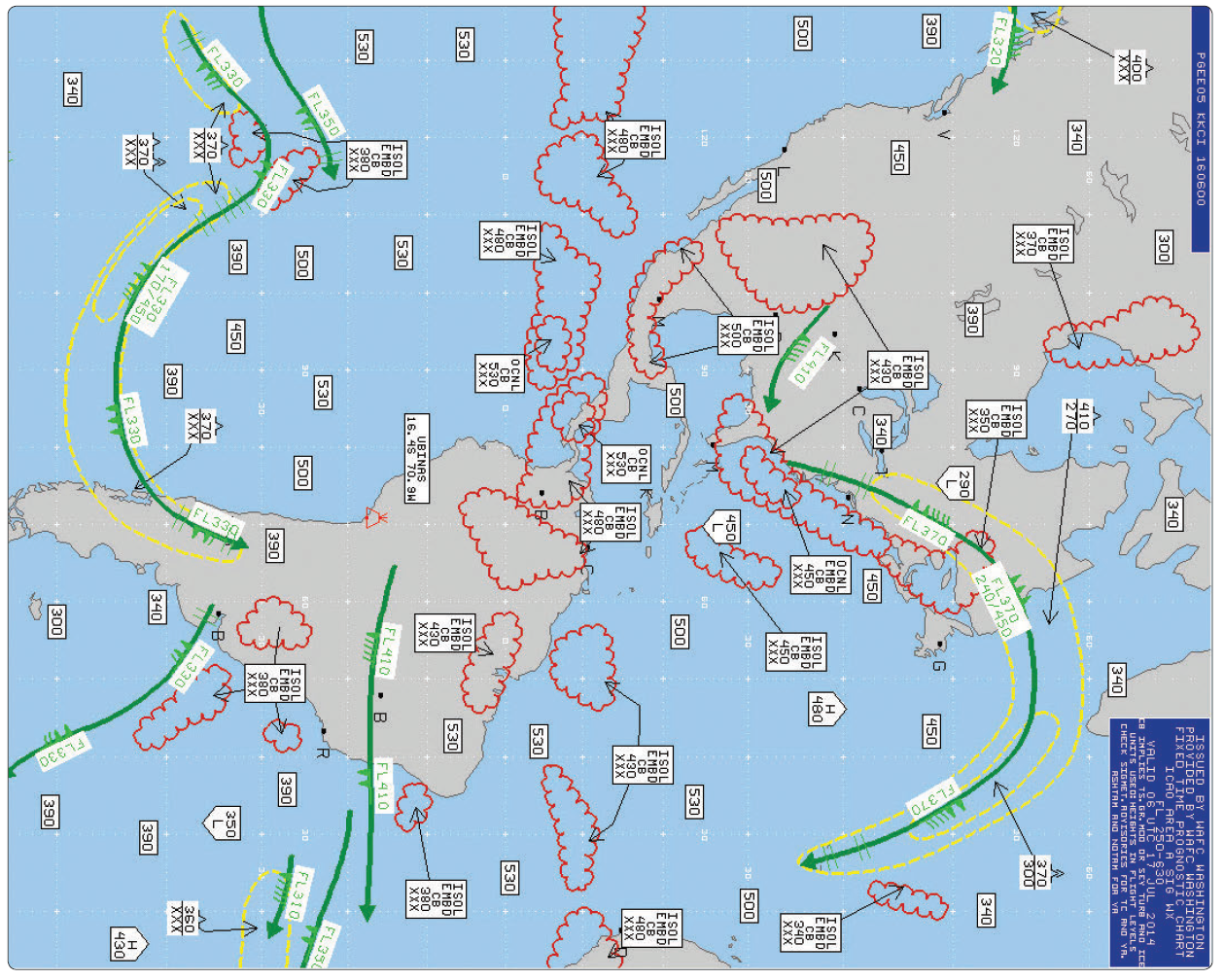

 CorrectIncorrect
CorrectIncorrect -
Question 31 of 805
31. Question
refer to the diagram below The 24-Hour Low-Level Significant Weather Prognostic Chart at 06Z indicates that Ohio will likely experience
 CorrectIncorrect
CorrectIncorrect -
Question 32 of 805
32. Question
The Low-Level Significant Weather Prognostic Chart depicts weather conditions
CorrectIncorrect -
Question 33 of 805
33. Question
Which meteorological conditions are depicted by a prognostic chart?
CorrectIncorrect -
Question 34 of 805
34. Question
A pilot planning to depart at 1100Z on an IFR flight is particularly concerned about the hazard of icing. What sources reflect the most accurate information on icing conditions (current and forecast) at the time of departure?
CorrectIncorrect -
Question 35 of 805
35. Question
What determines how icing is reported on a PIREP?
CorrectIncorrect -
Question 36 of 805
36. Question
What conclusion(s) can be drawn from a 500-millibar Constant Pressure Chart for a planned flight at FL 180?
CorrectIncorrect -
Question 37 of 805
37. Question
Which weather forecast describes prospects for an area coverage of both severe and general thunderstorms during the following 24 hours?
CorrectIncorrect -
Question 38 of 805
38. Question
The Surface Analysis Chart depicts
CorrectIncorrect -
Question 39 of 805
39. Question
What information is provided by a Convective Outlook (AC)?
CorrectIncorrect -
Question 40 of 805
40. Question
What does a Convective Outlook (AC) describe for a following 24-hr. period?
CorrectIncorrect -
Question 41 of 805
41. Question
If you encounter in-flight icing and ATC asks you to report your conditions, what are the official reportable icing values that you are expected to use?
CorrectIncorrect -
Question 42 of 805
42. Question
When are severe weather watch bulletins (WW) issued?
CorrectIncorrect -
Question 43 of 805
43. Question
What flight planning information can a pilot derive from constant pressure charts?
CorrectIncorrect -
Question 44 of 805
44. Question
Refer to the diagram below. Which navigational information and services would be available to the pilot when using the localizer frequency?
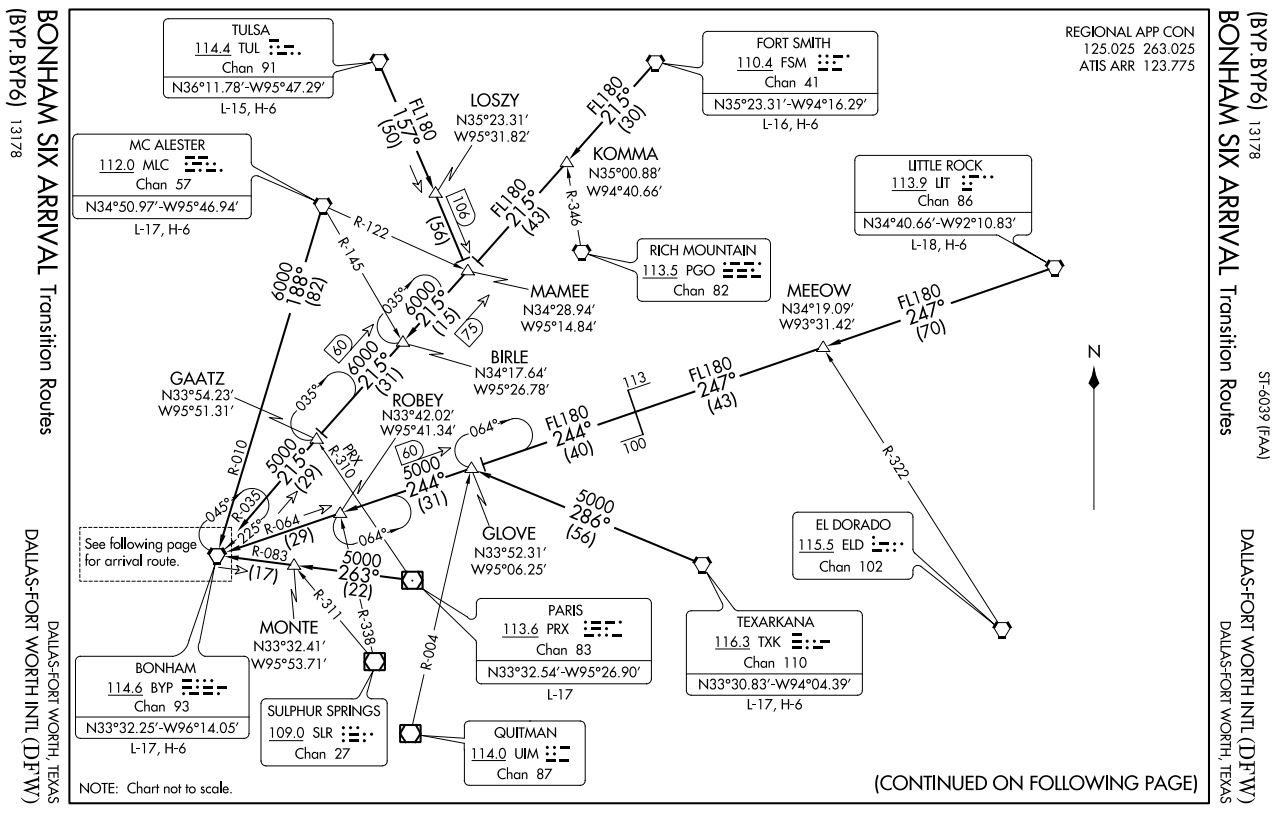 CorrectIncorrect
CorrectIncorrect -
Question 45 of 805
45. Question
Refer to the diagrams below. What rate of descent should you plan to use initially to establish the glidepath for the ILS RWY 36L approach? (Use 120 knots ground speed.)

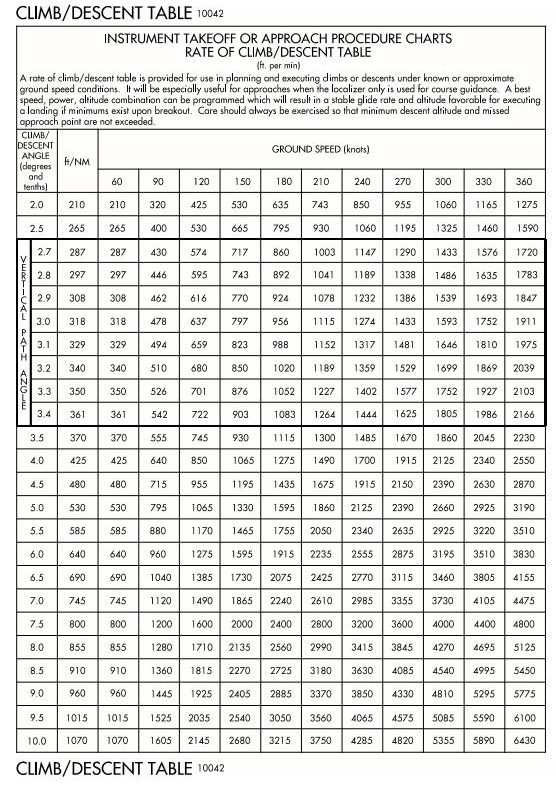 CorrectIncorrect
CorrectIncorrect -
Question 46 of 805
46. Question
Refer to the diagrams below. What is your position relative to the FLOSI intersection northbound on V213 airway?
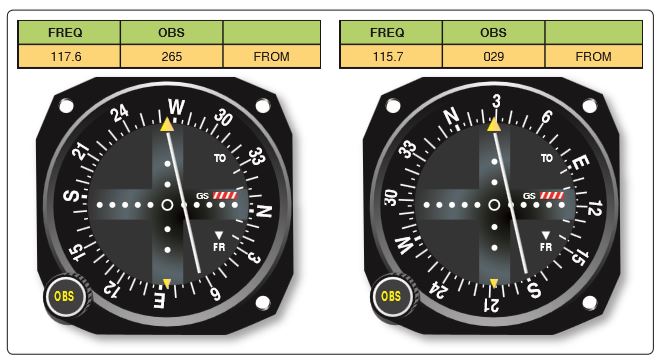
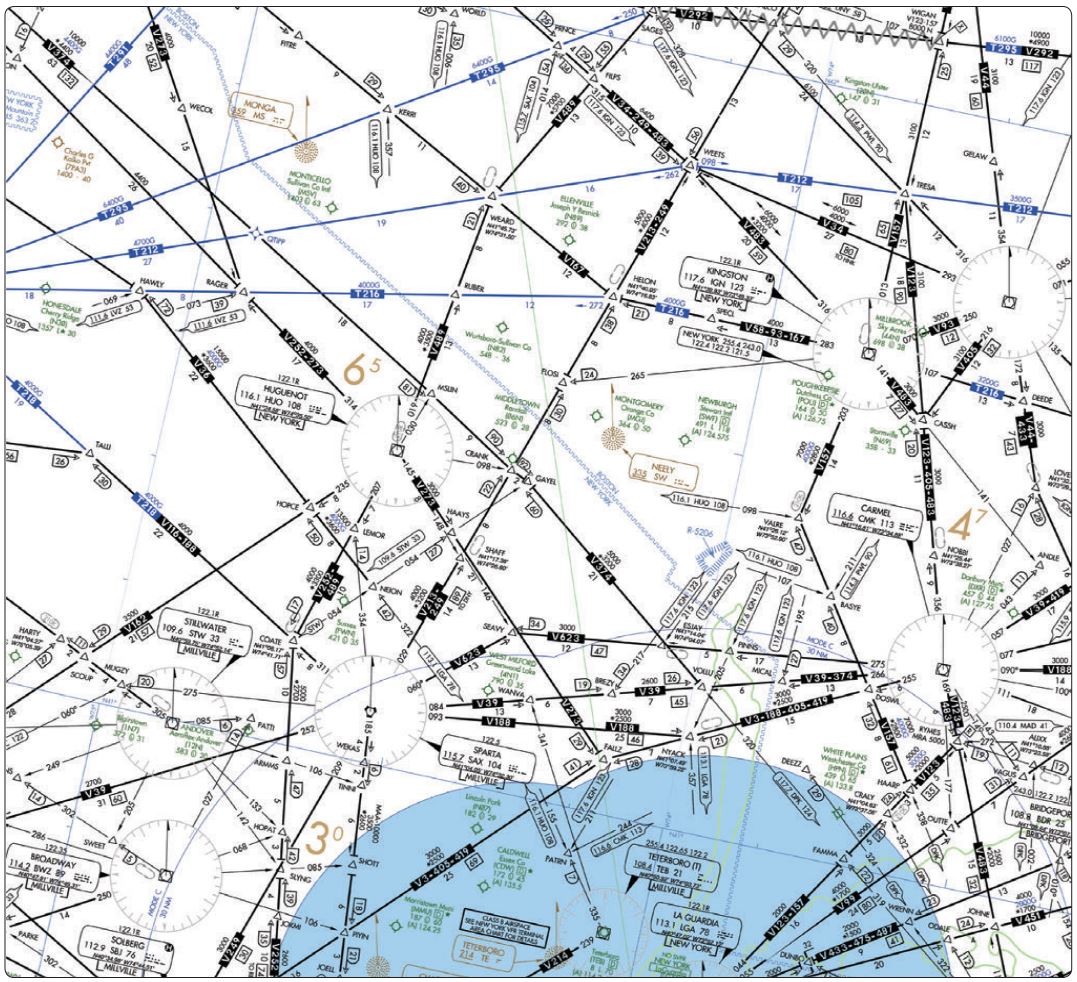 CorrectIncorrect
CorrectIncorrect -
Question 47 of 805
47. Question
Refer to the diagram below. At which indication or occurrence should you initiate the published missed approach procedure for the ILS RWY 6 approach provided the runway environment is not in sight?
 CorrectIncorrect
CorrectIncorrect -
Question 48 of 805
48. Question
Refer to the diagram below. What is the minimum altitude at which you should intercept the glide slope on the ILS RWY 6 approach procedure?
 CorrectIncorrect
CorrectIncorrect -
Question 49 of 805
49. Question
Refer to the diagram below. What is the touchdown zone elevation for RWY 6?
 CorrectIncorrect
CorrectIncorrect -
Question 50 of 805
50. Question
Refer to the diagrams below. Using an average ground speed of 90 knots on the final approach segment, what rate of descent should be used initially to establish the glidepath for the ILS RWY 6 approach procedure?

 CorrectIncorrect
CorrectIncorrect -
Question 51 of 805
51. Question
Refer to the diagrams below. Which runway and landing environment lighting is available for approach and landing on RWY6 at Bradley International?

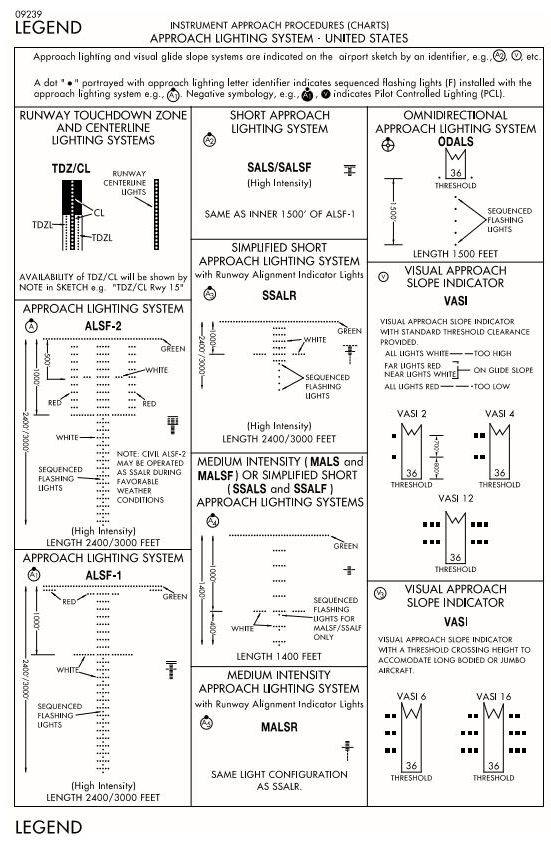 CorrectIncorrect
CorrectIncorrect -
Question 52 of 805
52. Question
Refer to the diagrams below. After passing the OM, Bradley Approach Control advises you that the MM on the ILS RWY 6 approach is inoperative . Under these circumstances, what adjustments, if any, are required to be made to the DH and visibility?

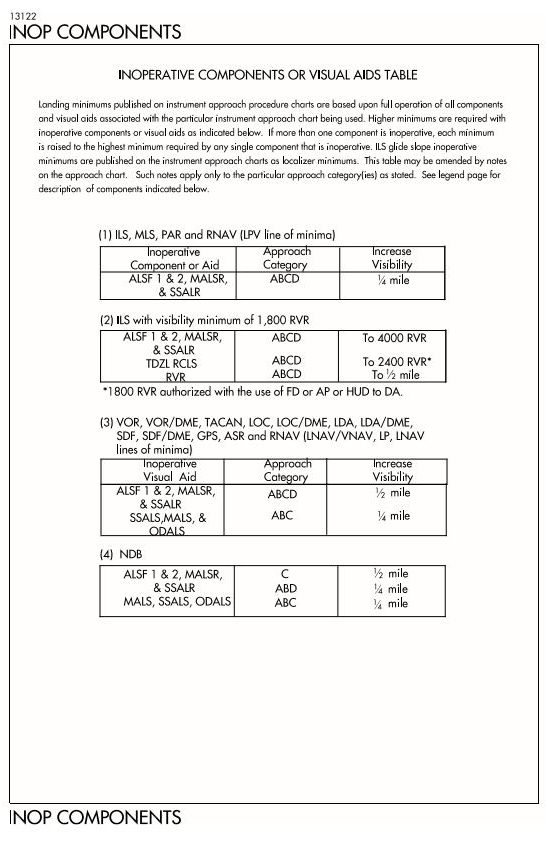 CorrectIncorrect
CorrectIncorrect -
Question 53 of 805
53. Question
Refer to the diagrams below. At which location or condition does the STELA.STELA1 arrival begin?
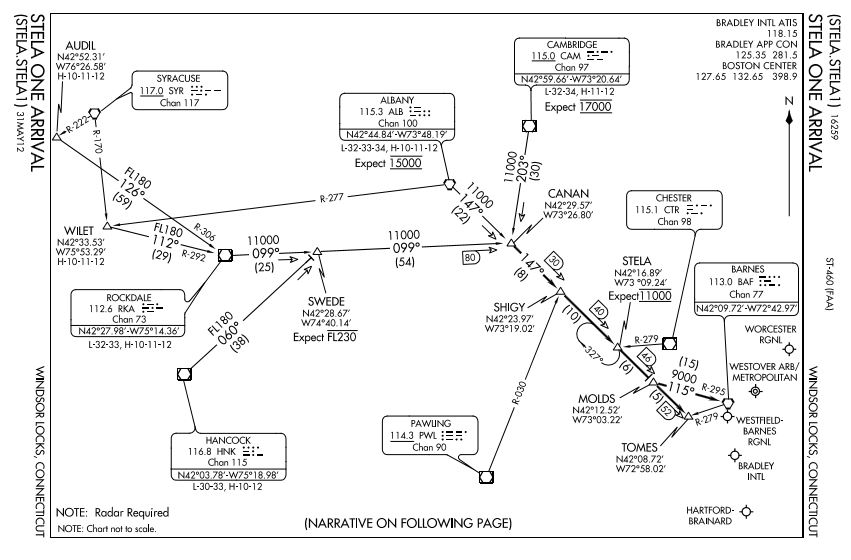
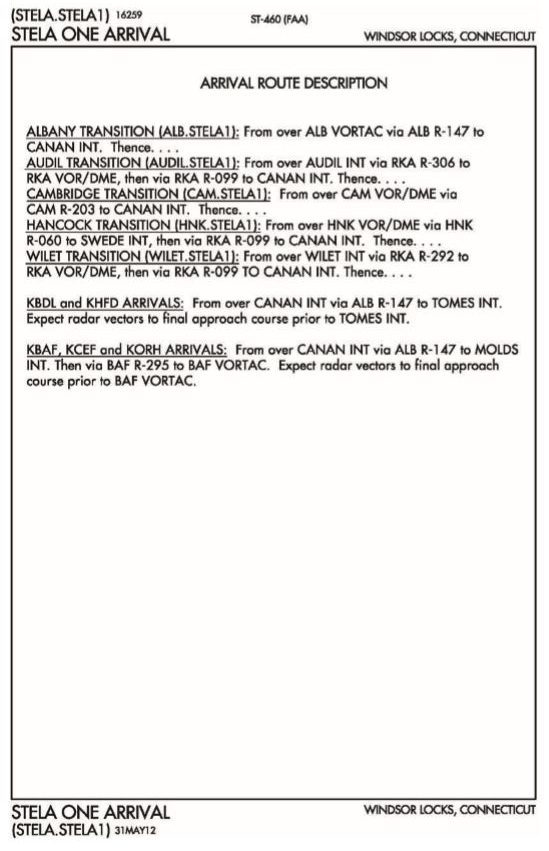 CorrectIncorrect
CorrectIncorrect -
Question 54 of 805
54. Question
Refer to the diagrams below. Which en route low altitude navigation chart would cover a proposed routing at the BOZEMAN VORTAC?

 CorrectIncorrect
CorrectIncorrect -
Question 55 of 805
55. Question
Refer to the diagram below. Which en route low altitude navigation chart would cover a proposed routing at the BOZEMAN VORTAC?
 CorrectIncorrect
CorrectIncorrect -
Question 56 of 805
56. Question
Refer to the diagram below. Using an average ground speed of 140 knots, what minimum rate of climb would meet the required minimum climb rate per NM as specified on the instrument departure procedure from RWY 9?
 CorrectIncorrect
CorrectIncorrect -
Question 57 of 805
57. Question
Refer to the diagram below. When eastbound on V86 between Whitehall and Livingston, the minimum altitude that you should cross BZN is
 CorrectIncorrect
CorrectIncorrect -
Question 58 of 805
58. Question
Refer to the diagram below. What is the maximum altitude that you may flight plan an IFR flight on V-86 EASTBOUND between BOZEMAN and BILLINGS VORTACs?
 CorrectIncorrect
CorrectIncorrect -
Question 59 of 805
59. Question
Refer to the diagram below. What is the minimum crossing altitude over the BOZEMAN VORTAC for a flight southeast bound on V86?
 CorrectIncorrect
CorrectIncorrect -
Question 60 of 805
60. Question
Refer to the diagram below. At which minimum altitude should you cross the STAKK intersection?
 CorrectIncorrect
CorrectIncorrect -
Question 61 of 805
61. Question
Refer to the diagram below. Which aircraft approach category should be used for a circling approach for a landing on RWY 28R in an aircraft with a V50 of 72 kt.?
 CorrectIncorrect
CorrectIncorrect -
Question 62 of 805
62. Question
Refer to the diagram below. How many initial approach fixes serve the VOR/DME RWY 28R (Billings Logan) approach procedure?
 CorrectIncorrect
CorrectIncorrect -
Question 63 of 805
63. Question
Refer to the diagram below. What night operations, if any, are authorized between the approach end of the runway, and the threshold lights?
 CorrectIncorrect
CorrectIncorrect -
Question 64 of 805
64. Question
Which runway marking indicates a displaced threshold on an instrument runway?
CorrectIncorrect -
Question 65 of 805
65. Question
Refer to the diagram below. What is the distance (A) from the beginning of the runway to the fixed distance marker?
 CorrectIncorrect
CorrectIncorrect -
Question 66 of 805
66. Question
Refer to the diagram below. What is the distance (B) from the beginning of the runway to the touchdown zone marker?
 CorrectIncorrect
CorrectIncorrect -
Question 67 of 805
67. Question
Refer to the diagram below. What is the distance (C) from the beginning of the touchdown zone marker to the beginning of the fixed distance marker?
 CorrectIncorrect
CorrectIncorrect -
Question 68 of 805
68. Question
Destination signs indicate
CorrectIncorrect -
Question 69 of 805
69. Question
The "ILS critical area boundary" sign identifies the
CorrectIncorrect -
Question 70 of 805
70. Question
The "runway hold position" sign denotes
CorrectIncorrect -
Question 71 of 805
71. Question
The "No Entry" sign identifies
CorrectIncorrect -
Question 72 of 805
72. Question
What is the purpose of the runway exit sign?
CorrectIncorrect -
Question 73 of 805
73. Question
When exiting the runway, what is the purpose of the runway exit sign?
CorrectIncorrect -
Question 74 of 805
74. Question
Refer to the diagram below. Which of the signs in the figure is a mandatory instruction sign?
 CorrectIncorrect
CorrectIncorrect -
Question 75 of 805
75. Question
Refer to the diagram below. While clearing an active runway, you are clear of the ILS critical area when you pass which sign?
 CorrectIncorrect
CorrectIncorrect -
Question 76 of 805
76. Question
Refer to the diagram below. Which sign indicates you are holding short of the ILS critical area?
 CorrectIncorrect
CorrectIncorrect -
Question 77 of 805
77. Question
A runway exit sign
CorrectIncorrect -
Question 78 of 805
78. Question
"Runway hold position" markings on the taxiway
CorrectIncorrect -
Question 79 of 805
79. Question
When turning onto a taxiway from another taxiway, the "taxiway directional sign" indicates
CorrectIncorrect -
Question 80 of 805
80. Question
Within aircraft movement areas, "destination signs" identify the
CorrectIncorrect -
Question 81 of 805
81. Question
Refer to the diagram below. Mandatory airport instruction signs are designated by having
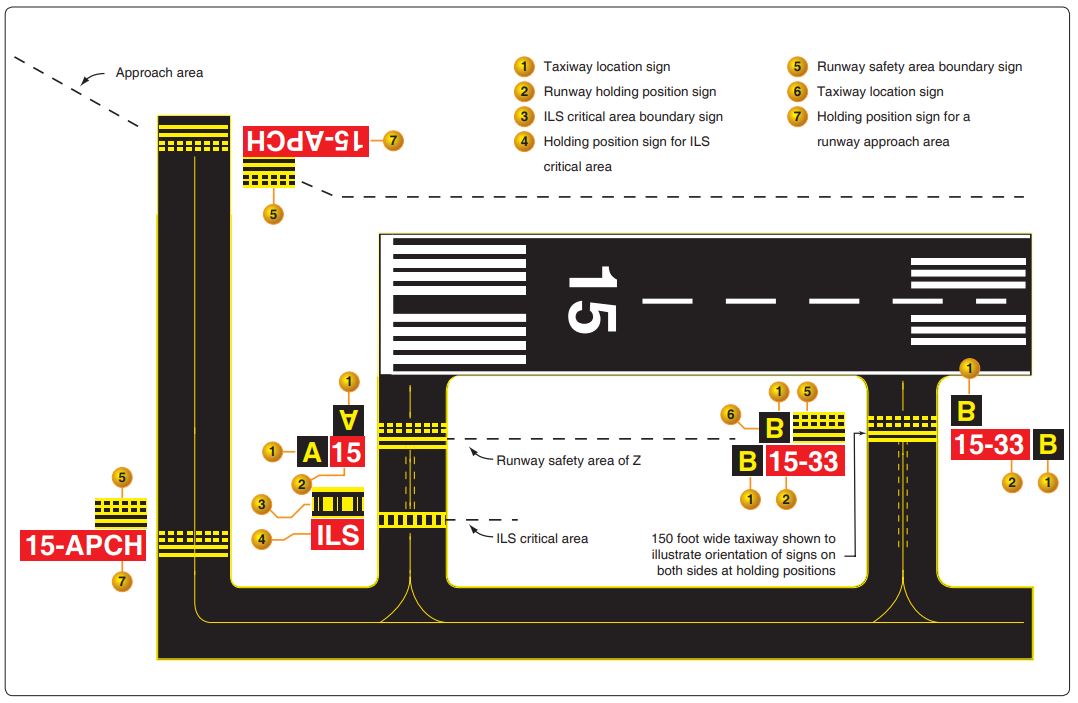 CorrectIncorrect
CorrectIncorrect -
Question 82 of 805
82. Question
Refer to the diagram below. What colors are runway holding position signs?
 CorrectIncorrect
CorrectIncorrect -
Question 83 of 805
83. Question
Refer to the diagram below. What colors are runway holding position signs?
 CorrectIncorrect
CorrectIncorrect -
Question 84 of 805
84. Question
Refer to the diagram below. Hold line markings at the intersection of taxiways and runways consist of four lines that extend across the width of the taxiway. These lines are
CorrectIncorrect -
Question 85 of 805
85. Question
Which approach and landing objective is assured when the pilot remains on the proper glidepath of the VASI?
CorrectIncorrect -
Question 86 of 805
86. Question
Refer to the diagram below. Which illustration would a pilot observe if the aircraft is above both glidepaths?
 CorrectIncorrect
CorrectIncorrect -
Question 87 of 805
87. Question
Refer to the diagram below. Which illustration would a pilot observe if the aircraft is below both glidepaths?
 CorrectIncorrect
CorrectIncorrect -
Question 88 of 805
88. Question
Refer to the diagram below. Which illustration would a pilot observe when on the lower glidepath?
 CorrectIncorrect
CorrectIncorrect -
Question 89 of 805
89. Question
Which of the following terms describes an airport?
CorrectIncorrect -
Question 90 of 805
90. Question
The Glide Path Qualification Surface (GQS) limits the height of obstructions between
CorrectIncorrect -
Question 91 of 805
91. Question
The term "airport" means an area of land or water that is
CorrectIncorrect -
Question 92 of 805
92. Question
Do regulations permit you to act as pilot in command of an airplane in IMC if you hold a private pilot certificate with ASEL, rotorcraft category, with helicopter class rating and instrument helicopter rating?
CorrectIncorrect -
Question 93 of 805
93. Question
Under which condition must the pilot in command of a civil aircraft have at least an instrument rating?
CorrectIncorrect -
Question 94 of 805
94. Question
The pilot in command of a civil aircraft must have an instrument rating only when operating
CorrectIncorrect -
Question 95 of 805
95. Question
What portion of dual instruction time may a certificated instrument flight instructor log as instrument flight time?
CorrectIncorrect -
Question 96 of 805
96. Question
To meet instrument experience requirements of CFR Part 61, section 61.57(c), a pilot enters the condition of flight in the pilot logbook as simulated instrument conditions, what other qualifying information must also be entered?
CorrectIncorrect -
Question 97 of 805
97. Question
Which flight time may be logged as instrument time when on an instrument flight plan?
CorrectIncorrect -
Question 98 of 805
98. Question
What are the requirements to log an ILS approach in VMC conditions for instrument currency?
CorrectIncorrect -
Question 99 of 805
99. Question
How long does a pilot meet the recency of experience requirements for IFR flight after successfully completing an instrument proficiency check if no further IFR flights are made?
CorrectIncorrect -
Question 100 of 805
100. Question
No pilot may act as pilot-in-command of an aircraft, under IFR or in weather conditions less than the minimums prescribed for VFR unless that pilot has, within the preceding 6 calendar months, completed at least
CorrectIncorrect -
Question 101 of 805
101. Question
After your recent IFR experience lapses, how much time do you have before you must pass an instrument proficiency check to act as pilot in command under IFR?
CorrectIncorrect -
Question 102 of 805
102. Question
To meet the minimum required instrument flight experience to act as pilot in command of an aircraft under IFR, you must have logged within the 6 calendar months preceding the month of the flight, in the same category of aircraft:
CorrectIncorrect -
Question 103 of 805
103. Question
When on the proper glidepath of a 2-bar VASI, the pilot will see the near bar as
CorrectIncorrect -
Question 104 of 805
104. Question
Which of the following indications would a pilot see while approaching to land on a runway served by a 2-bar VASI?
CorrectIncorrect -
Question 105 of 805
105. Question
If an approach is being made to a runway that has an operating 3-bar VASI and all the VASI lights appear red as the airplane reaches the MDA the pilot should
CorrectIncorrect -
Question 106 of 805
106. Question
The middle and far bars of a 3-bar VASI will
CorrectIncorrect -
Question 107 of 805
107. Question
Refer to the diagram below. An "on glidepath" indication is
 CorrectIncorrect
CorrectIncorrect -
Question 108 of 805
108. Question
Refer to the diagram below. Which illustration depicts a "slightly low" (2.8 degree) indication?
 CorrectIncorrect
CorrectIncorrect -
Question 109 of 805
109. Question
Refer to the diagram below. Which illustration would a pilot observe if the aircraft is less than 2.5 degrees?
 CorrectIncorrect
CorrectIncorrect -
Question 110 of 805
110. Question
Refer to the diagram below. Which illustration would a pilot observe if the aircraft is far below the glidepath?
 CorrectIncorrect
CorrectIncorrect -
Question 111 of 805
111. Question
Refer to the diagram below. You have accepted a visual approach to RWY 16L at EUG at night. As you approach the runway, you notice runway centerline lights. This indicates
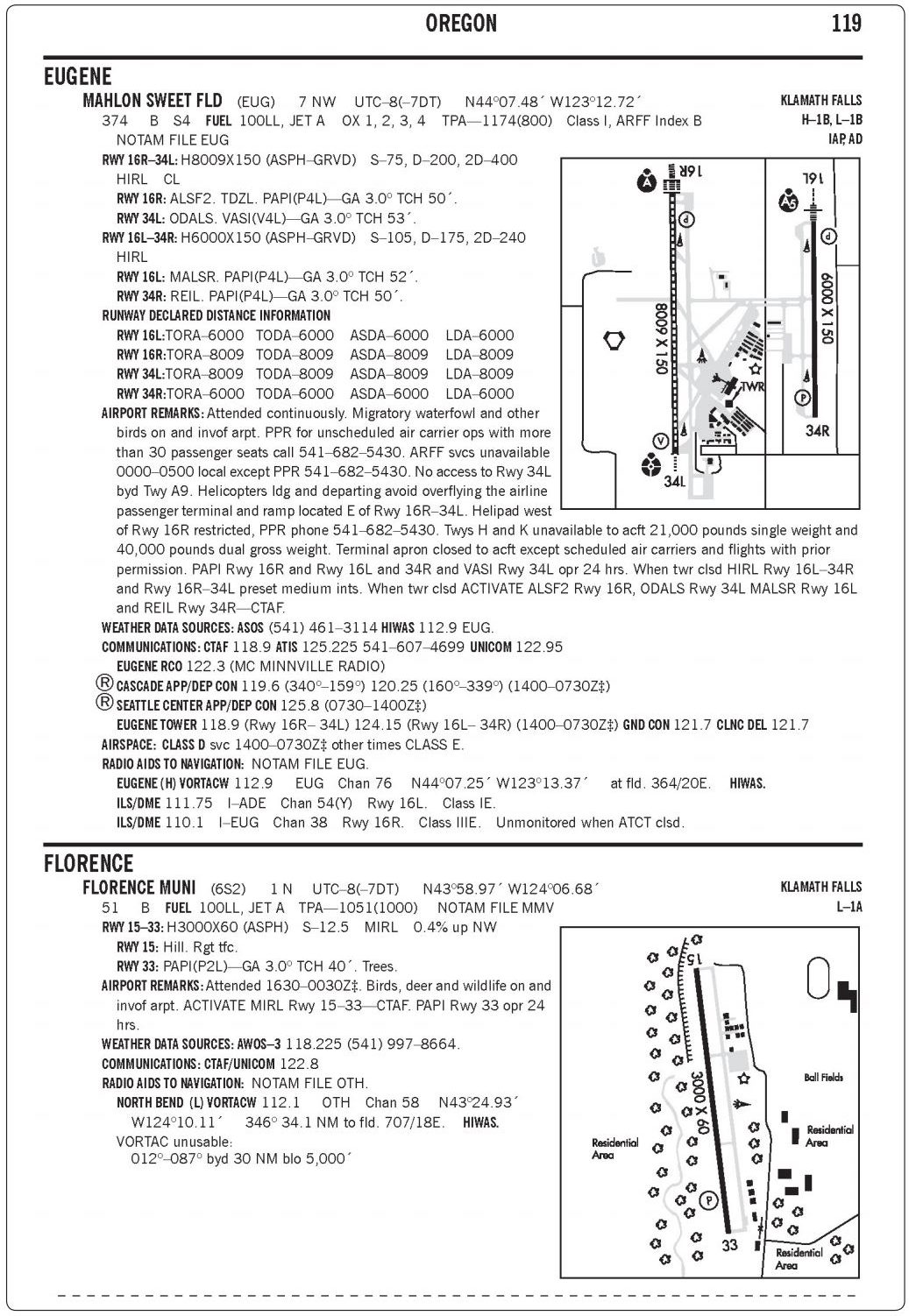 CorrectIncorrect
CorrectIncorrect -
Question 112 of 805
112. Question
The primary purpose of runway and identifier lights installed at many airfields is to provide
CorrectIncorrect -
Question 113 of 805
113. Question
Which type of runway lighting consists of a pair of synchronized flashing lights, one on each side of the runway threshold?0
CorrectIncorrect -
Question 114 of 805
114. Question
What wind condition prolongs the hazards of wake turbulence on a landing runway for the longest period of time?
CorrectIncorrect -
Question 115 of 805
115. Question
Wake turbulence is near maximum behind a jet transport just after takeoff because
CorrectIncorrect -
Question 116 of 805
116. Question
Refer to the diagram below. With winds reported as from 330° at 4 knots, you are given instructions to taxi to runway 4 for departure and to expect takeoff after an airliner departs from runway 29. What effect would you expect from that airliner's vortices.
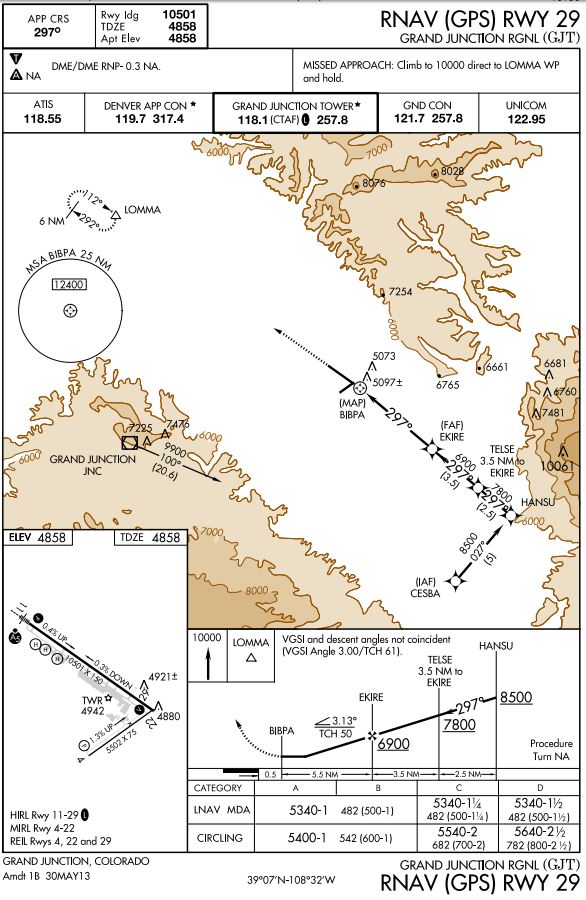 CorrectIncorrect
CorrectIncorrect -
Question 117 of 805
117. Question
What effect would a light crosswind of approximately 7 knots have on vortex behavior?
CorrectIncorrect -
Question 118 of 805
118. Question
When landing behind a large jet aircraft, at which point on the runway should you plan to land?
CorrectIncorrect -
Question 119 of 805
119. Question
Which procedure is recommended while climbing to an assigned altitude on the airway?
CorrectIncorrect -
Question 120 of 805
120. Question
What is expected of you as pilot on an IFR flight plan if you are descending or climbing in VFR conditions?
CorrectIncorrect -
Question 121 of 805
121. Question
When is a pilot on an IFR flight plan responsible for avoiding other aircraft?
CorrectIncorrect -
Question 122 of 805
122. Question
What responsibility does the pilot in command of an IFR flight assume upon entering VFR conditions?
CorrectIncorrect -
Question 123 of 805
123. Question
The most current en route and destination flight information for planning an instrument flight should be obtained from
CorrectIncorrect -
Question 124 of 805
124. Question
What is the purpose of FDC NOTAMs?
CorrectIncorrect -
Question 125 of 805
125. Question
From what source can you obtain the latest FDC NOTAMs?
CorrectIncorrect -
Question 126 of 805
126. Question
Which sources of aeronautical information, when used collectively, provide the latest status of airport conditions (e.g., runway closures, runway lighting, snow conditions)?
CorrectIncorrect -
Question 127 of 805
127. Question
Absence of the sky condition and visibility on an ATIS broadcast specifically implies that
CorrectIncorrect -
Question 128 of 805
128. Question
The operation of an airport rotating beacon during daylight hours may indicate that
CorrectIncorrect -
Question 129 of 805
129. Question
When are ATIS broadcasts updated?
CorrectIncorrect -
Question 130 of 805
130. Question
What information is contained in the Notices to Airmen Publication (NTAP)?
CorrectIncorrect -
Question 131 of 805
131. Question
What point at the destination should be used to compute estimated time en route on an IFR flight plan?
CorrectIncorrect -
Question 132 of 805
132. Question
Refer to the diagram below. Which equipment determines the code to be entered in block 3 as a suffix to aircraft type on the flight plan form?
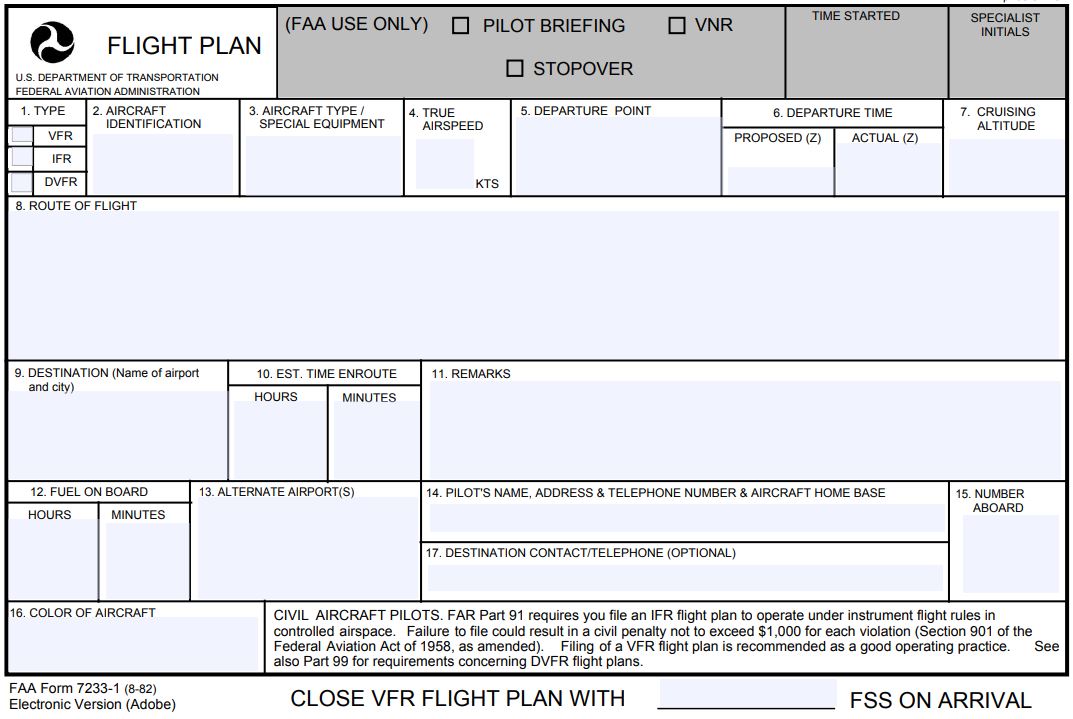 CorrectIncorrect
CorrectIncorrect -
Question 133 of 805
133. Question
Refer to the diagram below. What information should be entered in block 7 of an IFR flight plan if the flight has three legs, each at a different altitude?
 CorrectIncorrect
CorrectIncorrect -
Question 134 of 805
134. Question
Refer to the diagram below. The time entered in block 12 for an IFR flight should be based on which fuel quantity?
 CorrectIncorrect
CorrectIncorrect -
Question 135 of 805
135. Question
What is a waypoint when used for an IFR flight?
CorrectIncorrect -
Question 136 of 805
136. Question
You may cancel an IFR flight plan
CorrectIncorrect -
Question 137 of 805
137. Question
How is your flight plan closed when your destination airport has IFR conditions and there is no control tower?
CorrectIncorrect -
Question 138 of 805
138. Question
What response is expected when ATC issues an IFR clearance to pilots of airborne aircraft?
CorrectIncorrect -
Question 139 of 805
139. Question
Which clearance items are always given in an abbreviated IFR departure clearance? (Assume radar environment.)
CorrectIncorrect -
Question 140 of 805
140. Question
Which information is always given in an abbreviated departure clearance?
CorrectIncorrect -
Question 141 of 805
141. Question
An abbreviated departure clearance "...CLEARED AS FILED..." will always contain the name
CorrectIncorrect -
Question 142 of 805
142. Question
When departing from an airport not served by a control tower, the issuance of a clearance containing a void time indicates that
CorrectIncorrect -
Question 143 of 805
143. Question
On the runup pad, you receive the following clearance from ground control: CLEARED TO THE DALLAS-LOVE AIRPORT AS FILED--MAINTAIN SIX THOUSAND -- SQUAWK ZERO SEVEN ZERO FOUR JUST BEFORE DEPARTURE -- DEPARTURE CONTROL WILL BE ONE TWO FOUR POINT NINER.
An abbreviated clearance, such as this, will always contain theCorrectIncorrect -
Question 144 of 805
144. Question
What is the significance of an ATC clearance which reads "...CRUISE SIX THOUSAND..."?
CorrectIncorrect -
Question 145 of 805
145. Question
What is the significance of an ATC clearance which reads "...CRUISE SIX THOUSAND..."
CorrectIncorrect -
Question 146 of 805
146. Question
What is the rule or a pilot receiving a "Land and Hold Short Operation (LAHSO) clearance?"
CorrectIncorrect -
Question 147 of 805
147. Question
A "CRUISE FOUR THOUSAND FEET" clearance would mean that the pilot is authorized to
CorrectIncorrect -
Question 148 of 805
148. Question
When should pilots state their position on the airport when calling the tower for takeoff?
CorrectIncorrect -
Question 149 of 805
149. Question
During a takeoff into IMC at a controlled field with low ceilings, you should contact departure
CorrectIncorrect -
Question 150 of 805
150. Question
When should you transponder be on Mode C while on an IFR flight?
CorrectIncorrect -
Question 151 of 805
151. Question
What is the recommended climb procedure when a nonradar departure control instructs a pilot to climb to the assigned altitude?
CorrectIncorrect -
Question 152 of 805
152. Question
To comply with ATC instructions for altitude changes of more than 1,000 feet, what rate of climb or descent should be used?
CorrectIncorrect -
Question 153 of 805
153. Question
Which report should be made to ATC without a specific request when not in radar contact?
CorrectIncorrect -
Question 154 of 805
154. Question
When ATC has not imposed any climb or descent restrictions and aircraft are within 1,000 feet of assigned altitude, pilots should attempt to both climb and descend at a rate of between
CorrectIncorrect -
Question 155 of 805
155. Question
What does the ATC term "Radar Contact" signify?
CorrectIncorrect -
Question 156 of 805
156. Question
For IFR planning purposes, what are the compulsory reporting points when using VOR/DME or VORTAC fixes to define a direct route not on
established airways?CorrectIncorrect -
Question 157 of 805
157. Question
During a flight, the controller advises "traffic 2 o'clock 5 miles southbound." The pilot is holding 20° correction for a crosswind from the right. Where should the pilot look for the traffic?
CorrectIncorrect -
Question 158 of 805
158. Question
While performing a VFR practice instrument approach, Radar Approach Control assigns an altitude or heading that will cause you to enter the clouds. What action should you take?
CorrectIncorrect -
Question 159 of 805
159. Question
You have not yet been cleared for the approach, but you are being vectored to the ILS approach course. It is clear that you will pass through the localizer course unless you take action. You should
CorrectIncorrect -
Question 160 of 805
160. Question
What is the pilot in command's responsibility when flying a propeller aircraft within 20 miles of the airport of intended landing and ATC requests the pilot to reduce speed to 160? (Pilot complies with speed adjustment.)
CorrectIncorrect -
Question 161 of 805
161. Question
Upon intercepting the assigned radial, the controller advises you that you are on the airway and to "RESUME OWN NAVIGATION." This phrase means that
CorrectIncorrect -
Question 162 of 805
162. Question
During the en route phase of an IFR flight, the pilot is advised "Radar service terminated." What action is appropriate?
CorrectIncorrect -
Question 163 of 805
163. Question
What is meant when departure control instructs you to "resume own navigation" after you have been vectored to a Victor airway?
CorrectIncorrect -
Question 164 of 805
164. Question
What service is provided by departure control to an IFR flight when operating from an airport within the outer area of Class C airspace?
CorrectIncorrect -
Question 165 of 805
165. Question
While on an IFR flight plan, you should notify ATC of a variation in speed when
CorrectIncorrect -
Question 166 of 805
166. Question
Unless otherwise stated, instrument procedures use the standard IFR climb gradient of
CorrectIncorrect -
Question 167 of 805
167. Question
When are you required to establish communications with the tower (Class D airspace), if you cancel your IFR flight plan 10 miles from the
destination?CorrectIncorrect -
Question 168 of 805
168. Question
What does declaring "minimum fuel" to ATC imply?
CorrectIncorrect -
Question 169 of 805
169. Question
Which procedure should you follow if you experience two-way communications failure while holding at holding fix with an EFC time? (The holding fix is not the same as the approach fix.)
CorrectIncorrect -
Question 170 of 805
170. Question
You enter a holding pattern (at a fix that is not the same as the approach fix) with an EFC time of 1530 . At 1520 you experience complete two-way communications failure. Which procedure should you follow to execute the approach to a landing?
CorrectIncorrect -
Question 171 of 805
171. Question
You are !n IMC and have two-way radio communications failure. If you do not exercise emergency authority, what procedure are you expected to follow?
CorrectIncorrect -
Question 172 of 805
172. Question
What altitude and route should be used if you are flying in IMC and have two-way radio communications failure?
CorrectIncorrect -
Question 173 of 805
173. Question
Which procedure should you follow if, during an IFR flight in VFR conditions, you have two-way radio communications failure?
CorrectIncorrect -
Question 174 of 805
174. Question
While flying on an IFR flight plan, you experience two-way communications radio failure while in VFR conditions. In this situation, you should continue your flight under
CorrectIncorrect -
Question 175 of 805
175. Question
What action should you take if your DME fails at FL 240?
CorrectIncorrect -
Question 176 of 805
176. Question
What action should you take if your No. 1 VOR receiver malfunctions while operating in controlled airspace under IFR? Your aircraft is equipped with
two VOR receivers. The No. 1 receiver has Omni/Localizer/Glide Slope capability, and the No. 2 receiver has only VOR/Localizer capability.CorrectIncorrect -
Question 177 of 805
177. Question
To meet the minimum instrument experience requirements, within the last 6 calendar months you need
CorrectIncorrect -
Question 178 of 805
178. Question
A pilot may satisfy the recent flight experience requirement necessary to act as pilot in command in IMC in powered aircraft by logging within the 6 calendar months preceding the month of the flight
CorrectIncorrect -
Question 179 of 805
179. Question
What minimum conditions are necessary for the instrument approaches required for IFR currency?
CorrectIncorrect -
Question 180 of 805
180. Question
What recent instrument flight experience requirements must be met before you may act as pilot in command of an airplane under IFR?
CorrectIncorrect -
Question 181 of 805
181. Question
An instrument rated pilot who has not logged any instrument time in 1 year or more cannot serve as pilot in command under IFR, unless the pilot
CorrectIncorrect -
Question 182 of 805
182. Question
A pilot's recent IFR experience expires on July 1 of this year. What is the latest date the pilot can meet the IFR experience requirement without having to take an instrument proficiency check?
CorrectIncorrect -
Question 183 of 805
183. Question
How may a pilot satisfy the recent flight experience requirement necessary to act as pilot in command in IMC in powered aircraft? Within the previous 6 calendar months, logged
CorrectIncorrect -
Question 184 of 805
184. Question
Which additional IFR experience is required for you to meet the recent flight experience requirements to act as pilot in command of an airplane under IFR?
Your present instrument experience within the preceding 6 calendar months is
1. three hours with holding, intercepting and tracking courses in an approved airplane flight simulator.
2. two instrument approaches in an airplane.
CorrectIncorrect -
Question 185 of 805
185. Question
A pilot plans an IFR flight on July 10 of this year. In order to meet IFR currency requirements the pilot must have
CorrectIncorrect -
Question 186 of 805
186. Question
Which additional instrument experience, within the preceding 6 calendar months, is required to meet the requirements to act as pilot in command of an airplane under IFR if you already have 3 hours in an instrument simulator (including holding, intercepting, and tracking courses) and two instrument approaches in an airplane?
CorrectIncorrect -
Question 187 of 805
187. Question
To carry passengers for hire in an airplane on cross-country flights of more than 50 NM from the departure airport, the pilot in command is required to hold at least
CorrectIncorrect -
Question 188 of 805
188. Question
Which limitation is imposed on the holder of a Commercial Pilot Certificate if that person does not hold an instrument rating?
CorrectIncorrect -
Question 189 of 805
189. Question
What limitation is imposed on a newly certificated commercial airplane pilot if that person does not hold an instrument pilot rating?
CorrectIncorrect -
Question 190 of 805
190. Question
A certificated commercial pilot who carries passengers for hire at night or in excess of 50 NM is required to have at least
CorrectIncorrect -
Question 191 of 805
191. Question
You intend to carry passengers for hire on a night VFR flight in a single-engine airplane with a 25-mile radius of the departure airport. You are required to possess at least which ratings(s)?
CorrectIncorrect -
Question 192 of 805
192. Question
Who is responsible for determining that the altimeter system has been checked and found to meet 14 CFR Part 91 requirements for a particular instrument flight?
CorrectIncorrect -
Question 193 of 805
193. Question
The use of certain portable electronic devices is prohibited on aircraft that are being operated under
CorrectIncorrect -
Question 194 of 805
194. Question
Before beginning any flight under IFR, the pilot in command must become familiar with all available information concerning that flight. In addition, the pilot must
CorrectIncorrect -
Question 195 of 805
195. Question
What is the procedure when the DME malfunctions at or above 24,000 feet MSL?
CorrectIncorrect -
Question 196 of 805
196. Question
Which types of airspace are depicted on the En Route Low Altitude Chart?
CorrectIncorrect -
Question 197 of 805
197. Question
The vertical extent of the Class A airspace extends from
CorrectIncorrect -
Question 198 of 805
198. Question
Which airspace is defined as a transition area when designated in conjunction with an airport which has a prescribed IAP?
CorrectIncorrect -
Question 199 of 805
199. Question
Class G airspace is that airspace where
CorrectIncorrect -
Question 200 of 805
200. Question
MCAs are established to
CorrectIncorrect -
Question 201 of 805
201. Question
What minimum aircraft equipment is required for operation within Class C airspace?
CorrectIncorrect -
Question 202 of 805
202. Question
What are the vertical limits of a transition area that is designated in conjunction with an airport having a prescribed IAP?
CorrectIncorrect -
Question 203 of 805
203. Question
Refer to the diagram below. You are cleared to land on RWY 16L at Eugene Mahlon Sweet Field. As you break out of the clouds, you are lined up with the white lights down the center of the runway, which lets you know that you

 CorrectIncorrect
CorrectIncorrect -
Question 204 of 805
204. Question
Refer to the diagram below. What is the slope of RWY 9?
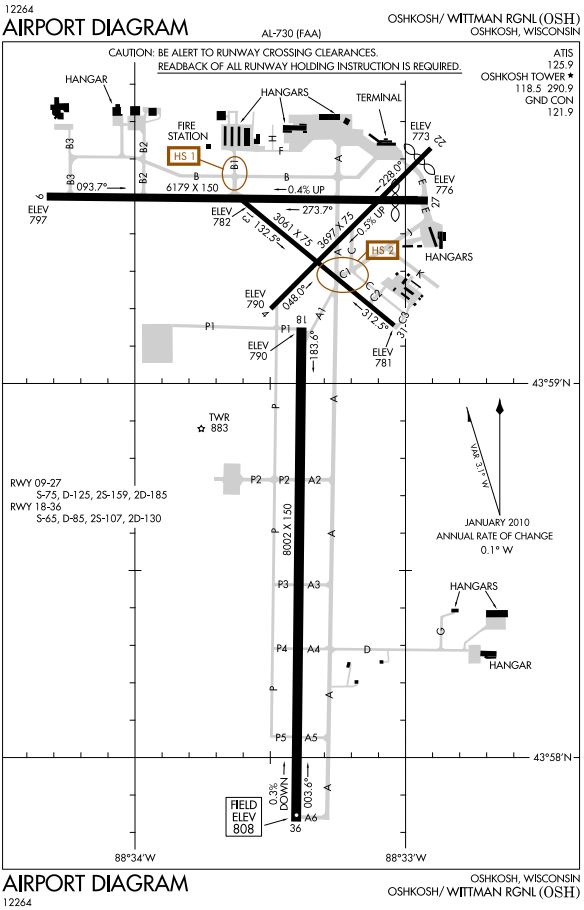 CorrectIncorrect
CorrectIncorrect -
Question 205 of 805
205. Question
Refer to the diagram below. When lined up for takeoff on runway 4, the compass and heading indicator should read a heading of about
 CorrectIncorrect
CorrectIncorrect -
Question 206 of 805
206. Question
Refer to the diagram below. When lined up for takeoff on runway 18, the compass and heading indicator should display a heading of about
 CorrectIncorrect
CorrectIncorrect -
Question 207 of 805
207. Question
Refer to the diagram below. What is the actual heading of the north runway at Oshkosh/Wittman Regional (OSH) airport?
 CorrectIncorrect
CorrectIncorrect -
Question 208 of 805
208. Question
Refer to the diagram below. When lined up for takeoff on RWY 27, the compass and heading indicator should display a heading of about
 CorrectIncorrect
CorrectIncorrect -
Question 209 of 805
209. Question
Before beginning any flight under IFR, the pilot in command must become familiar with all available information concerning that flight including:
CorrectIncorrect -
Question 210 of 805
210. Question
What are the minimum qualifications for a person who occupies the other control seat as safety pilot during simulated instrument flight?
CorrectIncorrect -
Question 211 of 805
211. Question
When may ATC request a detailed report of an emergency even though a rule has not been violated?
CorrectIncorrect -
Question 212 of 805
212. Question
While on an IFR flight, a pilot has an emergency which causes a deviation from an ATC clearance. What action must be taken?
CorrectIncorrect -
Question 213 of 805
213. Question
During an IFR flight in IMC, a distress condition is encountered, (fire, mechanical, or structural failure). The pilot should
CorrectIncorrect -
Question 214 of 805
214. Question
While on an IFR flight, a pilot has an emergency that causes a deviation from an ATC clearance. What action must be taken?
CorrectIncorrect -
Question 215 of 805
215. Question
Your transponder is inoperative. What are the requirements for flying in Class D airspace?
CorrectIncorrect -
Question 216 of 805
216. Question
In addition to a VOR receiver and two-way communications capability, which additional equipment is required for IFR operation in Class B airspace?
CorrectIncorrect -
Question 217 of 805
217. Question
Which of the following is required equipment for operating an aircraft within Class B airspace?
CorrectIncorrect -
Question 218 of 805
218. Question
When is an IFR clearance required during VFR weather conditions?
CorrectIncorrect -
Question 219 of 805
219. Question
When is an IFR flight plan required?
CorrectIncorrect -
Question 220 of 805
220. Question
Operation in which airspace requires filing an IFR flight plan?
CorrectIncorrect -
Question 221 of 805
221. Question
When are you required to have an instrument rating for flight in VMC?
CorrectIncorrect -
Question 222 of 805
222. Question
What is the required flight visibility and distance from clouds if you are operating in Class E airspace at 9,500 feet MSL with a VFR-on-Top clearance during daylight hours?
CorrectIncorrect -
Question 223 of 805
223. Question
What conditions are necessary before ATC can authorize a visual approach?
CorrectIncorrect -
Question 224 of 805
224. Question
What is the minimum flight visibility and distance from clouds for flight at 10,500 feet with a VFR-on-Top clearance during daylight hours? (Class E airspace.)
CorrectIncorrect -
Question 225 of 805
225. Question
What are the main differences between a visual approach and a contact approach?
CorrectIncorrect -
Question 226 of 805
226. Question
A contact approach is an approach procedure that may be used
CorrectIncorrect -
Question 227 of 805
227. Question
You arrive at your destination airport on an IFR flight plan. Which is a prerequisite condition for the performance of a contact approach?
CorrectIncorrect -
Question 228 of 805
228. Question
Flying clear of clouds on an instrument flight plan, what are the requirements for a contact approach to an airport that has an approved IAP?
CorrectIncorrect -
Question 229 of 805
229. Question
When is radar service terminated during a visual approach?
CorrectIncorrect -
Question 230 of 805
230. Question
When may you obtain a contact approach?
CorrectIncorrect -
Question 231 of 805
231. Question
A Precision Runway Monitor (PRM), approach requires
CorrectIncorrect -
Question 232 of 805
232. Question
Precision Runway Monitoring (PRM) is
CorrectIncorrect -
Question 233 of 805
233. Question
What does the Runway Visual Range (RVR) value, depicted on certain straight-in IAP Charts, represent?
CorrectIncorrect -
Question 234 of 805
234. Question
The RVR minimums for takeoff or landing are published in an IAP, but RVR is inoperative and cannot be reported for the runway at the time. Which of the following would apply?
CorrectIncorrect -
Question 235 of 805
235. Question
RVR minimums for landing are prescribed in an IAP, but RVR is inoperative and cannot be reported for the intended runway at the time. Which of the following would be an operational consideration?
CorrectIncorrect -
Question 236 of 805
236. Question
If the RVR equipment is inoperative for an IAP that requires a visibility of 2,400 RVR, how should the pilot expect the visibility requirement to be reported in lieu of the published RVR?
CorrectIncorrect -
Question 237 of 805
237. Question
If the RVR is not reported, what meteorological value should you substitute for 2400 RVR?
CorrectIncorrect -
Question 238 of 805
238. Question
If an early missed approach is initiated before reaching the MAP, the following procedure should be used unless otherwise cleared by ATC
CorrectIncorrect -
Question 239 of 805
239. Question
If the pilot loses visual reference while circling to land from an instrument approach and ATC radar service is not available, the missed approach action
CorrectIncorrect -
Question 240 of 805
240. Question
Refer to the diagram below. During the LOG RWY 35 missed approach at Duncan/Halliburton Field (DUG), what would be the appropriate entry for the
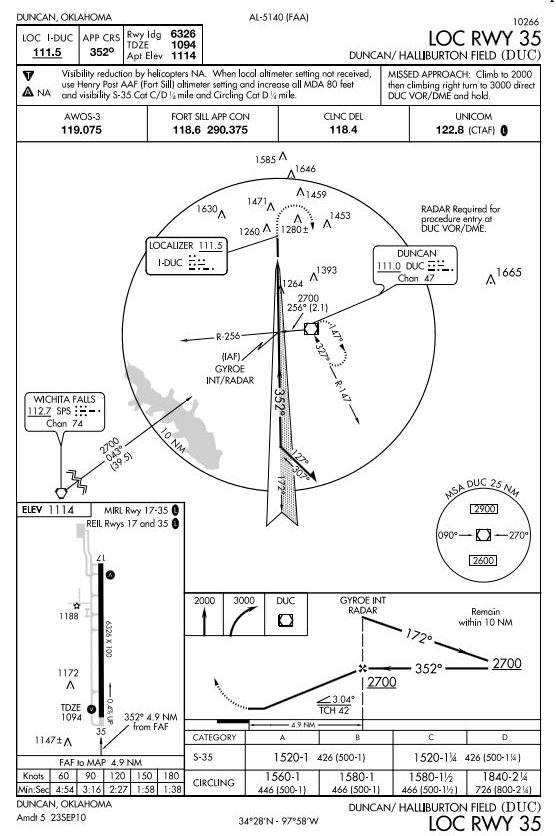 CorrectIncorrect
CorrectIncorrect -
Question 241 of 805
241. Question
Which of the following statements is true regarding Parallel ILS approaches?
CorrectIncorrect -
Question 242 of 805
242. Question
If all ILS components are operating and the required visual references are not established, the missed approach should be initiated upon
CorrectIncorrect -
Question 243 of 805
243. Question
If during an ILS approach in IFR conditions, the approach lights are not visible upon arrival at the DH, the pilot is
CorrectIncorrect -
Question 244 of 805
244. Question
How does a pilot determine if DME is available on an ILS/LOC?
CorrectIncorrect -
Question 245 of 805
245. Question
Refer to the diagrams below. Which displacement from the localizer centerline and glide slope at the 1,300-foot point from the runway is indicated?

 CorrectIncorrect
CorrectIncorrect -
Question 246 of 805
246. Question
Refer to the diagrams below. Which displacement from the localizer centerline and glide slope indicates you are high and to the left of the ILS course?


 CorrectIncorrect
CorrectIncorrect -
Question 247 of 805
247. Question
Refer to the diagrams below. Which displacement from the localizer centerline and glide slope indicates you are low and to the left of the ILS course?


 CorrectIncorrect
CorrectIncorrect -
Question 248 of 805
248. Question
Refer to the diagrams below. Which displacement from the localizer centerline and glide slope indicates you are high and to the right of the ILS course?


 CorrectIncorrect
CorrectIncorrect -
Question 249 of 805
249. Question
Which pilot action is appropriate if more than one component of an ILS is unusable?
CorrectIncorrect -
Question 250 of 805
250. Question
Which substitution is appropriate during an ILS approach?
CorrectIncorrect -
Question 251 of 805
251. Question
A pilot is making an ILS approach and is past the OM to a runway which has a VASI. What action is appropriate if an electronic glide slope malfunction occurs and the pilot has the VSI in sight?
CorrectIncorrect -
Question 252 of 805
252. Question
Immediately after passing the final approach fix in bound during an ILS approach in IFR conditions the glide slope warning flag appears. The pilot is
CorrectIncorrect -
Question 253 of 805
253. Question
When installed with the ILS and specified in the approach procedures, DME may be used
CorrectIncorrect -
Question 254 of 805
254. Question
When passing through an abrupt wind shear which involves a shift from a tailwind to a headwind, what power management would normally be required to maintain a constant indicated airspeed and ILS glide slope?
CorrectIncorrect -
Question 255 of 805
255. Question
The rate of descent on the glide slope depends on
CorrectIncorrect -
Question 256 of 805
256. Question
The rate of descent required to stay on the ILS glide slope
CorrectIncorrect -
Question 257 of 805
257. Question
During a precision radar or ILS approach, the rate of descent required to remain on the glide slope will
CorrectIncorrect -
Question 258 of 805
258. Question
A flight is to be conducted in VFR-on-Top conditions at 12,500 feet MSL (above 1,200 feet AGL). What is the in-flight visibility and distance from clouds required for operation in Class E airspace during daylight hours?
CorrectIncorrect -
Question 259 of 805
259. Question
What is the minimum in-flight visibility and distance from clouds required for an airplane operating less than 1,200 feet AGL during daylight hours in Class G airspace?
CorrectIncorrect -
Question 260 of 805
260. Question
What is the minimum in-flight visibility and distance from clouds required in VFR conditions above clouds at 13,500 feet MSL (above 1,200 feet AGL) in Class G airspace during daylight hours?
CorrectIncorrect -
Question 261 of 805
261. Question
What is the minimum in-flight visibility and distance from clouds required for a VFR-on-Top flight at 9,500 feet MSL (above 1,200 feet AGL) during daylight hours?
CorrectIncorrect -
Question 262 of 805
262. Question
What in-flight visibility and distance from clouds is required for a flight at 8,500 feet MSL (above 1,200 feet AGL) in Class G airspace in VFR conditions during daylight hours?
CorrectIncorrect -
Question 263 of 805
263. Question
What is the minimum in-flight visibility and distance from clouds required for an airplane operating less than 1,200 feet AGL under special VFR during daylight hours?
CorrectIncorrect -
Question 264 of 805
264. Question
What are the minimum fuel requirements in IFR conditions, if the first airport of intended landing is forecast to have a 1,500 foot ceiling and 3 miles visibility at flight-planned ETA? Fuel to fly to the first airport of intended landing,
CorrectIncorrect -
Question 265 of 805
265. Question
During your preflight planning for an IFR flight, you determine that the first airport of intended landing has no instrument approach prescribed in 14 CFR part 97. The weather forecast for one hour before through one hour after your estimated time of arrival is 3,000 ft. scattered with 5 miles visibility. To meet the fuel requirements for this flight, you must be able to fly to the first airport of intended landing,
CorrectIncorrect -
Question 266 of 805
266. Question
When tracking in bound on the localizer, which of the following is the proper procedure regarding drift corrections?
CorrectIncorrect -
Question 267 of 805
267. Question
What effect will a change in wind direction have upon maintaining a 3° glide slope at a constant true
CorrectIncorrect -
Question 268 of 805
268. Question
While being vectored, if crossing the ILS final approach course becomes imminent and an approach clearance has not been issued, what action should be taken by the pilot?
CorrectIncorrect -
Question 269 of 805
269. Question
Thrust is managed to maintain IAS, and glide slope is being flown. What characteristics should be observed when a headwind shears to be a constant tailwind?
CorrectIncorrect -
Question 270 of 805
270. Question
The glide slope and localizer are centered, but the airspeed is too fast. Which should be adjusted initially?
CorrectIncorrect -
Question 271 of 805
271. Question
While flying a 3° glide slope, a constant tailwind shears to a calm wind. Which conditions should the pilot expect?
CorrectIncorrect -
Question 272 of 805
272. Question
While flying a 3° glide slope, a headwind shears to a tailwind. Which conditions should the pilot expect on a glide slope?
CorrectIncorrect -
Question 273 of 805
273. Question
When cleared to execute a published sidestep maneuver for a specific approach and landing on the parallel runway, at what point is the pilot expected to commence this maneuver?
CorrectIncorrect -
Question 274 of 805
274. Question
Assume this clearance is received:
"CLEARED FOR ILS RUNWAY 07 LEFT APPROACH, SIDE-STEP TO RUNWAY 07 RIGHT."
When would the pilot be expected to commence the side-step maneuver?CorrectIncorrect -
Question 275 of 805
275. Question
Refer to the diagram below. You receive this ATC clearance: "...CLEARED TO THE ABC VORTAC. HOLD WEST ON THE TWO SEVEN ZERO RADIAL..." What is the recommended procedure to enter the holding pattern?
 CorrectIncorrect
CorrectIncorrect -
Question 276 of 805
276. Question
Refer to the diagram below. you receive the ATC clearance: "...HOLD EAST OF THE ABC VORTAC ON THE ZERO NINER ZERO RADIAL LEFT TURNS..." What is the recommended procedure to enter the holding pattern?
 CorrectIncorrect
CorrectIncorrect -
Question 277 of 805
277. Question
Refer to the diagram below. You receive this ATC clearance: "...CLEARED TO THE ABC VORTAC HOLD SOUTH ON THE ONE EIGHT ZERO RADIAL..." What is the recommended procedure to enter the holding pattern?
 CorrectIncorrect
CorrectIncorrect -
Question 278 of 805
278. Question
Refer to the diagram below. You receive this ATC clearance: "...CLEARED TO THE XYZ VORTAC HOLD NORTH ON THE THREE SIX ZERO RADIAL LEFT TURNS...." What is the recommended procedure to enter the holding pattern?
 CorrectIncorrect
CorrectIncorrect -
Question 279 of 805
279. Question
Refer to the diagram below. A pilot receives this ATC clearance: "...CLEARED TO THE ABC VORTAC HOLD WEST ON THE TWO SEVEN ZERO RADIAL..." What is the recommended procedure to enter the holding pattern?
 CorrectIncorrect
CorrectIncorrect -
Question 280 of 805
280. Question
Refer to the diagram below. A pilot receives the ATC clearance: "...CLEARED TO THE XYZ VORTAC HOLD NORTH ON THE THREE SIX ZERO RADIAL, LEFT TURNS..." What is the recommended procedure to enter the holding pattern?
 CorrectIncorrect
CorrectIncorrect -
Question 281 of 805
281. Question
Refer to the diagram below. A pilot receives the ATC clearance: "...CLEARED TO THE ABC VORTAC HOLD SOUTH ON THE ONE EIGHT ZERO RADIAL..." What is the recommended procedure to enter the holding pattern?
 CorrectIncorrect
CorrectIncorrect -
Question 282 of 805
282. Question
Refer to the diagram below. You receive this ATC clearance: "...HOLD WEST OF THE ONE FIVE ONE FIX ON THE ZERO NINE ZERO RADIAL OF ABC VORTAC, FIVE MILE LEGS, LEFT TURNS..." You arrive at the 15 DME fix on a heading of 350 degrees. Which holding pattern correctly complies with these instructions, and what is the recommended entry procedure?
 CorrectIncorrect
CorrectIncorrect -
Question 283 of 805
283. Question
At what point should the timing begin for the first leg outbound in a nonstandard holding pattern?
CorrectIncorrect -
Question 284 of 805
284. Question
What timing procedure should be used when Performing a holding pattern at a VOR?
CorrectIncorrect -
Question 285 of 805
285. Question
Refer to the diagrams below. What is the approximate rate of descent required (for planning purposes) to maintain the electronic glide slope at 105 knots ground speed?
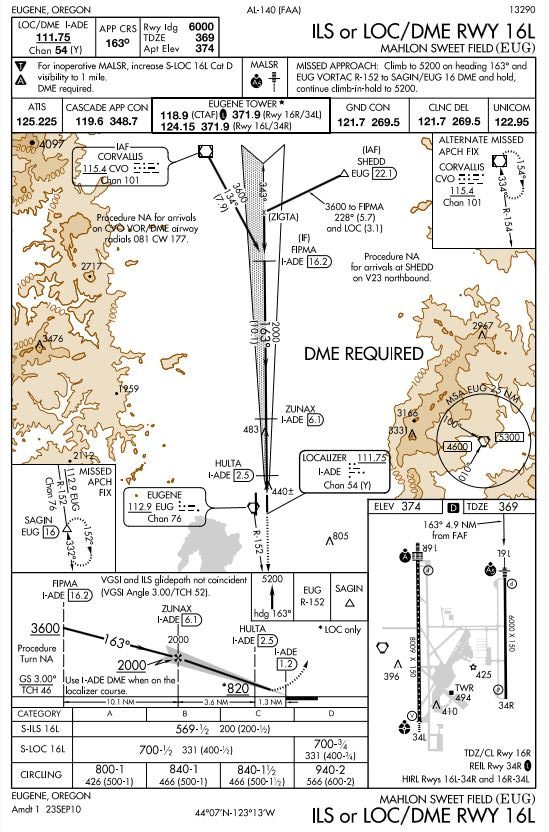
 CorrectIncorrect
CorrectIncorrect -
Question 286 of 805
286. Question
Refer to the diagrams below. With a 15 knot headwind while flying the ILS Rwy 9 at RAL with 90 knots, you expect to set power for a
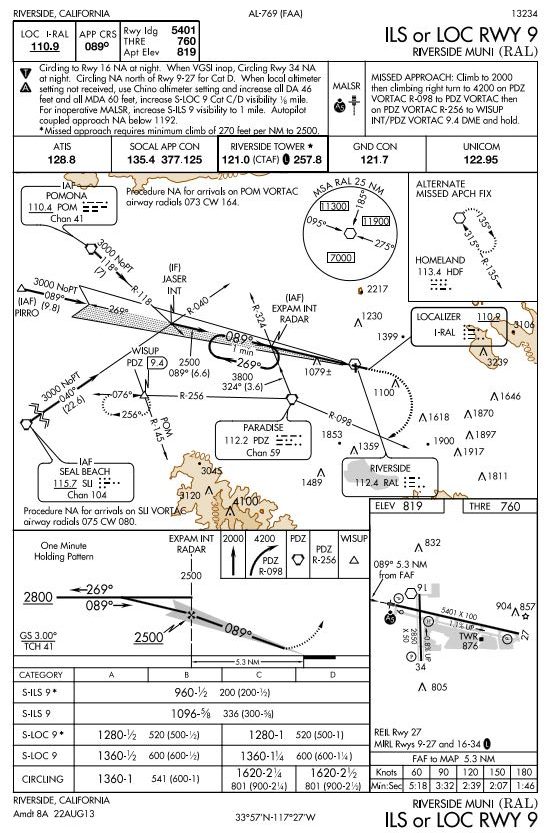
 CorrectIncorrect
CorrectIncorrect -
Question 287 of 805
287. Question
To ensure proper airspace protection while holding at 5,000 feet in a civil aircraft, what is the maximum indicated airspeed a pilot should use?
CorrectIncorrect -
Question 288 of 805
288. Question
Where a holding pattern is specified in lieu of a procedure turn, the holding maneuver must be executed within
CorrectIncorrect -
Question 289 of 805
289. Question
When more than one circuit of the holding pattern is needed to lose altitude or become better established on course, the additional circuits can be
CorrectIncorrect -
Question 290 of 805
290. Question
To ensure proper airspace protection while in a holding pattern above 14,000 feet in a propeller driven airplane, what is the maximum indicated airspeed a pilot should use?
CorrectIncorrect -
Question 291 of 805
291. Question
To ensure proper airspace protection while in a holding pattern above 14,000 feet in a propeller-driven airplane, what is the maximum indicated airspeed a pilot should use?
CorrectIncorrect -
Question 292 of 805
292. Question
The standard IFR climb gradient is
CorrectIncorrect -
Question 293 of 805
293. Question
Refer to the diagram below. You arrive over the 15 DME fix on a heading of 350°. Which holding pattern correctly complies with the ATC clearance below, and what is the recommended entry procedure? "...HOLD WEST OF THE ONE FIVE DME FIX ON THE TWO SIX EIGHT RADIAL OF THE ABC VORTAC, FIVE MILE LEGS, LEFT TURNS..."
 CorrectIncorrect
CorrectIncorrect -
Question 294 of 805
294. Question
How can an initial approach fix be identified on a Standard Instrument Approach Procedure (SIAP) Chart?
CorrectIncorrect -
Question 295 of 805
295. Question
Which fixes on the IAP Charts are initial approach fixes?
CorrectIncorrect -
Question 296 of 805
296. Question
Aircraft approach categories are based on
CorrectIncorrect -
Question 297 of 805
297. Question
How can the pilot determine, for an ILS runway equipped with MALSR, that there may be a penetration of the obstacle identification surfaces (OIS), and care should be taken in the visual segment to avoid any obstacles?
CorrectIncorrect -
Question 298 of 805
298. Question
Refer to the diagram below. What is the elevation of the TDZE for RWY 4?
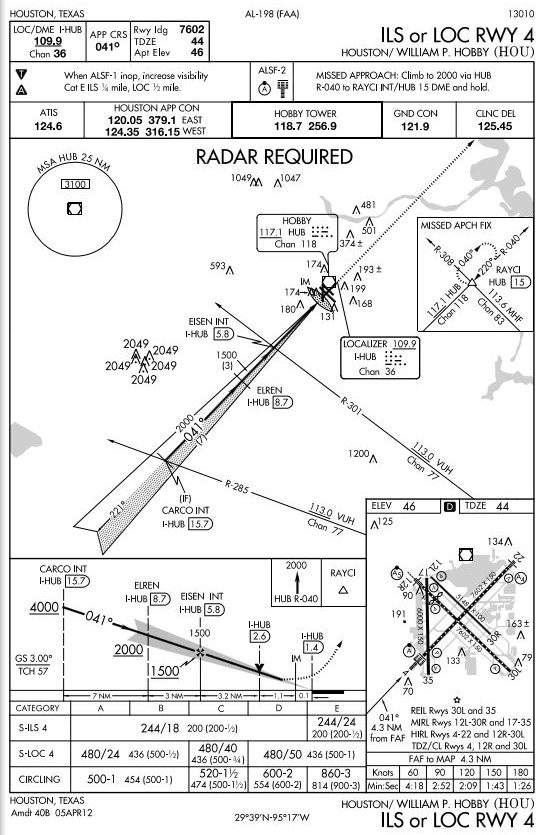 CorrectIncorrect
CorrectIncorrect -
Question 299 of 805
299. Question
Refer to the diagram below. During the ILS RWY 13 procedure at DSM, what altitude minimum applies if the glide slope becomes inoperative?
 CorrectIncorrect
CorrectIncorrect -
Question 300 of 805
300. Question
Refer to the diagram below. The symbol on the plan view of the ILS or LOC RWY 13 procedure at DSM represents a minimum safe sector altitude within 25 NM of
 CorrectIncorrect
CorrectIncorrect -
Question 301 of 805
301. Question
Refer to the diagram below. During the ILS RWY 13 procedures at DSM, the minimum altitude for glide slope interception is
 CorrectIncorrect
CorrectIncorrect -
Question 302 of 805
302. Question
Refer to the diagram below. During the approach to DSM before you can begin the ILS RWY 13 procedure, the glide slope fails and you are cleared for the LOC RWY 13 at DSM. What altitude minimum applies?
 CorrectIncorrect
CorrectIncorrect -
Question 303 of 805
303. Question
Refer to the diagram below. The final approach fix for the ILS RWY 24R is located at
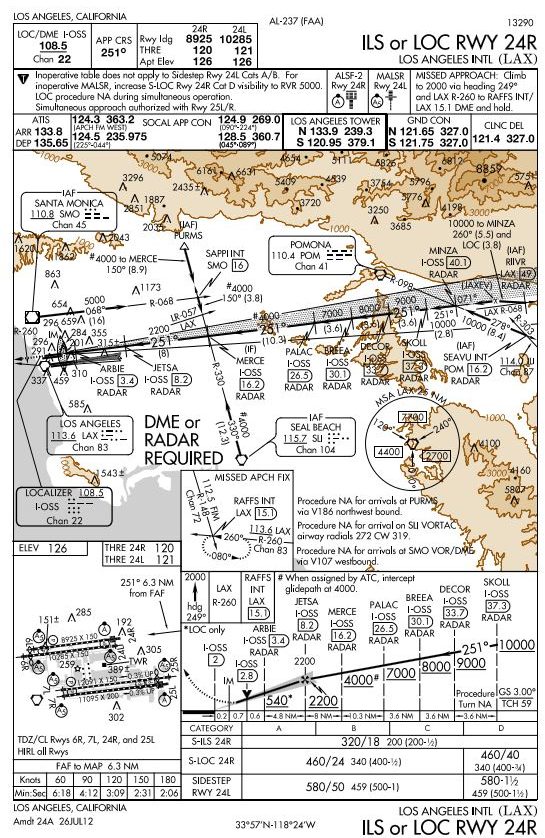 CorrectIncorrect
CorrectIncorrect -
Question 304 of 805
304. Question
Refer to the diagram below. The final approach fix for the precision approach is located at
 CorrectIncorrect
CorrectIncorrect -
Question 305 of 805
305. Question
During an instrument precision approach, terrain and obstacle clearance depends on adherence to
CorrectIncorrect -
Question 306 of 805
306. Question
When making an instrument approach at the selected alternate airport, what landing minimums apply?
CorrectIncorrect -
Question 307 of 805
307. Question
The primary reason single pilot operations in reduced visibility on an instrument approach procedure are made more difficult than multi-crew operations is that the pilot must
CorrectIncorrect -
Question 308 of 805
308. Question
Refer to the diagram below. Refer to the APA (Centennial) ILS RWY 35R procedure. The FAF intercept altitude is
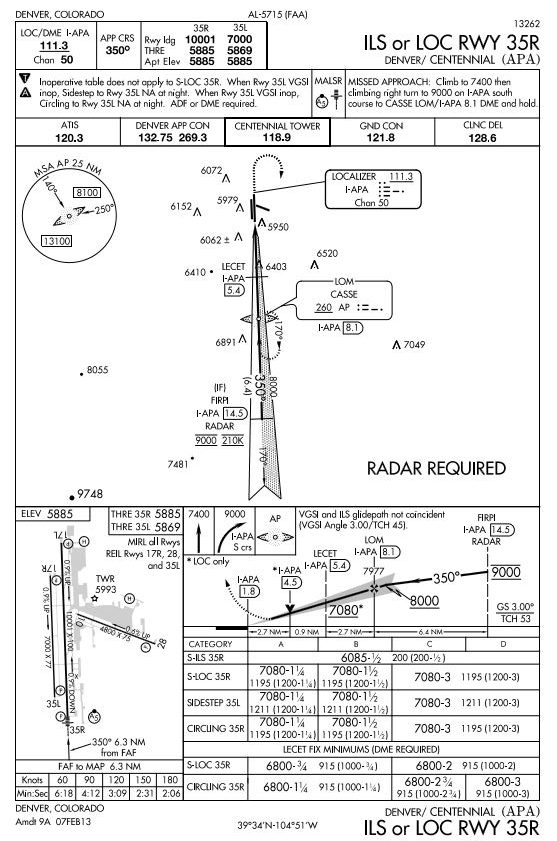 CorrectIncorrect
CorrectIncorrect -
Question 309 of 805
309. Question
Refer to the diagram below. At what minimum altitude should you cross RAMKE intersection during the S-LA RWY 6 approach at ROA?
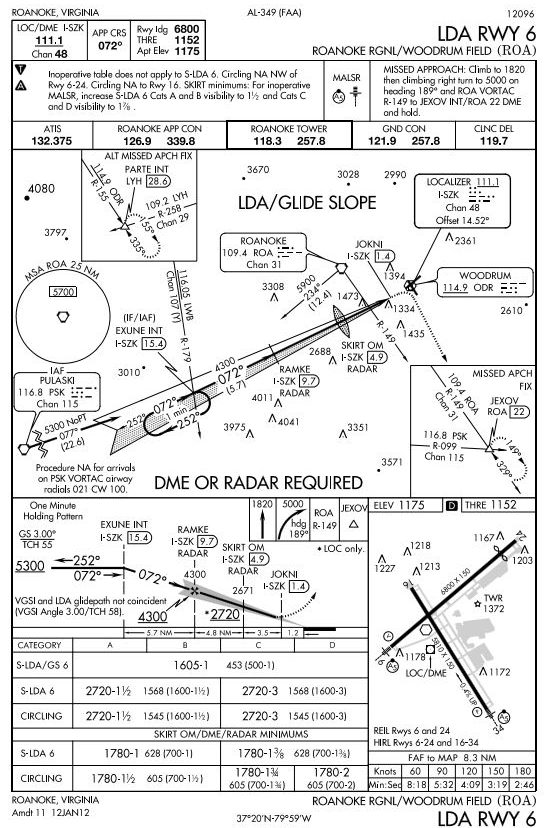 CorrectIncorrect
CorrectIncorrect -
Question 310 of 805
310. Question
Refer to the diagram below. The missed approach point for the LOC RWY 31 procedure is
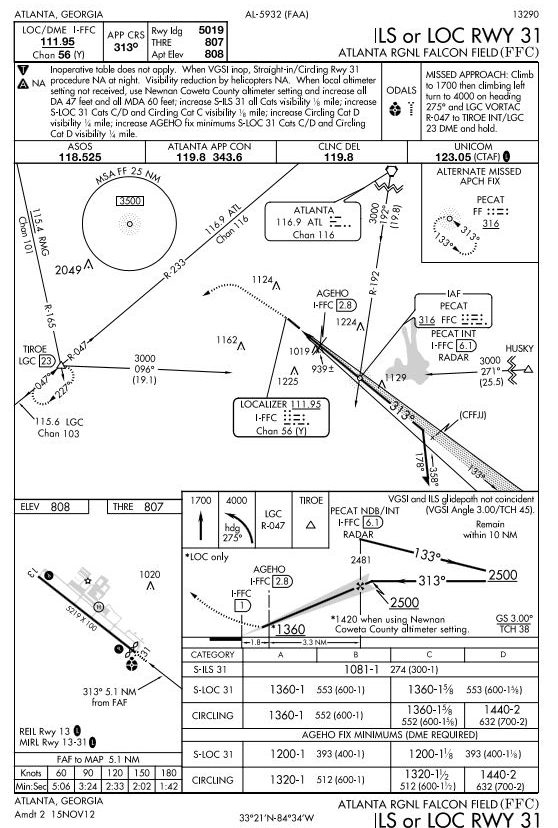 CorrectIncorrect
CorrectIncorrect -
Question 311 of 805
311. Question
When being radar vectored for an ILS approach, at what point may you start a descent from your last assigned altitude to a lower minimum altitude if cleared for the approach?
CorrectIncorrect -
Question 312 of 805
312. Question
What obstacle clearance and navigation signal coverage is a pilot assured with the Minimum Sector Altitudes depicted on the IAP charts?
CorrectIncorrect -
Question 313 of 805
313. Question
Which procedure should be followed by a pilot who is circling to land in a Category B airplane, but is maintaining a speed 5 knots faster than the maximum specified for that category?
CorrectIncorrect -
Question 314 of 805
314. Question
For aircraft other than helicopters, is an alternate airport required for an IFR flight to ATL (Atlanta Hartsfield) if the proposed ETA is 1930Z?
TAF KATL 121720Z 121818 20012KT 5SM HZ BKN030
FM2000 3SM TSRA OVC025CB
FM2200 33015G20KT P6SM BKN015 OVC040
BECMG 0608 02008KT BKN040 BECMG 1012 OOOOOKT
P6SM CLR=
CorrectIncorrect -
Question 315 of 805
315. Question
What are the alternate minimums for an airport with a precision approach procedure?
CorrectIncorrect -
Question 316 of 805
316. Question
When a pilot elects to proceed to the selected alternate airport, which minimums apply for landing at the alternate?
CorrectIncorrect -
Question 317 of 805
317. Question
If a pilot elects to proceed to the selected alternate, the landing minimums used at that airport should be the
CorrectIncorrect -
Question 318 of 805
318. Question
What minimum weather conditions must be forecast for your ETA at an alternate airport, that has only a VOR approach with standard alternate minimums, for the airport to be listed as an alternate on the IFR flight plan?
CorrectIncorrect -
Question 319 of 805
319. Question
Why is hypoxia particularly dangerous during flights with one pilot?
CorrectIncorrect -
Question 320 of 805
320. Question
What action should be taken if hyperventilation is suspected?
CorrectIncorrect -
Question 321 of 805
321. Question
If you experience tunnel vision and cyanosis, you may have symptoms of
CorrectIncorrect -
Question 322 of 805
322. Question
Which is not a type of hypoxia?
CorrectIncorrect -
Question 323 of 805
323. Question
Which of the following is a correct response to counteract the feelings of hypoxia in flight?
CorrectIncorrect -
Question 324 of 805
324. Question
Carbon monoxide poisoning, common in flying as a result of an exhaust leak, is considered what type of hypoxia?
CorrectIncorrect -
Question 325 of 805
325. Question
Hyperventilation occurs when
CorrectIncorrect -
Question 326 of 805
326. Question
A corrective action to overcome symptoms of hyperventilation is to
CorrectIncorrect -
Question 327 of 805
327. Question
The sensations which lead to spatial disorientation during instrument flight conditions
CorrectIncorrect -
Question 328 of 805
328. Question
Which system is most likely responsible for a pilot suffering spatial disorientation?
CorrectIncorrect -
Question 329 of 805
329. Question
A pilot is more subject to spatial disorientation if
CorrectIncorrect -
Question 330 of 805
330. Question
Which procedure is recommended to prevent or overcome spatial disorientation?
CorrectIncorrect -
Question 331 of 805
331. Question
How can an instrument pilot best overcome spatial disorientation?
CorrectIncorrect -
Question 332 of 805
332. Question
How can an instrument pilot best overcome spatial disorientation?
CorrectIncorrect -
Question 333 of 805
333. Question
Abrupt head movement during a prolonged constant rate turn in IMC or simulated instrument conditions can cause
CorrectIncorrect -
Question 334 of 805
334. Question
A rapid acceleration during takeoff can create the illusion of
CorrectIncorrect -
Question 335 of 805
335. Question
An abrupt change from climb to straight-and-level flight can create the illusion of
CorrectIncorrect -
Question 336 of 805
336. Question
A sloping cloud formation, an obscured horizon, and a dark scene spread with ground lights and stars can create an illusion known as
CorrectIncorrect -
Question 337 of 805
337. Question
Abrupt head movement during a prolonged constant rate turn in IMC or simulated instrument conditions can cause
CorrectIncorrect -
Question 338 of 805
338. Question
The sensory system responsible for most of the illusions leading to spatial disorientation is the
CorrectIncorrect -
Question 339 of 805
339. Question
Without visual aid, a pilot often interprets centrifugal force as a sensation of
CorrectIncorrect -
Question 340 of 805
340. Question
Pilots should take care when retrieving charts or dropped objects in the cockpit to avoid
CorrectIncorrect -
Question 341 of 805
341. Question
While making prolonged constant-rate turns under IFR conditions, an abrupt head movement can create the illusion of rotation on an entirely different axis. This is known as
CorrectIncorrect -
Question 342 of 805
342. Question
To preserve night vision, the most appropriate cockpit lighting is
CorrectIncorrect -
Question 343 of 805
343. Question
What effect does haze have on the ability to see traffic or terrain features during flight?
CorrectIncorrect -
Question 344 of 805
344. Question
Which statement is correct regarding the use of cockpit lighting for night flight?
CorrectIncorrect -
Question 345 of 805
345. Question
Which technique should a pilot use to scan for traffic to the right and left during straight-and-level flight?
CorrectIncorrect -
Question 346 of 805
346. Question
Due to visual illusion, when landing on a narrower-than-usual runway, the aircraft will appear to be
CorrectIncorrect -
Question 347 of 805
347. Question
What visual illusion creates the same effect as a narrower-than-usual runway?
CorrectIncorrect -
Question 348 of 805
348. Question
Why is fatigue hazardous to flight safety?
CorrectIncorrect -
Question 349 of 805
349. Question
For aircraft other than helicopters, what minimum weather conditions must be forecast for your ETA at an alternate airport that has a precision approach procedure, with standard alternate minimums, in order to list it as an alternate for the IFR flight?
CorrectIncorrect -
Question 350 of 805
350. Question
For an airplane, determine the weather minimum conditions required at the destination airport to avoid listing an alternate on your IFR flight plan.
CorrectIncorrect -
Question 351 of 805
351. Question
What are the minimum weather conditions that must be forecast to list an airport as an alternate when the airport has no approved IAP?
CorrectIncorrect -
Question 352 of 805
352. Question
What standard minimums are required to list an airport as an alternate on an IFR flight plan if the airport has VOR approach only?
CorrectIncorrect -
Question 353 of 805
353. Question
An airport without an authorized IAP may be included on an IFT flight plan as an alternate, if the current weather forecast indicates that the ceiling and visibility at the ETA will
CorrectIncorrect -
Question 354 of 805
354. Question
When an alternate airport is required, what are the weather minimums that must be forecast at the ETA for an alternate airport that has a precision approach procedure?
CorrectIncorrect -
Question 355 of 805
355. Question
What is the maximum tolerance allowed for an operational VOR equipment check when using a VOT?
CorrectIncorrect -
Question 356 of 805
356. Question
What record shall be made in the aircraft log or other permanent record by the pilot making the VOR operational check?
CorrectIncorrect -
Question 357 of 805
357. Question
When must an operational check on the aircraft VOR equipment be accomplished when used to operate under IFR?
CorrectIncorrect -
Question 358 of 805
358. Question
Which data must be recorded in the aircraft log or other appropriate log by a pilot making a VOR operational check for IFR operations?
CorrectIncorrect -
Question 359 of 805
359. Question
Which checks and inspections of flight instruments or instrument systems must be accomplished before an aircraft can be flown under IFR?
CorrectIncorrect -
Question 360 of 805
360. Question
When departing from an airport located outside controlled airspace during IMC, you must file an IFR flight plan and receive a clearance before
CorrectIncorrect -
Question 361 of 805
361. Question
To operate an aircraft under IFR, a flight plan must have been filed and an ATC clearance received prior to
CorrectIncorrect -
Question 362 of 805
362. Question
To operate under IFR below 18,000 feet, a pilot must file an IFR flight plan and receive an appropriate ATC clearance prior to
CorrectIncorrect -
Question 363 of 805
363. Question
Prior to which operation must an IFR flight plan be filed and an appropriate ATC clearance received?
CorrectIncorrect -
Question 364 of 805
364. Question
No person may operate an aircraft in controlled airspace under IFR unless he or she files a flight plan
CorrectIncorrect -
Question 365 of 805
365. Question
Except when necessary for takeoff or landing or unless otherwise authorized by the Administrator, the minimum altitude for IFR flight is
CorrectIncorrect -
Question 366 of 805
366. Question
Unless otherwise prescribed, what is the rule regarding altitude and course to be maintained during an IFR off airways flight over mountainous terrain?
CorrectIncorrect -
Question 367 of 805
367. Question
What minimum navigation equipment is required for IFR flight?
CorrectIncorrect -
Question 368 of 805
368. Question
An aircraft operated during IFR under 14 CFR Part 91 is required to have which of the following?
CorrectIncorrect -
Question 369 of 805
369. Question
Aircraft being operated under IFR are required to have, in addition to the equipment required for VFR and night, at least
CorrectIncorrect -
Question 370 of 805
370. Question
Where is DME required under IFR?
CorrectIncorrect -
Question 371 of 805
371. Question
To meet the requirements for flight under IFR, an aircraft must be equipped with certain operable instruments and equipment. One of those required is
CorrectIncorrect -
Question 372 of 805
372. Question
What is the oxygen requirement for an unpressurized aircraft at 15,000 feet?
CorrectIncorrect -
Question 373 of 805
373. Question
What is the maximum IFR altitude you may fly in an unpressurized aircraft without providing passengers with supplemental oxygen?
CorrectIncorrect -
Question 374 of 805
374. Question
What is the maximum cabin pressure altitude at which a pilot can fly for longer than 30 minutes without using supplemental oxygen?
CorrectIncorrect -
Question 375 of 805
375. Question
If an unpressurized aircraft is operated above 1 2, 500 feet MSL, but not more than 14,000 feet MSL, for a period of 2 hours 20 minutes, how long during that time is the minimum flightcrew required to use supplemental oxygen?
CorrectIncorrect -
Question 376 of 805
376. Question
In the 48 contiguous states, excluding the airspace at or below 2,500 feet AGL, an operable coded transponder equipped with Mode C capability is required in all controlled airspace at and above
CorrectIncorrect -
Question 377 of 805
377. Question
A coded transponder equipped with altitude reporting capability is required in all controlled airspace
CorrectIncorrect -
Question 378 of 805
378. Question
Prior to operating an aircraft not equipped with a transponder in Class B airspace, a request for a deviation must be submitted to the
CorrectIncorrect -
Question 379 of 805
379. Question
When an aircraft is not equipped with a transponder, what requirement must be met before ATC will authorize a flight within Class B airspace?
CorrectIncorrect -
Question 380 of 805
380. Question
If the aircraft's transponder fails during flight within Class B airspace,
CorrectIncorrect -
Question 381 of 805
381. Question
Your aircraft had the static pressure system and altimeter tested and inspected on January 5, of this year, and was found to comply with FAA standards. These systems must be reinspected and approved for use in controlled airspace under IFR by
CorrectIncorrect -
Question 382 of 805
382. Question
An aircraft altimeter system test and inspection must be accomplished within
CorrectIncorrect -
Question 383 of 805
383. Question
An aircraft altimeter system test and inspection are required to be accomplished within
CorrectIncorrect -
Question 384 of 805
384. Question
Which publication covers the procedures required for aircraft accident and incident reporting responsibilities for pilots?
CorrectIncorrect -
Question 385 of 805
385. Question
The primary reason single pilot operations in reduced visibility on an instrument approach procedure are made more difficult than multicrew operations is that the pilot must
CorrectIncorrect -
Question 386 of 805
386. Question
When simultaneous approaches are in progress, how does each pilot receive radar advisories?
CorrectIncorrect -
Question 387 of 805
387. Question
When may a pilot make a straight-in landing, if using an IAP having only circling minimums?
CorrectIncorrect -
Question 388 of 805
388. Question
Refer to the diagram below. What minimum navigation equipment is required to complete the VOR/DME-A procedure?
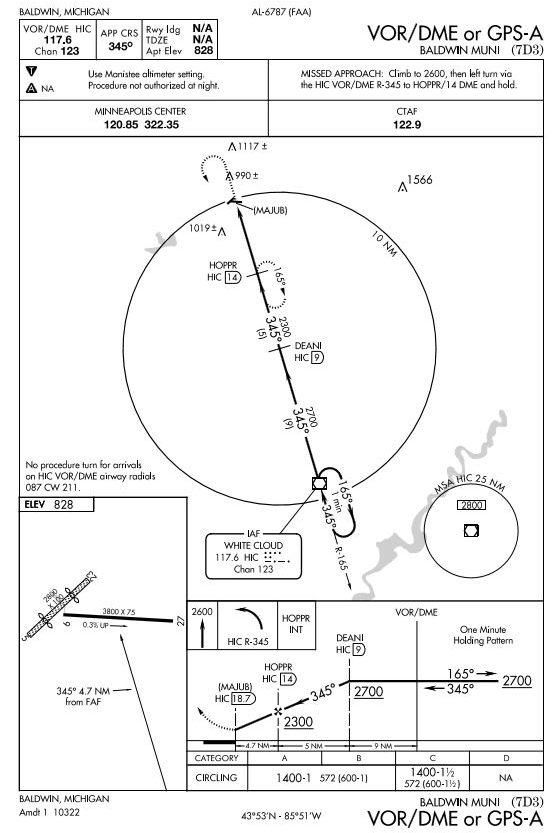 CorrectIncorrect
CorrectIncorrect -
Question 389 of 805
389. Question
Refer to the diagram below. The minimum safe altitude (MSA) for the VOR/DME or GPS-A at 7D3 is geographically centered on what position?
 CorrectIncorrect
CorrectIncorrect -
Question 390 of 805
390. Question
Refer to the diagrams below. You plan to fly to Baldwin for Christmas. What minimum equipment is required for the VOR/ DME or GPS-A procedure, and can you complete the flight?

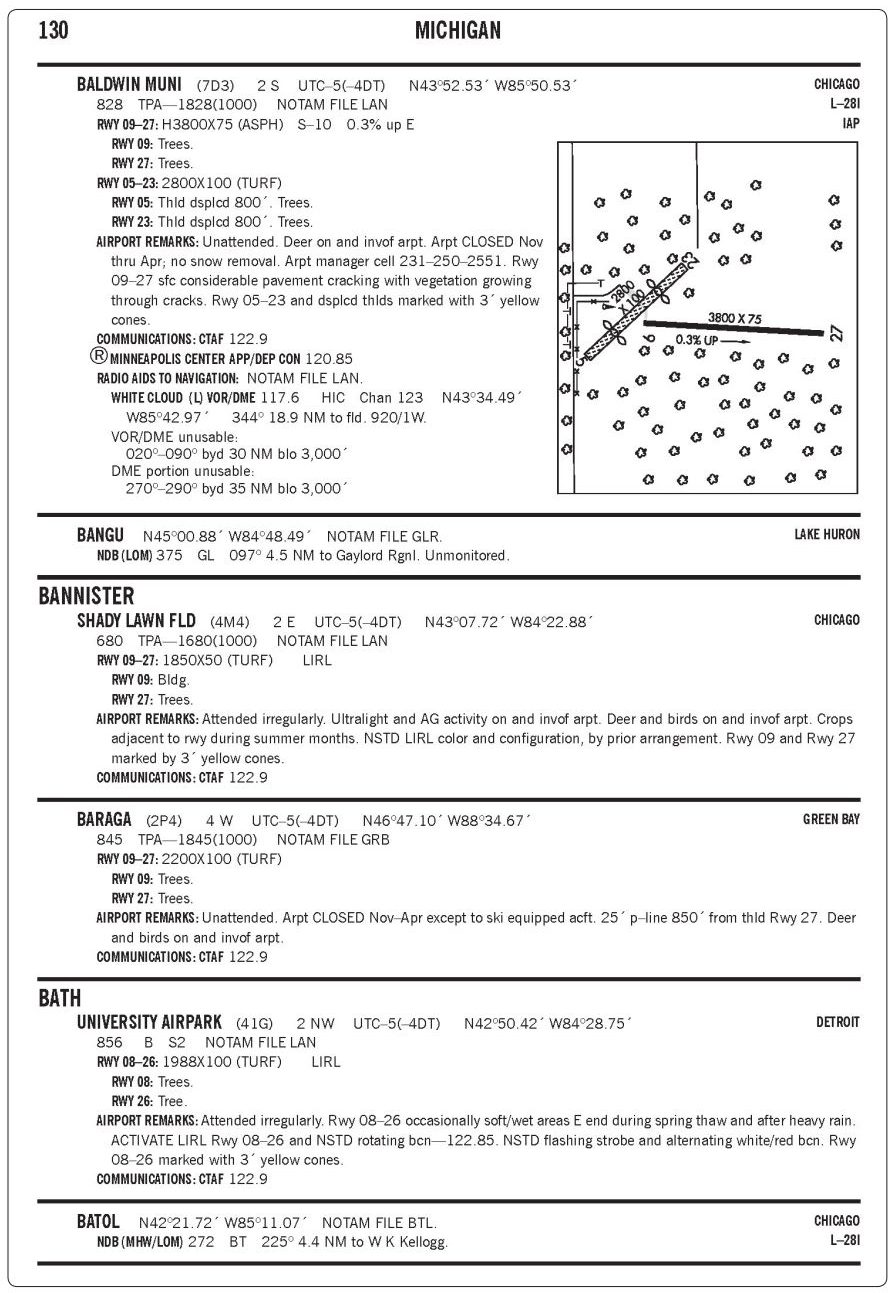 CorrectIncorrect
CorrectIncorrect -
Question 391 of 805
391. Question
An airport may not be qualified for alternate use if
CorrectIncorrect -
Question 392 of 805
392. Question
During an instrument approach, under what conditions, if any, is the holding pattern course reversal not required?
CorrectIncorrect -
Question 393 of 805
393. Question
Refer to the diagram below. What options are available concerning the teardrop course reversal for LOC RWY 18 approach to Lincoln?
 CorrectIncorrect
CorrectIncorrect -
Question 394 of 805
394. Question
Refer to the diagram below. If your aircraft was cleared for the ILS RWY 18 at Lincoln Municipal and crossed the Lincoln VORTAC at 5,000 feet MSL, at what point in the teardrop could a descent to 3,200 feet commence?
 CorrectIncorrect
CorrectIncorrect -
Question 395 of 805
395. Question
Refer to the diagram below. If cleared for an S-LOC 18 approach at Lincoln Municipal from over HUSKR, it means the flight should
 CorrectIncorrect
CorrectIncorrect -
Question 396 of 805
396. Question
On a nonprecision approach, what is the maximum acceptable descent rate during the final stages of the approach (below 1,000 ft. AGL)?
CorrectIncorrect -
Question 397 of 805
397. Question
Under the stabilized approach concept, what is the maximum acceptable descent rate during the final stages of an approach?
CorrectIncorrect -
Question 398 of 805
398. Question
When the approach procedure involves a procedure turn, the maximum speed should not be greater than
CorrectIncorrect -
Question 399 of 805
399. Question
Refer to the diagram below. What landing minimums apply for a 14 CFR Part 91 operator at Dothan, AL using a category C aircraft during a circling LOC 32 approach at 120 knots? (Dual VORs available.)
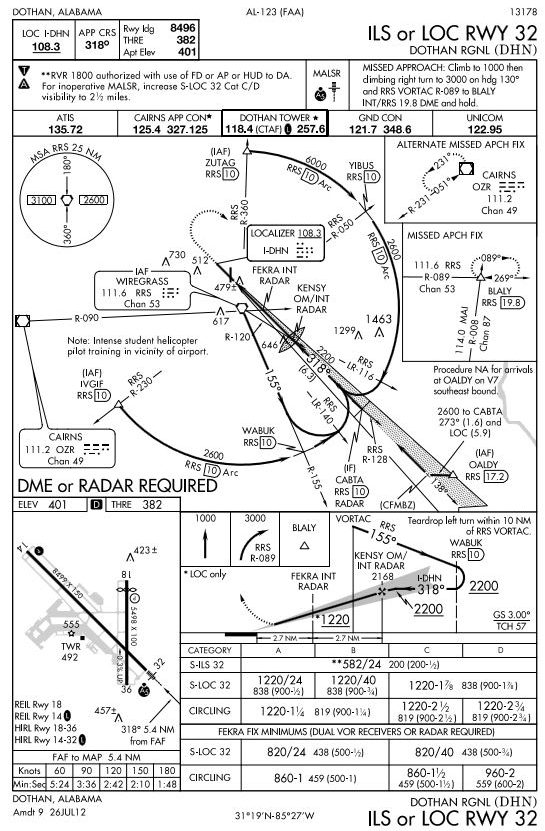 CorrectIncorrect
CorrectIncorrect -
Question 400 of 805
400. Question
Refer to the diagram below. If cleared for a straight-in LOC approach from over OALDY, it means the flight should
 CorrectIncorrect
CorrectIncorrect -
Question 401 of 805
401. Question
Refer to the diagram below. What indication should you get when it is time to turn in bound while in the procedure turn at FEHXE?
 CorrectIncorrect
CorrectIncorrect -
Question 402 of 805
402. Question
Refer to the diagram below. What is the recommended descent angle for the RNAV (GPS) RWY 36 approach?
 CorrectIncorrect
CorrectIncorrect -
Question 403 of 805
403. Question
Refer to the diagram below. How should the missed approach point be identified when executing the RNAV (GPS) RWY 36 approach at Adams Field?
 CorrectIncorrect
CorrectIncorrect -
Question 404 of 805
404. Question
Refer to the diagram below. What minimum airborne equipment is required to be operative for RNAV (GPS) RWY 36 approach at Adams Field?
 CorrectIncorrect
CorrectIncorrect -
Question 405 of 805
405. Question
Refer to the diagram below. What type of entry is recommended to the missed approach holding pattern if the inbound heading is 050°?
 CorrectIncorrect
CorrectIncorrect -
Question 406 of 805
406. Question
Refer to the diagrams below. You have been cleared for the RNAV (GPS) RWY 36 approach to LIT. At a groundspeed of 105 knots. What are the vertical descent angle and rate of descent on final approach?

 CorrectIncorrect
CorrectIncorrect -
Question 407 of 805
407. Question
Refer to the diagram below. What type entry is recommended for the missed approach holding pattern depicted on the VOR/DME RWY 36 approach chart for Price/Carbon County Airport?
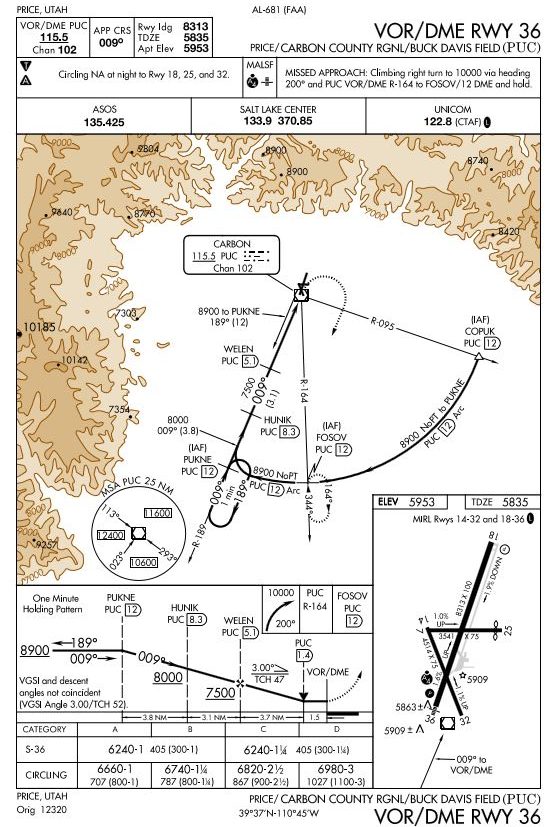 CorrectIncorrect
CorrectIncorrect -
Question 408 of 805
408. Question
Refer to the diagram below. At which points may you initiate a descent to the next lower minimum altitude when cleared for the VOR/DME RWY 36 approach, from the PUC R-095 IAF (DME operative)?
 CorrectIncorrect
CorrectIncorrect -
Question 409 of 805
409. Question
Refer to the diagram below. What is the purpose of the 10,600 MSA on the Price/Carbon County Airport Approach Chart?
 CorrectIncorrect
CorrectIncorrect -
Question 410 of 805
410. Question
Refer to the diagram below. If the DME at PUC airport is inoperative, the airborne DME will
 CorrectIncorrect
CorrectIncorrect -
Question 411 of 805
411. Question
What does the symbol T within a black triangle in the minimums section of the IAP for a particular airport indicate?
CorrectIncorrect -
Question 412 of 805
412. Question
While being radar vectored, an approach clearance is received. The last assigned altitude should be maintained until
CorrectIncorrect -
Question 413 of 805
413. Question
If the plan view on an approach chart does not include a procedure turn barb, that means
CorrectIncorrect -
Question 414 of 805
414. Question
Refer to the diagram below. How should a pilot reverse course to get established on the in bound course of the ILS RWY 9, if radar vectoring to EXPAM?
 CorrectIncorrect
CorrectIncorrect -
Question 415 of 805
415. Question
Refer to the diagram below. What is the minimum altitude descent procedure if cleared for the S ILS 9 approach from Seal Beach VORTAC?
 CorrectIncorrect
CorrectIncorrect -
Question 416 of 805
416. Question
Refer to the diagrams below. At which point does the JEN.JEN9 arrival begin?
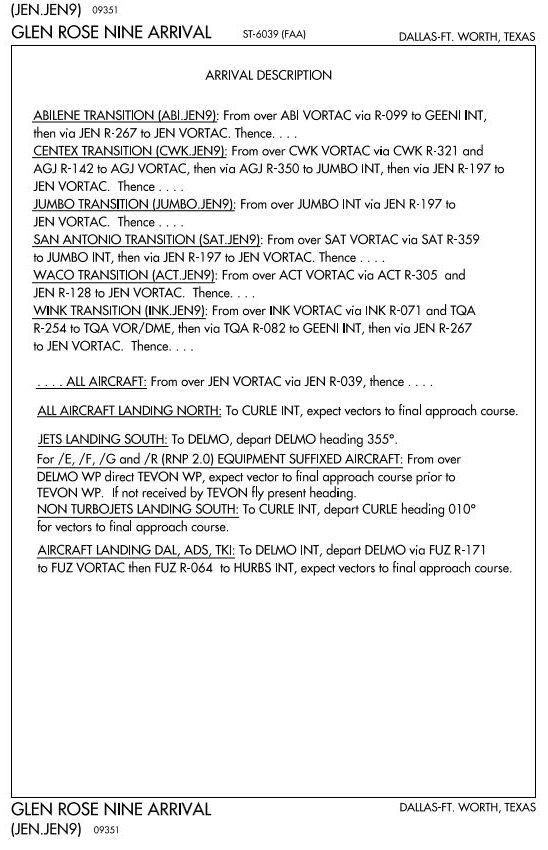
 CorrectIncorrect
CorrectIncorrect -
Question 417 of 805
417. Question
Refer to the diagrams below. At which location or condition does the STELA.STELA1 arrival begin?

 CorrectIncorrect
CorrectIncorrect -
Question 418 of 805
418. Question
Preferred IFR routes beginning with a fix, indicate that departing aircraft will normally be routed to the fix by
CorrectIncorrect -
Question 419 of 805
419. Question
Which procedure applies to instrument departure procedures?
CorrectIncorrect -
Question 420 of 805
420. Question
Which is true regarding the use of an instrument departure procedure chart?
CorrectIncorrect -
Question 421 of 805
421. Question
Which is true regarding STARs?
CorrectIncorrect -
Question 422 of 805
422. Question
Refer to the diagram below. For takeoff on RWY 9 using an average groundspeed of 140 knots, what minimum rate of climb would meet the required minimum rate of climb as specified on the instrument departure procedure?
 CorrectIncorrect
CorrectIncorrect -
Question 423 of 805
423. Question
Which clearance procedures may be issued by ATC without prior pilot request?
CorrectIncorrect -
Question 424 of 805
424. Question
ATC can issue a STAR
CorrectIncorrect -
Question 425 of 805
425. Question
Which of the following statements regarding STARs is most accurate?
CorrectIncorrect -
Question 426 of 805
426. Question
What action is recommended if a pilot does not wish to use an instrument departure procedure?
CorrectIncorrect -
Question 427 of 805
427. Question
A particular instrument departure procedure requires a minimum climb rate of 210 feet per NM to 8,000 feet. If you climb with a ground speed of 140 knots, what is the rate of climb required in feet per minute?
CorrectIncorrect -
Question 428 of 805
428. Question
On a GPS with WAAS capability, what is the significance of "LNAV+V" being displayed?
CorrectIncorrect -
Question 429 of 805
429. Question
When flying a GPS approach procedure, what effect will overriding an automatically selected sensitivity have?
CorrectIncorrect -
Question 430 of 805
430. Question
When proper RAIM sensitivity is not available, manually resetting sensitivity to 0.3 NM will
CorrectIncorrect -
Question 431 of 805
431. Question
Refer to the diagram below. If cleared for the RNAV (GPS) RWY 28 approach (Lancaster/Fairfield) over APE VORTAC, what will ATC expect of you?
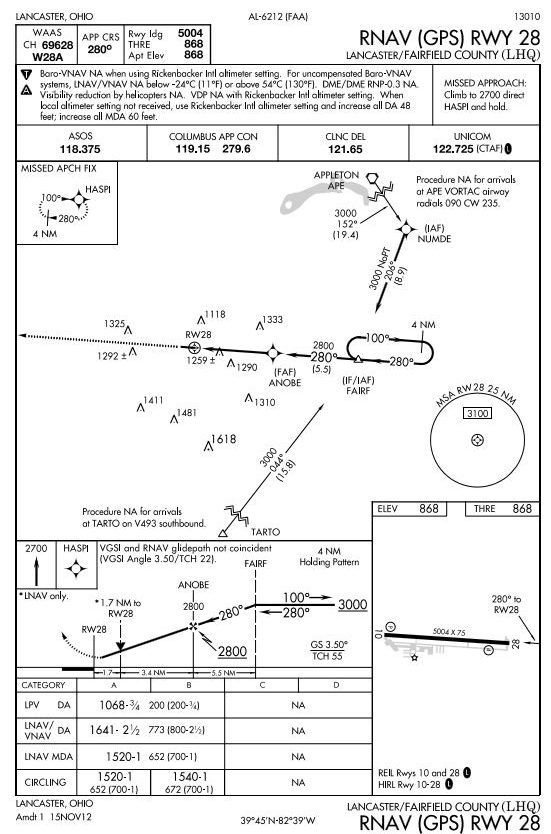 CorrectIncorrect
CorrectIncorrect -
Question 432 of 805
432. Question
If Receiver Autonomous Integrity Monitoring (RAIM} is not available prior to beginning a GPS approach, the pilot should
CorrectIncorrect -
Question 433 of 805
433. Question
Refer to the diagram below. When flying the LNAV approach, the missed approach point (MAP) would be indicated by reaching
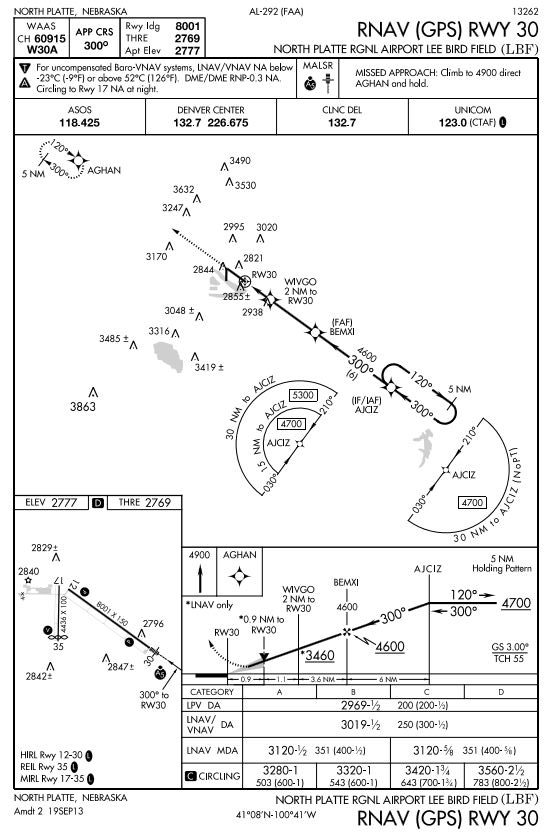 CorrectIncorrect
CorrectIncorrect -
Question 434 of 805
434. Question
Refer to the diagram below. Which of the following best described BEMXI?
 CorrectIncorrect
CorrectIncorrect -
Question 435 of 805
435. Question
Refer to the diagram below. How do you recognize the missed approach point on the LNAV VNAV approach?
 CorrectIncorrect
CorrectIncorrect -
Question 436 of 805
436. Question
Which of the following is true concerning GPS approaches?
CorrectIncorrect -
Question 437 of 805
437. Question
Refer to the diagram below. The correct GPS entry when told by ATC to "expect the GPS approach to runway 30" is
 CorrectIncorrect
CorrectIncorrect -
Question 438 of 805
438. Question
Refer to the diagram below. Which type of waypoint is the AGHAN fix?
 CorrectIncorrect
CorrectIncorrect -
Question 439 of 805
439. Question
Refer to the diagram below. You are flying the RNAV(GPS} RWY 30 approach to LBF, over BEMXI, and you receive a RAIM error. You should
 CorrectIncorrect
CorrectIncorrect -
Question 440 of 805
440. Question
Refer to the diagram below. At what point is the pilot authorized to descend below 5,300 feet when cleared to the AJCIZ waypoint from the west?
 CorrectIncorrect
CorrectIncorrect -
Question 441 of 805
441. Question
During a WMS GPS approach, you receive an LNAV+V annunciation on the GPS display. You should
CorrectIncorrect -
Question 442 of 805
442. Question
When using GPS for navigation and instrument approaches, any required alternate airport must have
CorrectIncorrect -
Question 443 of 805
443. Question
The primary cause of all changes in the Earth's weather is
CorrectIncorrect -
Question 444 of 805
444. Question
Which force, in the Northern Hemisphere, acts at a right angle to the wind and deflects it to the right until parallel to the isobars?
CorrectIncorrect -
Question 445 of 805
445. Question
What relationship exists between the winds at 2,000 feet above the surface and the surface winds?
CorrectIncorrect -
Question 446 of 805
446. Question
Winds at 5,000 feet AGL on a particular flight are southwesterly while most of the surface winds are southerly. This difference in direction is primarily due to
CorrectIncorrect -
Question 447 of 805
447. Question
What causes surface winds to flow across the isobars at an angle rather than parallel to the isobars?
CorrectIncorrect -
Question 448 of 805
448. Question
An air mass is a body of air that
CorrectIncorrect -
Question 449 of 805
449. Question
A characteristic of the stratosphere is
CorrectIncorrect -
Question 450 of 805
450. Question
A jet stream is defined as wind of
CorrectIncorrect -
Question 451 of 805
451. Question
The average height of the troposphere in the middle latitudes is
CorrectIncorrect -
Question 452 of 805
452. Question
The strength and location of the jet stream is normally
CorrectIncorrect -
Question 453 of 805
453. Question
Which feature is associated with the tropopause?
CorrectIncorrect -
Question 454 of 805
454. Question
What is the definition of MEA?
CorrectIncorrect -
Question 455 of 805
455. Question
The lowest published altitude which meets obstacle clearance requirements and assures acceptable navigational signal coverage is the
CorrectIncorrect -
Question 456 of 805
456. Question
Reception of signals from an off-airway radio facility may be inadequate to identify the fix at the designated MEA. In this case, which altitude is designated for the fix?
CorrectIncorrect -
Question 457 of 805
457. Question
Reception of signals from a radio facility, located off the airway being flown, may be inadequate at the designated MEA to identify the fix. In this case, which altitude is designated for the fix?
CorrectIncorrect -
Question 458 of 805
458. Question
ATC may assign the MOCA when certain special conditions exist, and when within
CorrectIncorrect -
Question 459 of 805
459. Question
Acceptable navigational signal coverage at the MOCA is assured for a distance from the VOR of only
CorrectIncorrect -
Question 460 of 805
460. Question
Military training routes (MTR) above 1,500 feet are depicted on
CorrectIncorrect -
Question 461 of 805
461. Question
The altitude that provides acceptable navigational signal coverage for the route, and meets obstacle clearance requirements is the minimum:
CorrectIncorrect -
Question 462 of 805
462. Question
Which condition is guaranteed for all of the following altitude limits: MAA, MCA, MRA, MOCA, and MEA? (Non-mountainous area.)
CorrectIncorrect -
Question 463 of 805
463. Question
If no MCA is specified, what is the lowest altitude for crossing a radio fix, beyond which a higher minimum applies?
CorrectIncorrect -
Question 464 of 805
464. Question
In the case of operations over an area designated as a mountainous area, no person may operate an aircraft under IFR below 2,000 feet above the highest obstacle within a horizontal distance of
CorrectIncorrect -
Question 465 of 805
465. Question
In the case of operations over an area designated as a mountainous area where no other minimum altitude is prescribed, no person may operate an aircraft under IFR below an altitude of
CorrectIncorrect -
Question 466 of 805
466. Question
MEA is an altitude that assures
CorrectIncorrect -
Question 467 of 805
467. Question
Unless otherwise specified on the chart, the minimum en route altitude along a jet route is
CorrectIncorrect -
Question 468 of 805
468. Question
Under which of the following circumstances will ATC issue a VFR restriction to an IFR flight?
CorrectIncorrect -
Question 469 of 805
469. Question
What altitude may a pilot on an IFR flight plan select upon receiving a VFR-on-Top clearance?
CorrectIncorrect -
Question 470 of 805
470. Question
Which rules apply to the pilot in command when operating on a VFR-on-Top clearance?
CorrectIncorrect -
Question 471 of 805
471. Question
Which ATC clearance should instrument-rated pilots request in order to climb through a cloud layer or an area of reduced visibility and then continue the flight VFR?
CorrectIncorrect -
Question 472 of 805
472. Question
When can a VFR-on-Top clearance be assigned by ATC?
CorrectIncorrect -
Question 473 of 805
473. Question
When must a pilot fly at a cardinal altitude plus 500 feet on an IFR flight plan?
CorrectIncorrect -
Question 474 of 805
474. Question
Where are VFR-on-Top operations prohibited?
CorrectIncorrect -
Question 475 of 805
475. Question
What minimums must be considered in selecting an altitude when operating with a VFR-on-Top clearance?
CorrectIncorrect -
Question 476 of 805
476. Question
When operating under IFR with a VFR-On-Top clearance, what altitude should be maintained?
CorrectIncorrect -
Question 477 of 805
477. Question
In which airspace is VFR-on-Top operation prohibited?
CorrectIncorrect -
Question 478 of 805
478. Question
What reports are required of a flight operating on an IFR clearance specifying VFR on Top in a nonradar environment?
CorrectIncorrect -
Question 479 of 805
479. Question
When on a VFR-on-Top clearance, the cruising altitude is based on
CorrectIncorrect -
Question 480 of 805
480. Question
You have filed an IFR flight plan with a VFR on-Top clearance in lieu of an assigned altitude. If you receive this clearance and fly a course of
180°, at what altitude should you fly? (Assume VFR
conditions.)CorrectIncorrect -
Question 481 of 805
481. Question
What cruising altitude is appropriate for VFR on Top on a westbound flight below 18,000 feet?
CorrectIncorrect -
Question 482 of 805
482. Question
If, while in Class E airspace, a clearance is received to "maintain VFR conditions on top," the pilot should maintain a VFR cruising altitude based on the direction of the
CorrectIncorrect -
Question 483 of 805
483. Question
You are flying on an IFR flight plan at 5,500 feet with a VFR-on-top clearance when you encounter icing. You know there is clear air above and you request 9,500 feet from ATC. They deny the request, but give you 7,500 feet. Are you still VFR-on-top?
CorrectIncorrect -
Question 484 of 805
484. Question
You encounter structural icing on an IFR flight plan at 7,000 feet. Your request for 9,000 feet is rejected by ATC. You request VFR-on-top at 7,500 feet, which is granted. What must you do with your IFR flight plan?
CorrectIncorrect -
Question 485 of 805
485. Question
ATC has approved your request for VFR-on-top while on an IFR clearance. Therefore, you
CorrectIncorrect -
Question 486 of 805
486. Question
Which weather phenomenon is always associated with the passage of a frontal system?
CorrectIncorrect -
Question 487 of 805
487. Question
Which is a characteristic of low-level wind shear as it relates to frontal activity?
CorrectIncorrect -
Question 488 of 805
488. Question
Frontal waves normally form on
CorrectIncorrect -
Question 489 of 805
489. Question
Where do squall lines most often develop?
CorrectIncorrect -
Question 490 of 805
490. Question
When compared to winds at the surface, winds at 2,000 feet are
CorrectIncorrect -
Question 491 of 805
491. Question
Which are characteristics of an unstable cold air mass moving over a warm surface?
CorrectIncorrect -
Question 492 of 805
492. Question
What are the characteristics of stable air?
CorrectIncorrect -
Question 493 of 805
493. Question
What type clouds can be expected when an unstable air mass is forced to ascend a mountain slope?
CorrectIncorrect -
Question 494 of 805
494. Question
Which is a characteristic of stable air?
CorrectIncorrect -
Question 495 of 805
495. Question
The general characteristics of unstable air are
CorrectIncorrect -
Question 496 of 805
496. Question
What type of clouds will be formed if very stable moist air is forced up slope?
CorrectIncorrect -
Question 497 of 805
497. Question
Steady precipitation, in contrast to showers, preceding a front is an indication of
CorrectIncorrect -
Question 498 of 805
498. Question
What enhances the growth rate of precipitation?
CorrectIncorrect -
Question 499 of 805
499. Question
Which of the following combinations of weather producing variables would likely result in cumuliform-type clouds, good visibility, rain showers, and possible clear-type icing in clouds?
CorrectIncorrect -
Question 500 of 805
500. Question
What determines the structure or type of clouds which form as a result of air being forced to ascend?
CorrectIncorrect -
Question 501 of 805
501. Question
Stability can be determined from which measurement of the atmosphere?
CorrectIncorrect -
Question 502 of 805
502. Question
What are some characteristics of unstable air?
CorrectIncorrect -
Question 503 of 805
503. Question
Unsaturated air flowing up slope will cool at the rate of approximately (dry adiabatic lapse rate)
CorrectIncorrect -
Question 504 of 805
504. Question
What feature is associated with a temperature inversion?
CorrectIncorrect -
Question 505 of 805
505. Question
Which weather conditions should be expected beneath a low-level temperature inversion layer when the relative humidity is high?
CorrectIncorrect -
Question 506 of 805
506. Question
A common type of ground or surface based temperature inversion is that which is produced by
CorrectIncorrect -
Question 507 of 805
507. Question
A temperature inversion will normally form only
CorrectIncorrect -
Question 508 of 805
508. Question
Which conditions are favorable for the formation of radiation fog?
CorrectIncorrect -
Question 509 of 805
509. Question
What situation is most conducive to the formation of radiation fog?
CorrectIncorrect -
Question 510 of 805
510. Question
The most frequent type of ground- or surface-based temperature inversion is that produced by
CorrectIncorrect -
Question 511 of 805
511. Question
What types of fog depend upon a wind in order to exist?
CorrectIncorrect -
Question 512 of 805
512. Question
Which weather condition can be expected when moist air flows from a relatively warm surface to a colder surface?
CorrectIncorrect -
Question 513 of 805
513. Question
Fog is usually prevalent in industrial areas because of
CorrectIncorrect -
Question 514 of 805
514. Question
In what localities is advection fog most likely to occur?
CorrectIncorrect -
Question 515 of 805
515. Question
In which situation is advection fog most likely to form?
CorrectIncorrect -
Question 516 of 805
516. Question
Under which condition does advection fog usually form?
CorrectIncorrect -
Question 517 of 805
517. Question
The amount of water vapor which air can hold largely depends on
CorrectIncorrect -
Question 518 of 805
518. Question
To which meteorological condition does the term "dew point" refer?
CorrectIncorrect -
Question 519 of 805
519. Question
Clouds, fog, or dew will always form when
CorrectIncorrect -
Question 520 of 805
520. Question
Which conditions result in the formation of frost?
CorrectIncorrect -
Question 521 of 805
521. Question
What are the four families of clouds?
CorrectIncorrect -
Question 522 of 805
522. Question
Which family of clouds is least likely to contribute to structural icing on an aircraft?
CorrectIncorrect -
Question 523 of 805
523. Question
The presence of standing lenticular altocumulus clouds is a good indication of
CorrectIncorrect -
Question 524 of 805
524. Question
Standing lenticular clouds, in mountainous areas, indicate
CorrectIncorrect -
Question 525 of 805
525. Question
The suffix "nimbus", used in naming clouds, means a
CorrectIncorrect -
Question 526 of 805
526. Question
A high cloud is composed mostly of
CorrectIncorrect -
Question 527 of 805
527. Question
Which clouds have the greatest turbulence?
CorrectIncorrect -
Question 528 of 805
528. Question
Fair weather cumulus clouds often indicate
CorrectIncorrect -
Question 529 of 805
529. Question
When is an airplane most likely to be struck by lightning?
CorrectIncorrect -
Question 530 of 805
530. Question
What are the requirements for the formation of a thunderstorm?
CorrectIncorrect -
Question 531 of 805
531. Question
What is an indication that downdrafts have developed and the thunderstorm cell has entered the mature stage?
CorrectIncorrect -
Question 532 of 805
532. Question
Which procedure is recommended if a pilot should unintentionally penetrate embedded thunderstorm activity?
CorrectIncorrect -
Question 533 of 805
533. Question
Which thunderstorms generally produce the most severe conditions, such as heavy hail and destructive winds?
CorrectIncorrect -
Question 534 of 805
534. Question
Which weather phenomenon is always associated with a thunderstorm?
CorrectIncorrect -
Question 535 of 805
535. Question
During the life cycle of a thunderstorm, which stage is characterized predominately by downdrafts?
CorrectIncorrect -
Question 536 of 805
536. Question
If squalls are reported at your destination, what wind conditions should you anticipate?
CorrectIncorrect -
Question 537 of 805
537. Question
What is indicated by the term "embedded thunderstorms"?
CorrectIncorrect -
Question 538 of 805
538. Question
Which weather phenomenon signals the beginning of the mature stage of a thunderstorm?
CorrectIncorrect -
Question 539 of 805
539. Question
The use of airborne weather-avoidance radar
CorrectIncorrect -
Question 540 of 805
540. Question
In which meteorological environment is aircraft structural icing most likely to have the highest rate of accumulation?
CorrectIncorrect -
Question 541 of 805
541. Question
Test data indicate that ice, snow, or frost having a thickness and roughness similar to medium or coarse sandpaper on the leading edge and upper surface of an airfoil can
CorrectIncorrect -
Question 542 of 805
542. Question
Which precipitation type normally indicates freezing rain at higher altitudes?
CorrectIncorrect -
Question 543 of 805
543. Question
What visual clue would alert a pilot to the presence of large supercooled water droplets?
CorrectIncorrect -
Question 544 of 805
544. Question
When large supercooled water droplets (SLD) are present in temperatures below +5°C, outside air temperature, what type of icing would be expected to form?
CorrectIncorrect -
Question 545 of 805
545. Question
Which of the following would be an accurate description of supercooled large droplets (SLD)?
CorrectIncorrect -
Question 546 of 805
546. Question
What is an operational consideration if you fly into rain which freezes on impact?
CorrectIncorrect -
Question 547 of 805
547. Question
What temperature condition is indicated if wet snow is encountered at your flight altitude?
CorrectIncorrect -
Question 548 of 805
548. Question
The presence of ice pellets at the surface is evidence that
CorrectIncorrect -
Question 549 of 805
549. Question
Why is frost considered hazardous to flight operation?
CorrectIncorrect -
Question 550 of 805
550. Question
If the air temperature is +8°C at an elevation of 1,350 feet and a standard (average) temperature lapse rate exists, what will be the approximate freezing level?
CorrectIncorrect -
Question 551 of 805
551. Question
A pilot who experiences tailplane icing on the approach should
CorrectIncorrect -
Question 552 of 805
552. Question
What happens to residual ice that remains after deice boots are inflated and shed ice?
CorrectIncorrect -
Question 553 of 805
553. Question
On which surface of the aircraft could a pilot generally expect to see the first sign of ice accumulation?
CorrectIncorrect -
Question 554 of 805
554. Question
What types of surfaces are most likely to see the first signs of ice accumulation?
CorrectIncorrect -
Question 555 of 805
555. Question
While flying a standard instrument departure procedure (DP) you encounter icing conditions and the autopilot is engaged, you should
CorrectIncorrect -
Question 556 of 805
556. Question
The most susceptible surface of the aircraft for ice accumulation is the
CorrectIncorrect -
Question 557 of 805
557. Question
If you detect icing accumulation in flight, especially if the aircraft is not equipped with a deicing system, you should
CorrectIncorrect -
Question 558 of 805
558. Question
To recover from a tailplane stall brought on by ice accumulation, the pilot should
CorrectIncorrect -
Question 559 of 805
559. Question
Tailplane icing can be detected by a(n)
CorrectIncorrect -
Question 560 of 805
560. Question
Tailplane icing can be detected by
CorrectIncorrect -
Question 561 of 805
561. Question
In an aircraft equipped with a pneumatic deicing system, the appropriate technique for removing ice is to
CorrectIncorrect -
Question 562 of 805
562. Question
A tailplane stall as the result of ice accumulation is most likely to occur during
CorrectIncorrect -
Question 563 of 805
563. Question
With regards to icing, which is true?
CorrectIncorrect -
Question 564 of 805
564. Question
Which of the following is true about icing?
CorrectIncorrect -
Question 565 of 805
565. Question
Should you experience uncommanded roll due to icing forward of the ailerons, the most appropriate response is to
CorrectIncorrect -
Question 566 of 805
566. Question
Should you experience buffeting or vibrations after .extending the flaps upon exiting or during icing conditions, the most likely reason is
CorrectIncorrect -
Question 567 of 805
567. Question
The best technique for using deicing boots is to
CorrectIncorrect -
Question 568 of 805
568. Question
The proper use of deicing boots should include
CorrectIncorrect -
Question 569 of 805
569. Question
How should deicing boots be used after exiting flight in icing conditions?
CorrectIncorrect -
Question 570 of 805
570. Question
Test data indicates that ice, snow, or frost having a thickness and roughness similar to medium or coarse sandpaper on the leading edge and upper surface of an airfoil can
CorrectIncorrect -
Question 571 of 805
571. Question
During or after flight in icing conditions, vibration or buffeting that follows, but was not evident prior to, flap deployment is
CorrectIncorrect -
Question 572 of 805
572. Question
Which is true concerning aircraft icing?
CorrectIncorrect -
Question 573 of 805
573. Question
Where would you see the first sign of ice buildup?
CorrectIncorrect -
Question 574 of 805
574. Question
Roll upsets caused by ice accumulation forward of the ailerons can be remedied by
CorrectIncorrect -
Question 575 of 805
575. Question
When using deicing boots, the pilot should
CorrectIncorrect -
Question 576 of 805
576. Question
If you experience icing during an approach, you should
- If you experience icing during an approach, you should
CorrectIncorrect -
Question 577 of 805
577. Question
On the initial climbout after takeoff with the autopilot engaged, you encounter icing conditions. In this situation, it is recommended that
CorrectIncorrect -
Question 578 of 805
578. Question
What type of icing should be expected when you encounter supercooled large droplets (SLD) that splash or splatter on impact at temperatures below +5°C OAT?
CorrectIncorrect -
Question 579 of 805
579. Question
Which is true regarding Supercooled Large Droplets (SLD) and their accumulation?
CorrectIncorrect -
Question 580 of 805
580. Question
Ice tends to accumulate first on parts of the plane that are
CorrectIncorrect -
Question 581 of 805
581. Question
After cycling of the deicing boots, residual ice will
CorrectIncorrect -
Question 582 of 805
582. Question
Which is true about ice formation on a wing surface?
CorrectIncorrect -
Question 583 of 805
583. Question
Which of the following is true about icing characteristics?
CorrectIncorrect -
Question 584 of 805
584. Question
What is true regarding ice accumulations on a wing surface?
CorrectIncorrect -
Question 585 of 805
585. Question
Where will the pilot first notice an accumulation of ice?
CorrectIncorrect -
Question 586 of 805
586. Question
Where is airplane icing most difficult to identify?
CorrectIncorrect -
Question 587 of 805
587. Question
A generally recommended practice for autopilot usage during cruise flight in icing conditions is
CorrectIncorrect -
Question 588 of 805
588. Question
On initial climbout after takeoff and with the autopilot engaged, you encounter icing conditions. In this situation you can expect
CorrectIncorrect -
Question 589 of 805
589. Question
What is an important characteristic of wind shear?
CorrectIncorrect -
Question 590 of 805
590. Question
A pilot reporting turbulence that momentarily causes slight, erratic changes in altitude and/or attitude should report it as
CorrectIncorrect -
Question 591 of 805
591. Question
What is an important characteristic of wind shear?
CorrectIncorrect -
Question 592 of 805
592. Question
Where can wind shear associated with a thunderstorm be found? Choose the most complete answer.
CorrectIncorrect -
Question 593 of 805
593. Question
Where does wind shear occur?
CorrectIncorrect -
Question 594 of 805
594. Question
Hazardous wind shear is commonly encountered near the ground
CorrectIncorrect -
Question 595 of 805
595. Question
When a climb or descent through an inversion or wind shear zone is being performed, the pilot should be alert for which of the following changes in airplane performance?
CorrectIncorrect -
Question 596 of 805
596. Question
Which is a characteristic of low-level wind shear as it relates to low-level temperature inversions?
CorrectIncorrect -
Question 597 of 805
597. Question
Refer to the diagram below. When penetrating a microburst, which aircraft will experience an increase in performance without a change in pitch or power?
 CorrectIncorrect
CorrectIncorrect -
Question 598 of 805
598. Question
Refer to the diagram below. The aircraft in position 3 will experience which effect in a microburst encounter?
 CorrectIncorrect
CorrectIncorrect -
Question 599 of 805
599. Question
Refer to the diagram below. How will the aircraft in position 4 be affected by a microburst encounter?
 CorrectIncorrect
CorrectIncorrect -
Question 600 of 805
600. Question
Refer to the diagram below. If involved in a microburst encounter, in which aircraft positions will the most severe downdraft occur?
 CorrectIncorrect
CorrectIncorrect -
Question 601 of 805
601. Question
Refer to the diagram below. What effect will a microburst encounter have upon the aircraft in position 4?
 CorrectIncorrect
CorrectIncorrect -
Question 602 of 805
602. Question
An aircraft that encounters a headwind of 45 knots, within a microburst, may expect a total shear across the microburst of
CorrectIncorrect -
Question 603 of 805
603. Question
Maximum downdrafts in a microburst encounter may be as strong as
CorrectIncorrect -
Question 604 of 805
604. Question
What is the expected duration of an individual microburst?
CorrectIncorrect -
Question 605 of 805
605. Question
On the taxi check, the magnetic compass should
CorrectIncorrect -
Question 606 of 805
606. Question
What should be the indication on the magnetic compass as you roll into a standard-rate turn to the left from an east heading in the Northern Hemisphere?
CorrectIncorrect -
Question 607 of 805
607. Question
What should be the indication on the magnetic compass as you roll into a standard-rate turn to the right from an easterly heading in the Northern Hemisphere?
CorrectIncorrect -
Question 608 of 805
608. Question
What should be the indication on the magnetic compass as you roll into a standard-rate turn to the right from a westerly heading in the Northern Hemisphere?
CorrectIncorrect -
Question 609 of 805
609. Question
What should be the indication on the magnetic compass as you roll into a standard rate turn to the right from a south heading in the Northern Hemisphere?
CorrectIncorrect -
Question 610 of 805
610. Question
On what headings will the magnetic compass read most accurately during a level 360-degree turn, with a bank of approximately 15 degrees?
CorrectIncorrect -
Question 611 of 805
611. Question
What causes the northerly turning error in a magnetic compass?
CorrectIncorrect -
Question 612 of 805
612. Question
What should be the indication on the magnetic compass as you roll into a standard-rate turn to the left from a south heading in the Northern Hemisphere?
CorrectIncorrect -
Question 613 of 805
613. Question
What should be the indication on the magnetic compass as you roll into a standard-rate turn to the right from a northerly heading in the Northern Hemisphere?
CorrectIncorrect -
Question 614 of 805
614. Question
What should be the indication on the magnetic compass as you roll into a standard-rate turn to the left from a west heading in the Northern Hemisphere?
CorrectIncorrect -
Question 615 of 805
615. Question
What should be the indication on the magnetic compass as you roll into a standard-rate turn to the left from a north heading in the Northern Hemisphere?
CorrectIncorrect -
Question 616 of 805
616. Question
If both the ram air input and the drain hole of the pilot system are blocked, what reaction should you observe on the airspeed indicator when power is applied and a climb is initiated out of severe icing conditions?
CorrectIncorrect -
Question 617 of 805
617. Question
If, while in level flight, it becomes necessary to use an alternate source of static pressure vented inside the airplane, which of the following variations in instrument indications should the pilot expect?
CorrectIncorrect -
Question 618 of 805
618. Question
Refer to the diagram below. What changes in control displacement should be made so that "2" would result in a coordinated standard-rate turn?
 CorrectIncorrect
CorrectIncorrect -
Question 619 of 805
619. Question
Refer to the diagram below. Which illustration indicates a coordinated turn?
 CorrectIncorrect
CorrectIncorrect -
Question 620 of 805
620. Question
Refer to the diagram below. What changes in control displacement should be made so that "1" would result in a coordinated standard rate turn?
 CorrectIncorrect
CorrectIncorrect -
Question 621 of 805
621. Question
Refer to the diagram below. Which illustration indicates a skidding turn?
 CorrectIncorrect
CorrectIncorrect -
Question 622 of 805
622. Question
Refer to the diagram below. Which illustration indicates a slipping turn?
 CorrectIncorrect
CorrectIncorrect -
Question 623 of 805
623. Question
What force causes an airplane to turn?
CorrectIncorrect -
Question 624 of 805
624. Question
The rate of turn at any airspeed is dependent upon
CorrectIncorrect -
Question 625 of 805
625. Question
What is the relationship between centrifugal force and the horizontal life component in a coordinated turn?
CorrectIncorrect -
Question 626 of 805
626. Question
The primary reason the angle of attack must be increased, to maintain a constant altitude during a coordinated turn, is because the
CorrectIncorrect -
Question 627 of 805
627. Question
During a skidding turn to the right, what is the relationship between the component of lift, centrifugal force, and load factor?
CorrectIncorrect -
Question 628 of 805
628. Question
When airspeed is increased in a turn, what must be done to maintain a constant altitude?
CorrectIncorrect -
Question 629 of 805
629. Question
When airspeed is decreased ina turn, which must be done to maintain level flight?
CorrectIncorrect -
Question 630 of 805
630. Question
When airspeed is decreased in a turn, what must be done to maintain level flight?
CorrectIncorrect -
Question 631 of 805
631. Question
The primary reason the pitch attitude must be increased, to maintain a constant altitude during a coordinated turn, is because the
CorrectIncorrect -
Question 632 of 805
632. Question
If a standard-rate turn is maintained, how much time would be required to turn to the left from a heading of 090 degrees to a heading of 300 degrees?
CorrectIncorrect -
Question 633 of 805
633. Question
If a half-standard-rate turn is maintained, how long would it take to turn 135 degrees?
CorrectIncorrect -
Question 634 of 805
634. Question
If a half-standard-rate turn is maintained, how long would it take to turn 360 degrees?
CorrectIncorrect -
Question 635 of 805
635. Question
If a standard-rate turn is maintained, how long would it take to turn 180 degrees?
CorrectIncorrect -
Question 636 of 805
636. Question
If a half-standard-rate turn is maintained, how much time would be required to turn clockwise from a heading of 090 degrees to a heading of 180 degrees?
CorrectIncorrect -
Question 637 of 805
637. Question
During a constant-bank level turn, what effect would an increase in airspeed have on the rate and radius of turn?
CorrectIncorrect -
Question 638 of 805
638. Question
Rate of turn can be increased and radius of turn decreased by
CorrectIncorrect -
Question 639 of 805
639. Question
If a standard-rate turn is maintained, how much time would be required to turn to the right from a heading of 090 degrees to a heading of 270 degrees?
CorrectIncorrect -
Question 640 of 805
640. Question
Approximately what percent of the indicated vertical speed should be used to determine the number of feet to lead the level-off from a climb to a specific altitude?
CorrectIncorrect -
Question 641 of 805
641. Question
Conditions that determine pitch attitude required to maintain level flight are:
CorrectIncorrect -
Question 642 of 805
642. Question
To level off from a descent to a specific altitude, the pilot should lead the level-off by approximately
CorrectIncorrect -
Question 643 of 805
643. Question
As a rule of thumb, altitude corrections of less than 100 feet should be corrected by using
CorrectIncorrect -
Question 644 of 805
644. Question
Which instruments should be used to make a pitch correction when you have deviated from your assigned altitude?
CorrectIncorrect -
Question 645 of 805
645. Question
As a rule of thumb, altitude corrections of less than 100 feet should be corrected by using a
CorrectIncorrect -
Question 646 of 805
646. Question
To enter a constant-airspeed descent from level-cruising flight, and maintain cruising airspeed, the pitch should
CorrectIncorrect -
Question 647 of 805
647. Question
To level off at an airspeed higher than the constant speed, the addition of power should be made, assuming a 500 FPM rate of descent, at approximately
CorrectIncorrect -
Question 648 of 805
648. Question
To level off from a descent maintaining the descending airspeed, the pilot should lead the desired altitude by approximately
CorrectIncorrect -
Question 649 of 805
649. Question
While cruising at 160 knots, you wish to establish a climb of 130 knots. When entering the climb (full panel), it is proper to make the initial pitch change by increasing back elevator pressure until the
CorrectIncorrect -
Question 650 of 805
650. Question
While cruising at 190 knots, you wish to establish a climb of 160 knots. When entering the climb (full panel), it would be proper to make the initial pitch change by increasing back elevator pressure until the
CorrectIncorrect -
Question 651 of 805
651. Question
What is the third fundamental skill in attitude instrument flying?
CorrectIncorrect -
Question 652 of 805
652. Question
What is the first fundamental skill in attitude instrument flying?
CorrectIncorrect -
Question 653 of 805
653. Question
What are the three fundamental skills involved in attitude instrument flying?
CorrectIncorrect -
Question 654 of 805
654. Question
What is the correct sequence in which to use the three skills used in instrument flying?
CorrectIncorrect -
Question 655 of 805
655. Question
Which instruments, in addition to the attitude indicator, are pitch instruments?
CorrectIncorrect -
Question 656 of 805
656. Question
For maintaining level flight at constant thrust, which instrument would be the least appropriate for determining the need for a pitch change?
CorrectIncorrect -
Question 657 of 805
657. Question
Which instrument indicates the quality of a turn?
CorrectIncorrect -
Question 658 of 805
658. Question
While recovering from an unusual flight attitude without the aid of the attitude indicator, approximate level pitch attitude is reached when the
CorrectIncorrect -
Question 659 of 805
659. Question
If an airplane is in an unusual flight attitude and the attitude indicator has exceeded its limits, which instruments should be relied on to determine pitch attitude
CorrectIncorrect -
Question 660 of 805
660. Question
Which is the correct sequence for recovery time from a spiraling nose-low, increasing airspeed, unusual flight attitude?
CorrectIncorrect -
Question 661 of 805
661. Question
During recoveries from unusual attitudes, level flight is attained the instant
CorrectIncorrect -
Question 662 of 805
662. Question
Refer to the diagram below. What is the correct sequence for recovery from the unusual attitude indicated?
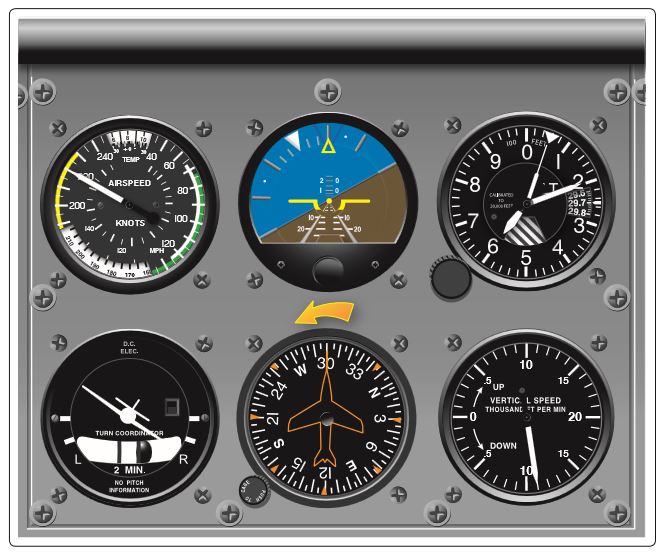 CorrectIncorrect
CorrectIncorrect -
Question 663 of 805
663. Question
Refer to the diagram below. Which is the correct sequence for recovery from the unusual attitude indicated?
 CorrectIncorrect
CorrectIncorrect -
Question 664 of 805
664. Question
Refer to the diagram below. Identify the system that has failed and determine a corrective action to return the airplane to straight-and-level flight.
 CorrectIncorrect
CorrectIncorrect -
Question 665 of 805
665. Question
Refer to the diagram below. What is the flight attitude? One instrument has malfunctioned.

 CorrectIncorrect
CorrectIncorrect -
Question 666 of 805
666. Question
Refer to the diagram below. What is the flight attitude? One instrument has malfunctioned.
 CorrectIncorrect
CorrectIncorrect -
Question 667 of 805
667. Question
If you fly into severe turbulence, which flight condition should you attempt to maintain?
CorrectIncorrect -
Question 668 of 805
668. Question
If severe turbulence is encountered during your IFR flight, the airplane should be slowed to the design maneuvering speed because the
CorrectIncorrect -
Question 669 of 805
669. Question
When a climb or descent through an inversion of wind-shear zone is being performed, the pilot should be alert for which of the following change in airplane performance?
CorrectIncorrect -
Question 670 of 805
670. Question
What is the best method of speed reduction if hydroplaning is experienced on landing?
CorrectIncorrect -
Question 671 of 805
671. Question
Which term describes the hydroplaning which occurs when an airplane's tire is effectively held off a smooth runway surface by steam generated by friction?
CorrectIncorrect -
Question 672 of 805
672. Question
What is the best method of speed reduction if hydroplaning is experienced on landing?
CorrectIncorrect -
Question 673 of 805
673. Question
What effect, if any, will landing at a higher-than-recommended touchdown speed have on hydroplaning?
CorrectIncorrect -
Question 674 of 805
674. Question
Under which conditions is hydroplaning most likely to occur?
CorrectIncorrect -
Question 675 of 805
675. Question
Which distance is displayed by the DME indicator?
CorrectIncorrect -
Question 676 of 805
676. Question
Which DME indication should you receive when you are directly over a VORTAC site at approximately 6,000 feet AGL?
CorrectIncorrect -
Question 677 of 805
677. Question
The greatest DME indication error between actual ground distance and displayed ground distance occurs at
CorrectIncorrect -
Question 678 of 805
678. Question
As a rule of thumb, to minimize DME select range error, how far from the facility should you be to consider the reading as accurate?
CorrectIncorrect -
Question 679 of 805
679. Question
To find the VOR receiver ground checkpoint(s) for an accuracy check, which publication should you consult?
CorrectIncorrect -
Question 680 of 805
680. Question
When flying directly over a published airborne VOR checkpoint, what is the maximum error allowed for IFR flight?
CorrectIncorrect -
Question 681 of 805
681. Question
When using VOT to make a VOR receiver check, the CDI should be centered and the OBS should indicate that the aircraft is on the
CorrectIncorrect -
Question 682 of 805
682. Question
When making an airborne VOR check, what is the maximum allowable tolerance between the two indicators of a dual VOR system (units independent of each other except the antenna)?
CorrectIncorrect -
Question 683 of 805
683. Question
When the CDI needle is centered during an airborne VOR check, the omni-bearing selector and the TO/FROM indicator should read
CorrectIncorrect -
Question 684 of 805
684. Question
Refer to the diagram below. When checking a dual VOR system by use of a VOT, which illustration indicates the VOR's are satisfactory?
 CorrectIncorrect
CorrectIncorrect -
Question 685 of 805
685. Question
While airborne, what is the maximum permissible variation between the two indicated bearings when checking one VOR system against the other?
CorrectIncorrect -
Question 686 of 805
686. Question
Refer to the diagram below. Which is an acceptable range of accuracy when performing an operational check of dual VORs using one system against the other.
 CorrectIncorrect
CorrectIncorrect -
Question 687 of 805
687. Question
How should the pilot make a VOR receiver check when the aircraft is located on the designated checkpoint on the airport surface?
CorrectIncorrect -
Question 688 of 805
688. Question
Where can the VOT frequency for a particular airport be found?
CorrectIncorrect -
Question 689 of 805
689. Question
Which indications are acceptable tolerances when checking both VOR receivers by use of the VOT?
CorrectIncorrect -
Question 690 of 805
690. Question
What indication should a pilot receive when a VOR station is undergoing maintenance and may be considered unreliable?
CorrectIncorrect -
Question 691 of 805
691. Question
A particular VOR station is undergoing routine maintenance. This is evidenced by
CorrectIncorrect -
Question 692 of 805
692. Question
When a VOR/DME is collocated under frequency pairings and the VOR portion is inoperative, the DME identifier will repeat at an interval of
CorrectIncorrect -
Question 693 of 805
693. Question
What is the meaning of a single coded identification received only once approximately every 30 seconds from a VORTAC?
CorrectIncorrect -
Question 694 of 805
694. Question
For operations off established airways at 17,000 feet MSL in the contiguous U.S., (H) Class VORTAC facilities used to define a direct route of flight should be no farther apart than
CorrectIncorrect -
Question 695 of 805
695. Question
You are planning an IFR flight off established airways below 18,000 feet MSL. If you use VOR navigation to define the route, the maximum distance between NAVAIDs should be
CorrectIncorrect -
Question 696 of 805
696. Question
What angular deviation from a VOR course centerline is represented by a full-scale deflection of the CDI?
CorrectIncorrect -
Question 697 of 805
697. Question
Full scale deflection of a COi occurs when the course deviation bar or needle
CorrectIncorrect -
Question 698 of 805
698. Question
When using VOR for navigation, which of the following should be considered as station passage?
CorrectIncorrect -
Question 699 of 805
699. Question
Which of the following should be considered as station passage when using VOR?
CorrectIncorrect -
Question 700 of 805
700. Question
When checking the sensitivity of a VOR receiver, the number of degrees in course change as the OBS is rotated to move the COi from center to the last dot on either side should be between
CorrectIncorrect -
Question 701 of 805
701. Question
A VOR receiver with normal five-dot course sensitivity shows a three-dot deflection at 30 NM from the station. The aircraft would be displaced approximately how far from the course centerline?
CorrectIncorrect -
Question 702 of 805
702. Question
An aircraft which is located 30 miles from a VOR station and shows a 1/2 scale deflection on the COi would be how far from the selected course centerline?
CorrectIncorrect -
Question 703 of 805
703. Question
Refer to the diagram below. The course selector of each aircraft is set on 360 degrees. Which aircraft would have a FROM indication on the TO/FROM indicator and the CDI pointing left of center?
 CorrectIncorrect
CorrectIncorrect -
Question 704 of 805
704. Question
Refer to the diagram below. The course selector of each aircraft is set on 360 degrees. Which aircraft would have a FROM indication on the TO/FROM indicator and the CDI pointing right of center?
 CorrectIncorrect
CorrectIncorrect -
Question 705 of 805
705. Question
After passing a VORTAC, the CDI shows 1/2 scale deflection to the right. What is indicated if the deflection remains constant for a period of time?
CorrectIncorrect -
Question 706 of 805
706. Question
What angular deviation from a VOR course centerline is represented by a 1/2 scale deflection of the CDI?
CorrectIncorrect -
Question 707 of 805
707. Question
Determine the approximate time and distance to a station if a 5 degree wingtip bearing change occurs in 1.5 minutes with a true airspeed of 95 knots.
CorrectIncorrect -
Question 708 of 805
708. Question
Refer to the diagram below. In which general direction from the VORTAC is the aircraft located?
 CorrectIncorrect
CorrectIncorrect -
Question 709 of 805
709. Question
Refer to the diagram below. In which general direction from the VORTAC is the aircraft located?
 CorrectIncorrect
CorrectIncorrect -
Question 710 of 805
710. Question
Refer to the diagram below. In which general direction from the VORTAC is the aircraft located?
 CorrectIncorrect
CorrectIncorrect -
Question 711 of 805
711. Question
Refer to the diagram below. What is the lateral displacement of the aircraft in NM from the radial selected on the No. 1 NAV?
 CorrectIncorrect
CorrectIncorrect -
Question 712 of 805
712. Question
Refer to the diagram below. On which radial is the aircraft as indicated by the No. 1 NAV?
 CorrectIncorrect
CorrectIncorrect -
Question 713 of 805
713. Question
Refer to the diagram below. Which OBS selection on the No. 1 NAV would center the CDI and change the ambiguity indication to a TO?
 CorrectIncorrect
CorrectIncorrect -
Question 714 of 805
714. Question
Refer to the diagram below. What is the lateral displacement in degrees from the desired radial on the No. 2 NAV?
 CorrectIncorrect
CorrectIncorrect -
Question 715 of 805
715. Question
Refer to the diagram below. Which OBS selection on the No. 2 NAV would center the CDI?
 CorrectIncorrect
CorrectIncorrect -
Question 716 of 805
716. Question
Refer to the diagram below. Which OBS selection on the No. 2 NAV would center the CDI and change the ambiguity indication to a TO?
 CorrectIncorrect
CorrectIncorrect -
Question 717 of 805
717. Question
Refer to the diagrams below. To which aircraft position does HSI presentation "A" correspond?

 CorrectIncorrect
CorrectIncorrect -
Question 718 of 805
718. Question
Refer to the diagrams below. To which aircraft position does HSI presentation "F" correspond?

 CorrectIncorrect
CorrectIncorrect -
Question 719 of 805
719. Question
During flight, if the pitot tube becomes clogged with ice, which of the following instruments would be affected?
CorrectIncorrect -
Question 720 of 805
720. Question
If both the ram air input and drain hole of the pitot system become blocked, the indicated airspeed will
CorrectIncorrect -
Question 721 of 805
721. Question
If the pitot tube ram air pressure hole and drain hole become obstructed, the airspeed indicator will operate
CorrectIncorrect -
Question 722 of 805
722. Question
If the outside air temperature increases during a flight at constant power and at a constant indicated altitude, the true airspeed will
CorrectIncorrect -
Question 723 of 805
723. Question
If, while in level flight, it becomes necessary to use an alternate source of static pressure vented inside the airplane, which of the following should the pilot expect?
CorrectIncorrect -
Question 724 of 805
724. Question
What would be the indication on the VSI during entry into a 500 FPM actual descent from level flight if the static ports were iced over?
CorrectIncorrect -
Question 725 of 805
725. Question
If, while in level flight, it becomes necessary to use an alternate source of static pressure vented inside the airplane, which of the following should the pilot expect?
CorrectIncorrect -
Question 726 of 805
726. Question
You check the flight instruments while taxiing and find the vertical speed indicator (VSI) indicates a descent of 100 feet per minute. In this case, you
CorrectIncorrect -
Question 727 of 805
727. Question
Pressure altitude is the altitude read on your altimeter when the instrument is adjusted to indicate height above
CorrectIncorrect -
Question 728 of 805
728. Question
Refer to the diagrams below. To which aircraft position(s) does HSI presentation "A" correspond? NOTE: HSI presentations B, C, D, E and I have backcourse settings of 090 degrees, which means there is reverse sensing irrespective of the airplane's heading

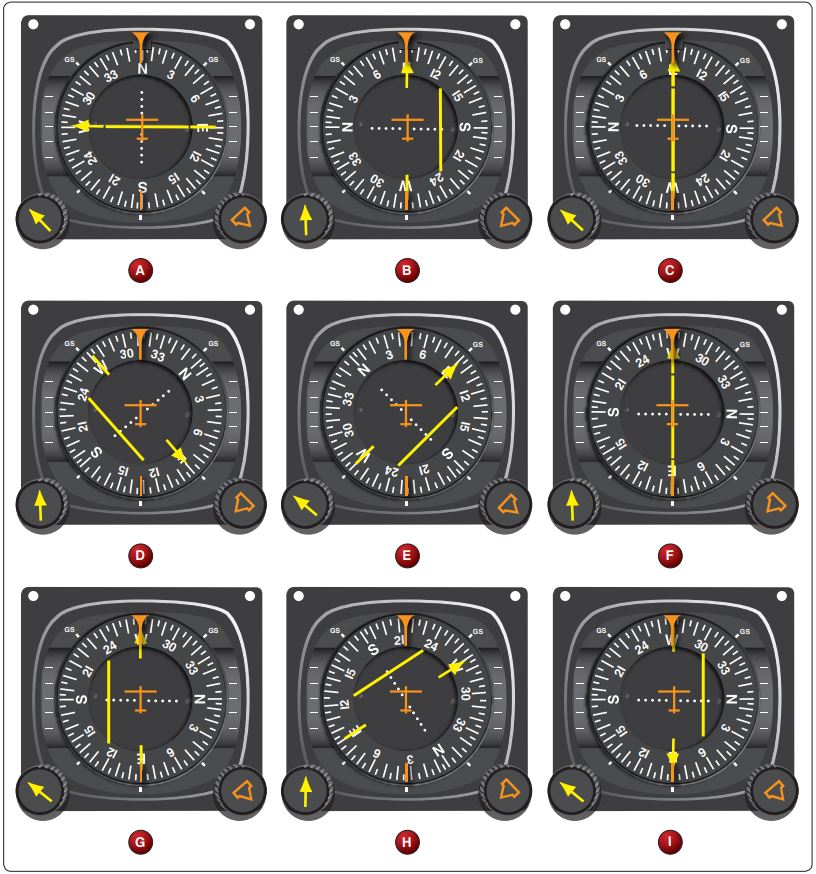 CorrectIncorrect
CorrectIncorrect -
Question 729 of 805
729. Question
Refer to the diagrams below. To which aircraft position(s) does HSI presentation "B" correspond? NOTE: HSI presentations B, C, D, E and I have backcourse settings of 090 degrees, which means there is reverse sensing irrespective of the airplane's heading

 CorrectIncorrect
CorrectIncorrect -
Question 730 of 805
730. Question
Refer to the diagrams below. To which aircraft position(s) does HSI presentation "D" correspond? NOTE: HSI presentations B, C, D, E and I have backcourse settings of 090 degrees, which means there is reverse sensing irrespective of the airplane's heading

 CorrectIncorrect
CorrectIncorrect -
Question 731 of 805
731. Question
Refer to the diagrams below. To which aircraft position(s) does HSI presentation "I" correspond? NOTE: HSI presentations B, C, D, E and I have backcourse settings of 090 degrees, which means there is reverse sensing irrespective of the airplane's heading

 CorrectIncorrect
CorrectIncorrect -
Question 732 of 805
732. Question
How should you preflight check the altimeter prior to an IFR flight?
CorrectIncorrect -
Question 733 of 805
733. Question
The local altimeter setting should be used by all pilots in a particular area, primarily to provide for
CorrectIncorrect -
Question 734 of 805
734. Question
If you are departing from an airport where you cannot obtain an altimeter setting, you should set your altimeter
CorrectIncorrect -
Question 735 of 805
735. Question
Which altitude is indicated when the altimeter is set to 29.92" Hg?
CorrectIncorrect -
Question 736 of 805
736. Question
Altimeter setting is the value to which the scale of the pressure altimeter is set so the altimeter indicates
CorrectIncorrect -
Question 737 of 805
737. Question
While you are flying at FL 250, you hear ATC give an altimeter setting of 28.92" Hg in your area. At what pressure altitude are you flying?
CorrectIncorrect -
Question 738 of 805
738. Question
The pressure altitude at a given location is indicated on the altimeter after the altimeter is set to
CorrectIncorrect -
Question 739 of 805
739. Question
How can you determine the pressure altitude on an airport without a tower or FSS?
CorrectIncorrect -
Question 740 of 805
740. Question
How can you obtain the pressure altitude on flights below 18,000 feet?
CorrectIncorrect -
Question 741 of 805
741. Question
At an altitude of 6,500 feet MSL, the current altimeter setting is 30.42" Hg. The pressure altitude would be approximately
CorrectIncorrect -
Question 742 of 805
742. Question
How does a pilot normally obtain the current altimeter setting during an IFR flight in Class E airspace below 18,000 feet?
CorrectIncorrect -
Question 743 of 805
743. Question
What is the procedure for setting the altimeter when assigned an IFR altitude of 18,000 feet or higher on a direct flight off airways?
CorrectIncorrect -
Question 744 of 805
744. Question
En route at FL290, your altimeter is set correctly, but you fail to reset it to the local altimeter setting of 30.26" Hg during descent. If the field elevation is 134 feet and your altimeter is functioning properly, what will it indicate after landing?
CorrectIncorrect -
Question 745 of 805
745. Question
Which of the following defines the type of altitude used when maintaining FL 210?
CorrectIncorrect -
Question 746 of 805
746. Question
En route at FL 290, the altimeter is set correctly, but not reset to the local altimeter setting of 30.57" Hg during descent. If the field elevation is 650 feet and the altimeter is functioning properly, what is the approximate indication upon landing?
CorrectIncorrect -
Question 747 of 805
747. Question
Under which condition will pressure altitude be equal to true altitude?
CorrectIncorrect -
Question 748 of 805
748. Question
Under what condition is pressure altitude and density altitude the same value?
CorrectIncorrect -
Question 749 of 805
749. Question
Under what condition will true altitude be lower than indicated altitude with an altimeter setting of 29.92" Hg?
CorrectIncorrect -
Question 750 of 805
750. Question
Which condition would cause the altimeter to indicate a lower altitude than actually flown (true altitude)?
CorrectIncorrect -
Question 751 of 805
751. Question
When an altimeter is changed from 30.11" Hg to 29.92" Hg, in which direction will the indicated altitude change and by what value?
CorrectIncorrect -
Question 752 of 805
752. Question
Which practical test should e made on the electric gyro instruments prior to starting an engine?
CorrectIncorrect -
Question 753 of 805
753. Question
One characteristic that a properly functioning gyro depends upon for operation is the
CorrectIncorrect -
Question 754 of 805
754. Question
What pre-takeoff check should be made of a vacuum-driven heading indicator in preparation for an IFR flight?
CorrectIncorrect -
Question 755 of 805
755. Question
What pre-takeoff check should be made of the altitude indicator in preparation for an IFR flight?
CorrectIncorrect -
Question 756 of 805
756. Question
Which condition during taxi is an indication that an altitude indicator is unreliable?
CorrectIncorrect -
Question 757 of 805
757. Question
How can a pilot determine if a Global Positioning System (GPS) installed in an aircraft is approved for IFR en route and IFR approaches?
CorrectIncorrect -
Question 758 of 805
758. Question
During coordinated turns, which force moves the pendulous vanes of a vacuum-driven altitude indicator resulting in precession of the gyro toward the inside of the turn?
CorrectIncorrect -
Question 759 of 805
759. Question
Hand-held GPS systems, and GPS systems certified for VFR operation, may be used during IFR operations as
CorrectIncorrect -
Question 760 of 805
760. Question
When may VFR waypoints be used in IFR flight plans?
CorrectIncorrect -
Question 761 of 805
761. Question
During IFR en route and terminal operations using an approved TS0-C129 or TS0-C196 GPS system for navigation, ground based navigational facilities
CorrectIncorrect -
Question 762 of 805
762. Question
During IFR en route operations using an approved TSO-C129 or TSO-C196 GPS system for navigation,
CorrectIncorrect -
Question 763 of 805
763. Question
What are the primary benefits of satellite-based area navigation (RNAV)?
CorrectIncorrect -
Question 764 of 805
764. Question
A handbook GPS is
CorrectIncorrect -
Question 765 of 805
765. Question
Effective navigation by means of GPS includes
CorrectIncorrect -
Question 766 of 805
766. Question
If a 180° steep turn is made to the right and the aircraft is rolled out to straight-and-level flight by visual references, the altitude indicator
CorrectIncorrect -
Question 767 of 805
767. Question
Why should pilots understand how to cancel entries made on a GPS?
CorrectIncorrect -
Question 768 of 805
768. Question
Reliance on GPS units
CorrectIncorrect -
Question 769 of 805
769. Question
Before a pilot utilizes a GPS route or procedure, what would be an acceptable method of verifying the GPS database is current?
CorrectIncorrect -
Question 770 of 805
770. Question
During normal coordinated turns, what error due to precession should you observe when rolling out to straight-and-level flight from a 180° steep turn to the right?
CorrectIncorrect -
Question 771 of 805
771. Question
When your aircraft is equipped with a TS0-C129 or TS0-C196 GPS, an airport may not be qualified for alternate use if
CorrectIncorrect -
Question 772 of 805
772. Question
When planning an IFR flight using GPS, the pilot should know that VFR waypoints
CorrectIncorrect -
Question 773 of 805
773. Question
Prior to using GPS waypoints for RNAV, what can you do to check the current status of the GPS database?
CorrectIncorrect -
Question 774 of 805
774. Question
While conducting a GPS approach, if you disengage the auto sensitivity, what will occur?
CorrectIncorrect -
Question 775 of 805
775. Question
GPS systems certified for IFR operations cannot be used as a substitute for DME receivers
CorrectIncorrect -
Question 776 of 805
776. Question
When using a TSO-C129 or TSO-C196 GPS for navigation and instrument approaches, any required alternate airport must have
CorrectIncorrect -
Question 777 of 805
777. Question
Your aircraft is equipped with a WMS enabled GPS unit. While performing a GPS approach, you note an "LNAVN NAV available" indication on the moving map display and horizontal situation indicator. You know that
CorrectIncorrect -
Question 778 of 805
778. Question
Aircraft operating under IFR with TSO-C129 or TS0-C196 GPS for en route navigation must also have installed
CorrectIncorrect -
Question 779 of 805
779. Question
Which of the following is a benefit of flying with an autopilot?
CorrectIncorrect -
Question 780 of 805
780. Question
In an autopilot-controlled system, what device actually moves the control surfaces?
CorrectIncorrect -
Question 781 of 805
781. Question
To ensure situational awareness while using an autopilot system
CorrectIncorrect -
Question 782 of 805
782. Question
During normal operation of a vacuum-driven altitude indicator, what altitude indication should you see when rolling out from a 180° skidding turn to straight-and-level coordinated flight?
CorrectIncorrect -
Question 783 of 805
783. Question
Errors in both pitch and bank indication on an altitude indicator are usually at a maximum as the aircraft rolls out of a
CorrectIncorrect -
Question 784 of 805
784. Question
When an aircraft is decelerated, some attitude indicators will precess and incorrectly indicate a
CorrectIncorrect -
Question 785 of 805
785. Question
During normal flight with a vacuum driven attitude indicator, control pressures normally should not move the horizon bar more than
CorrectIncorrect -
Question 786 of 805
786. Question
When an aircraft is accelerated, some attitude indicators will precess and incorrectly indicate a
CorrectIncorrect -
Question 787 of 805
787. Question
Prior to starting an engine, you should check the turn-and-slip indicator to determine if the
CorrectIncorrect -
Question 788 of 805
788. Question
What indications should you observe on the turn-and-slip indicator during taxi?
CorrectIncorrect -
Question 789 of 805
789. Question
What indication should be observed on a turn coordinator during a right turn while taxiing?
CorrectIncorrect -
Question 790 of 805
790. Question
What indications are displayed by the miniature aircraft of a turn coordinator?
CorrectIncorrect -
Question 791 of 805
791. Question
What does the miniature aircraft of the turn coordinator directly display?
CorrectIncorrect -
Question 792 of 805
792. Question
What indication is presented by the miniature aircraft of the turn coordinator?
CorrectIncorrect -
Question 793 of 805
793. Question
The displacement of a turn coordinator during a coordinated turn will
CorrectIncorrect -
Question 794 of 805
794. Question
What indication should be observed on a turn coordinator during a left turn while taxiing?
CorrectIncorrect -
Question 795 of 805
795. Question
What does the miniature aircraft of the turn coordinator display?
CorrectIncorrect -
Question 796 of 805
796. Question
In a left turn, correct control coordination is indicated by
CorrectIncorrect -
Question 797 of 805
797. Question
Which is true of glass cockpits?
CorrectIncorrect -
Question 798 of 805
798. Question
Which display combines instruments such as an altimeter, attitude indicator, and vertical speed indicator onto one given screen?
CorrectIncorrect -
Question 799 of 805
799. Question
Primary flight displays
CorrectIncorrect -
Question 800 of 805
800. Question
In a Technology Advanced Aircraft, the pilot sees the flight instruments on what?
CorrectIncorrect -
Question 801 of 805
801. Question
The lighter workloads associated with glass (digital) flight instrumentation
CorrectIncorrect -
Question 802 of 805
802. Question
When a pilot believes advanced avionics enable operations closer to personal or environmental limits,
CorrectIncorrect -
Question 803 of 805
803. Question
The advancement of avionics in light general aviation airplanes has enhanced situational awareness for properly trained pilots. However, there is concern that this technology could lead to
CorrectIncorrect -
Question 804 of 805
804. Question
Automation in aircraft has proven
CorrectIncorrect -
Question 805 of 805
805. Question
An aircraft which is equipped with an Electronic Flight Display (EFD) can
CorrectIncorrect
0 of 667 questions completed Questions: You have already completed the quiz before. Hence you can not start it again.
Quiz is loading… You must sign in or sign up to start the quiz. You must first complete the following:
0 of 667 questions answered correctly
Your time:
Time has elapsed
You have reached 0 of 0 point(s), (0)
Earned Point(s): 0 of 0, (0) In the Northern Hemisphere, a magnetic compass will normally indicate a turn toward the north if __________.
Deviation in a magnetic compass is caused by the __________.
During flight, when are the indications of a magnetic compass accurate?
In the Northern Hemisphere, if an aircraft is accelerated or decelerated. then the magnetic compass will normally indicate ______________.
In the Northern Hemisphere, a magnetic compass will normally indicate initially a turn toward the west if ________.
In the Northern Hemisphere, the magnetic compass will normally indicate a turn toward the south when _________.
In the Northern Hemisphere, the magnetic compass will normally indicate a turn toward the south when _________.
The pitot system provides impact pressure for which instrument?
Which instrument will become inoperative if the pitot tube becomes plugged?
If the pitot tube an outside static vents become clogged, which instruments would be affected?
Which instruments will become inoperative if only the static vent becomes clogged?
What does the red line on the airspeed indicator represent?
The caution range of the airplane is __________?
The maximum speed which the airplane can be operated in smooth air is ____.
What is the full flap operating range for the airplane?
What is the maximum flap extended speed?
Which marking identifies the never exceed speed?
Which color identifies power-off stalling speed in a specified configuration?
Which color identifies the power-off stalling speed with wing flaps and landing gear in the landing configuration?
What is the maximum structural cruising speed?
What is an important airspeed limitation that is not color coded on airspeed indicators?
Altimeter #1 indicates _____________.
Altimeter #3 indicates ___________.
Which altimeters indicate more than 10,000′?
Altimeter 2 indicates _________.
What is true altitude?
What is absolute altitude?
What is density altitude?
What is pressure altitude?
Altimeter setting the value to which the barometric pressure scale of the altimeter is set so the altimeter indicates ______.
Under what condition is indicated altitude the same as true altitude?
Under what condition is pressure altitude and density altitude the same?
Under which condition will pressure altitude be equal to true altitude?
If you were to change an altimeter from 29.15 to 29.85, what change would the altimeter indicate?
If a pilot changes the altimeter setting from 30.11 to 29.96, what is the approximate change in indication?
If a flight is made from an area of high pressure to an area of lower pressure without the altimeter setting being changed, then the altimeter will indicate ________.
Which condition would cause the altimeter to indicate a lower altitude than true altitude?
A turn coordinator provides an indication of the __________.
To receive accurate indications during flight from a heading indicator, the instrument must be __________.
The proper adjustment to make on a the attitude indicator during level flight is to align the __________.
How should a pilot determine the direction of bank from an attitude indicator such as the one illustrated?
What is a benefit of flying with glass cockpits?
What steps must be taken with a glass cockpit to ensure safe flight?
An abnormally high engine oil temperature indication may be caused by _________.
Excessively high engine temperatures will ___________.
For internal cooling, air cooled engines are especially dependent on _____________.
If the engine oil temperature and cylinder head temperature gauges have exceeded their normal operating range, the pilot may have been operating with _________.
What action can a pilot take to aid in cooling an engine that is overheating during a climb?
What is one procedure to aid in cooling an engine that is overheating?
How is engine operation controlled on an engine equipped with a constant speed propeller?
A precaution for the operation of an engine equipped with a constant speed propeller is to _________
What is an advantage of a constant speed propeller?
One purpose of the dual ignition system on an aircraft engine is to provide for _________.
If the ignition switch ground wire becomes disconnected (p-lead), the magneto ________.
With regard to carburetor ice, float-type carburetor systems in comparison to fuel injection systems are generally considered to be ___________.
Which condition is most favorable to the development of carburetor icing?
If an engine is equipped with a fixed pitch propeller and a float type carburetor, the first indication of carburetor ice would most likely be ________.
The operating principle of float-type carburetors is based on the _________.
The presence of carburetor ice in an aircraft equipped with a fixed-pitch propeller can be verified by applying carburetor heat and noting _______.
Generally speaking, the use of carburetor heat tends to _______.
Applying carburetor heat will ______.
The basic purpose of adjusting the fuel/air mixture at altitude is to _______.
While cruising at 9,500′ msl, the fuel/air mixture is properly adjusted. What will occur if a descent to 4,500′ msl is made without readjusting the mixture?
Detonation occurs in a reciprocating aircraft engine when ___________.
If a pilot suspects that the engine (with a fixed pitch propeller) is detonating during climb-out after takeoff, the initial corrective action to take would be to __________.
If the grade of fuel used in an aircraft engine is lower than specified for the engine, it will most likely cause ________.
The uncontrolled firing in advance of the normal spark ignition is known as ___________.
What type of fuel can be substituted for an aircraft if the recommended octane is not available?
Filling the fuel tanks after the last flight of the day is considered good practice because this will _______.
To properly purge water from the fuel system of an aircraft equipped with fuel tank sumps and a fuel strainer quick drain, it is necessary to drain fuel from the _________.
On aircraft equipped with fuel pumps, when is the auxiliary electric driven pump used?
What should be the first action when starting an aircraft engine?
Should it become necessary to handprop an airplane engine, it is extremely important that a competent pilot _____.
During preflight in cold weather, crankcase breather lines should receive special attention because they are susceptible to being clogged by ________.
An electrical system failure (battery and alternator) occurs during flight. In this situation, you would __________.
A positive indication on an ammeter ___________.
To keep a battery charged, the alternator voltage output should be ________.
With respect to the certification of airmen, which are categories of aircraft?
With respect to the certification of airmen, which is a class of aircraft?
Which V-speed represents maximum landing gear extended speed?
V-no is defined as the
Which V-speed represents maneuvering speed?
Which would provide the greatest gain in altitude in the shortest distance during climb after takeoff?
V-so is defined as the
After takeoff, which airspeed would the pilot use to gain the most altitude in a given period of time?
How long does the Airworthiness Certificate of an aircraft remain valid?
What should an owner or operator know about Airworthiness Directives (ADs)?
May a pilot operate an aircraft that is not in compliance with an Airworthiness Directive (AD)?
What regulation allows a private pilot to perform preventive maintenance?
Who may perform preventive maintenance on an aircraft and approve it for return to service?
What preventive maintenance is performed on an aircraft, what paperwork is required?
Which operation would be described as preventive maintenance?
Which operation would be described as preventive maintenance?
Is it legal to fly on the dealer’s registration after a buyer purchased an airplane from that dealer?
When must a current pilot certificate be in the pilot’s personal possession or readily accessible in the aircraft?
What documents must be in your personal possession or readily accessible in the aircraft while operating as pilot in command of an aircraft?
Each person who holds a pilot certificate or a medical certificate shall present it for inspection upon the request of any
How soon after the conviction for driving while intoxicated by alcohol or drugs shall it be reported to the FAA, Civil Aviation Security Division?
How soon after the conviction for driving while intoxicated by alcohol or drugs shall it be reported to the FAA, and which division should this be reported to?
For private pilot operations, a Second-Class Medical Certificate issued to a 42-year old pilot on July 15, this year, will expire at midnight on
A recreational or private pilot acting as pilot in command, or in any other capacity as a required pilot flight crewmember, must have in his or her personal possession or readily accessible in the aircraft a current
A Third-Class Medical Certificate is issued to a 36-year-old pilot on August 20 this year. To exercise the privileges of a Private Pilot Certificate, the medical certificate will be valid until midnight on
A Third-Class Medical Certificate is issued to a 51-year-old pilot on May 3 this year. To exercise the privileges of a Private Pilot Certificate, the medical certificate will be valid until midnight on
A Third-Class Medical Certificate is issued to a 19-year-old pilot on August 10, this year. To exercise the privileges of a recreational or private pilot certificate, the medical certificate will expire at midnight on
For private pilot operations, a First-Class Medical Certificate issued to a 23-year old pilot on October 21, this year, will expire at midnight on
Before a person holding a private pilot certificate may act as pilot in command of a high-performance airplane, that person must have
What is the defnition of a high-performance airplane?
The pilot in command is required to hold a type rating in which aircraft?
In order to act as pilot in command of a high-performance airplane, a pilot must have:
As pilot in command with a recreational certificate, you must have in your personal possession while exercising the privileges of that certificate
If a recreational or private pilot had a flight review on October 30 this year, when is the next flight review required?
Each recreational or private pilot is required to have
If a recreational or private pilot had a flight review on August 8 this year, when is the next flight review required?
To act as pilot in command of an aircraft carrying passengers, a pilot must show by logbook endorsement the satisfactory completion of a flight review or completion of a pilot proficiency check within the preceding
To act as pilot in command of an aircraft carrying passengers, the pilot must have made at least three takeoffs and three landings in an aircraft of the same category, class, and if a type rating is required, of the same type, within the preceding
If recency of experience requirements for night flight are not met and official sunset is 1830, the latest time passengers may be carried is
To act as pilot in command of an aircraft carrying passengers, the pilot must have made three takeoffs and three landings within the preceding 90 days in an aircraft of the same
The three takeoffs and landings that are required to act as pilot in command at night must be done during the time period from
To meet the recency of experience requirements to act as pilot in command carrying passengers at night, a pilot must have made at least three takeoffs and three landings to a full stop within the preceding 90 days in
The takeoffs and landings required to meet the recency of experience requirements for carrying passengers in a tailwheel airplane
Your cousin wants you to take him flying. You must have made at least three takeoffs and three landings in your aircraft within the preceding
If a certificated pilot changes permanent mailing address and fails to notify the FAA Airmen Certification Branch of the new address, the pilot is entitled to exercise the privileges of the pilot certificate for a period of only
A certificated private pilot may not act as pilot in command of an aircraft towing a glider unless there is entered in the pilot’s logbook a minimum of
To act as pilot in command of an aircraft towing a glider, a pilot is required to have made within the preceding 24 months
In regard to privileges and limitations, a private pilot may
According to regulations pertaining to privileges and limitations, a private pilot may
What exception, if any, permits a private pilot to act as pilot in command of an aircraft carrying passengers who pay for the flight?
A recreational pilot acting as pilot in command must have in his or her personal possession while aboard the aircraft
How many passengers is a recreational pilot allowed to carry on board?
When may a recreational pilot act as pilot in command of an aircraft at night?
According to regulations pertaining to privileges and limitations, a recreational pilot may
When may a recreational pilot act as pilot in command on a cross-country flight that exceeds 50 nautical miles from the departure airport?
In regard to privileges and limitations, a recreational pilot may
Refer to Figure 22 on page 135.) (Refer to area 1.) The visibility and cloud clearance
A recreational pilot may act as pilot in command of an aircraft that is certificated for a maximum of how many occupants?
A recreational pilot may act as pilot in command of an aircraft with a maximum engine horsepower of
With respect to daylight hours, what is the earliest time a recreational pilot may take off?
What exception, if any, permits a recreational pilot to act as pilot in command of an aircraft carrying a passenger for hire?
When may a recreational pilot operate to or from an airport that lies within Class C airspace?
May a recreational pilot act as pilot in command of an aircraft in furtherance of a business?
Under what conditions may a recreational pilot operate at an airport that lies within Class D airspace and that has a part-time control tower in operation?
When must a recreational pilot have a pilot in-command flight check?
What minimum visibility and clearance from clouds are required for a recreational pilot in Class G airspace at 1,200 feet AGL or below during daylight hours?
(Refer to Figure 26 on page 138.) (Refer to area 2.) The visibility and cloud clearance requirements to operate over the town of Cooperstown below 700 feet AGL are
A recreational pilot may fly as sole occupant of an aircraft at night while under the supervision of a flight instructor provided the flight or surface visibility is at least
Outside controlled airspace, the minimum flight visibility requirement for a recreational pilot flying VFR above 1,200 feet AGL and below 10,000 feet MSL during daylight hours is
If sunset is 2021 and the end of evening civil twilight is 2043, when must a recreational pilot terminate the flight?
Under what conditions, if any, may a recreational pilot demonstrate an aircraft in flight to a prospective buyer?
When, if ever, may a recreational pilot act as pilot in command in an aircraft towing a banner?
Unless otherwise authorized, if flying a transponder equiped aircraft, a recreational pilot should squawk which VFR code?
When may a recreational pilot fly above 10,000 feel MSL?
During daytime, what is the minimum flight or surface visibility required for recreational pilots in Class G airspace below 10,000 feel MSL?
During daytime, what is the minimum flight visibility required for recreational pilots in controlled airspace below 10,000 feet MSL?
Unless otherwise specified, Federal Airways include that Class E airspace extending upward from
The final authority as to the operation of an aircraft is the
Who is responsible for determining if an aircraft is in condition for safe flight?
Where may an aircraft’s operating limitations be found?
Where may an aircraft’s operating limitations be found if the aircraft has an Experimental or Special light-sport airworthiness certificate?
Under what conditions may objects be dropped from an aircraft?
No person may attempt to act as a crewmember of a civil aircraft with
Under what conditions, if any, may a pilot allow a person who is obviously under the influence of drugs to be carried aboard an aircraft?
A person may not act as a crewmember of a civil aircraft if alcoholic beverages have been consumed by that person within the preceding
Preflight action, as required for all flights away from the vicinity of an airport, shall include
In addition to other preflight actions for a VFR flight away from the vicinity of the departure airport, regulations specifically require the pilot in command to
What preflight action is specifically required o the pilot prior to each flight?
For a VFR flight not in the vicinity of an airport, the PIC must
Flight crewmembers are requred to keep their safety belts and shoulder harnesses fastened during
Which best describes the flight conditions under which flight crewmembers are specifically required to keep their safety belts and shoulder harnesses fastened?
With respect to passengers, what obligation, if any, does a pilot in command have concerning the use of safety belts?
With certain exceptions, safety belts are required to be secured about passengers during
Safety belts are required to be properly secured about which persons in an aircraft and when?
No person may operate an aircraft in formation flight
An airplane and an airship are converging. If the airship is left of the airplane’s position, which aircraft has the right-of-way?
When two or more aircraft are approaching an airport for the purpose of landing, the right-of-way belongs to the aircraft.
Which aircraft has the right-of-way over the other aircraft listed?Which aircraft has the right-of-way over the other aircraft listed?
Which aircraft has the right-of-way over all other air traffic?
What action should the pilots of a glider and an airplane take if on a head-on collision course?
What action is required when two aircraft of the same category converge, but not head-on?
Which aircraft has the right-of-way over the other aircraft listed?
A seaplane and a motorboat are on crossing courses. If the motorboat is to the left of the seaplane, which has the right-of-way?
When flying in a VFR corridor designated through Class B airspace, the maximum speed authorized is
Unless otherwise authorized, what is the maximum indicated airspeed at which a person may operate an aircraft below 10,000 feet MSL?
When flyinig in the airspace underlying Class B airspace, the maximum speed authorized is
Unless otherwise authorized, the maximum indicated airspeed at which aircraft may be flown when at or below 2,500 feet AGL and within 4 nautical miles of the primary airport of Class C airspace is
Except when necessary for takeoff or landing, what is the minimum safe altitude for a pilot to operate an aircraft anywhere?
Except when necessary for takeoff or landing, what is the minimum safe altitude required for a pilot to operate an aircraft over congested areas?
Except when necessary for takeoff or landing, an aircraft may not be operated closer than what distance from any person, vessel, vehicle, or structure?
Except when necessary for takeoff or landing, what is the minimum safe altitude required for a pilot to operate an aircraft over other than a congested area?
Prior to takeoff, the altimeter should be set to which altitude or altimete setting?
If an altimeter setting is not available before flight, to which altitude should the pilot adjust the altimeter?
At what altitude shall the altimeter be set to 29.92 when climbing to cruising flight level?
When must a pilot who deviates from a regulation during an emergency send a written report of that deviation to the Administrator?
When would a pilot be required to submit a detailed report of an emergency which caused the pilot to deviate from an ATC clearance?
If an in-flight emergency requires immediate action, the pilot in command may
As Pilot in Command of an aircraft, under whcih situation can you deviate from an ATC clearance?
When an ATC clearance has been obtained, no pilot in command may deviate from that clearance unless that pilot obtains an amended clearance. The one exception to this regulation is
What action, if any, is appropriate if the pilot deviates from an ATC instruction during an emergency and is given priority?
With certain exceptions, all aircraft within 30 miles of a Class B primary airport from the surface upward to 10,000 feet MSL must be equipped with
What minimum pilot certification is required for operation within Class B airspace?
Under what condition, if any, may pilots fly through a restricted area?
In which type of airspace are VFR flights prohibited?
What is the specific fuel requirement for flight under VFR at night in an airplane?
What is the specific fuel requirement for flight under VFR during daylight hours in an airplane?
The basic VFR weather minimums for operating an aircraft within Class D airspace are
The minimum flight visibility required for VFR flights above 10,000 feet MSL and more than 1,200 feet AGL in controlled airspace is
VFR flight in controlled airspace above 1,200 feet AGL and below 10,000 feeet MSL requires a minimum visibility and vertical cloud clearance of
For VFR flight operations above 10,000 feet MSL and more than 1,200 feet AGL, the minimum horizontal distance from clouds required is
What minimum flight visibility is required for VFR flight operations on an airway below 10,000 feet MSL?
The minimum distance from clouds required for VFR operations on an airway below 10,000 feet MSL is
What minimum visibility and clearance from clouds are required for VFR operations in Class G airspace at 700 feet AGL or below during daylight hours?
During operations outside controlled airspace at altitudes of more than 1,200 feet AGL, but less than 10,000 feet MSL, the minimum flight visibility for VFR flight at night is
During operations outside controlled airspace at altitudes of more than 1,200 feet AGL, but less than 10,000 feet MSL, the minimum flight visibility for day VFR flight is
During operations within controlled airspace at altitudes of more than 1,200 feet AGL, but less than 10,000 feet MSL, the minimum distance above clouds requirement for VFR flight is
No person may take off or land an aircraft under basic VFR at an airport that lies within Class D airspace unless the
During operations at altitudes of more than 1,200 feet AGL and at or above 10,000 feet MSL, the minimum distance above clouds requirement for VFR flight is
Outside controlled airspace, the minimum flight visibility requirement for VFR flight above 1,200 feet AGL and below 10,000 feet MSL during daylight hours is
During operations outside controlled airspace at altitudes of more than 1,200 feet AGL, but less than 10,000 feet MSL, the minimum distance below clouds requirement for VFR flight at night is
During operations within controlled airspace at altitudes of less than 1,200 feet AGL, the minimum horizontal distance from clouds requirement for VFR flight is
Normal VFR operations in Class D airspace with an operating control tower require the visibility and ceiling to be at least
What ATC facility should the pilot contact to receive a special VFR departure clearance in Class D airspace?
A special VFR clearance authorizes the pilot of an aircraft to operate VFR while within Class D airspace when the visibility is
No person may operate an airplane within Class D airspace at night under special VFR unless the
What are the minimum requirements for airplane operations under special VFR in Class D airspace at night?
What is the minimum weather condition required for airplanes operating under special VFR in Class D airspace?
Which VFR cruising altitude is acceptable for a flight on a Victor Airway with a magnetic curse of 175? The terrain is less than 1,000 feet.
Which cruising altitude is appropriate for a VFR flight on a magnetic course of 135?
Which VFR cruising altitude is appropriate when flying above 3,000 feet AGL on a magnetic course of 185°?
Each person operating an aircraft at a VFR cruising altitude shall maintain an odd-thousand plus 500-foot altitude while on a
In addition to a valid Airworthiness Certificate, what documents or records must be aboard an aircraft during flight?
When must batteries in an emergency locator transmitter (ELT) be replaced or recharged, if rechargeable?
When may an emergency locator transmitter (ELT) be tested?
When are non-rechargeable batteries of an emergency locator transmitter (ELT) required to be replaced?
When must the battery in an emergency locator transmitter (ELT) be replaced (or recharged if the battery is rechargeable)?
Except in Alaska, during what time period should lighted position lights be displayed on an aircraft?
Unless each occupant is provided with supplemental oxygen, no person may operate a civil aircraft of U.S. registry above a maximum cabin pressure altitude of
When operating an aircraft at cabin pressure altitudes above 12,500 feet MSL up to and including 14,000 feet MSL, supplemental oxygen shall be used during
An operable 4096-code transponder with an encoding altimeter is required in which airspace?
An operable 4096-code transponder and Mode C encoding altimeter are required in
With certain exceptions, when must each occupant of an aircraft wear an approved parachute?
A parachute composed of nylon, rayon, or other synthetic fibers must have been packed by a certificated and appropriately rated parachute rigger within the preceding
An approved parachute constructed of natural fibers may be carried in an aircraft for emergency use if it has been packed by an appropriately rated parachute rigger within the preceding
Which is normally prohibited when operating a restricted category civil aircraft?
Unless otherwise specifically authorized, no person may operate an aircraft that has an experimental certificate
Who is responsible for ensuring Airworthiness Directives (ADs) are complied with?
The responsibility for ensuring that an aircraft is maintained in an airworthy condition is primarily that of the
Who is responsible for ensuring appropriate entries are made in maintenance records indicating the aircraft has been approved for return to service?
The responsibility for ensuring that maintenance personnel make the appropriate entries in the aircraft maintenance records indicating the aircraft has been approved for return to service lies with the
If an alteration or repair substantially affects an aircraft’s operation in flight, that aircraft must be test flown by an appropriately-rated pilot and approved for return to service prior to being operated
Before passengers can be carried in an aircraft that has been altered in a manner that may have appreciably changed its flight characteristics, it must be flight tested by an appropriately-rated pilot who holds at least a
A 100-hour inspection was due at 3302.5 hours. The 100-hour inspection was actually done at 3309.5 hours. When is the next 100-hour inspection due?
An aircraft’s annual condition inspection was performed on July 12, this year. The next annual inspection will be due no later than
What aircraft inspections are required for rental aircraft that are also used for flight instruction?
An aircraft had a 100-hour inspection when the tachometer read 1259.6. When is the next 100-hour inspection due?
No person may use an ATC transponder unless it has been tested and inspected within at least the preceding
Maintenance records show the last transponder inspection was performed on September 1, 2014. The next inspection will be due no later than
Completion of an annual condition inspection and the return of the aircraft to service should always be indicated by
To determine the expiration date of the last annual aircraft inspection, a person should refer to the
Which records or documents shall the owner or operator of an aircraft keep to show compliance with an applicable Airworthiness Directive?
The airworthiness of an aircraft can be determined by a preflight inspection and a
The party directly responsible for the pre-takeoff briefing of passengers is the
Pre-takeoff briefing of passengers for a flight is the responsibility of
Pre-takeoff briefing of passengers about the use of seat belts is the responsibility of
Pre-takeoff briefing of passengers about the use of seat belts is the responsibility of
If an aircraft is involved in an accident which results in substantial damage to the aircraft, the nearest NTSB field office should be notified
Which incident would necessitate an immediate notification to the nearest NTSB field office?
Which incident requires an immediate notification be made to the nearest NTSB field office?
Which incident requires an immediate notification to the nearest NTSB field office?
May aircraft wreckage be moved prior to the time the NTSB takes custody?
The operator of an aircraft that has been involved in an accident is required to file an NTSB accident report within how many days?
The operator of an aircraft that has been involved in an incident is required to submit a report to the nearest field office of the NTSB
Which statement best defines hypoxia?
Which is not a type of hypoxia?
Which of the following is a correct response to counteract the feelings of hypoxia in flight?
A pilot should be able to overcome the symptoms or avoid future occurrences of hyperventilation by
Rapid or extra deep breathing while using oxygen can cause a condition known as
When a stressful situation is encountered in flight, an abnormal increase in the volume of air breathed in and out can cause a condition known as
Which would mostly likely result in hyperventilation?
A pilot experiencing the effects of hyperventilation should be able to restore the proper carbon dioxide level in the body by
Pilots are more subject to spatial disorientation if
Pilots are more subject to spatial disorientation if
If a pilot experiences spatial disorientation during flight in a restricted visibility condition, the best way to overcome the effect is to
A lack of orientation with regard to the position, attitude, or movement of the aircraft in space is defined as
A state of temporary confusion resulting from misleading information being sent to the brain by various sensory organs is defined as
The danger of spacial disorientation during flight in poor visual conditions may be reduced by
Which techniques should a pilot use to scan for traffic to the right and left during straight-and-level flight?
What effect does haze have on the ability to see traffic or terrain features during flight?
What preparation should a pilot make to adapt the eyes for night flying?
What is the most effective way to use the eyes during night flight?
The best method to use when looking for other traffic at night is to
Large accumulations of carbon monoxide in the human body result in
Susceptibility to carbon monoxide poisoning increases as
What is a correct response if an exhaust leak were to be detected while in flight.
Effects of carbon monoxide poisoning include
Risk management, as part of the aeronautical decision making (ADM) process, relies on which features to reduce the risks associated with each flight?
What is it often called when a pilot pushes his or her capabilities and the aircraft’s limits by trying to maintain visual contact with the terrain in low visibility and ceiling?
What often leads to spatial disorientation or collision with ground/obstacles when flying under Visual Flight Rules (VFR)?
What is one of the neglected items when a pilot relies on short and long term memory for repetitive tasks?
Hazardous attitudes occur to every pilot to some dregree at some time. What are some of these hazardous attitudes?
In the aeronautical decision making (ADM) process, what is the first step in neutralizing a hazardous attitude?
What is the antidote when a pilot has a hazardous attitude, such as “Antiauthority”?
What is the antidote when a pilot has a hazardous attitude, such as “Impulsivity”?
What is the antidote when a pilot has the hazardous attitude of “Invulnerability”?
What is the antidote when a pilot has a hazardous attitude, such as “Macho”?
What is the antidote when a pilot has a hazardous attitude, such as “Resignation”?
Who is responsible for determining whether a pilot is fit to fly for a particular flight, even though he or she holds a current medical certificate?
What is the one common factor which effects most preventable accidents?
What antidotal phrase can help reverse the hazardous attitude of impulsivity?
Every physical process of weather is accompanied by, or is the result of, a
What causes variations in altimeter settings between weather reporting points?
The wind at 5,000 feet AGL is southwesterly, while the surface wind is southerly. This difference in direction is primarily due to:
The development of thermals depends upon
Convective circulation patterns associated with sea breezes are caused by
The boundary between two different air masses is referred to as a
One weather phenomenon which will always occur when flying across a front is a change in the
One of the most easily recognized discontinuities across a front is
If there is thunderstorm activity in the vicinity of an airport at which you plan to land, which hazardous atmospheric phenomenon might be expected on the landing approach?
A nonfrontal, narrow band of active thunderstorms that often develop ahead of a cold front is known as a
What conditions are necessary for the formation of thunderstorms?
During the life cycle of a thunderstorm, which stage is characterized predominately by downdrafts?
Thunderstorms reach their greatest intensity during the
What feature is normally associated with the cumulus stage of a thunderstorm?
Which weather phenomenon signals the beginning of the mature stage of a thunderstorm?
Thunderstorms which generally produce the most intense hazard to aircraft are
Which weather phenomenon is always associated with a thunderstorm?
The mature stage of a thunderstorm begins with
The destination airport has one runway, B-26, and the wind is calm. The normal approach in calm wind is a left-hand pattern to runway B. There is no other traffic at the airport. A thunderstorm about 6 miles west is beginning its mature stage, and rain is starting to reach the ground. The pilot decides to
One in-flight condition necessary for structural icing to form is
In which environment is aircraft structural ice most likely to have the highest accumulation rate?
The presence of ice pellets at the surface is evidence that there
An almond or lens-shaped cloud which appears stationary, but which may contain winds of 50 knots or more, is referred to as
Crests of standing mountain waves may be marked by stationary, lens-shaped clouds known as
Possible mountain wave turbulence could be anticipated when winds of 40 knots or greater blow
Where does wind shear occur?
A pilot can expect a wind-shear zone in a temperature inversion whenever the wind speed at 2,000 to 4,000 feet above the surface is at least
When may hazardous wind shear be expected?
If the temperature/dewpoint spread is small and decreasing, and the temperature is 62 degrees F, what type weather is most likely to develop?
What is meant by the term “dewpoint?”
The amount of water vapor which air can hold expands on the
What are the processes by which moisture is added to unsaturated ait?
Which conditions result in the formation of frost?
Clouds, fog, or dew will always form when
Low-level turbulence can occur and icing can become hazardous in which type of fog?
In which situation is advection fog most likely to form?
What situation is most conducive to the formation of radiation fog?
What types of fog depend upon wind in order to exist?
Clouds are divided into four families according to their
The suffix nimbus used in naming clouds, means
The conditions necessary for the formation of cumulonimbus clouds are a lifting action and
What clouds have the greatest turbulence?
What cloud types would indicate convective turbulence?
At approximately what altitude above the surface would the pilot expecct the base of cumuliform clouds if the surface air temperature is 82 degrees F and the dewpoint is 38 degrees F?
What is the approximate base of the cumulus clouds if the surface air temperature at 1,000 feet MSL is 70 degrees F and the dewpoint is 48 degrees F?
What is a characteristic of stable air?
When warm, moist, stable air flows upslope, it
If an unstable air mass is forced upward, what type clouds can be expected?
What are characteristics of unstable air?
A stable air mass is most likely to have which characteristic?
Steady precipitation preceding a front is an indication of
What are characteristics of a moist, unstable air mass?
What measurement can be used to determine the stability of the atmosphere?
What would decrease the stability of an air mass?
What feature is associated with a temperature inversion?
The most frequent type of ground or surface-based temperature inversion is that which is produced by
When there is a temperature inversion, you would expect to experience
Which weather conditions shoudl be expected beneath a low-level temperature inversion layer when the relative humidity is high?
When speaking to a flight service weather briefer, you should state
To get a complete weather briefing for the planned flight, the pilot should request
When requesting weather information for the following morning, a pilot should request
Which type weather briefing should a pilot request when departing within the hour, if no preliminary weather information has been received?
Which type of weather briefingn should a pilot request to supplement mass disseminated data?
A weather briefing that is provided when the information requested is 6 or more hours in advance of the proposed departure time is
What should pilots state initially when telephoning a weather briefing faciity for preflight weather information?
When telephoning a weather briefing facility for preflight weather information, pilots should state
To update a previous weather briefing, a pilot should request
What should pilots state intially when telephoning a weather briefing facility for preflight weather information?
You plan to phone a weather briefing faciity for preflight weather information. uou should
Refer to the diagram below. What are the current conditions depicted for Chicago Midway Airport (KMDW)?
Refer to the diagram below. Which of the reporting stations have VFR weather?
Refer to the diagram below. The wind direction and velocity at KJFK is from
Refer to the diagram below. What are the wind conditions at Wink, Texas (KINK)?
Refer to the diagram below. The remarks section for KMDW has RAB35 listed. This entry means
For aviation purposes, ceiling is defined as the height above the Earth’s surface of the
Refer to the diagram below. If the terrain elevation is 1,295 feet MSL, what is the height above ground level of the base of the ceiling?
Refer to the diagram below. The base and tops of the overcast layer reported by a pilot are
Refer to the diagram below. The wind and temperature at 12,000 feet MSL as reported by a pilot are
Refer to the diagram below. The intensity of the turbulence reported at a specifc altitude is
Refer to the diagram below. The intensity and type of icing report by a pilot is
Refer to the diagram below. In the TAF for KMEM, what does “SHRA” stand for?
Refer to the diagram below. During the time period from 0600Z to 0800Z, what visibility si forecast for KOKC?
Refer to the diagram below. In the TAF from KOKC, the clear sky becomes
Refer to the diagram below. What is the valid period for the TAF for KMEM?
Refer to the diagram below. Between 1000Z and 1200Z the visibility at KMEM is forecast to be
Refer to the diagram below. What is the forecast wind for KMEM from 1600Z until the end of the forecast?
Refer to the diagram below. In the TAF from KOKC, the “FM (FROM) Group” is forecast for the hours from 1600Z to 2200Z with the wind from
Refer to the diagram below. The only cloud type forecast in TAF reports is
Radar weather reports are of special interest to pilots because they indicate
How should contact be established with a Flight Service Station, and what service would be expected?
What service should a pilot normally expect from Flight Service?
En route weather advisories should be obtained from an FSS on
What values are used for Winds Aloft Forecasts?
When the term “light and viarable” is used in reference to a Winds Aloft Forecast, the coded group and windspeed is
Refer to the diagram below. What wind is forecast for STL at 12,000 feet?
Refer to the diagram below. Determine the wind and temperature aloft forecast for MKC at 6,000 feet.
Refer to the diagram below. What wind is forecast for STL at 9,000 feet?
Refer to the diagram below. What wind is forecast for STL at 12,000 feet?
Refer to the diagram below. Determine the wind and temperature aloft forecast for DEN at 9,000 feet.
How are significant weather prognostic charts best used by a pilot?
SIGMETs are issued as a warning of weather conditions hazardous to which aircraft?
AIRMETs are advisories of significant weather phenomena but of lower intensities than SIGMETs and are intended for dissemination to
Which in-flight advisory would contain information on severe icing not associated with thunderstorms?
What information is contained in a CONVECTIVE SIGMET?
What is indicated when a current CONVECTIVE SIGMET forecasts thunderstorms?
To determine the freezing level and areas of probable icing aloft, the pilot should refer to the
Refer to the diagram below, area 3. Determine the approximate latitude and longitude of Shoshone County Airport.
Which statement about longitude and latitude is true?
Refer to the diagram below, area 2. What is the approximate latitude and longitude of Cooperstown Airport?
Refer to the diagram below, area 2. Which airport is located at approximately 47 degrees 41 minutes 00 seconds N latitude and 101 degrees 36 minutes 00 seconds W longitude?
Refer to the diagram below, area 2. Which airport is located at approximately 47 degrees 34’30”N latitude and 100 degrees 43’00”W longitude?
Refer to the diagram below, area 3. Which airport is located at approximately 47 degrees 21’N latitude and 101 degrees 01’W longitude?
Refer to the diagrams below, Pierre Regional Airport (N44 degrees 22.96′ W100 degrees 17.16”). What frequency can be monitored for Hazardous Inflight Weather Advisory Service in this area?
Refer to the diagrams below, area 3. Determine the approximate latitude and longitude of Currituck County Airport.
Refer to the diagrams below. At Sioux Gateway/Col Day (N42 degrees 20.67′) W 96 degrees 19.42′), which frequency should be used as a Common Traffic Advisory Frequency (CTAF) to self-announce position and intentions when the control tower is closed?
Refer to the diagram below, area 1. The NALF Fentress (NFE) Airport is in what type of airspace?
Refer to the diagram below, area 4. What hazards to aircraft may exist in restricted areas such as R-5302A?
Refer to the diagram below, area 1. What minimum radio equipment is required to land and take off at Norfolk International?
Refer to the diagram below, area 2. The elevation of the Chesapeake Regional Airport is
Which is true concerning the blue and magenta colors used to depict airports on Sectional Aeronautical Charts?
With certain exceptions, Class E airspace extends upward from either 700 feet or 1,200 feet AGL to, but does not include,
Refer to the diagram below. The terrain elevation of the light tan (light colored) area between Mindt (area 1) and Audubon Lake (area 2) varies from
Refer to the diagram below, area 3. What type military operations should a pilot expect along IR 644?
Pilots flying over a national wildlife refuge are requested to fly no lower than
What action should a pilot take when operating under VFR in a Military Operations Area (MOA)?
Flight through a restricted area should not be accomplished unless the pilot has
Information concerning parachute jumping sites may be found in the
What minimum radio equipment is required for VFR operation within Class B airspace?
Refer to the diagram below, area 1. The visibility and cloud clearance requirements to operate VFR during daylight hours over Sandpoint Airport at 1,200 feet AGL are
Refer to the diagram below, area 3. The vertical limits of that portion of Class E airspace designated as a Federal Airway over Magee Airport are
Refer to the diagrams below, area 1. For information about the parachute jumping at Caddo Mills Airport, refer to
What minimum radio equipment is required for operation within Class C airspace?
Refer to the diagram below, area 1. What minimum altitude is necessary to vertically clear the obstacle on the northeast side of Airpark East Airport by 500 feet?
Refer to the diagram below, area 2. What minimum altitude is necessary to vertically clear the obstacle on the southeast side of Winnsboro Airport by 500 feet?
Refer to the diagram below. What is the base of Class B airspace at Lakeview (30F) Airport (area 2)?
Refer to the diagram below, area 4. The airspace directly overlying Forth Worth Meacham is
Refer to the diagram below. At which airports is fixed-wing Special VFR not authorized?
Refer to the diagram below, area 3. The floor of class B airspace at Dallas Executive Airport is
Refer to the diagram below, area 7. The airspace overlying McKinney (TKI) is controlled from the surface to
Refer to the diagram below, area 8. What minimum altitude is required to fly over the Cedar Hill TV towers in the congested area southwest of Dallas Executive?
Refer to the diagram below, area 4. The floor of Class B airspace overlying Hicks Airport (T67) north-northwest of Fort Worth Meacham Field is
Refer to the diagram below, area 5. The navigation facility at Dallas-Ft. Worth International (DFW) is a
Refer to the diagram below. The Devils Lake East MOA (area 1) is a
Refer to the diagram below, area 2. What hazards to aircraft may exist in areas such as Devils Lake East MOA?
Refer to the diagram below, area 2. Identify the airspace over Bryn Airport.
Refer to the diagram below, area 2. The visibility and cloud clearance requirements to operate VFR during daylight hours over the town of Cooperstown between 1,200 feet AGL and 10,000 feet MSL are
Refer to the diagram below, area 3. Identify the airspace over Sprague Airport.
Refer to the diagram below, area 3. When flying over Arrowwood National Wildlife Refuge, a pilot should fly no lower than
Refer to the diagram below, east of area 5. The airspace overlying and within 5 miles of Barnes County Airport is
Refer to the diagram below, area 2. What kind of airport is Deshler (6D7)?
Refer to the diagram below, area 3. What is the airspace classification around Findlay (FDY) airport?
Refer to the diagram below. The controlled airspace located at the Corpus Christi VORTAC (area 5) begins at
Refer to the diagram below. When are two-way radio communications required on a flight from Bishop Airport (area 4) to McCampbell Airport (area 1) at an altitude of 2,000 feet MSL?
Refer to the diagram below. What are two-way radio communications required on a flight from Gross Airport (DVO) (area 4) to Livermore Airport (LVK) (area 5) at an altitude of 3,500 ft. MSL? When entering
Refer to the diagram below. An aircraft takes off from Gross Airport (area 4) and flies southeast 2.4 NM to Buchanan Airport. What maximum elevation figure would assure obstruction clearance during the flight?
Refer to the diagram below, area 1. Dubey Airport is
Refer to the diagram below, area 6. Sky Way Airport is
Refer to the diagram below, area 6. The Class C airspace at Metropolitan Oakland International (OAK) which extends from the surface upward has a ceiling of
Refer to the diagram below, area 1. What minimum altitude is required to avoid the Livermore Airport (LVK) Class D airspace?
Refer to the diagram below. The airspace surrounding the Gila Bend AF AUX Airport (GXF) (area 6) is classifed as Class
Refer to the diagram below. What is the dotted outlinied area northeast of Gila Bend Airport, near area 3?
Refer to the diagram below. What are the basic VFR weather minima required to takeoff from the Onawa, IA (K36) airport during the day?
Refer to the diagrams below, area 3. For information about glider operations at Ridgeland Airport, refer to
Refer to the diagram below, area 3. What is the height of the lighted obstacle approximately 6 nautical miles southwest of Savannah International?
Refer to the diagram below, area 3. What is the floor of the Savannah Class C airspace at the shelf area (outer circle)?
Refer to the diagram below, area 3. The top of the group obstruction approximately 11 nautical miles from the Savannah VORTAC on the 010 degrees radial is
Refer to the diagram below. The flag symbols at Stateboro Bullock County Airport, Claxton-Evans County Airport, and Ridgeland Airport are
Refer to the diagram below, area 5. The CAUTION box denotes what hazard to aircraft?
Refer to the diagram below, area 2. The flag symbol at Lake Drummond represents a
Refer to the diagram below. Which public use airports depicted are indicated as having fuel?
Refer to the diagram below. Which public use airport depicted is indicated as having fuel?
Refer to the diagram below. On what frequency can a pilot receive Hazardous Inflight Weather Advisory Service (HIWAS) in the vicinity of area 1?
Refer to the diagram below, area 2. The CTAF/MULTICOM frequency for Garrison Airport is
As standard operating practice, all inbound traffic to an airport without a control tower should continuously monitor the appropriate facility from a distance of
Refer to the diagram below, area 3. If Dallas Executive Tower is not in operation, which frequency should be used as a Common Traffic Advisory Frequency (CTAF) to monitor airport traffic?
Refer to the diagram below, area 2. The control tower frequency for Addison Airport is
Refer to the diagram below, area 2. What is the recommended communication procedure when inbound to land at Cooperstown Airport?
Refer to the diagram below, area 4. The CTAF/UNICOM frequency at Jamestown Airport is
Refer to the diagram below, area 5. What is the CTAF/UNICOM frequency at Barnes County Airport?
Refer to the diagram below, area 3. What is the recommended communications procedure for departure at Currituck County Airport?
Refer to the diagram below, area 3. What is the recommended communications procedure for a landing at Currituck County Airport?
Refer ot the diagrams below., area 2. At Coeur D’Alene, which frequency should be used as a Common Traffic Advisory Frequency (CTAF) to self-announce position and intentions?
Refer to the diagrams below, area 2. At Coeur D’Alene, which frequency should be used as a Common Traffic Advisory Frequency (CTAF) to monitor airport traffic?
Refer to the diagrams below, area 2. What is the correct UNICOM frequency to be used at Coeur D’Alene to request fuel?
Refer to the diagram below. Weather information is available at the Coeur D’Alene (COE) Airport (area 2)
FAA advisory circulars are available to all pilots and are obtained by
FAA advisory circulars containing subject matter specifically related to Air Traffic and General Operating Rules are issued under which subject number?
FAA advisory circulars containing subject matter specifically related to Airmen are issued under which subject number?
FAA advisory circulars containing subject matter specifically related to Airspace area issued under which subject number?
Refer to the diagram below. When approaching Lincoln Municipal from the west at noon for the purpose of landing, initial communications should be with
Refer to the diagram below. Traffic patterns in effect at Lincoln Municipal are
Refer to the diagram below. Which type radar service is provided to VFR aircraft at Lincoln Municipal?
Refer to the diagram below. What is the recommended communications procedure for landing at Lincoln Municipal during the hours when the tower is not in operation?
Refer to the diagram below. Where is Loup City Municipal located with relation to the city?
Refer to the diagrams below. Refer to Crawford Airport (N38 degrees 42.25′ W 107 degrees 38.62′), is fuel ever available at Crawford Airport?
Refer to the diagrams below. Refer to Crawford Airport (N38 degrees 42.25′ W107 degrees 38.62′). What is the traffic pattern for Runway 25?
Refer to the diagram below. According to the Chart Supplement, what times can a pilot obtain fuel and services in September at Toledo Express (TOL) Airport?
Refer to the diagram below. What is the acronym for a computerized command response system that provides automated weather radio check capability, and airport advisory information selected from an automated menu by microphone clicks?
Refer to the image below. What depicts a class E airspace that begins at 700 feet AGL?
Refer to the image below. If the SSV Class of VORTAC is listed as a Terminal Class, the altitudes and distance to adequately receive the signal of the VORTAC is
Refer to the image below. According to the Chart Supplement, what are the operational requirements of a VORTAC?
What information is contained in the Notices to Airmen Publication (NTAP)?
When NOTAMs are published in the Notices to Airmen Publication (NTAP), they are
Where can locations for VOR test facilities be found?
What should the airborne accuracy of a VOR be?
When the course deviation indicator (CDI) needle is centered using a VOR test signal (VOT), the omnibearing selector (OBS) and the TO/FROM indicator should read
Refer to the diagram below. What is the approximate position of the aircraft if the VOR receivers indicate the 340 degree radial of Savannah VORTAC (area 3) and the 184 degree radial of Allendale VOR (area 1)?
Refer to the diagram below. What is your approximate position on low altitude airway Victor 1, southwest of Norfolk (area 1), if the VOR receiver indicates you are on the 340 degree radial of Elizabeth City VOR (area 3)?
Refer to the diagrams below. The VOR is tuned to Elizabeth City VOR/DME (area 3), and the aircraft is positioned over Shawboro, a small town 3 NM west of Currituck County Regional (ONX). Which VOR indication is correct?
Refer to the diagram below, illustration 5. The VOR receiver has the indications shown. What radial is the aircraft crossing?
Refer to the diagrams below. The VOR is tuned to Bonham VORTAC (area 3) and the aircraft is positioned over the town of Sulphur Spring (area 5). Which VOR indication is correct?
Refer to the diagram below. What is the approximate position of the aircraft if the VOR receivers indicate the 245 degree radial of Sulphur Springs VOR-DME (area 5) and the 140 degree radial of Bonham VORTAC (area 3)?
Refer to the diagram below, illustration 3. The VOR receivers has the indications shown. What is the aircraft’s position relative to the station?
Refer to the diagrams below. The VOR is tuned to Jamestown VOR (area 4) and the aircraft is positioned over Cooperstown Airport (area 2). Which VOR indication is correct?
Refer to the diagram below, area 5. The VOR is tuned to the Dallas/Fort Worth VOR. The omnibearing selector (OBS) is set on 253 degrees, with a TO indication, and a right course deviation indicator (CDI) deflection. What is the aircraft’s position from the VOR?
Refer to the diagram below, illustration 8. The VOR receivers has the indications shown. What is the aircraft’s position relative to the station?
How many Global Positioning System (GPS) satellites are required to yield a three-dimensional position (latitude, longitude, and altitude) and time solution?
If Receiver Autonomous Integrity Monitoring (RAIM) capability is lost in-flight,
Which of the following is a true statement concerning the Global Positioning System?
The Global Positioning System is
What are the standard temperature and pressure values for sea level?
What effect, if any, does high humidity have on aircraft performance?
Which factor would tend to increase the density altitude at a given airport?
What effect does high density altitide, as compared to loe density altitude, have on propeller efficiency and why?
What effect does high density altitude have on aircraft performanc?
Which combination of atmospherin conditions will reduce aircraft takeoff and climb performance?
If the outside air temperature (OAT) at a given altitude is warmer than standard the density altitude is
You have planned a cross-country flight on a warm spring morning. Your course includes a mountain pass, which is at 11,500 feet MSL. The service ceiling of your airplane is 14,000 feet MSL. After checking the local weather report, you are able to calculate the density altitude of the mountain pass as 14,800 feet MSL. Which of the following is the correct action to take?
A pilot and two passengers landed on a 2,100 foot east-west gravel strip with an elevation of 1,000 feet. The temperature is warmer than expected and after computing the density altitude it is determined the takeoff distance over a 50 foot obstacle is 1,900 feet. The airplane is 75 pounds under gross weight. What would be the best choice?
Refer to the diagram below. Determine the density altitude for these conditions: Altimeter setting = 30.35, Runway temperature = +25 degrees F, Airport elevation = 3,894 ft. MSL
Refer to the diagram below. What is the effect of a temperature increase from 30 to 50 degrees F on the density altitude if the pressue altitude remains at 3,000 feet MSL?
Refer to the diagram below. What is the effect of a temperature increase from 35 to 50 degrees F o the density altitude if the pressure altitude remains at 3,000 feet MSL?
Refer to the diagram below. Determine the pressure altitude at an airport that is 3,553 feet MSL with an altimeter setting of 29.96.
Refer to the diagram below. What is the effect of a temperature decrease and a pressure altitude increase on the density altitude from 90 degrees F and 1,250 feet pressure altitude to 55 degrees F and 1,750 feet pressure altitude?
Refer to the diagram below. Determine the pressure altitude at an airport that is 1,386 feet MSL with an altimeter setting of 29.97.
Refer to the diagram below. What is the effect of a temperature increase from 25 to 50 degrees F on the density altitude if the pressure altitude remains at 5,000 feet?
Refer to the diagram below. Determine the pressure altitude with an indicated altitude of 1,380 feet MSL with an altimeter setting of 28.22 at standard
Refer to the diagram below. Determine the density altitude for these conditions: Altimeter setting = 29.25, runway temperature = +81 degrees F, Airport elevation = 5,250 ft. MSL
Refer to the diagram below. Determine the approximate ground roll distance required for takeoff. OAT = 38 degrees C, Pressure altitude = 2,000 feet, Takeoff weight = 2,750 lbs., Headwind Component = calm.
Refer to the diagram below. Determine the total distance required for takeoff to clear a 50-foot obstacle. OAT = Std, Pressure altitude = Sea level, Takeoff weight = 2,700 lb., Headwind component = Calm
Refer to the diagram below. Determine the total distance required for takeoff to clear a 50-foot obstacle. OAT = Std, Pressure altitude = 4,000 feet, Takeoff weight = 2,800 lb., Headwind component = Calm
Refer to the diagram below. Determine the approximate ground roll distance required for takeoff. OAT = 32 degrees C, Pressure altitude = 2,000 ft., Takeoff weight = 2,500 lb., Headwind component = 20 kts.
Refer to the diagram below. What fuel flow should a pilot expect at 1,000 feet on a standard day with 65 percent maximum continuous power?
Refer to the diagram below. What is the expected fuel consumption for a 1,000 nautical mile flight under the following conditions? Pressure altitude = 8,000 feet, Temperature = 22 degrees C, Manifold pressure = 20.8″ Hg., Wind = Calm.
Refer to the diagram below. What is the expected fuel consumption for a 500-nautical mile flight under the following conditions? Pressure Altitude = 4,000 feet, Temperature = +29 degrees C, Manifold pressure = 21.3″ Hg, Wind = Calm.
Refer to the diagram below. Determine the approximate manifold pressure setting with 2,450 RPM to achieve 65 percent maximum continuous power at 6,500 feet with a temperature of 36 degrees F higher than standard.
Refer to the diagram below. Approximately what true airspeed should a pilot expect with 65 percent maximum continuous power at 9,500 feet with a temperature of 36 degrees F below standard?
Refer to the diagram below. Approximately what true airspeed should a pilot expect with full throttle at 10,500 feet with a temperature of 36 degrees F above standard?
Refer to the diagram below. What is the crosswindn component for a landing o Runway 18 i the tower reports the wind as 220 degees at 30 knots?
Refer to the diagram below. What is the headwind component for a landing on Runway 18 if the tower reports the wind as 220 degrees at 30 knots?
Refer to the diagram below. Determine the maximum wind velocity for a 45 degree crosswind if the maximum crosswind component for the airplane is 25 knots.
Refer to the diagram below. With a reported wind of north at 20 knots, which runway is acceptable for use for an airplane with a 13-knot maximum crosswind component?
Refer to the diagram below. What is the maximum wind velocity for a 30 degree crosswind if the maximum crosswind component for the airplane is 12 knots?
Refer to the diagram below. With a reported wind of south at 20 knots, whicch runway is appropriate for an airplane with a 13-knot maximum crosswind component?
Refer to the diagram below. Determine the total distance required to land. OAT = Std, Pressure altitude = 10,000 feet, Weight = 2,400 lb., Wind component = Calm, Obstacle = 50 feet.
Refer to the diagram below. Determine the approximate total distance required to land over a 50-foot obstacle. OAT= 90 degrees F, Pressure altitude = 4,000 feet, Weight = 2,800 lb., Headwind component = 10 kts.
Refer to the diagram below. Determine the total distance required to land. OAT= 90 degrees F, Pressure altitude = 3,000 feet, Weight = 2,900 lb., Headwind component = 10 kts., Obstacle = 50 ft.
Refer to the diagram below. Determine the total distance required to land. OAT = 32 degrees F, Pressure altitude = 8,000 feet, Weight = 2,600 lb., Headwind component = 20 knots, Obstacle = 50 feet.
If an emergency situation requires a downwind landing, pilots should expect a faster
Refer to the diagram below Determine the approximate landing ground roll distance. Pressure altitude = Sea level, Headwind = 4 kts., Temperature = Std.
Refer to the diagram below. Determine the total distance required to land over a 50-foot obstacle. Pressure altitude = 3,750 feet, Headwind = 12 kts., Temperature = Std.
Refer to the diagram below. Determine the approximate landing ground roll distance. Pressure altitude = 5,000 ft., Headwind = Calm, Temperature = 101 F.
Refer to the diagram below. Determine the approximate landing ground roll distance. Pressure altitude = 1,250 ft., Headwind = 8 kts., Temperature = Std.
Refer to the diagram below. Determine the total distance required to land over a 50-ft. obstacle. Pressure altitude = 5,000 ft., Headwind = 8 kts., Temperature = 41 degrees F, Runway = Hard surface
Refer to the diagram below. Determine the total distance required to land over a 50-foot obstacle. Pressure altitude = 7,500 ft., Headwind = 8 kts., Temperature = 32 degrees F, Runway = Hard surface
Which terms are included in the empty weight of an aircraft?
An aircraft is loaded 110 pounds over maximum certificated gross weight. If fuel (gasoline) is drained to bring the aircraft weight within limits, how much fuel should be drained?
If an aircraft is loaded 90 pounds over maximum certificated gross weight and fuel (gasoline) is drained to bring the aircraft weight within limits, how much fuel should be drained?
Refer to the diagram below. If 50 pounds of weight is located at point X and 100 pounds at point Z, how much weight must be located at point Y to balance the plank?
Refer to the diagram below. How should the 500-pound weight be shifted to balance the plank on the fulcrum?
Refer to the diagram below. Determine the condition of the airplane: Pilot and copilot = 375 lb., Passengers – aft position = 245 lb., Baggage – 65 lb., Fuel = 70 gal.
Refer to the diagram below. Determine the condition of the airplane: Pilot and copilot = 400 lb., Passengers – Aft position = 240 lb., Baggage = 20 lb., Fuel = 75 gallons.
Refer to the diagram below. Determine the condition of the airplane: Pilot and copilot = 316 lb., Passengers Fwd position = 130 lb., Aft position = 147 lb., Baggage = 50 lb., Fuel = 75 gallons.
Given:
Refer to the diagram below. What is the maximum amount of fuel that may be aboard the airplane on takeoff if loaded as follows:
Refer to the diagram below. Calculate the moment of the airplane and determine which category is applicable.
Refer to the diagram below. Determine the moment with the following data:
Refer to the diagram below. Determine the aircraft loaded moment and the aircraft category.
Refer to the diagram below. What is the maximum amount of baggage that may be loaded aboard the airplane for the CG to remain within the moment envelope?
Refer to the diagrams below. With the airplane loaded as follows, what action can be taken to balance the airplane? Front seat occupants = 411 lbs., Rear seat occupants = 100 lbs., Main wing tanks = 44 gallons.
Refer to the diagrams below. Determine if the airplane weight and balance is within limits. Front seat occupants = 340 lbs., Rear seat occupants = 295 lbs., Fuel (main wing tanks) = 44 gallons, Baggage = 58 lbs.
Refer to the diagrams below. Calculate the weight and balance and determine if the CG and the weight of the airplane are within limits. Front seat occupants= 350 lbs., Rear seat occupants = 325 lbs., Baggage = 27 lbs., Fuel = 35 gallons.
Refer to the diagrams below. What is the maximum amount of baggage that can be carried when the airplane is loaded as follows? Front seat occupants = 387 lb., Rear seat occupants = 293 lb., Fuel = 35 gallons.
Refer to the diagrams below. Upon landing, the front passenger (180 pounds) departs the airplane. A rear passenger (204 pounds) moves to the front passenger position. What effect does this have on the CG if the airplane weighted 2,690 pounds and the MOM/100 was 2,260 just prior to the passenger transfer?
Refer to the diagrams below. What effect does a 35-gallon fuel burn (main tanks) have on the weight and balance if the airplane weighed 2,890 pounds and the MOM/100 was 2,452 at takeoff?
Refer to the diagrams below. Determine if the airplane weight and balance is within limits. Front seat occupants = 415 lb., Rear seat occupants = 110 lb., Fuel, main tanks = 44 gal., Fuel, aux tanks = 19 gal, Baggage = 32 lb.
Refer to the diagrams below. Which action can adjust the airplane’s weight to maximum gross weight and the CG within limits for takeoff? Front seat occupants = 425 lb., Rear seat occupants = 300 lb., Fuel, main tanks = 44 gal.
Refer to the diagram below. If more than one cruising altitude is intended, which should be entered in item 15., “Level,” of the flight plan?
Refer to the diagram below. What information should be entered in item 15, “Level,” for a VFR day flight?
Refer to the diagram below. What information should be entered in item 16, “Destination Aerodome,” for a VFR day flight?
Refer to the diagram below. What information should be entered in item 19, “Endurance,” for a VFR day flight?
Refer to the diagram below. What information should be entered in item 19, “Endurance,” for a VFR day flight?
Refer to the diagram below. What information should be entered in item 16, “Destination Aerodrome” for a VFR day flight?
How should a VFR flight plan be closed at the completion of the flight at a controlled airport?
During the preflight inspection, who is responsible for determining the aircraft as safe for flight?
Who is primarily responsible for maintaining an aircraft in airworthy condition?
How should an aircraft preflight inspection be accomplished for the first flight of the day?
Upon encountering severe turbulence, which flight condition should the pilot attempt to maintain?
The most important rule to remember in the event of a power failure after becoming airborne is to
When executing an emergency approach to land in a single-engine airplane, it is important to maintain a constant glide speed because variations in glide speed will
VFR approaches to land at night should be accomplished
Refer to the diagram below, area A. How should the flight controls be held while taxiing a tricycle-gear equipped airplane into a left quartering headwind?
Refer to the diagram below, area C. How should the flight controls be held while taxiing a tricycle-gear equipped airplane with a left quartering tailwind?
Refer to the diagram below, area B. How should the flight controls be held while taxiing a tailwheel airplane into a right quartering headwind?
Refer to the diagram below, area C. How should the flight controls be held while taxiing a tailwheel airplane with a left quartering tailwind?
When taxiing with strong quartering tailwinds, which aileron positions should be used?
Which aileron positions should a pilot generally use when taxiing in strong quartering headwinds?
Which wind condition would be most critical when taxiing a nosewheel equipped high-wing airplane?
The angular difference between true north magnetic north is
Refer to the diagram below. On what course should the VCR receiver (OBS) be set to navigate direct from Hampton Varnville Airport (area 1) to Savannah VORTAC (area 3)?
Refer to the diagram below. Determine the magnetic course from First Flight Airport (area 5) to Hampton Roads Airport (area 2).
Refer to the diagram below. Determine the magnetic course from Cooperstown Airport (area 2) to Jamestown Airport (area 4).
Refer to the diagram below. What course should be selected on the omnibearing selector (OBS) to make a direct flight from Mercer County Regional Airport (area 3) to the Minot VORTAC (area 1) with a TO indication?
Refer to the diagram below. Determine the magnetic course from Airpark East Airport (area 1) to Winsboro Airport (area 2). Magnetic variation is 6 degrees 30′ E.
Refer to the diagram below. On what course should the VOR receiver (OBS) be set in order to navigate direct from Majors Airport (area 1) to Quitman VORTAC (area 2)?
Refer to the diagram below. Determine the magnetic heading for a flight from Majors Airport (area 1) to Winsboro Airport (area 2). The wind is from 340 degrees at 12 knots, the true airspeed is 136 knots, and the magnetic variation is 6 degrees 30’E.
Refer to the diagram below. Determine the magnetic heading for a flight from Mercer County Regional Airport (area 3) to Minot International (area 1). The wind is from 330 degrees at 25 knots, the true airspeed is 100 knots, and the magnetic variation is 10 degrees E.
Refer to the diagram below. What is the magnetic heading for a flight from Priest River Airport (area 1) to Shoshone County Airport (area 3)? The wind is from 030 degrees as 12 knots and the true airspeed is 95 knots.
Refer to the diagram below. Determine the magnetic heading for a flight from St. Maries Airport (area 4) to Priest River Airport (area 1). The wind is from 340 degrees at 10 knots and the true airspeed is 90 knots.
Refer to the diagram below. Determine the magnetic heading for a flight from Sandpoint Airport (area 1) to St. Maries Airport (area 4). The wind is from 215 degrees at 25 knots and the true airspeed is 125 knots.
If a true heading of 35 degrees results in a ground track of 130 degrees and a true airspeed of 135 knots results in a groundspeed of 140 knots, the wind would be from
When converting from true course to magnetic heading, a pilot should
Refer to the diagram below. Determine the magnetic heading for a flight from Fort Worth Meacham (area 4) to Denton Muni (area 1). The wind is from 330 degrees at 25 knots, the true airspeed is 110 knots, and the magnetic variation is 7 degrees E.
Refer to the diagram below. Determine the magnetic heading for a flight from Allendale County Airport (area 1) to Claxton-Evans County Airport (area 2). The wind is from 090 degrees at 18 knots and the true airspeed is 90 knots. Magnetic variation is 7 degrees W.
Refer to the diagrams below. Determine the compass heading for a flight from Claxton-Evans County Airport (area 2) to Hampton Varnville Airport (area 1). The wind is from 280 degrees at 8 knots, and the true airspeed is 85 knots. Magnetic variation is 7 degrees W.
How far will an aircraft travel in 2-1/2 minutes with a groundspeed of 98 knots?
How far will an aircraft travel in 7.5 minutes with a ground speed of 114 knots?
On a cross-country flight, point A is crossed at 1500 hours and the plan is to reach point B at 1530 hours. Use the following information to determine the indicated airspeed required to reach point B on schedule. Distance between A and B = 70 NM The required indicated airspeed would be approximately
Refer to the diagram below. What is the estimated time en route from Mercer County Regional Airport (area 3) to Minot International (area 1)? The wind is from 330 degrees at 25 knots and the true airspeed is 100 knots. Add 3-1/2 minutes for departure and climb-out
Refer to the diagram below. Determine the estimated time en route for a flight from Priest River Airport (area 1) to Shoshone County Airport (area 3). The wind is from 030 at 12 knots and the true airspeed is 95 knots. Add 2 minutes for climb-out.
Refer to the diagram below. What is the estimated time en route from Sandpoint Airport (area 1) to St. Maries Airport (area 4)? The wind is from 215 degrees at 25 knots, and the true airspeed is 125 knots.
Refer to the diagram below. What is the estimated time en route for a flight from St. Maries Airport (area 4) to Priest River Airport (area 1)? The wind is from 300 degrees at 14 knots and the true airspeed is 90 knots. Add 3 minutes for climb-out.
Refer to the diagram below. While en route on Victor 185, a flight crosses the 248 degrees radial of Allendale VOR at 0953 and then crosses the 216 degree radial of Allendale VOR at 1000. What is the estimated time of arrival at Savannah VORTAC?
Refer to the diagram below. What is the estimated time en route for a flight from Allendale County Airport (area 1) to Claxton-Evans County Airport (area 2)? The wind is from 100 degrees at 18 knots and the true airspeed is 115 knots. Add 2 minutes for climb-out.
Refer to the diagram below. What is the estimated time en route for a flight from Claxton-Evans County Airport (area 2) to Hampton Varnville Airport (area 1)? The wind is from 290 degrees at 18 knots and the true airspeed is 85 knots. Add 2 minutes for climb-out.
Refer to the diagram below. Estimate the time en route from Majors Airport (area 1) to Winnsboro Airport (area 2). The wind is from 340 degrees at 12 knots and the true airspeed is 136 knots. Magnetic variation is 5 degrees east.
Refer to the diagram below. What is the estimated time en route for a flight from Denton (area 1) to Addison (area 2)? The wind is from 200 degrees at 20 knots, the true airspeed is 110 knots, and the magnetic variation is 7 degrees east.
Refer to the diagram below. Estimate the time en route from Addison (area 2) to Dallas Executive (area 3). The wind is from 300 degrees at 15 knots, the true airspeed is 120 knots, and the magnetic variation is 7 degrees east.
Refer to the diagram below. En route to First Flight Airport (area 5), your flight passes over Hampton Roads Airport (area 2) at 1456 and then over Chesapeake Regional at 1501. At what time should your flight arrive at First Flight?
Refer to the diagram below. The time from point A to point B of the wind triangle represents
Refer to the diagram below. The line from point C to point B of the wind triangle represents
Refer to the diagram below. The line from point C to point A of the wind triangle represents
Refer to the diagram below. An aircraft departs an airport in the eastern daylight time zone at 0945 EDT for a 2-hour flight to an airport located in the central daylight time zone. The landing should be at what coordinated universal time?
Refer to the diagram below. An aircraft departs an airport in the Pacific standard time zone at 1030 PST for a 4-hour flight to an airport located in the central standard time zone. The landing should be at what coordinated universal time?
Refer to the diagram below. An aircraft departs an airport in the central standard time zone at 0930 CST for a 2-hour flight to an airport located in the mountain standard time zone. The landing should be at what time?
Refer to the diagram below. An aircraft departs an airport in the central standard time zone at 0845 CST for a 2-hour flight to an airport located in the mountain standard time zone. The landing should be at what coordinated universal time?
Refer to the diagram below. An aircraft departs an airport in the mountain standard time zone at 1615 MST for a 2-hour 15-minute flight to an airport located in the Pacific standard time zone. The estimated time of arrival at the destination airport should be
Refer to the diagram below. An aircraft departs an airport in the mountain standard time zone at 1515 MST for a 2-hour 30-minute flight to an airport located in the Pacific standard time zone. What is the estimated time of arrival at the destination airport?
Select the four flight fundamentals involved in maneuvering an aircraft.
Refer to the diagram below. In flying the rectangular course, when would the aircraft be turned less than 90 degrees?
Refer to the diagram below. In flying the rectangular course, when should the aircraft bank vary from a steep bank to a medium bank?
Refer to the diagram below. While practicing S-turns, a consistently smaller half-circle is made on one side of the road than on the other, and this turn is not completed before crossing the road or reference line. This would most likely occur in turn
To minimize the side loads placed on the landing gear during touchdown, the pilot should keep the
PPL all questions
Quiz Summary
Information
Results
Results
0 Essay(s) Pending (Possible Point(s): 0)
Categories
1. Question
2. Question
3. Question
4. Question
5. Question
6. Question
7. Question
8. Question
9. Question
10. Question
11. Question
12. Question

13. Question

14. Question

15. Question

16. Question

17. Question

18. Question

19. Question

20. Question

21. Question
22. Question

23. Question

24. Question

25. Question

26. Question
27. Question
28. Question
29. Question
30. Question
31. Question
32. Question
33. Question
34. Question
35. Question
36. Question
37. Question
38. Question

39. Question

40. Question

41. Question

42. Question
43. Question
44. Question
45. Question
46. Question
47. Question
48. Question
49. Question
50. Question
51. Question
52. Question
53. Question
54. Question
55. Question
56. Question
57. Question
58. Question
59. Question
60. Question
61. Question
62. Question
63. Question
64. Question
65. Question
66. Question
67. Question
68. Question
69. Question
70. Question
71. Question
72. Question
73. Question
74. Question
75. Question
76. Question
77. Question
78. Question
79. Question
80. Question
81. Question
82. Question
83. Question
84. Question
85. Question
86. Question
87. Question
88. Question
89. Question
90. Question
91. Question
92. Question
93. Question
94. Question
95. Question
96. Question
97. Question
98. Question
99. Question
100. Question
101. Question
102. Question
103. Question
104. Question
105. Question
106. Question
107. Question
108. Question
109. Question
110. Question
111. Question
112. Question
113. Question
114. Question
115. Question
116. Question
117. Question
118. Question
119. Question
120. Question
121. Question
122. Question
123. Question
124. Question
125. Question
126. Question
127. Question
128. Question
129. Question
130. Question
131. Question
132. Question
133. Question
134. Question
135. Question
136. Question
137. Question
138. Question
139. Question
140. Question
141. Question
142. Question
143. Question
144. Question
145. Question
146. Question
147. Question
148. Question
149. Question
150. Question
151. Question
152. Question
153. Question
154. Question
155. Question
156. Question
157. Question
158. Question
159. Question
160. Question
161. Question
162. Question
163. Question
164. Question
165. Question
166. Question
167. Question
168. Question
169. Question
170. Question
171. Question
172. Question
173. Question
174. Question
175. Question
176. Question
177. Question
178. Question
179. Question
180. Question
181. Question
182. Question
183. Question
184. Question
185. Question
186. Question
187. Question
188. Question
189. Question
190. Question
191. Question
192. Question
193. Question
194. Question
195. Question
196. Question
197. Question
198. Question
199. Question
200. Question
201. Question
202. Question
203. Question
204. Question
205. Question
206. Question
207. Question
208. Question
209. Question
210. Question
211. Question
212. Question
213. Question
214. Question
215. Question
216. Question
217. Question
218. Question
219. Question
220. Question
221. Question
222. Question
223. Question
224. Question
225. Question
226. Question
227. Question
228. Question
229. Question
230. Question
231. Question
232. Question
233. Question
234. Question
235. Question
236. Question
237. Question
238. Question
239. Question
240. Question
241. Question
242. Question
243. Question
244. Question
245. Question
246. Question
247. Question
248. Question
249. Question
250. Question
251. Question
252. Question
253. Question
254. Question
255. Question
256. Question
257. Question
258. Question
259. Question
260. Question
261. Question
262. Question
263. Question
264. Question
265. Question
266. Question
267. Question
268. Question
269. Question
270. Question
271. Question
272. Question
273. Question
274. Question
275. Question
276. Question
277. Question
278. Question
279. Question
280. Question
281. Question
282. Question
283. Question
284. Question
285. Question
286. Question
287. Question
288. Question
289. Question
290. Question
291. Question
292. Question
293. Question
294. Question
295. Question
296. Question
297. Question
298. Question
299. Question
300. Question
301. Question
302. Question
303. Question
304. Question
305. Question
306. Question
307. Question
308. Question
309. Question
310. Question
311. Question
312. Question
313. Question
314. Question
315. Question
316. Question
317. Question
318. Question
319. Question
320. Question
321. Question
322. Question
323. Question
324. Question
325. Question
326. Question
327. Question
328. Question
329. Question
330. Question
331. Question
332. Question
333. Question
334. Question
335. Question
336. Question
337. Question
338. Question
339. Question
340. Question
341. Question
342. Question
343. Question
344. Question
345. Question
346. Question
347. Question
348. Question
349. Question
350. Question
351. Question
352. Question
353. Question
354. Question
355. Question
356. Question
357. Question
358. Question
359. Question
360. Question
361. Question
362. Question
363. Question
364. Question
365. Question
366. Question
367. Question
368. Question
369. Question
370. Question
371. Question
372. Question
373. Question
374. Question
375. Question
376. Question
377. Question
378. Question
379. Question
380. Question
381. Question
382. Question
383. Question
384. Question

385. Question

386. Question

387. Question

388. Question

389. Question
390. Question

391. Question

392. Question

393. Question

394. Question

395. Question
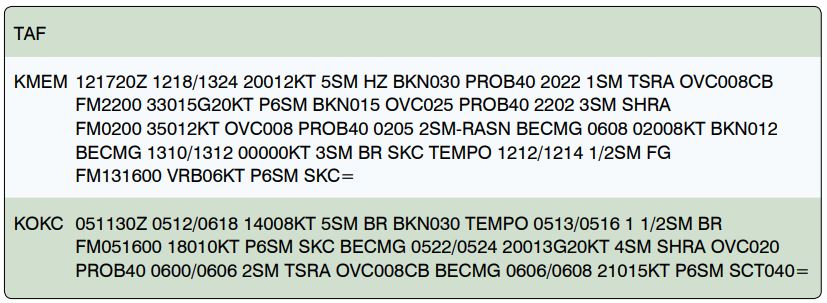
396. Question

397. Question

398. Question

399. Question

400. Question

401. Question

402. Question

403. Question
404. Question
405. Question
406. Question
407. Question
408. Question
409. Question

410. Question

411. Question

412. Question

413. Question

414. Question
415. Question
416. Question
417. Question
418. Question
419. Question
420. Question
421. Question

422. Question
423. Question

424. Question

425. Question
426. Question

427. Question
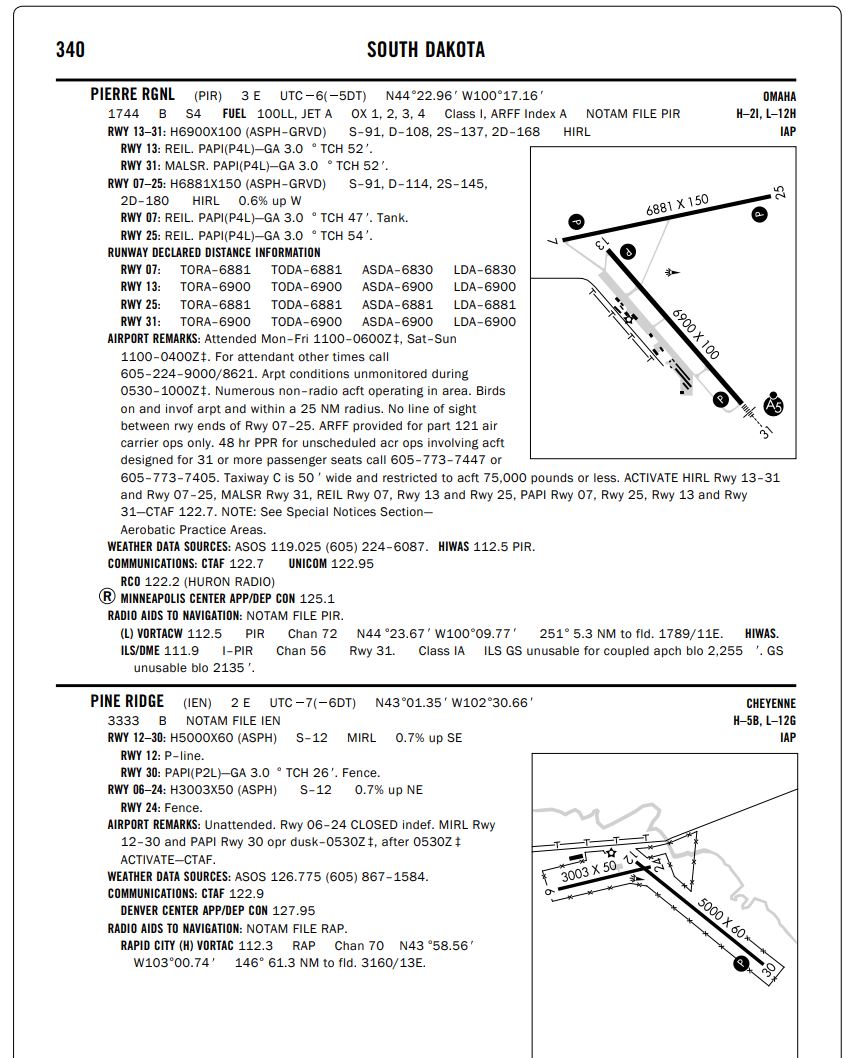
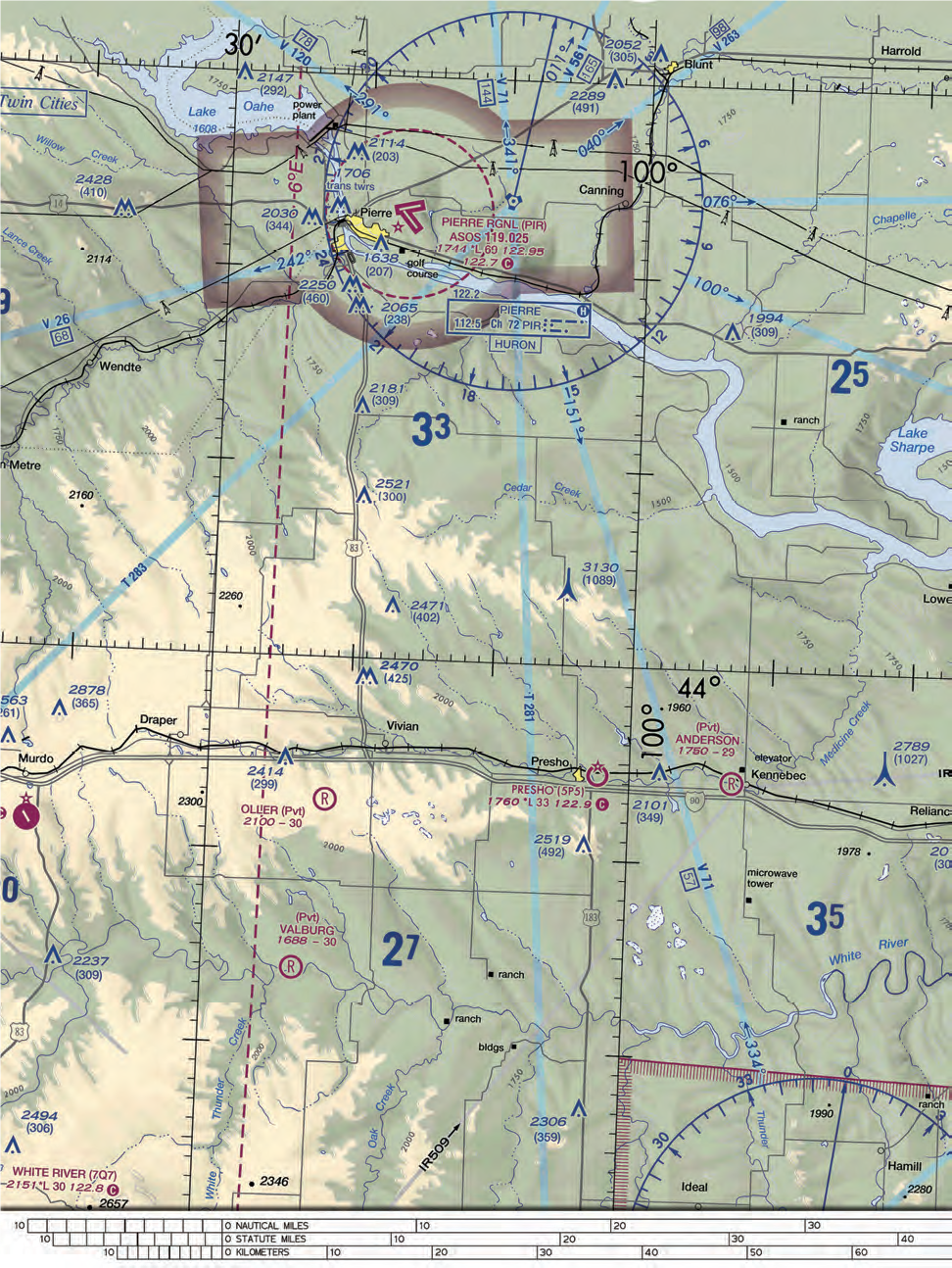
428. Question
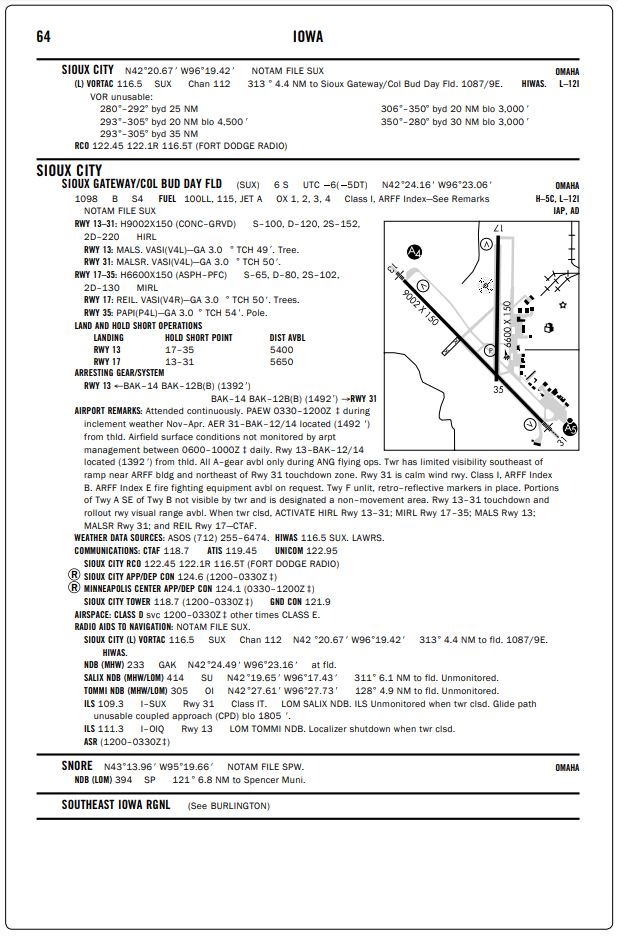
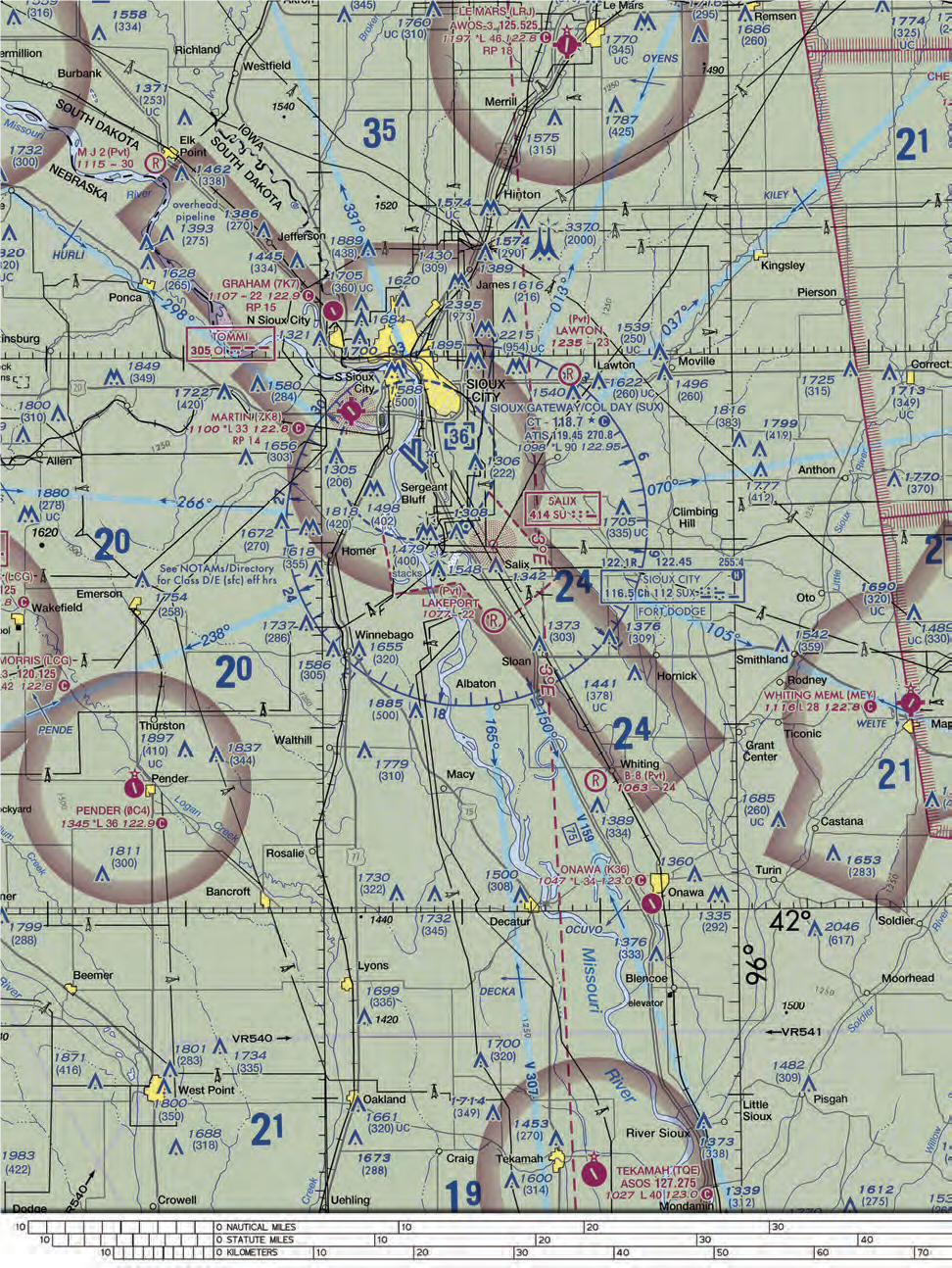
429. Question


430. Question

431. Question

432. Question

433. Question

434. Question
435. Question
436. Question

437. Question

438. Question
439. Question
440. Question
441. Question
442. Question
443. Question

444. Question
445. Question
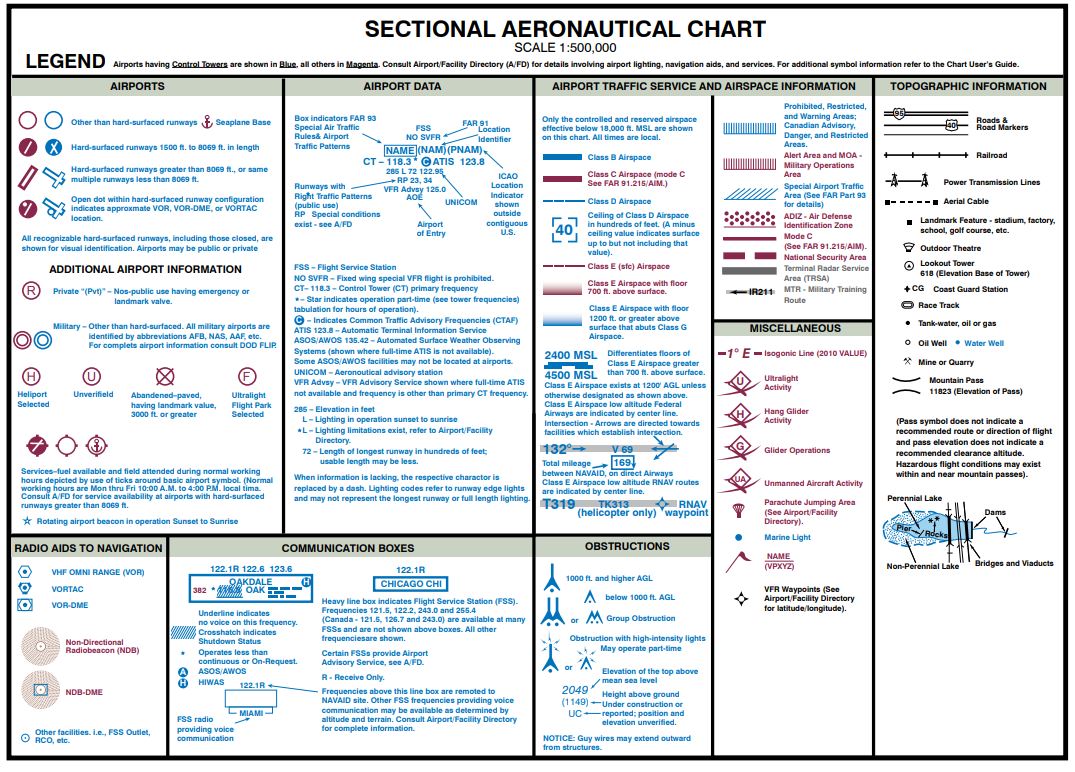

446. Question
447. Question

448. Question

449. Question

450. Question

451. Question

452. Question

453. Question

454. Question

455. Question

456. Question

457. Question
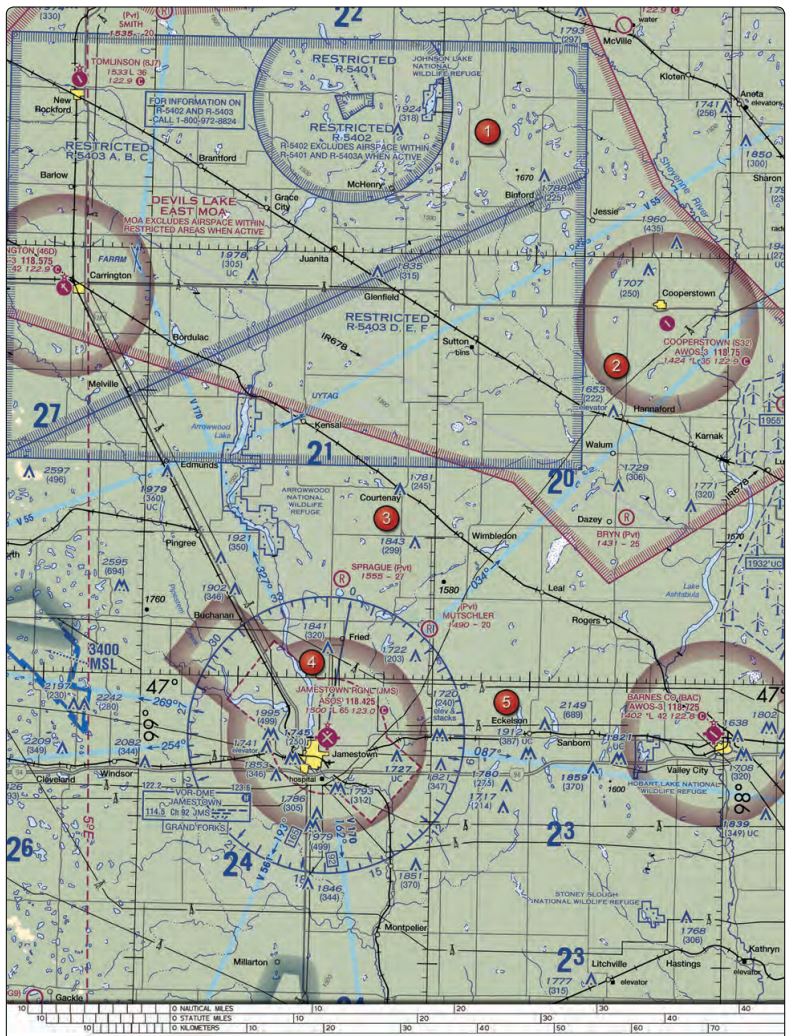
458. Question

459. Question

460. Question

461. Question

462. Question

463. Question

464. Question

465. Question

466. Question

467. Question

468. Question

469. Question

470. Question

471. Question

472. Question

473. Question

474. Question

475. Question

476. Question

477. Question


478. Question

479. Question

480. Question

481. Question

482. Question

483. Question

484. Question

485. Question

486. Question

487. Question

488. Question
489. Question

490. Question

491. Question

492. Question

493. Question

494. Question

495. Question

496. Question


497. Question


498. Question


499. Question

500. Question
501. Question
502. Question
503. Question
504. Question

505. Question

506. Question

507. Question

508. Question

509. Question
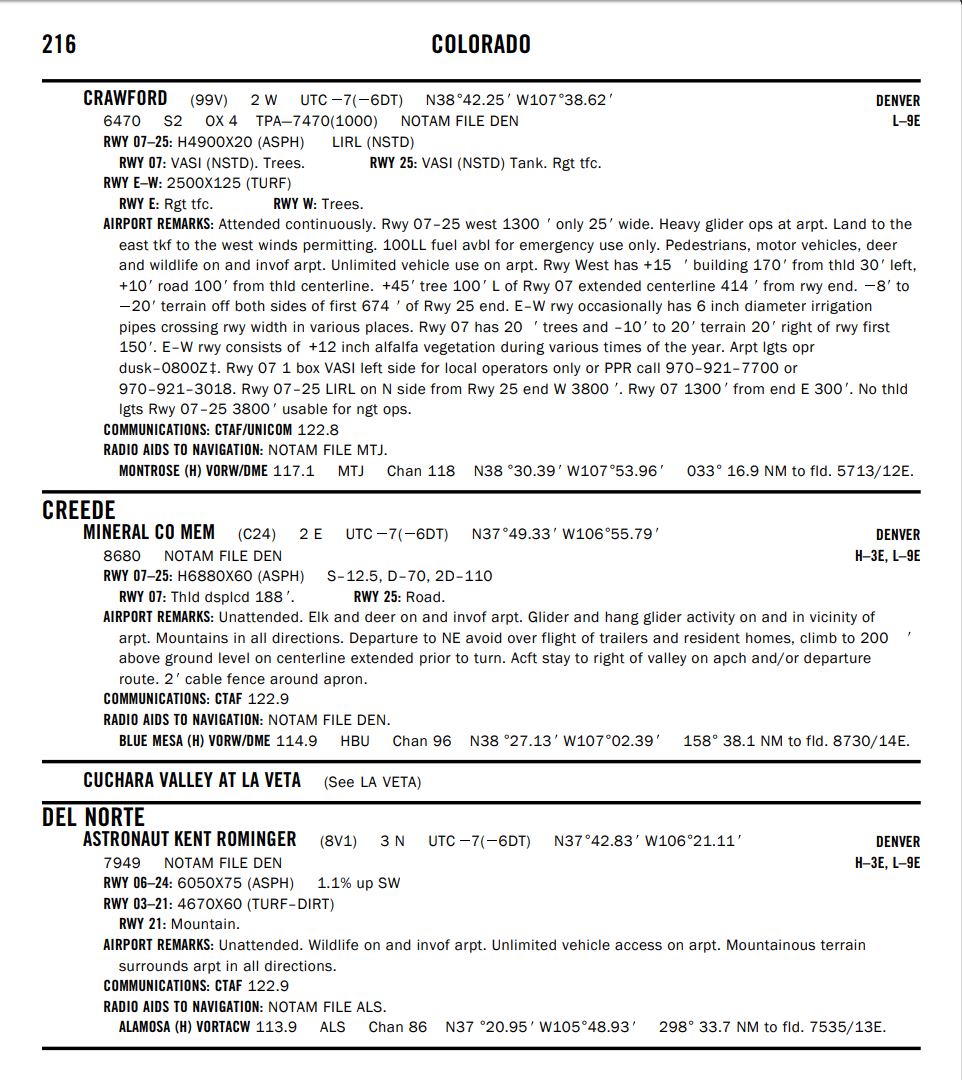

510. Question


511. Question

512. Question
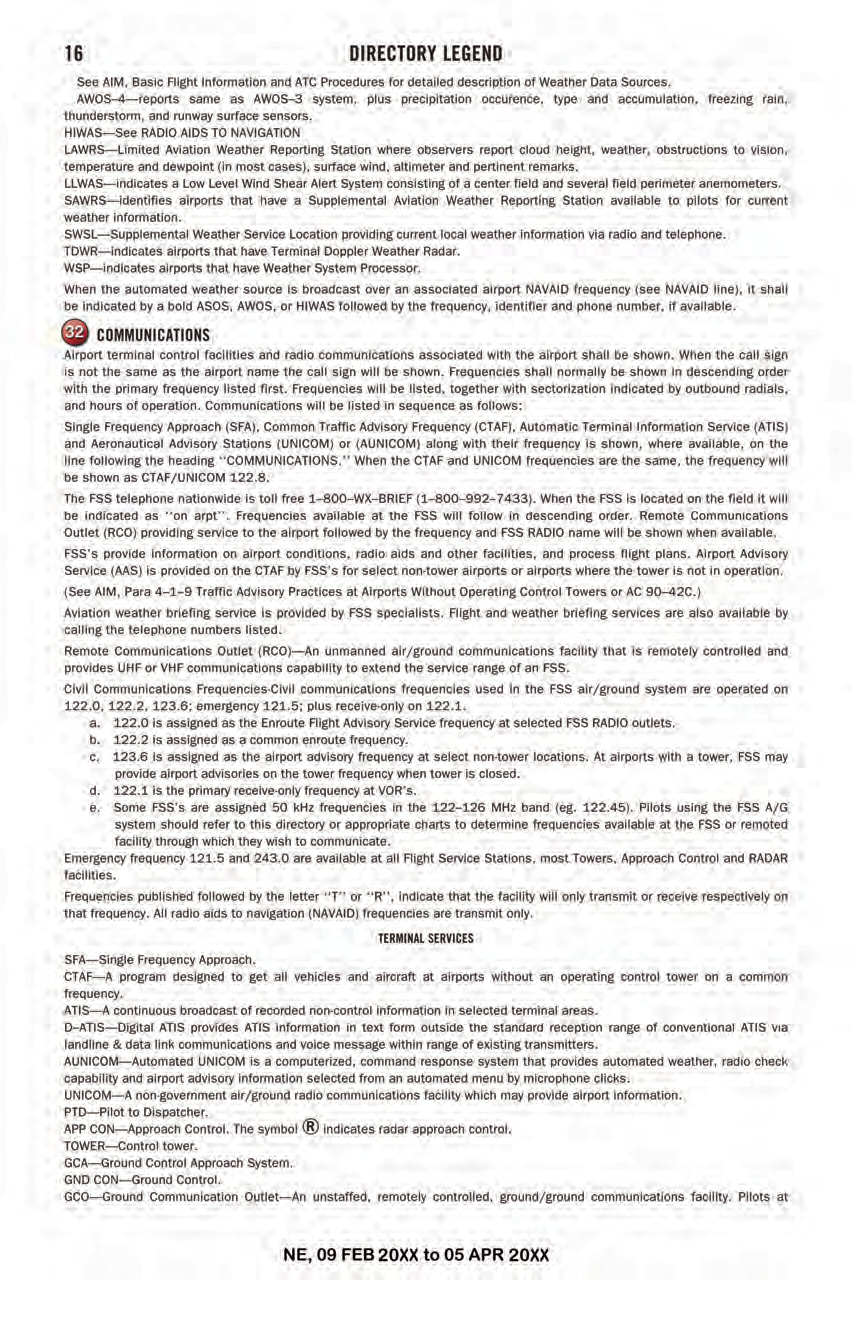
513. Question
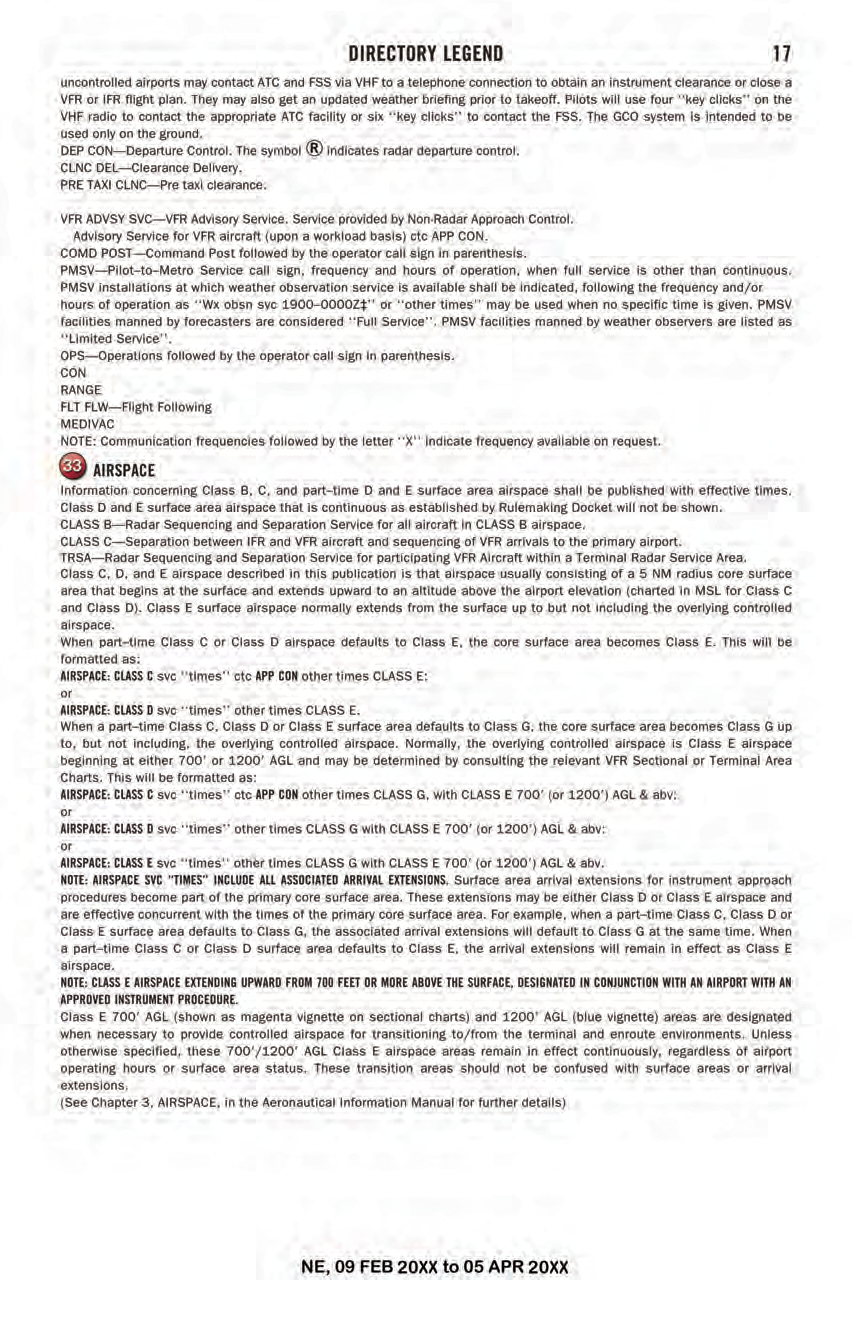
514. Question
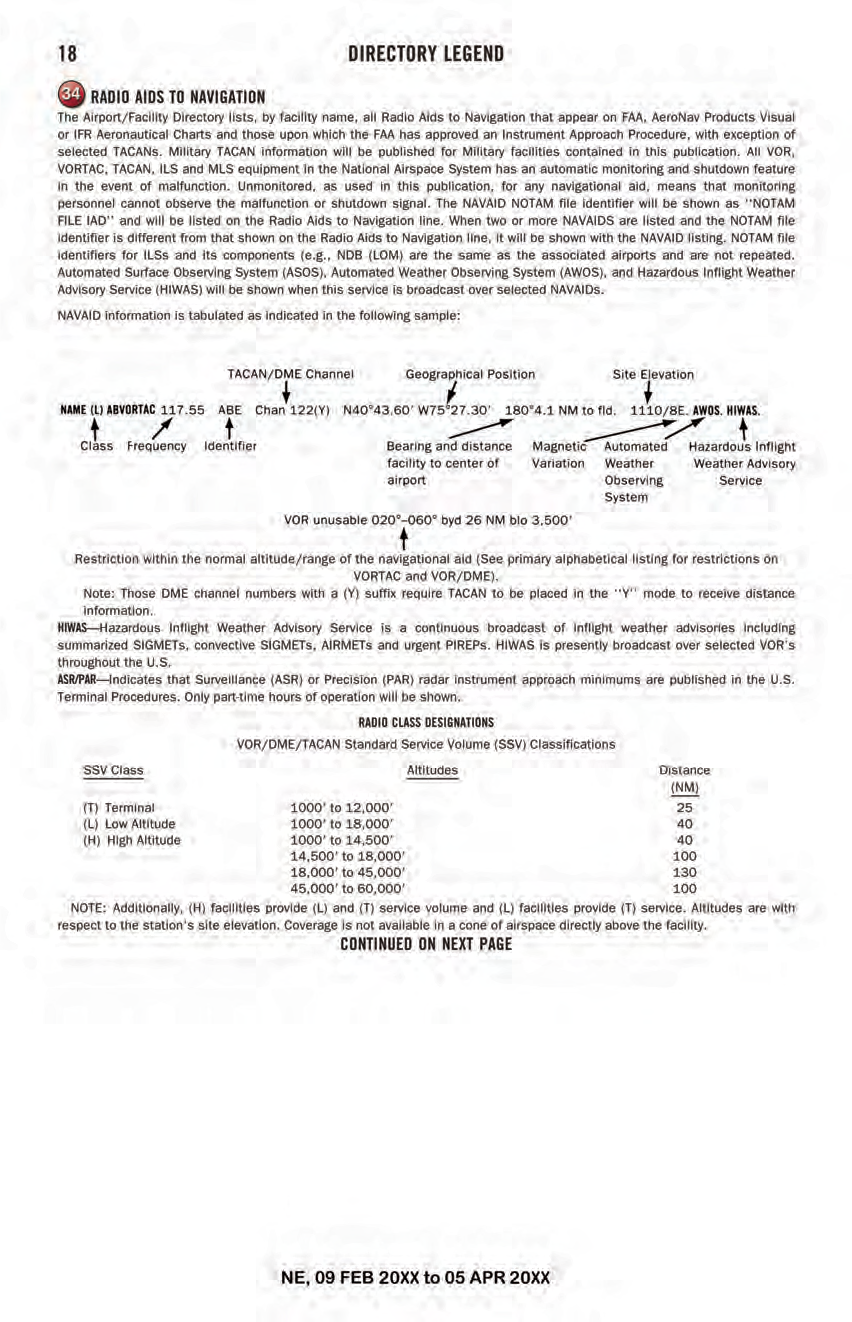
515. Question
516. Question
517. Question
518. Question
519. Question
520. Question
521. Question

522. Question

523. Question


524. Question

525. Question


526. Question

527. Question

528. Question

529. Question
530. Question

531. Question
532. Question
533. Question
534. Question
535. Question
536. Question
537. Question
538. Question
539. Question
540. Question
541. Question
542. Question
543. Question
544. Question
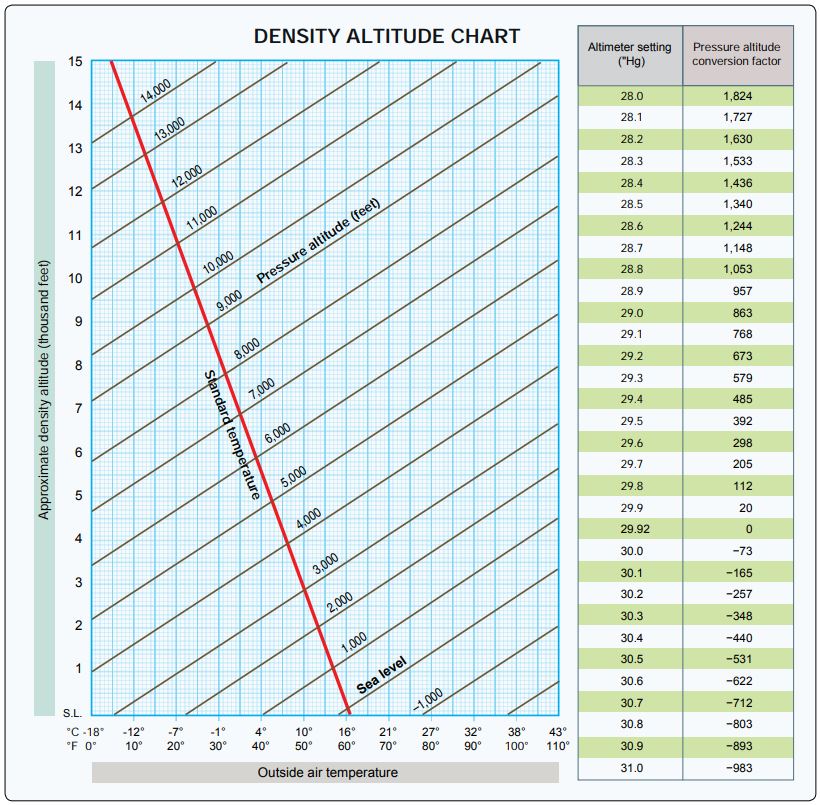
545. Question

546. Question

547. Question

548. Question

549. Question

550. Question

551. Question

552. Question

553. Question
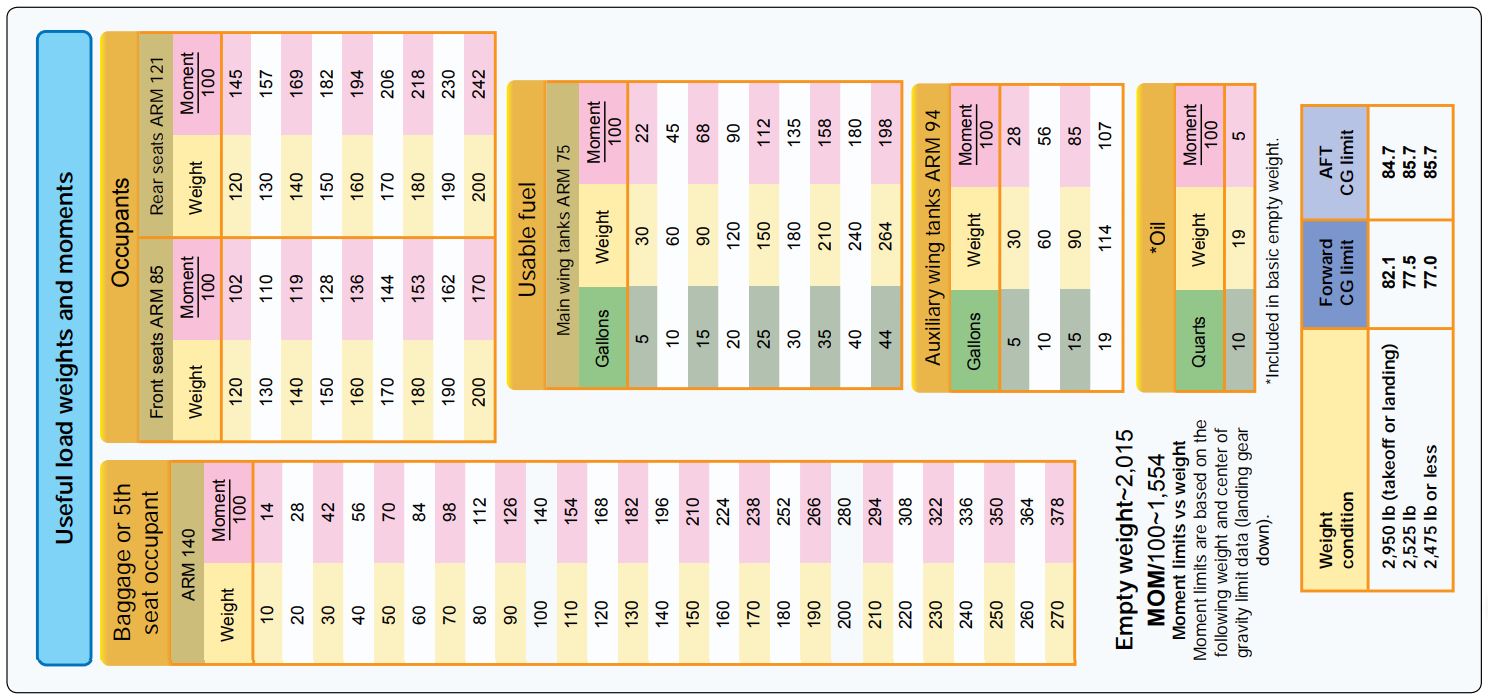

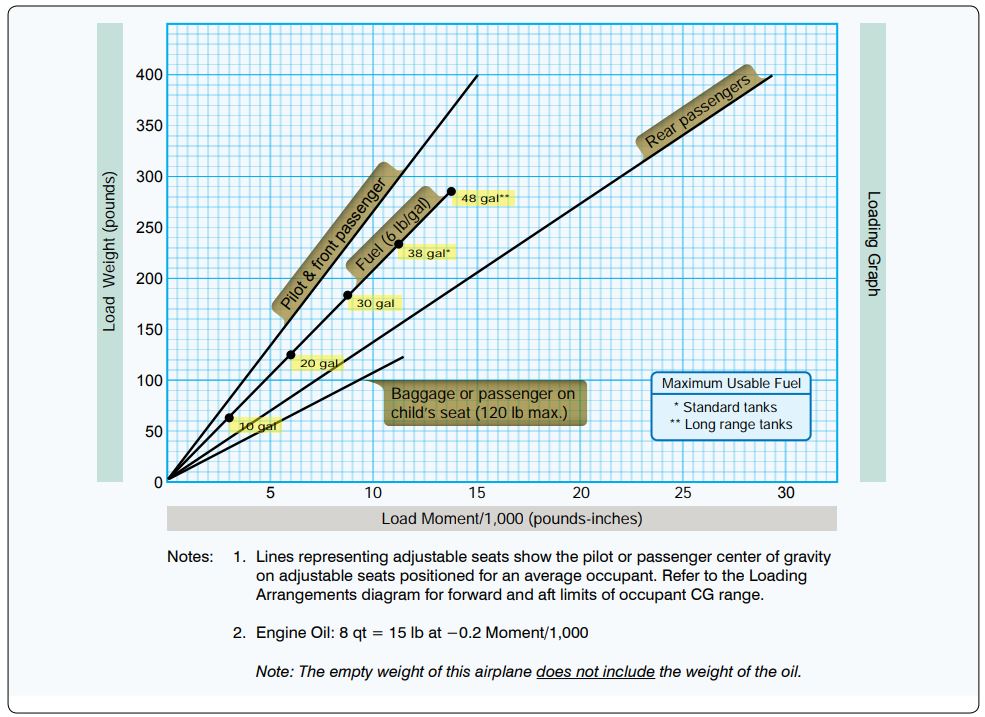
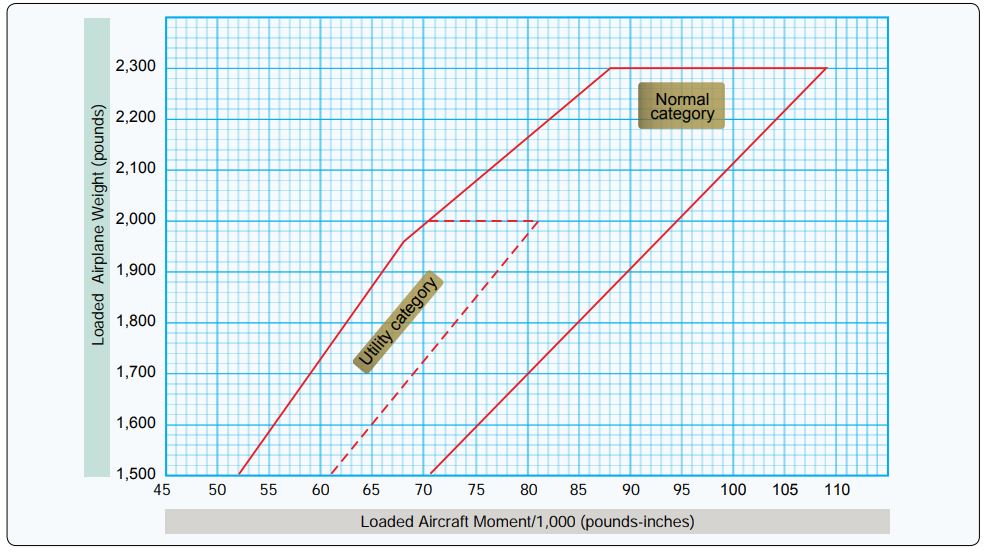
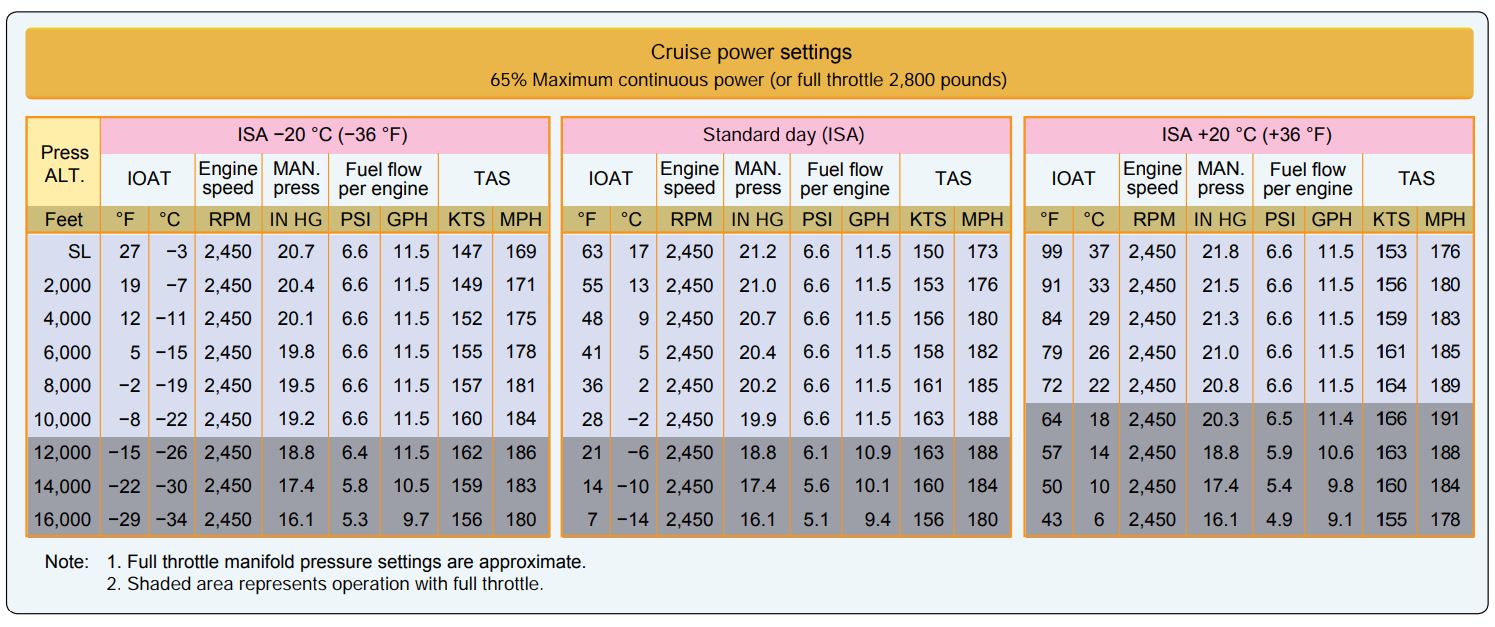
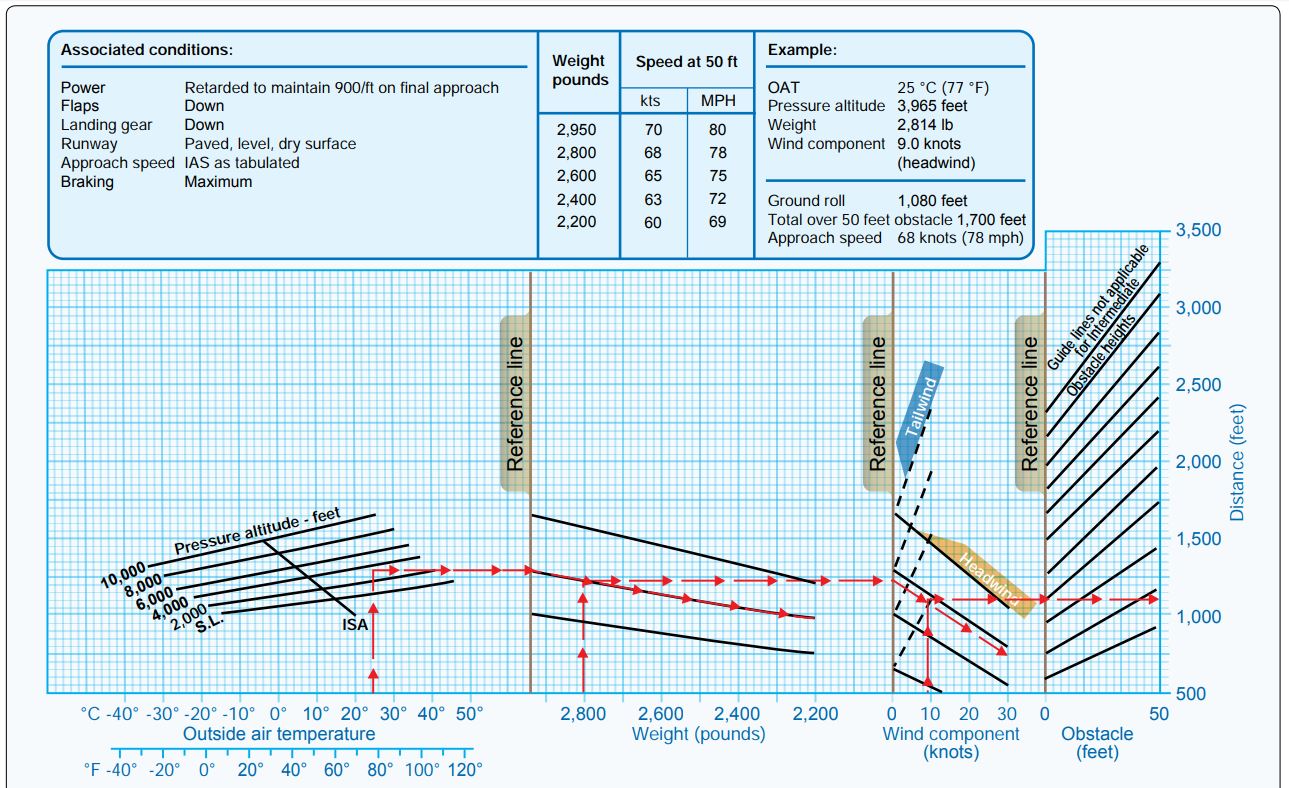
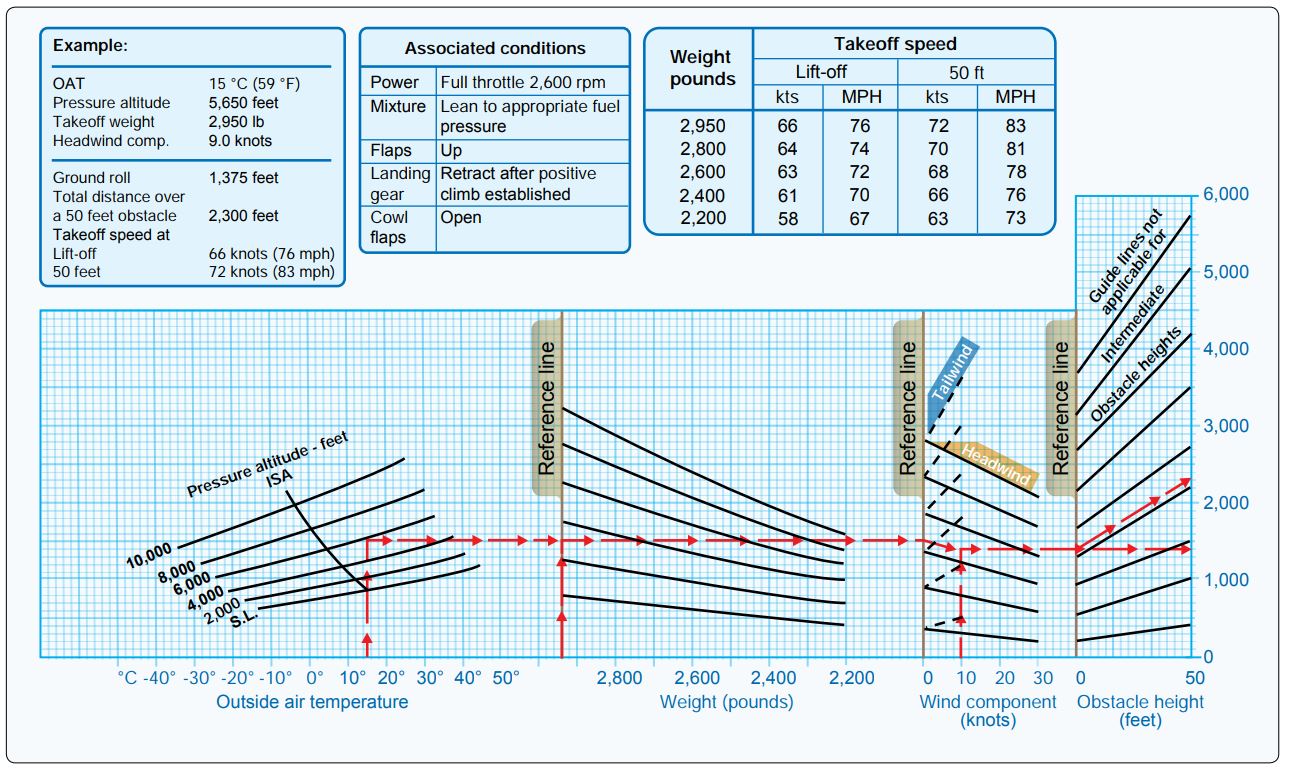
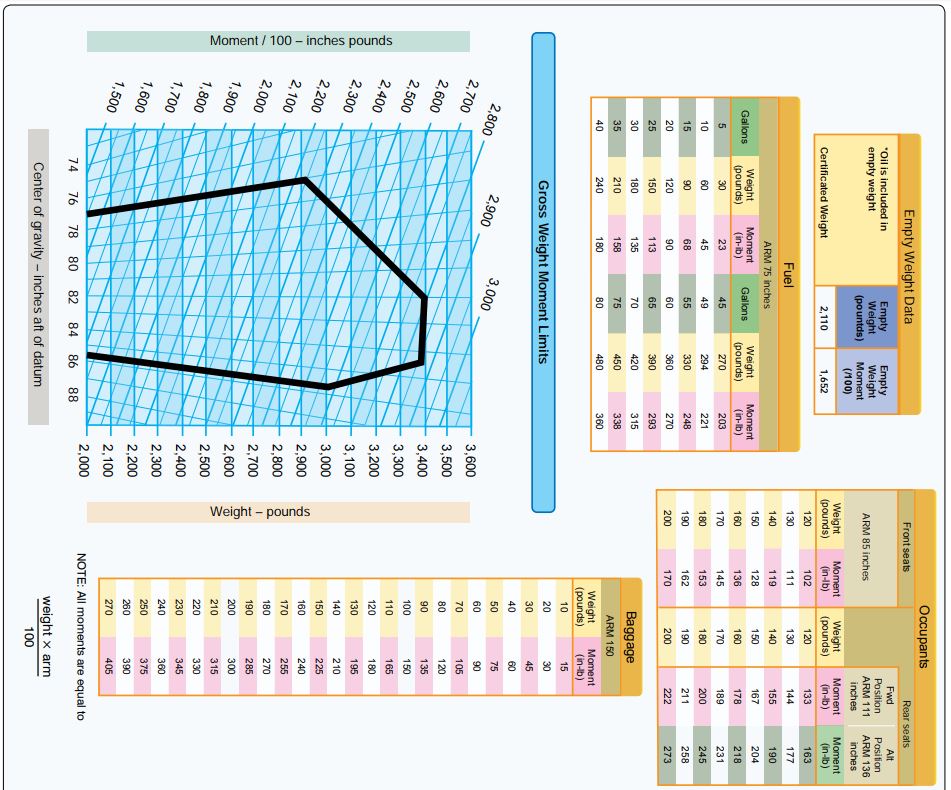
554. Question

555. Question

556. Question

557. Question

558. Question

559. Question

560. Question

561. Question

562. Question

563. Question

564. Question

565. Question

566. Question

567. Question

568. Question

569. Question

570. Question

571. Question

572. Question

573. Question
574. Question

575. Question

576. Question

577. Question

578. Question

579. Question

580. Question
581. Question
582. Question
583. Question

584. Question

585. Question

586. Question

587. Question

588. Question
 The CG is located how far aft of datum?
The CG is located how far aft of datum?
589. Question
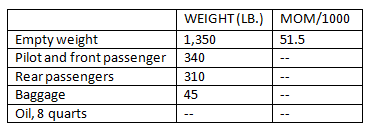


590. Question
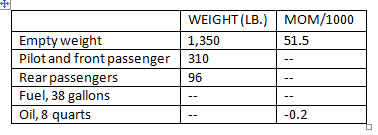


591. Question



592. Question



593. Question
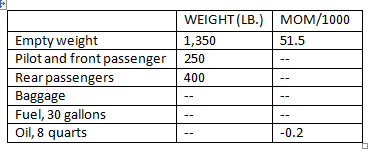


594. Question


595. Question


596. Question


597. Question


598. Question


599. Question


600. Question


601. Question


602. Question
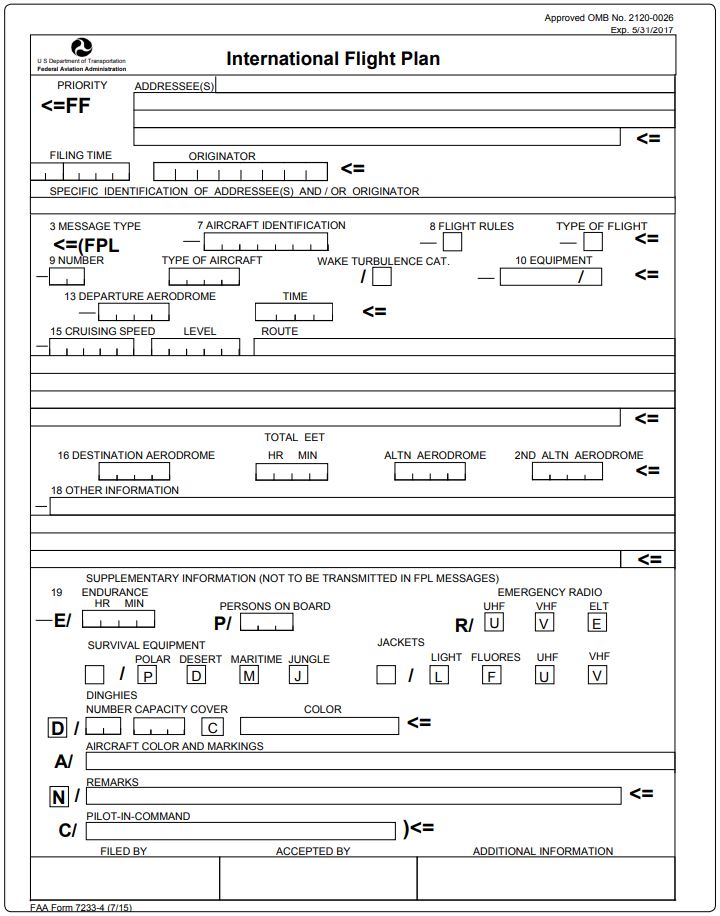
603. Question

604. Question

605. Question

606. Question

607. Question

608. Question
609. Question
610. Question
611. Question
612. Question
613. Question
614. Question
615. Question
616. Question
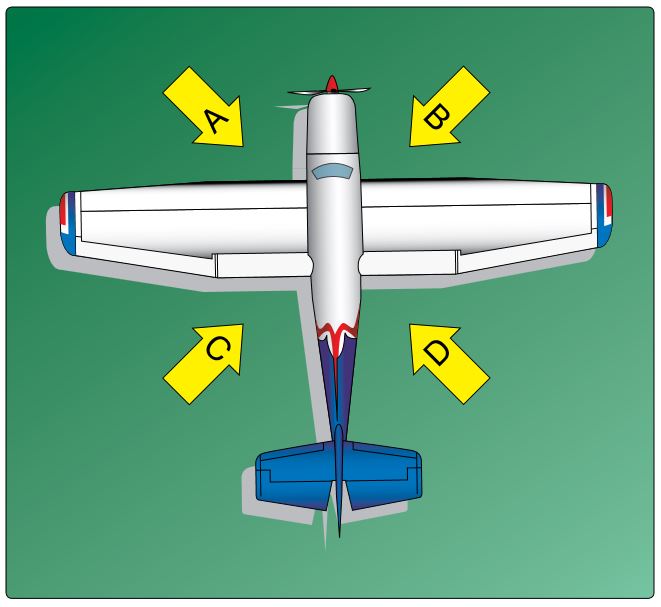
617. Question

618. Question

619. Question

620. Question
621. Question
622. Question
623. Question
624. Question

625. Question

626. Question

627. Question

628. Question

629. Question

630. Question

631. Question

632. Question

633. Question

634. Question

635. Question
636. Question
637. Question

638. Question

639. Question


640. Question
641. Question
642. Question
Forecast wind = 310 degrees at 15 kt.
Pressure altitude = 8,000 ft.
Ambient temperature = -10 degrees C
True course = 270 degrees
643. Question

644. Question

645. Question

646. Question

647. Question

648. Question

649. Question

650. Question

651. Question

652. Question

653. Question

654. Question
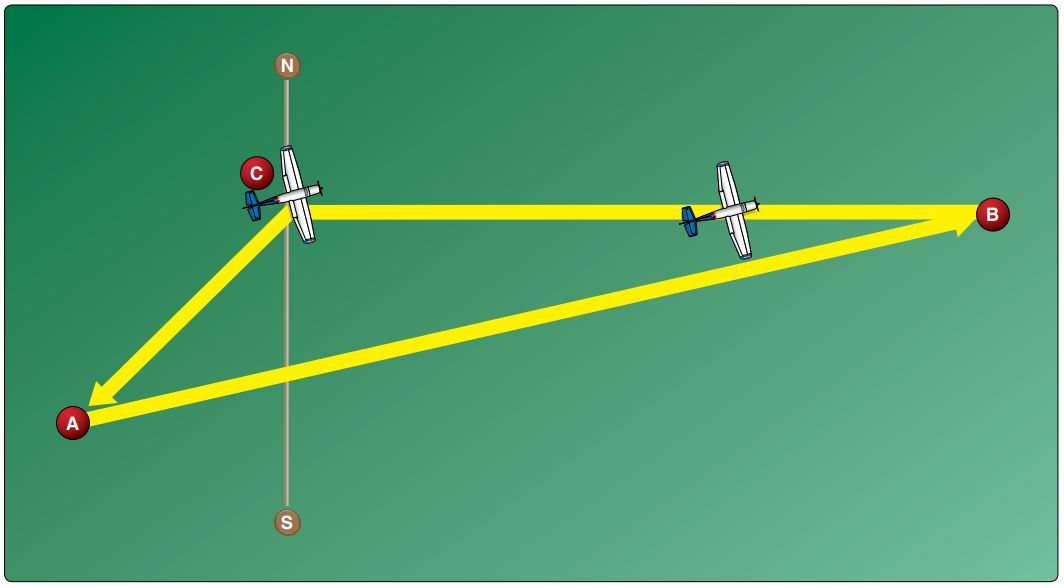
655. Question

656. Question

657. Question
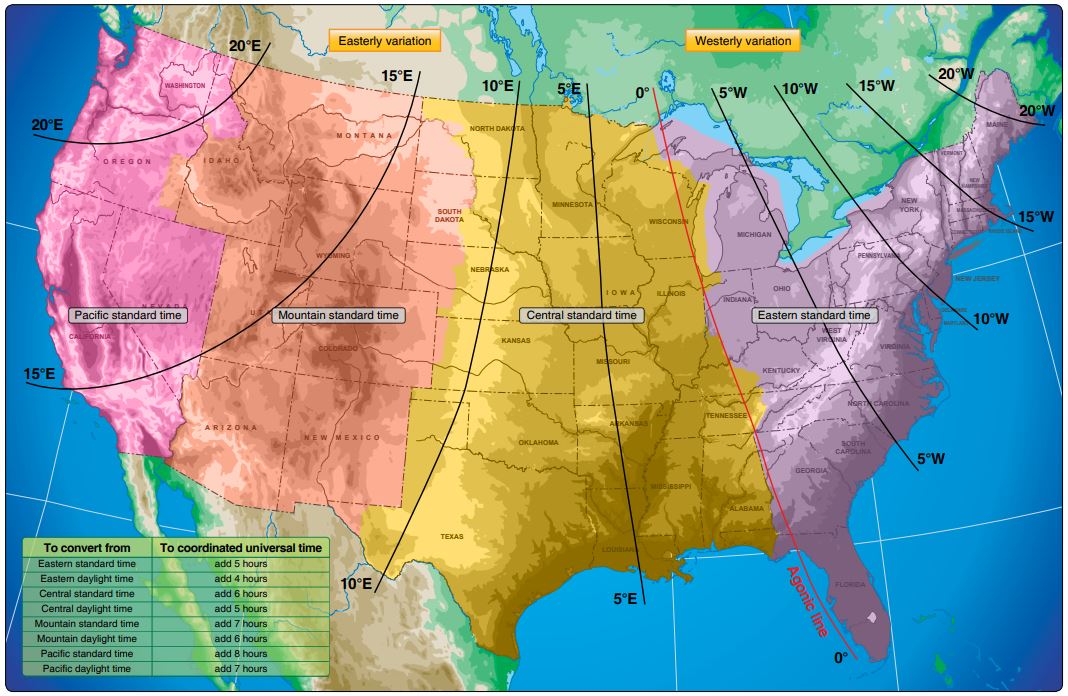
658. Question

659. Question

660. Question

661. Question

662. Question

663. Question
664. Question
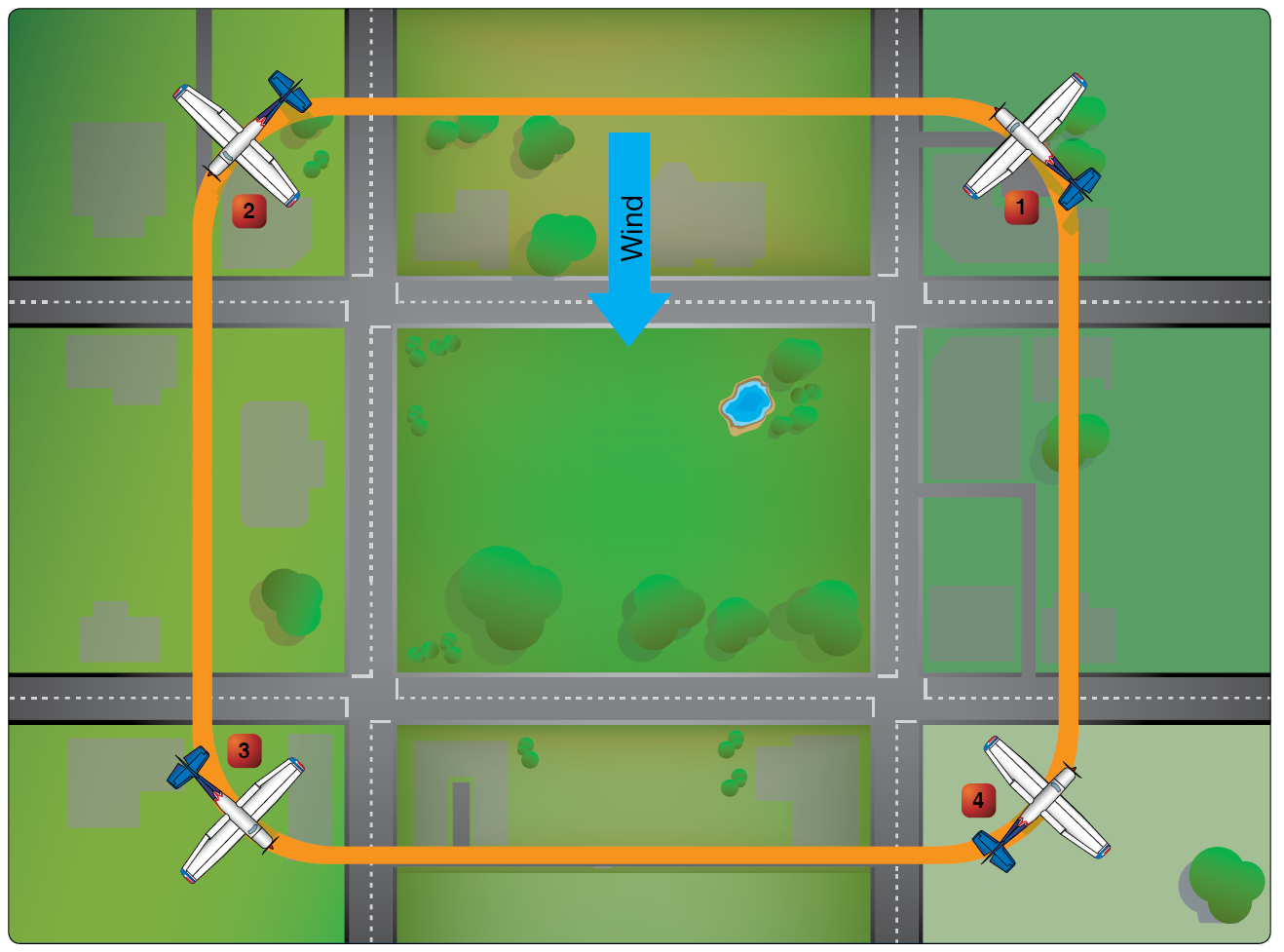
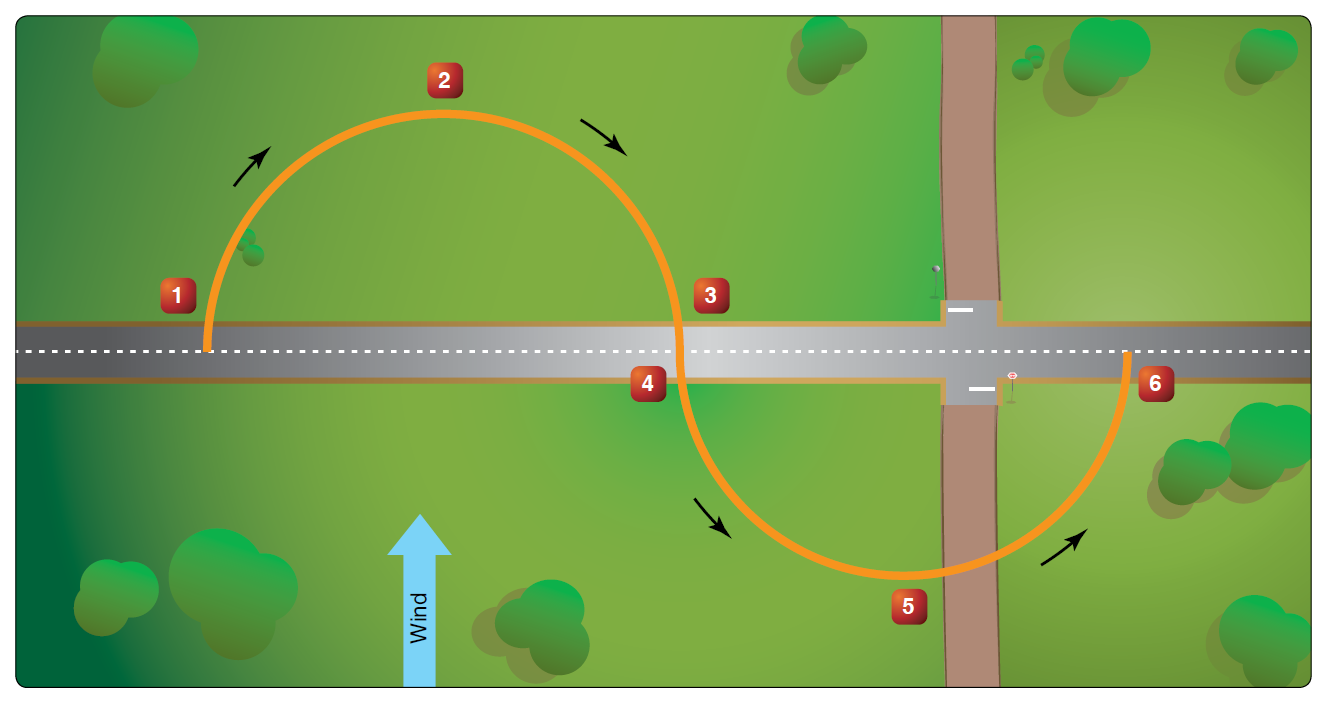
665. Question

666. Question

667. Question